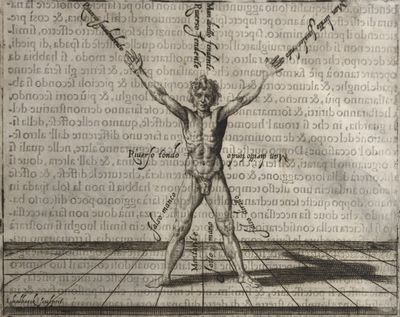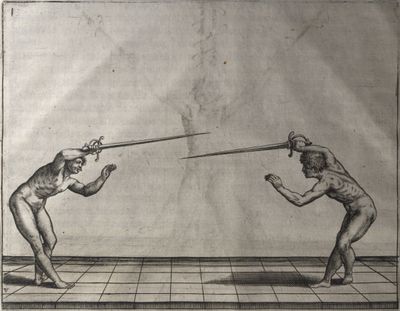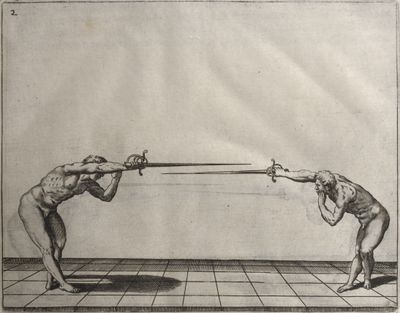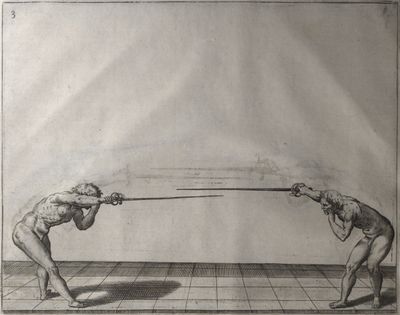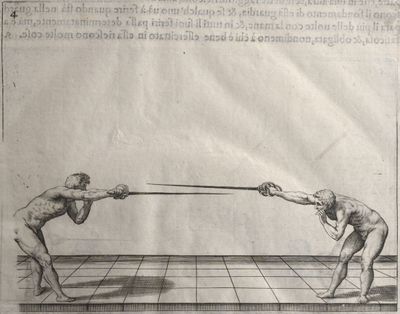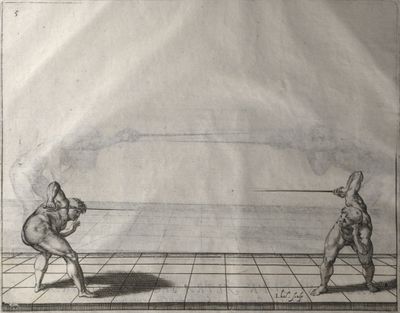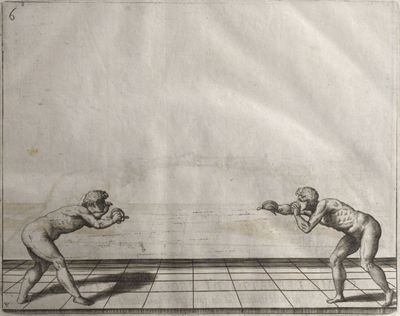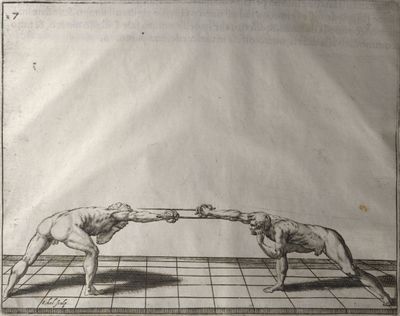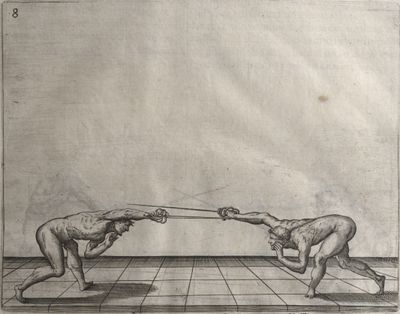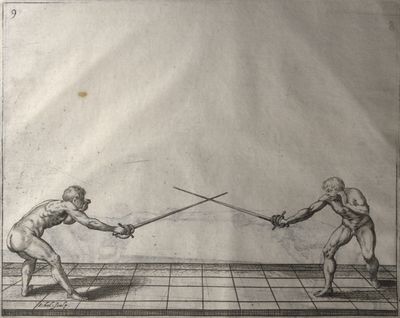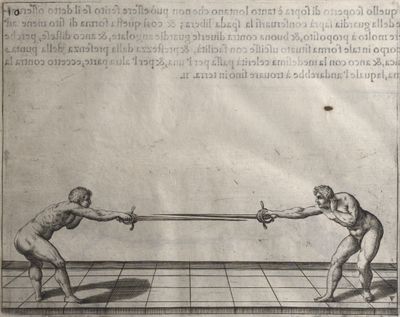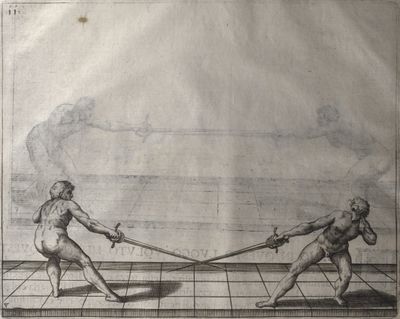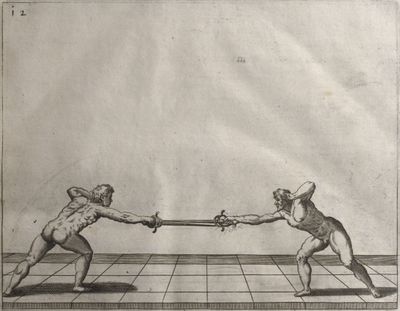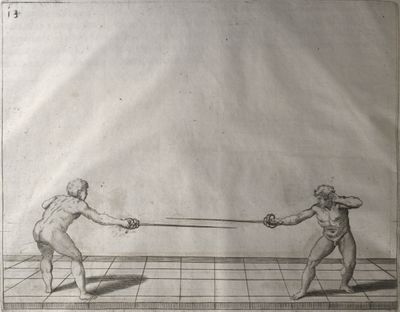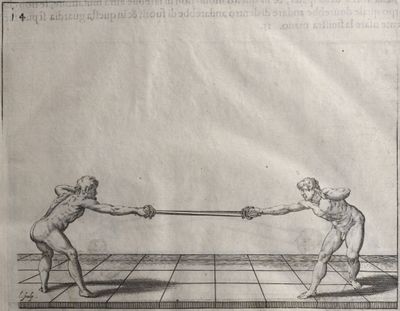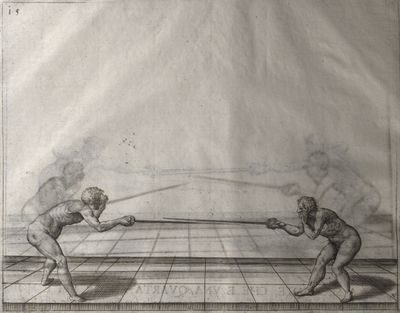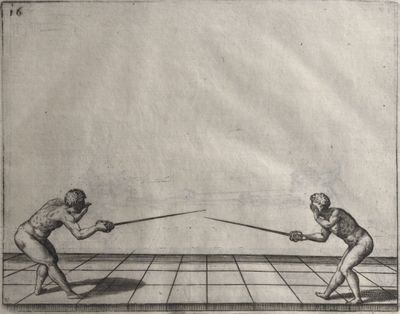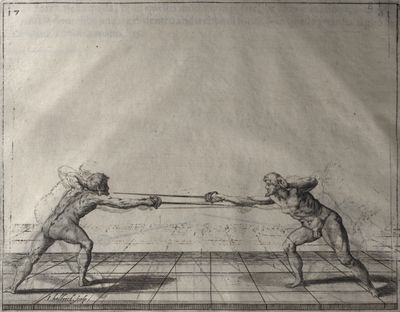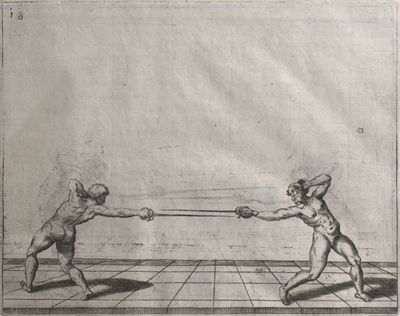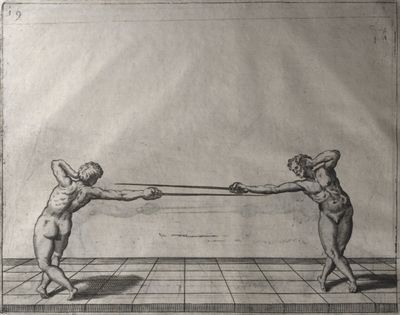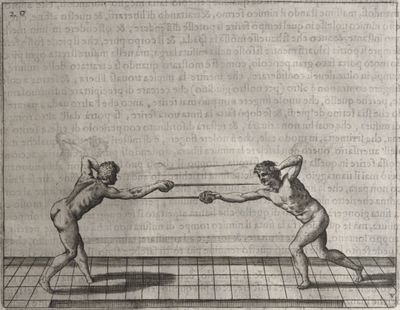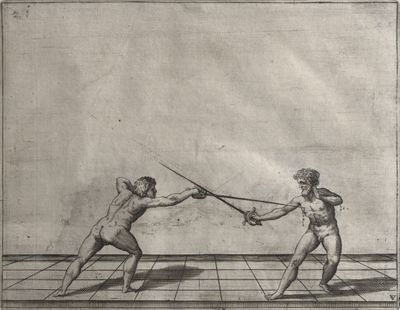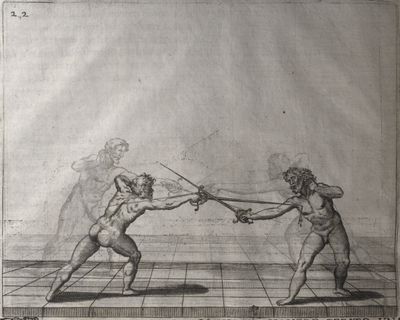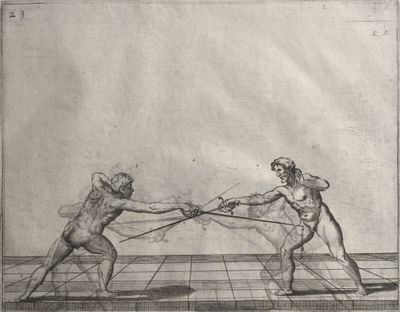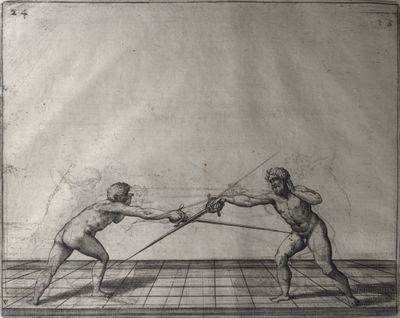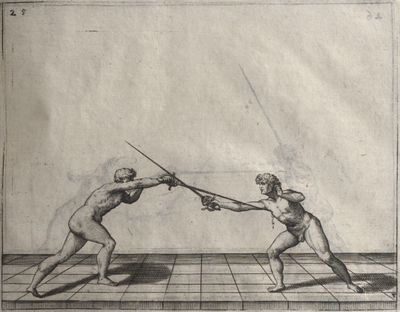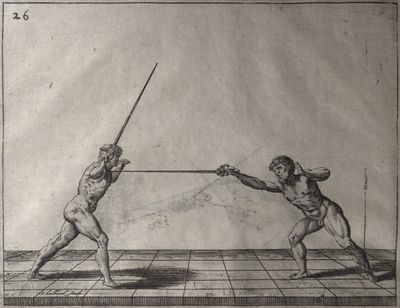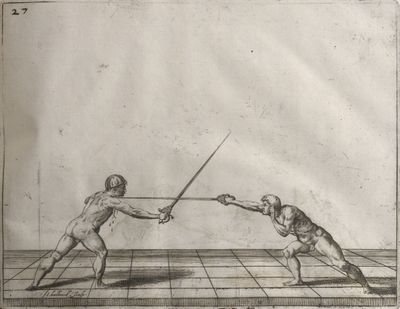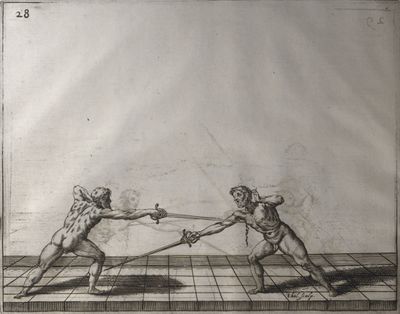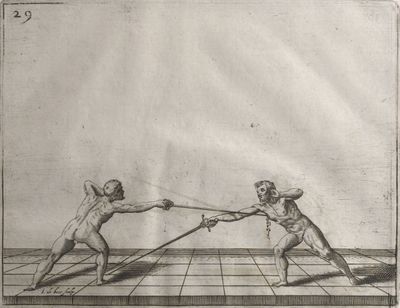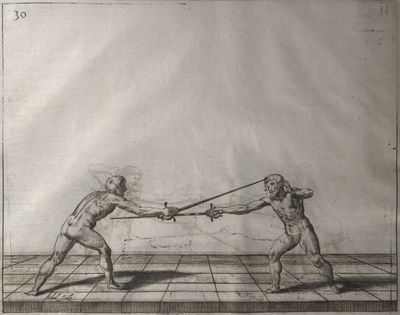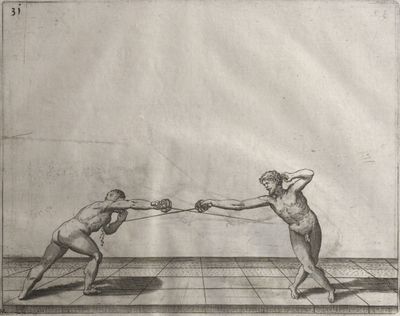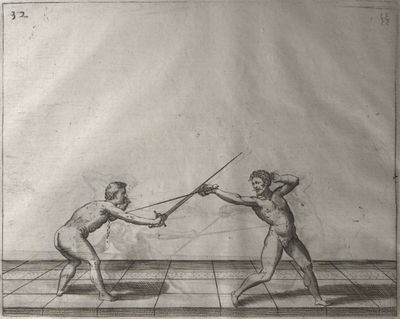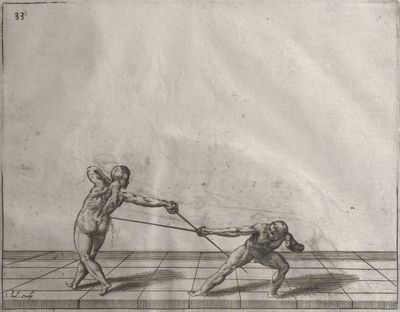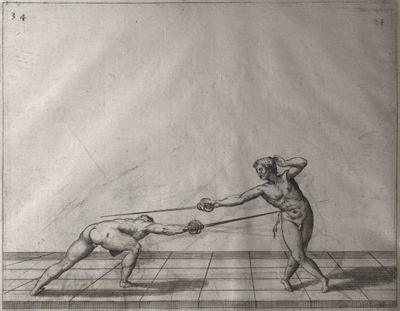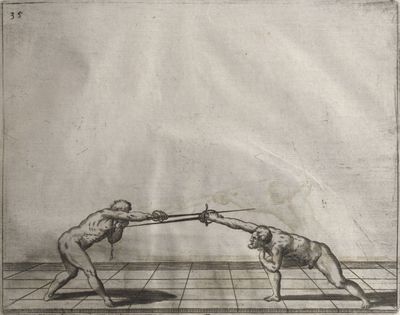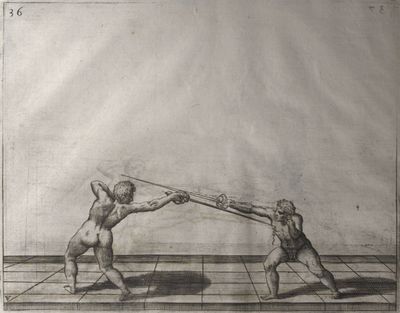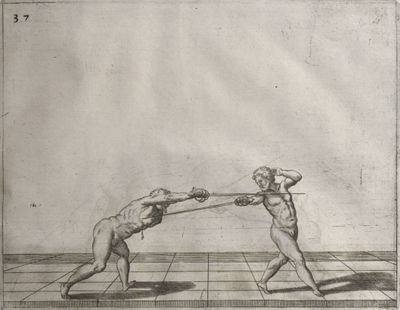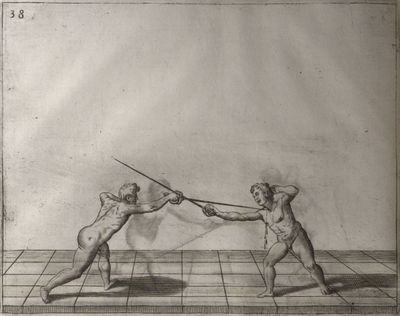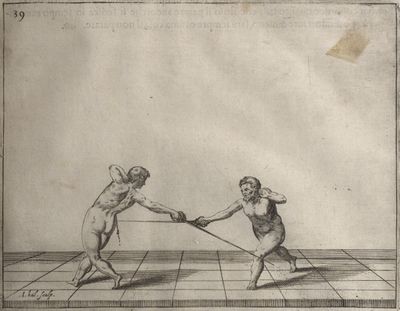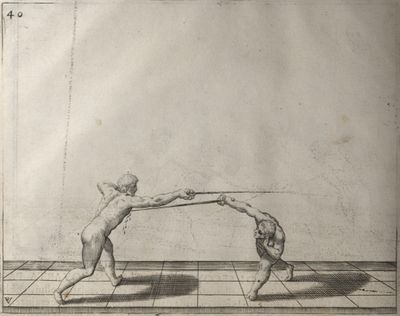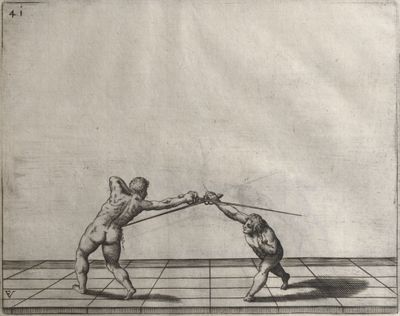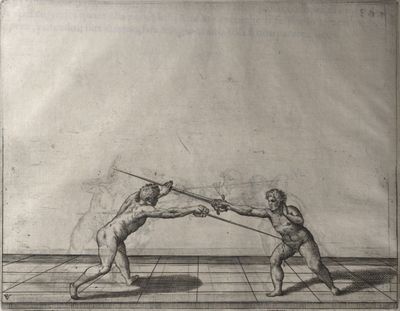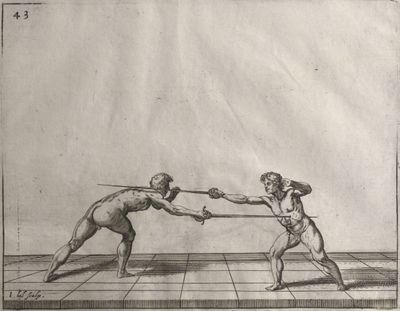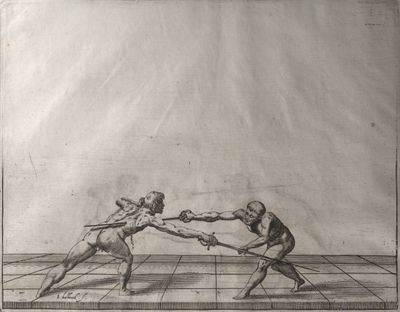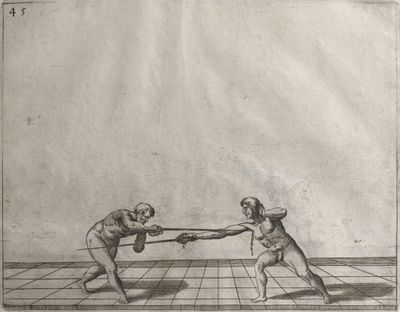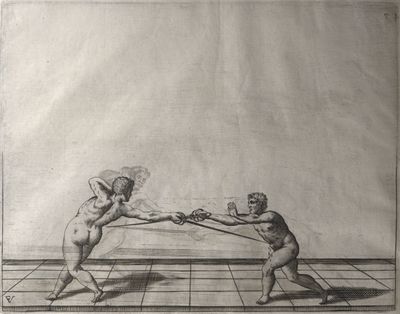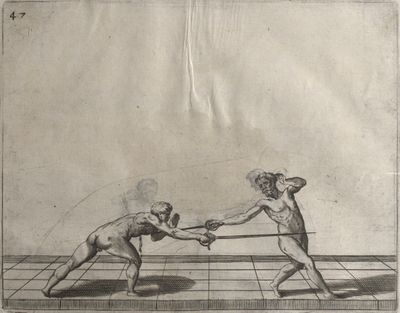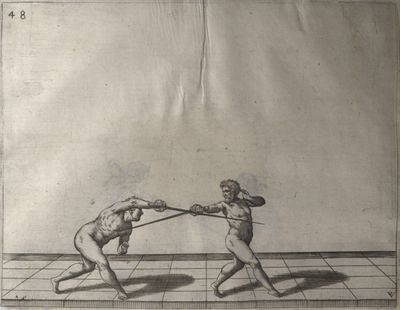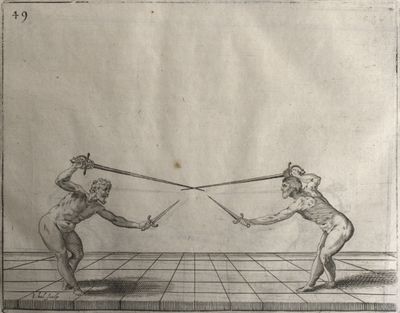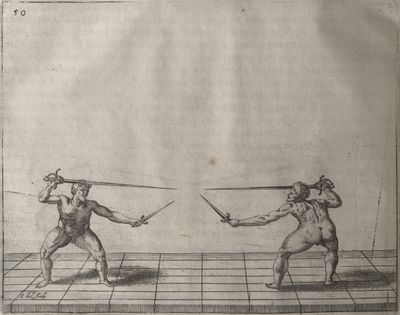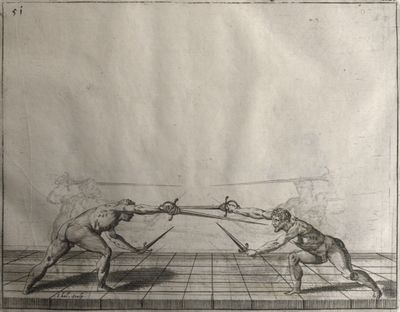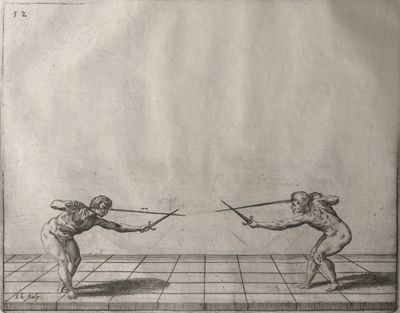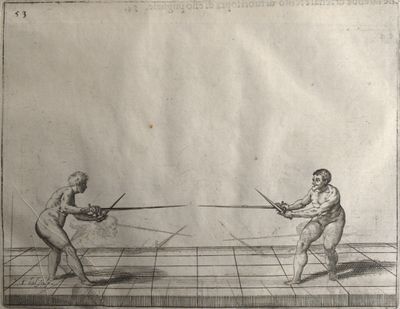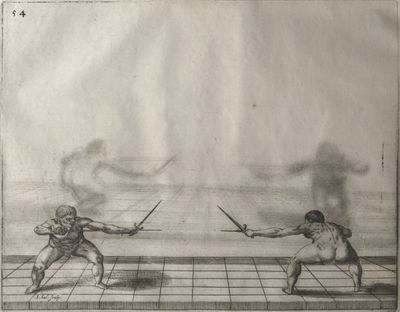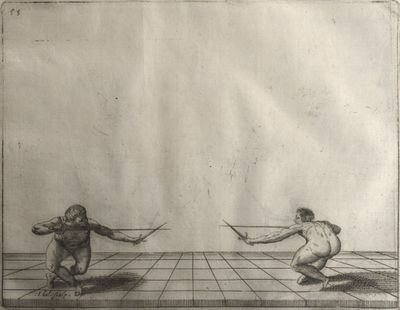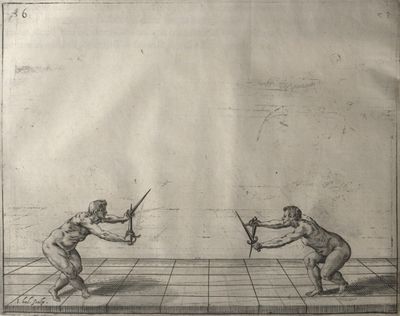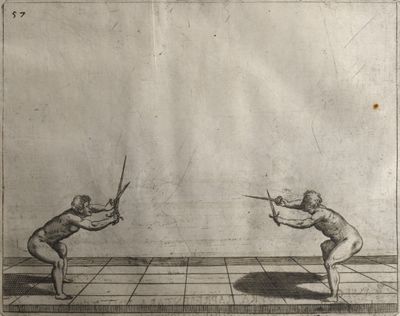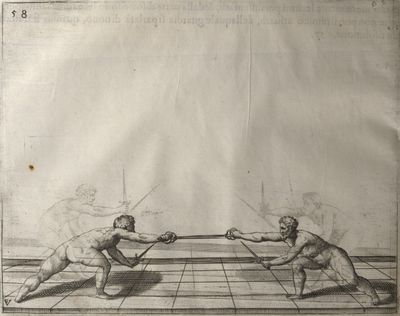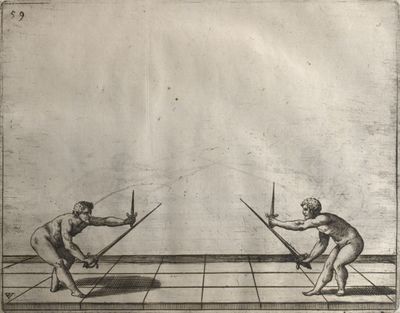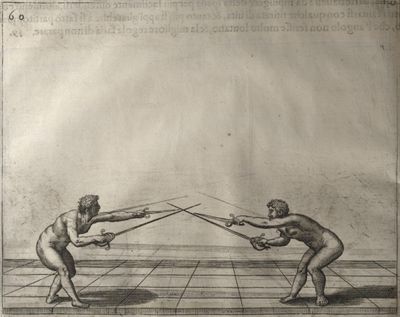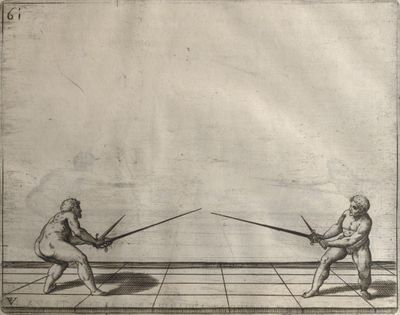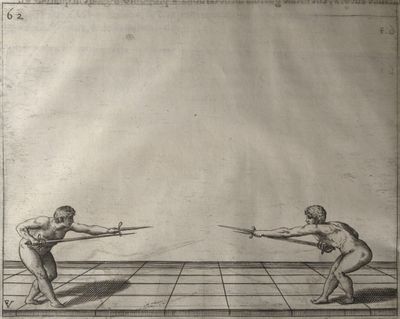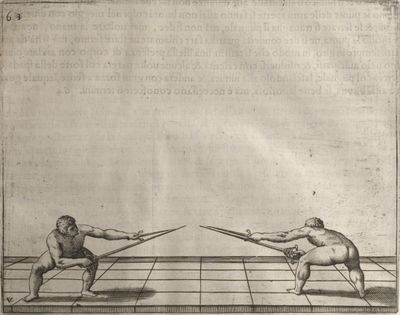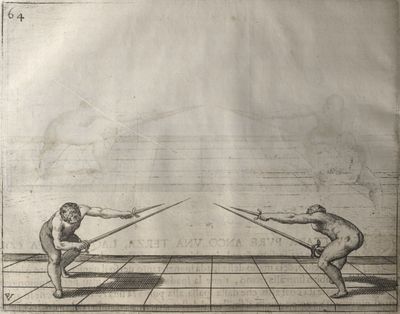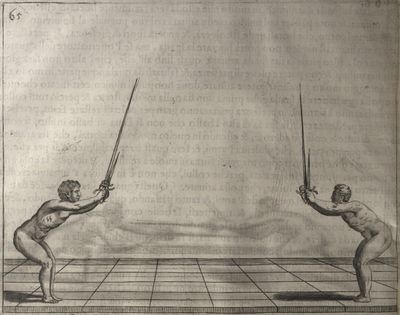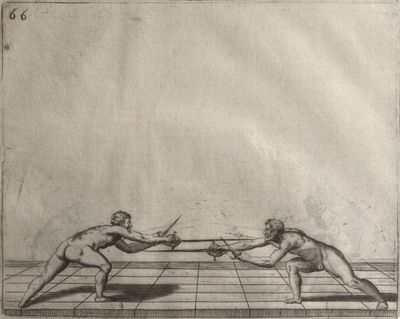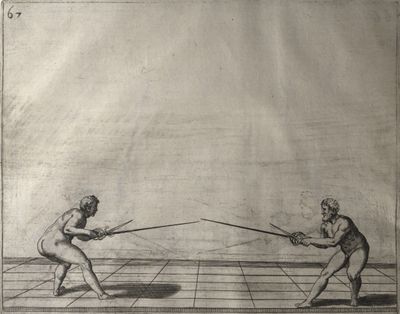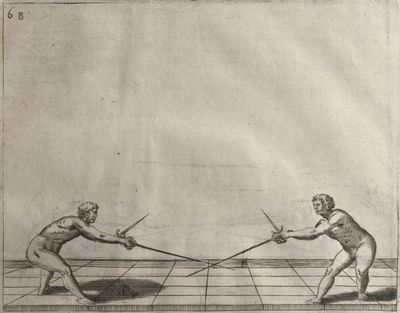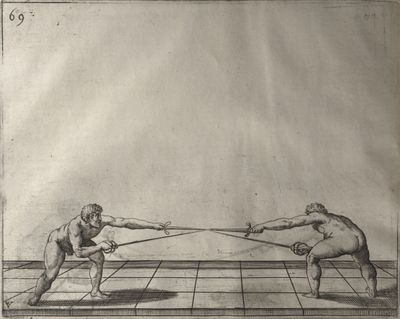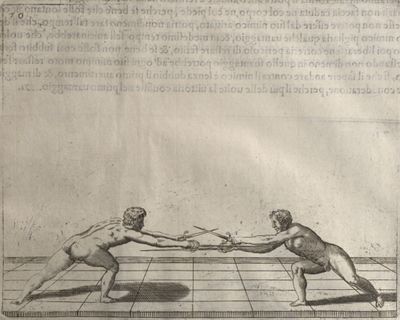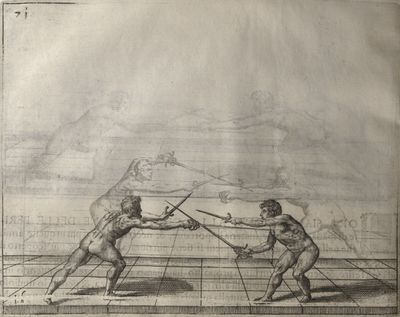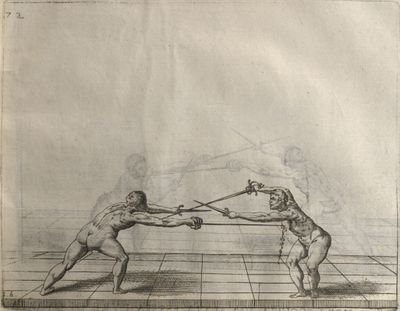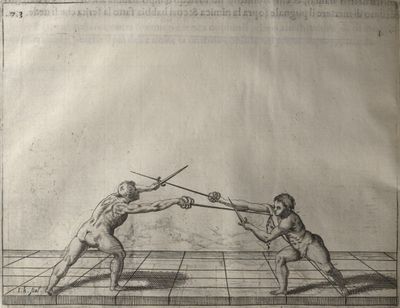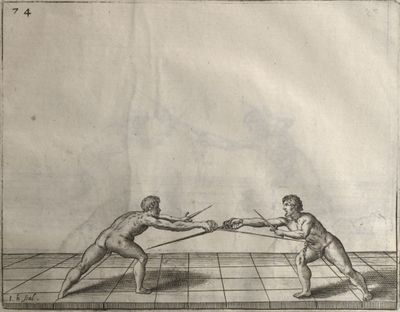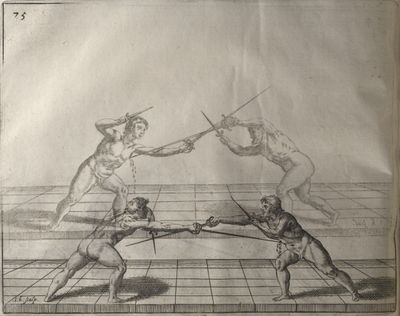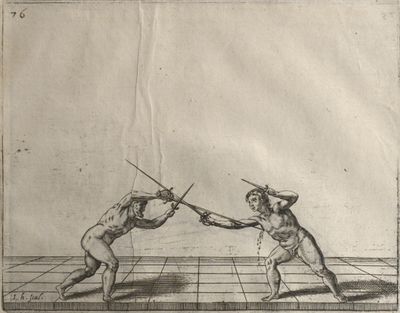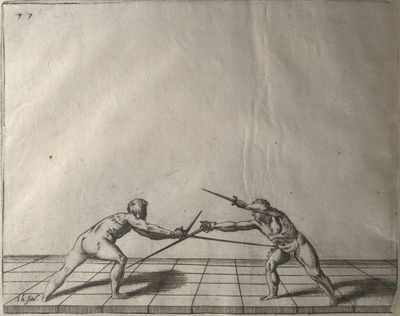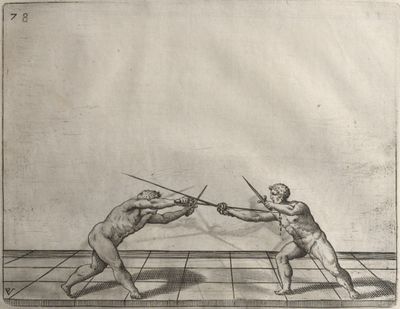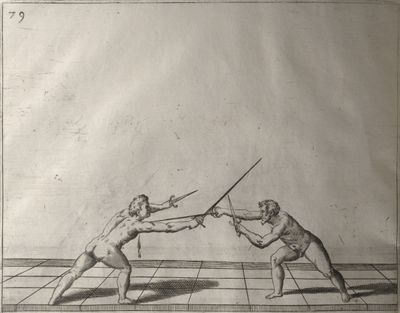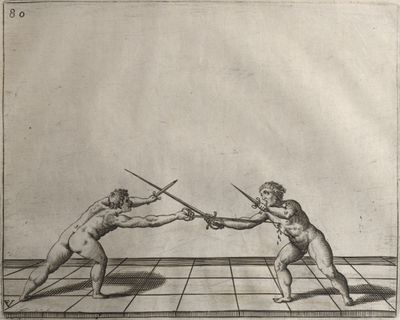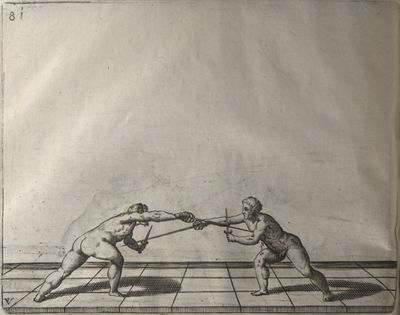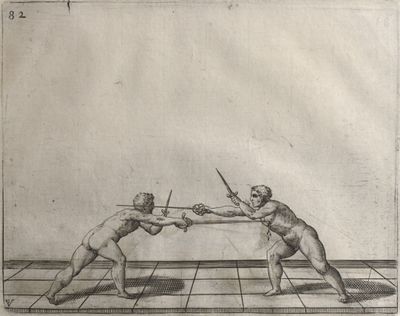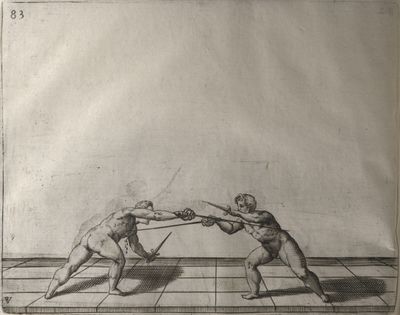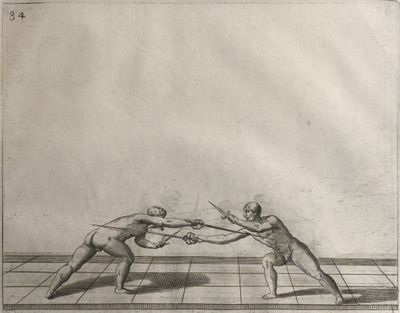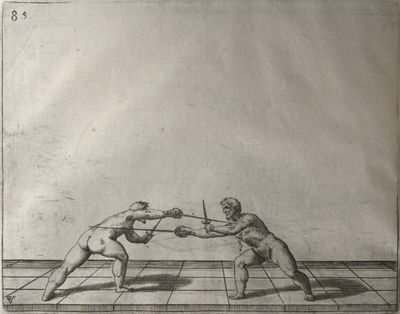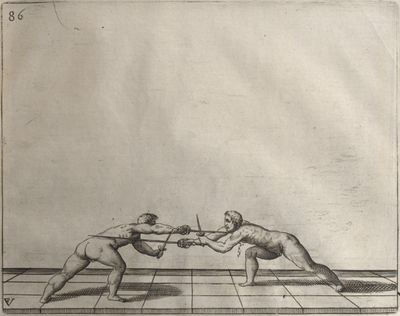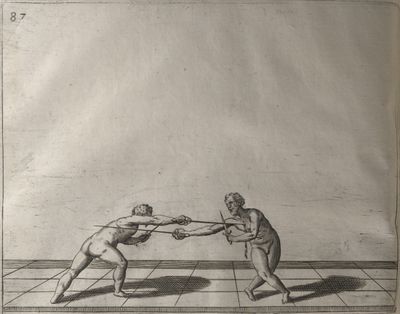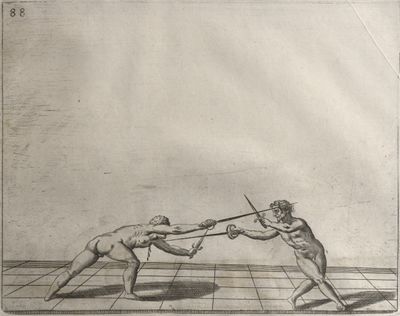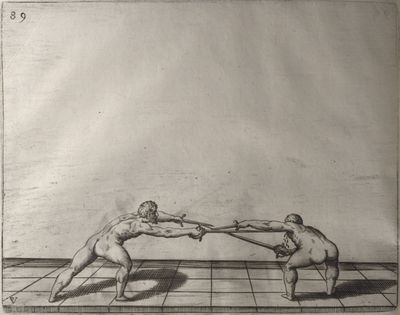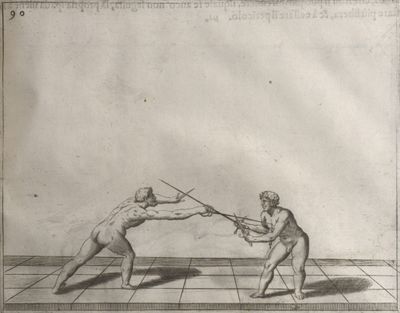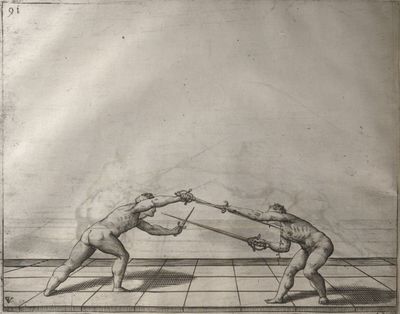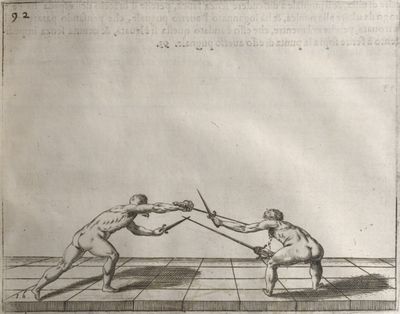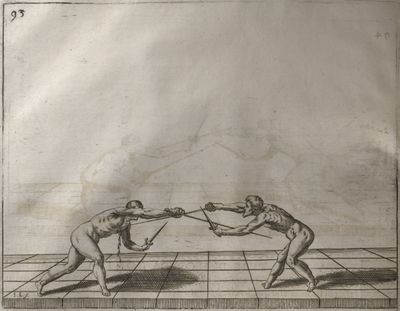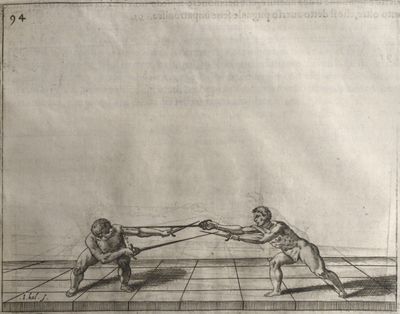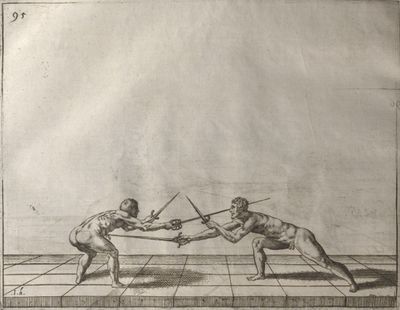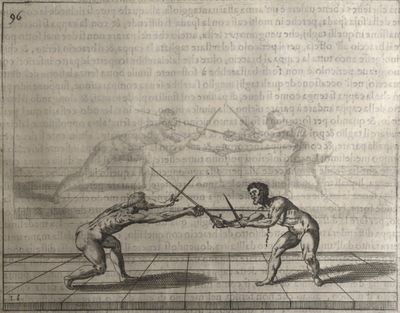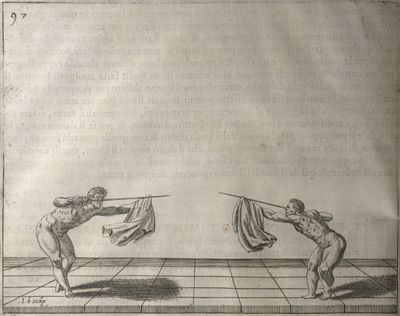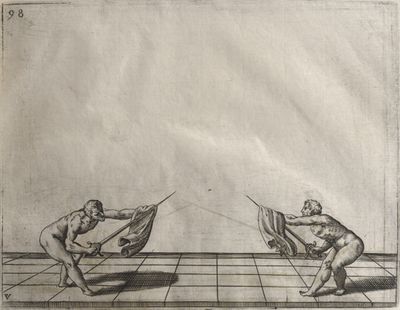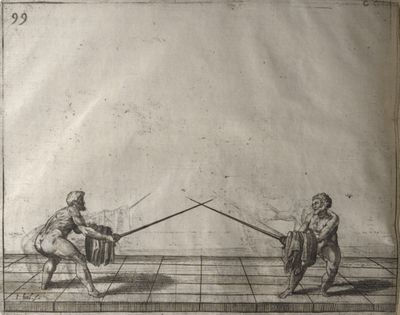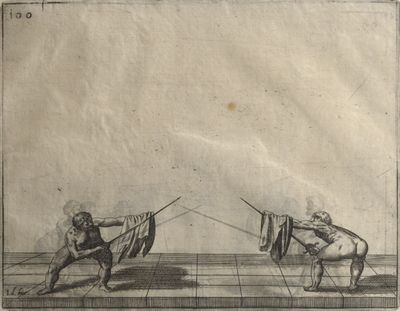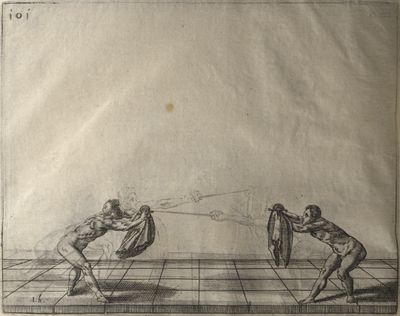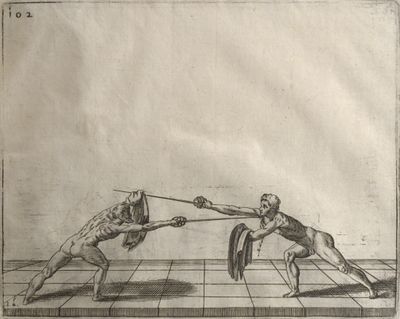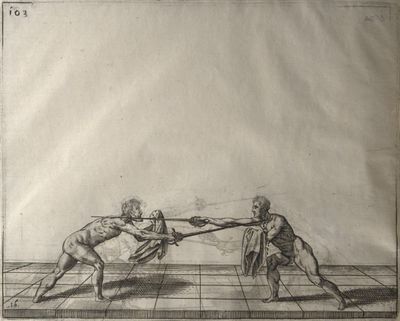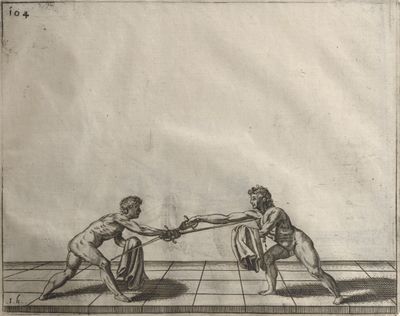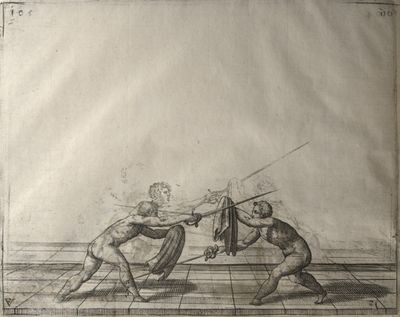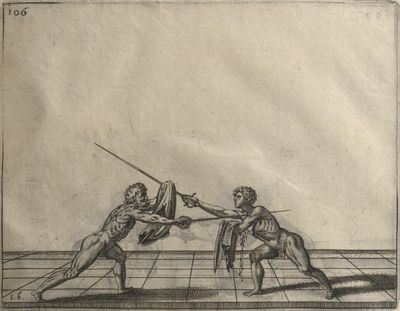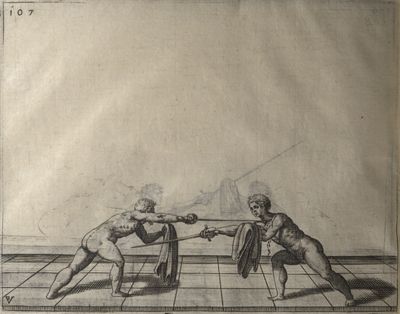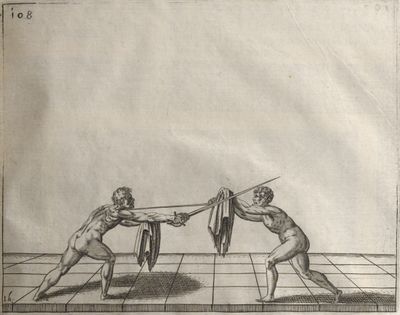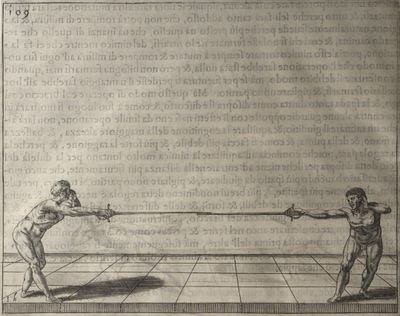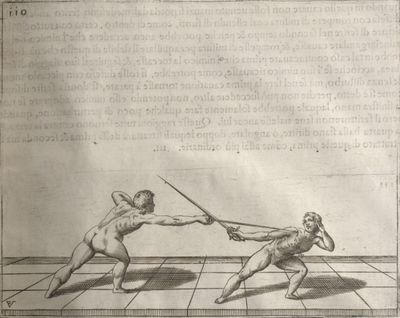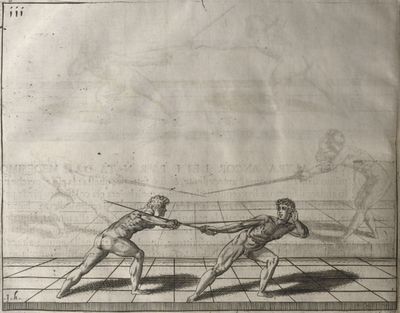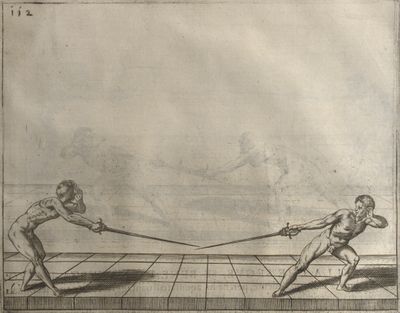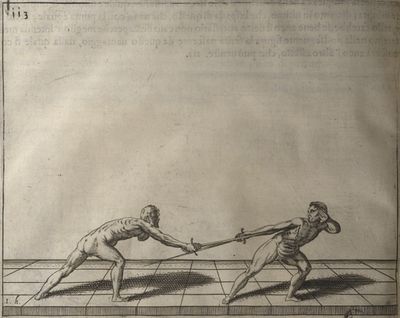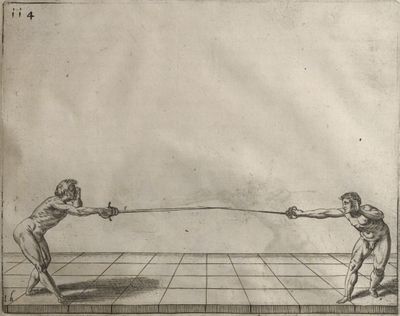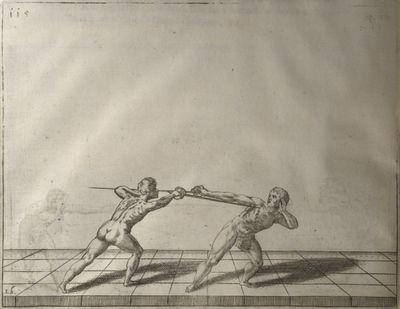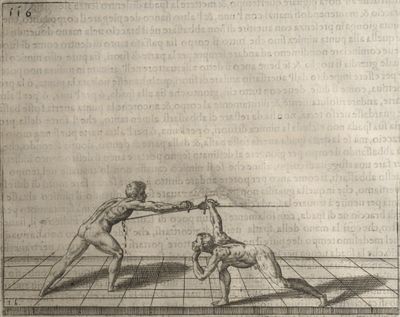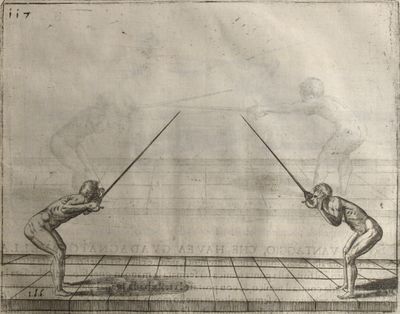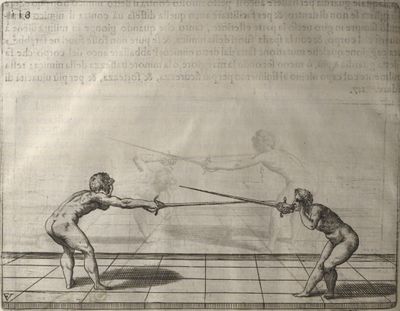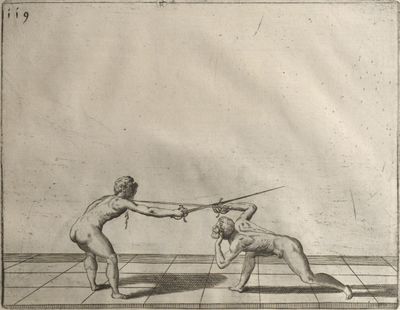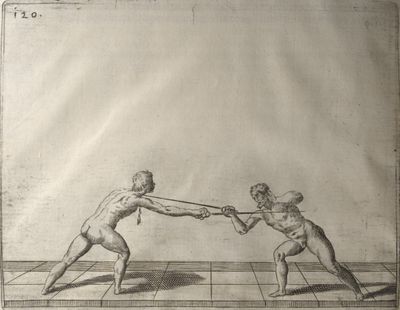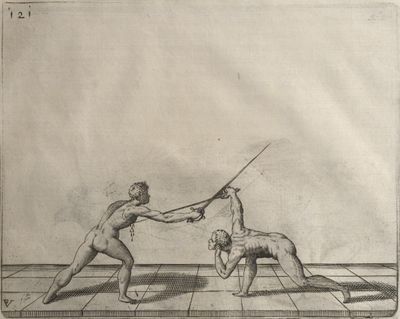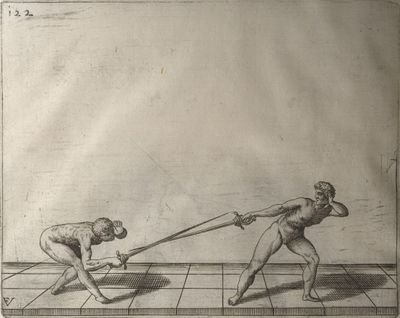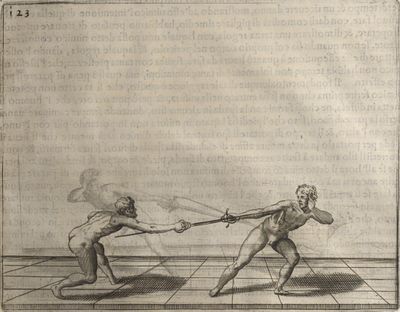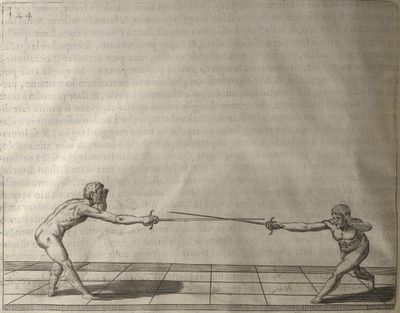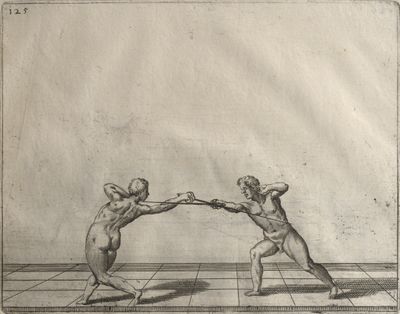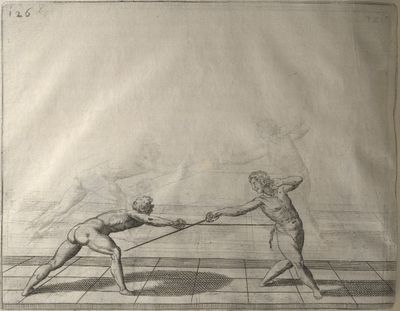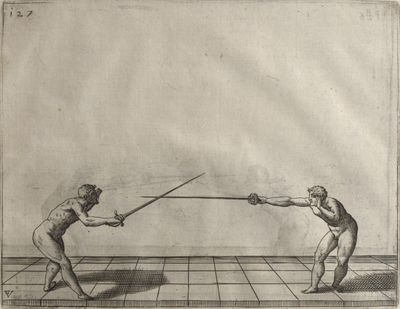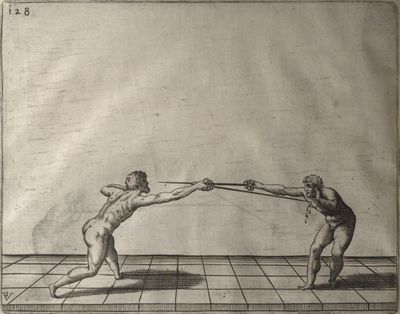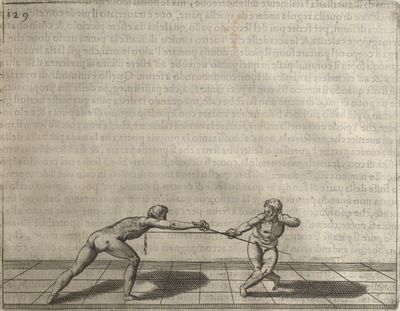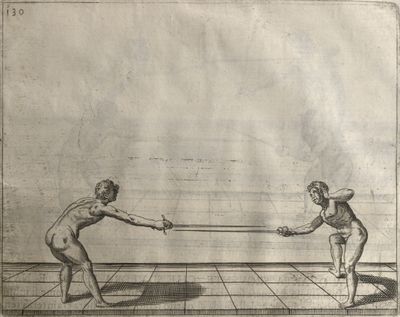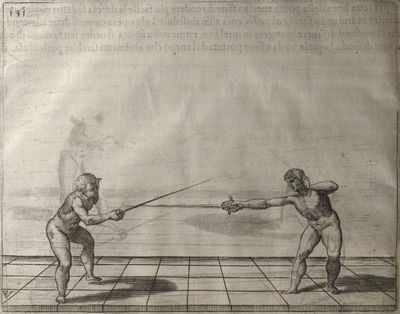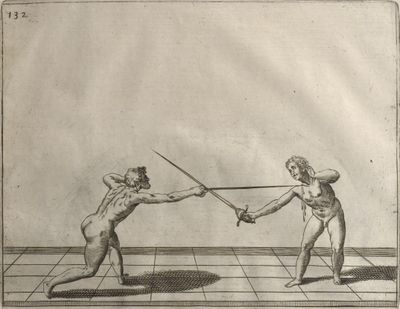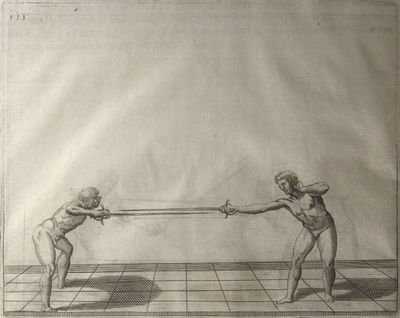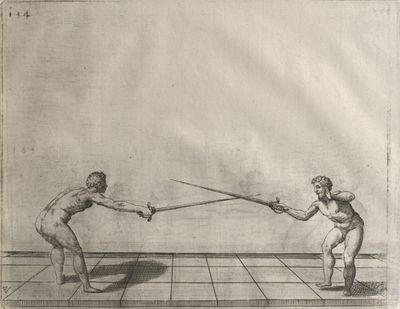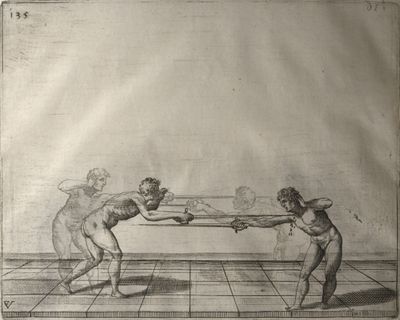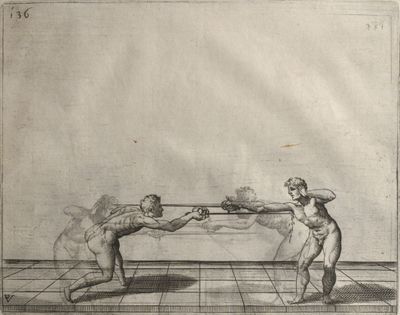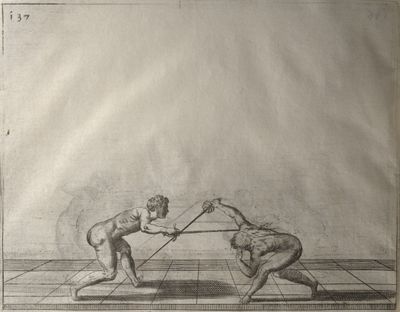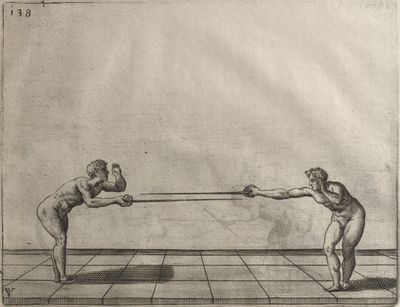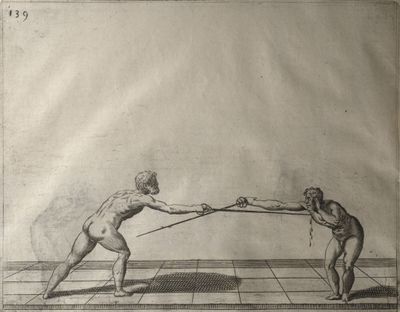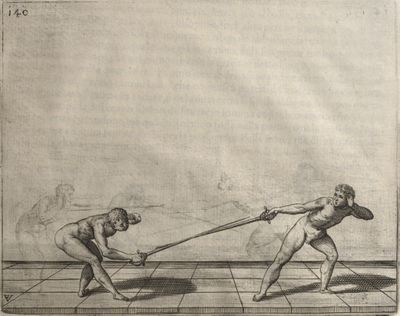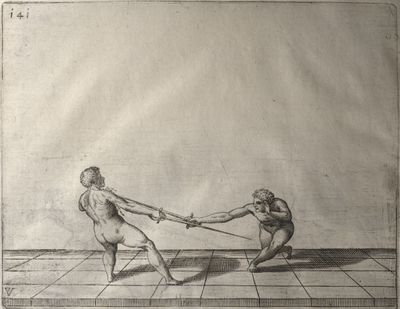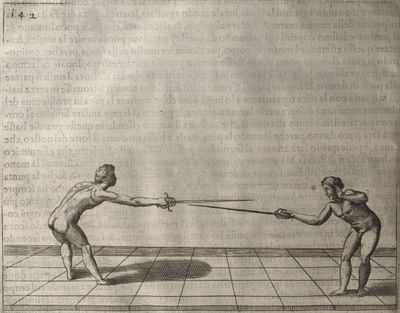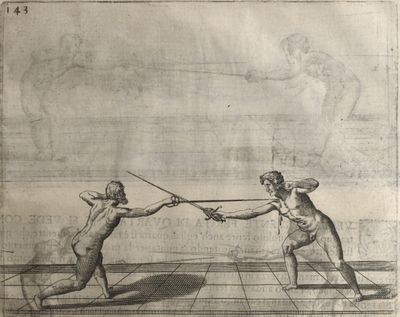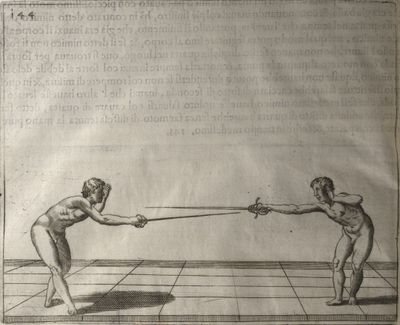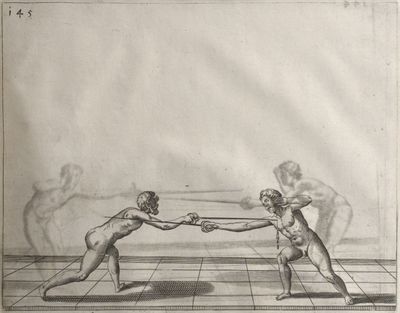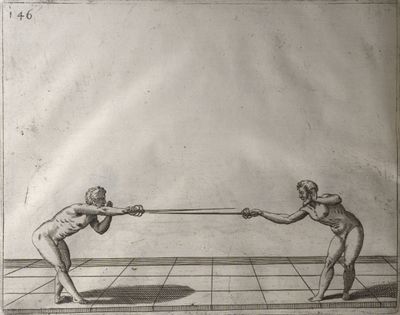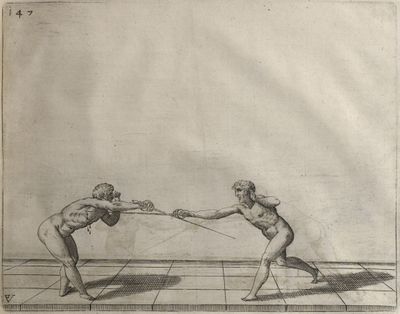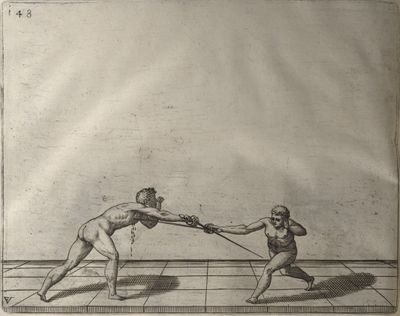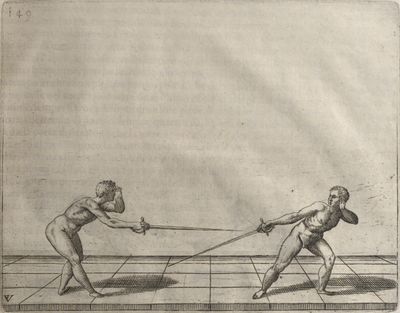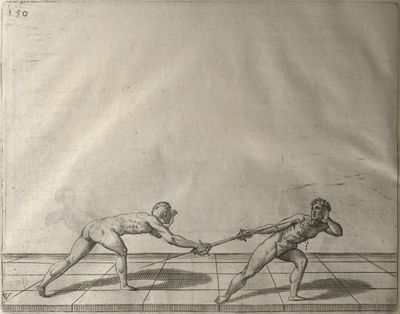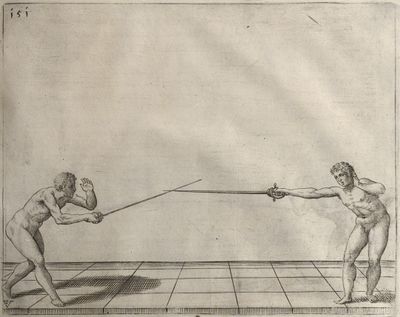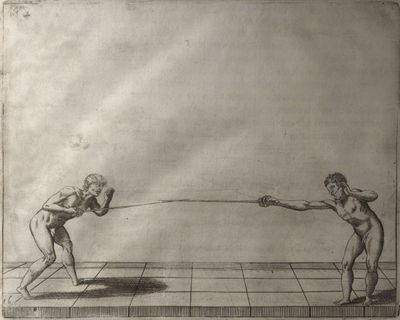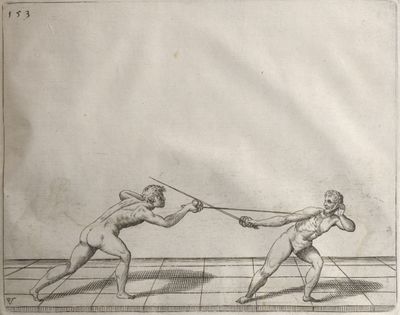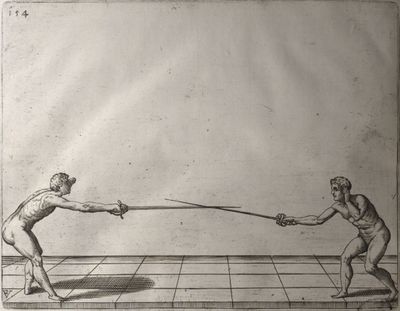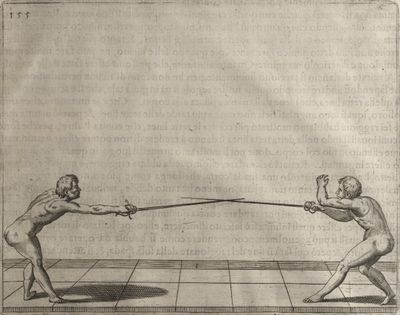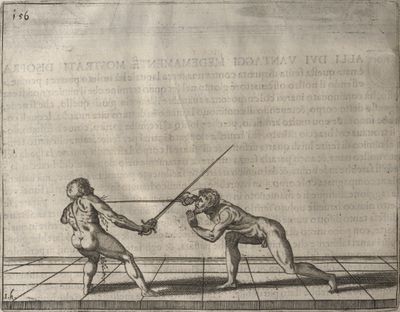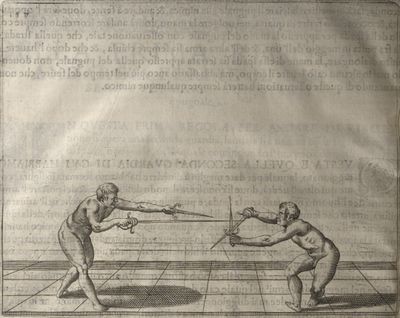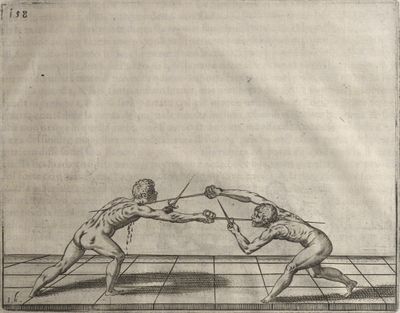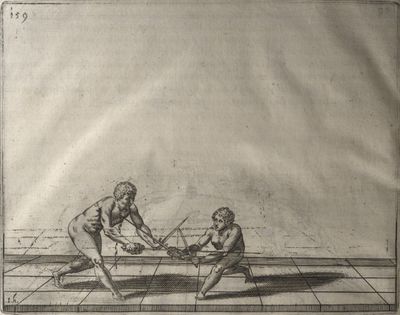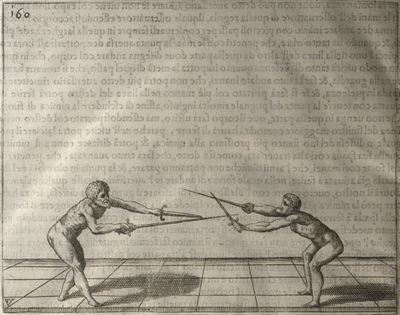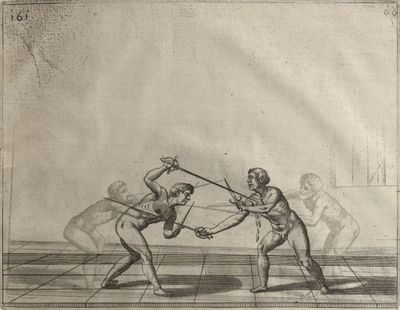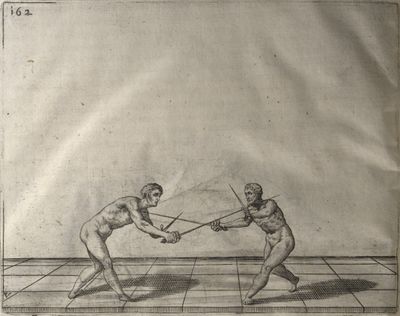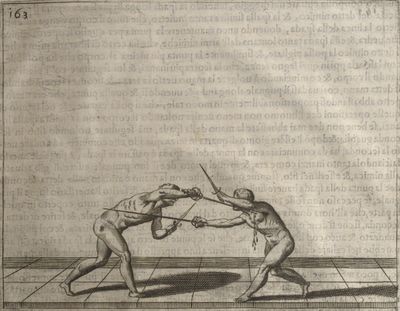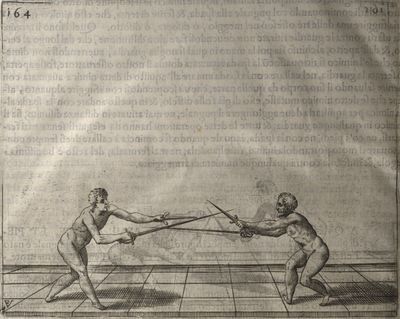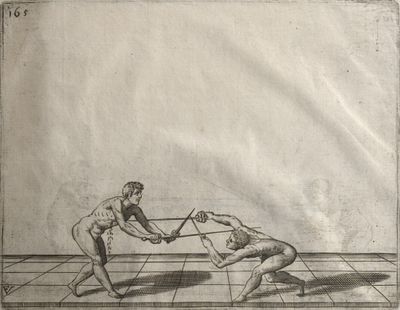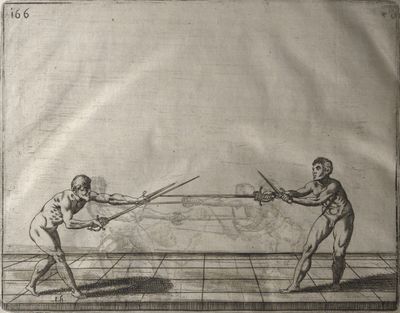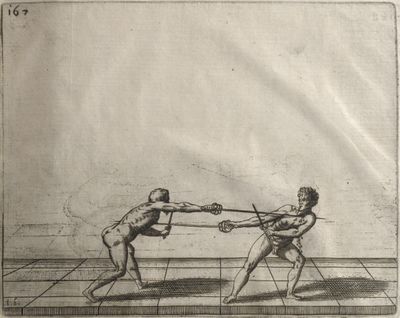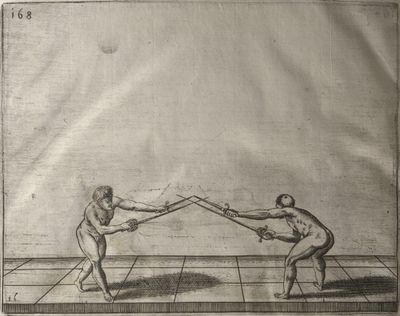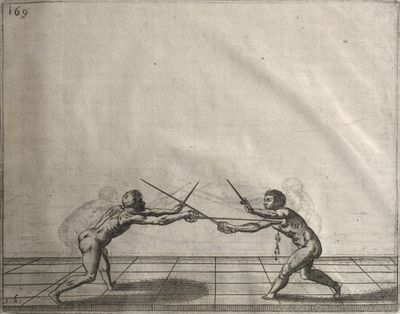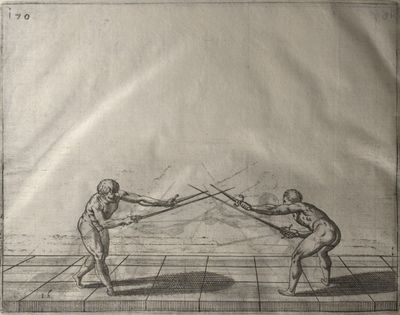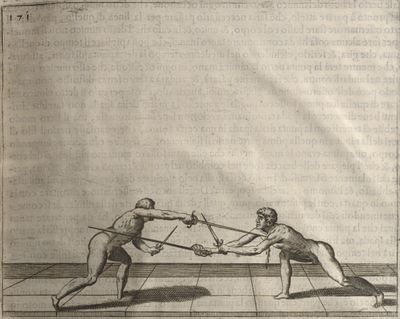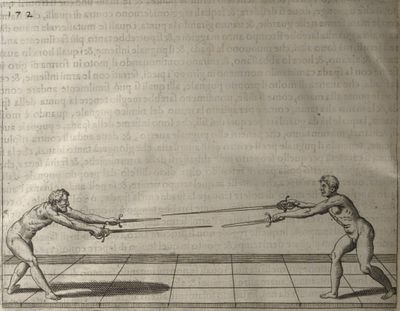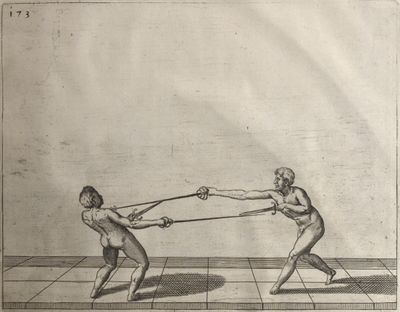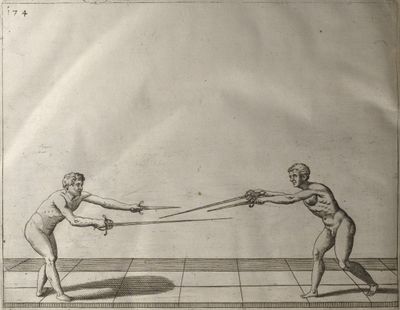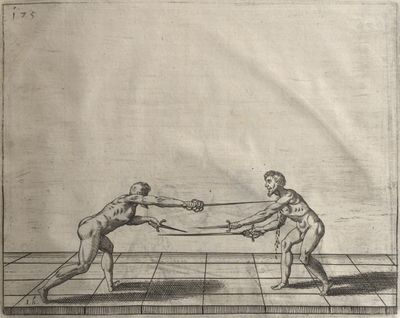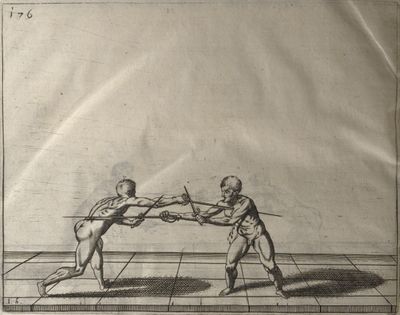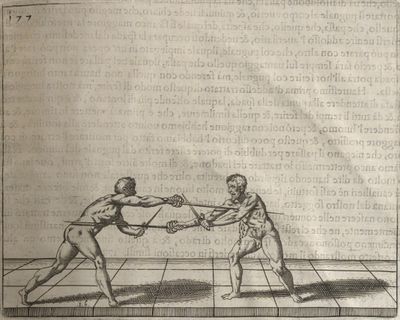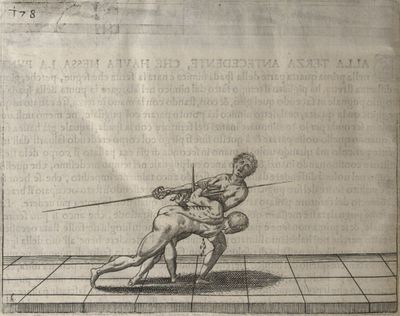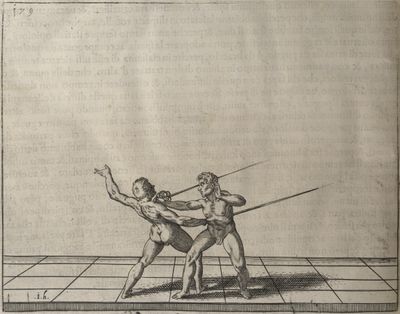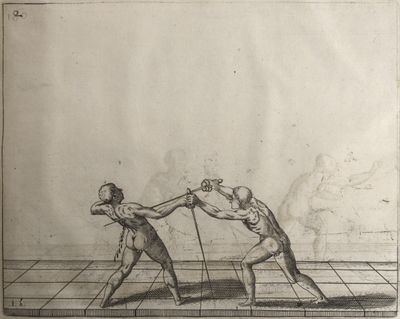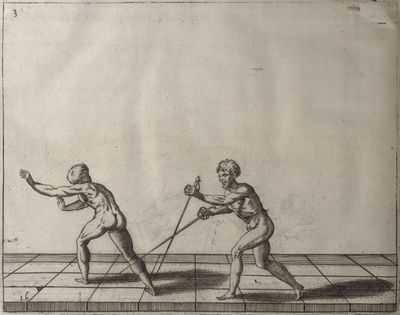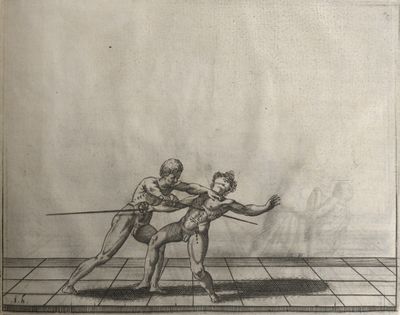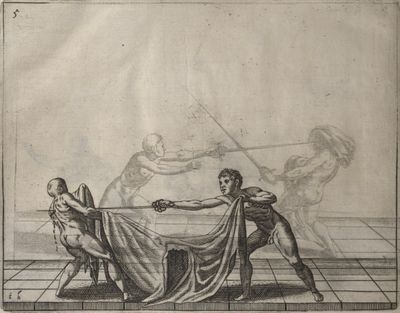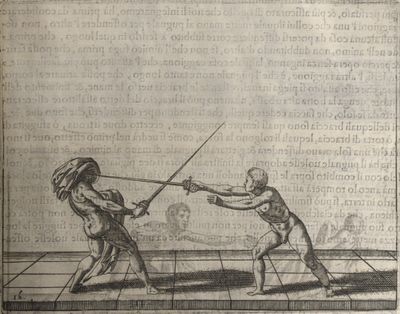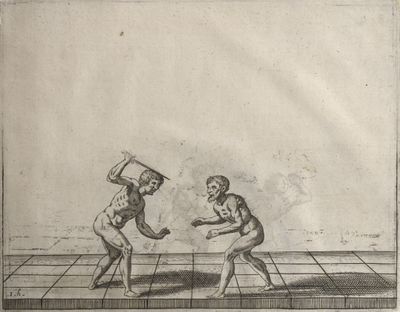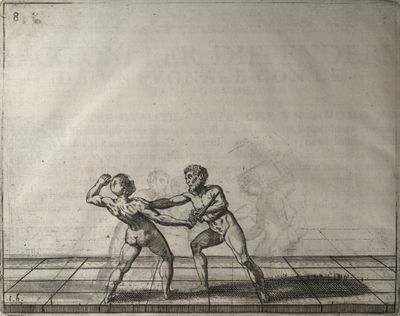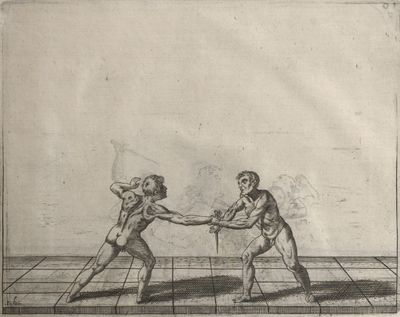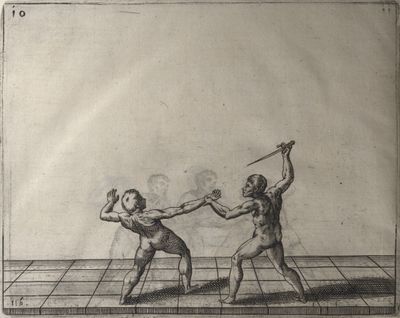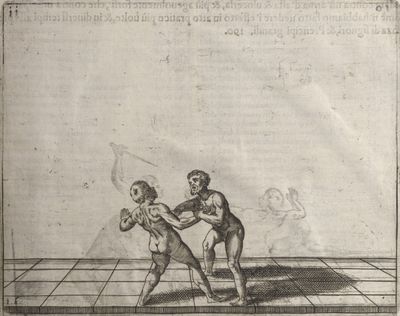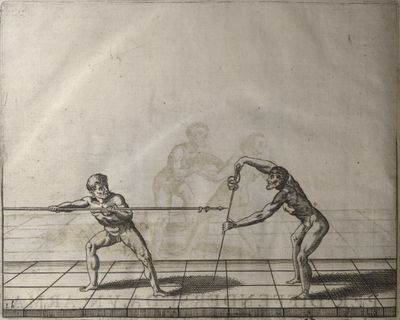Illustrations
from the 1601
|
Illustrations
from the 1606
|
Draft Translation (from the archetype)  (ca. 1900) (ca. 1900)
by A. F. Johnson (transcribed by Michael Chidester)
|
Prototype (1601)
|
Archetype (1606) [edit]
Transcribed by Michael Chidester
|
German Translation (1677) [edit]
Transcribed by Alex Kiermayer
|
|
|
|
[1] General discourse of the first book. The principles of the sword alone.
In opening our promised work we shall begin with the sword alone, for on the knowledge of the sword depend the principles of all other arms. Many rules will be given which may serve excellently for the sword accompanied by the dagger or any other arm. He who can use the sword alone well will easily learn to use it in conjunction with other arms. You must know then that the rules of the sword are founded on four guards in which are formed all the positions and counter positions. From them arise the times, counter-times, disengagements, counter-disengagements, double disengagements, half disengagements, and re-engagements; nor in short can anything be done in attack or defence which does not partake of the nature of one of these four guards. They are differently formed, as will be seen in the accompanying plates. These we have introduced in order that you may recognise with what variations of position of the sword, feet and body, they are made. We shall describe the nature of each guard in its place and the plates will show the results which may arise from them. The discourses will be such that you will easily see when to apply the various rules, and how to the best advantage you must approach your adversary in order to come within presence. Though one who understands the art may approach as he pleases, since in whatever position he is he will succeed by his knowledge of distances, weak and strong positions, exposed and unexposed parts. Nevertheless it is certain that one position is better than another, and a man may approach with more security when he parries his arms in the proper manner. When within distance he must proceed in various ways, according to the changes made and the opportunities offered by his adversary, and according to the distance in which he finds himself. The distances are two, and what is good in the one is not so in the other. These distances control the whole attack and defence, as we shall explain. First we shall describe the four principal guards, why they are called, prime, seconde, tierce and quarte, and the origin of these names. Then we shall treat of the divisions of the sword, then of counter-positions, distances, and some other matters which we consider necessary and useful to the good student of this art.
|
|
[1] DISCORSO GENERALE DEL PRIMO LIBRO Sopra li fondamenti detta spada sola. Cap. 1.
DOUENDO NOI DARE PRINCIPIO ALL’ OPERA promessa cominciaremo dalla spada sola come quella, dalla cognitione della quale dependono anco li fondamenti di tutte l’altre armi, & percio s’intenderanno molte raggioni, lequali potranno ottimamente seruire, ancorche sia accompagnata dal pugnale, ouero altra arma, & chi saprà bene oprare quella fola facilmẽte impararà di oprarla non meno accompagnata. Per tanto si dee sapere, che le raggio ni di essa hanno il suo fondamẽto sopra quattro guardie, con che si formano tutte le posture, & contra posture, & da esse nascono li tempi, & contratempi, cauationi, contracauationi, ricauationi meggie cauationi, & comettere di spada, ne si può in somma fare cosa alcuna per diffesa, ouero per offesa, che non si faccia con la natura di una di dette quattro, lequali uengono formate diuersamente, come si uedrà per le seguenti figure, poste da noi, acciò si conosca con quanta uarietà di siti, e prospettiue di spada, di piedi, & di corpo si facciano, & à suoi luoghi si discorrerà sopra la natura di ciascuna, & si metteranno anco in pittura li effetti, che da loro possono nascere, & i discorsi saranno tali, che ageuolmente si potrà comprendere, quando sia tempo ualersi hor dell’una hor dell’ altra raggione, & conche modo per maggiore uantaggio si debba andare contra il nimico per fermarsi in presenza, ancorche da uno che habbia scienza si possa andare come li piaccia, perche trouandosi in qualũque sito farà nascere buono effetto per la cognitione delle misure, debili, e forti, coperti, & scoperti, Nondimeno ècosa certa,che un sito è migliore dell’ altro, & più srcuramẽte Può l’huomo auicinarsi nelle distanze, quando, ché porta l’armi in debbito modo, doue poi gionto, hà da operare diuersamente, secondo le mutationi & opurtunità date dall’ auerssario, & secondo le distanze, inche si trouarà, lequali sono due, & quello, che è buono nell’ una non uale nell’ altra, & lequali distanze sono patrone di tutte le offese, & diffese, come si mostrarà, doppo, che fi Sarà dichiarato qualisiano le quattro principali guardie, & perche chiamate prima, seconda, terza e quarta & la deriuatione de nomi tali, il che fatto, si trattarà della diuisione della spada epoi delle contra posture, & delle misure, & di alcune altre cose gindicate da noi necessarie, & utili al buono osseruatore[6] di quest’ arte.
|
|
|
|
|
[2] Description of the four principal guards and the origin of their names.
The four guards arise from the four faces of the hand and the sword, that is to say of the two edges and the two surfaces; and these produce four different positions. prime is that position which the hand takes in drawing the sword from the scabbard, when the point is turned towards the adversary - all the guards especially with the sword alone must be formed with the point so directed. When the hand is turned slightly upward we have seconde, and tierce when the hand is in its natural position turned neither up nor down. When the inside of the hand is turned upwards we have quarte. The hand in turning can take these four positions only, and being in prime cannot go to quarte without passing through seconde and tierce; so the name quarte is given to the last position. prime is the most suitable position for grasping the sword, although it can be done in seconde or tierce: but with the hand in quarte the sword cannot be drawn from the scabbard. You must know that nothing can be done which does not arise from one of these four positions approximately; we say approximately, because, if you consider, you will find that there is a great distance between one guard and another owing to the width of the surface of the sword and of the hand, so that between prime and seconde there is a mean, where the hand might stop, and similarly between seconde and tierce, and between tierce and quarte. Therefore one might say that there were four legitimate guards and three bastard, since each bastard resembles the two, between which it is formed. But to avoid the confusion of so many terms we shall speak only of the four legitimate guards, which will serve very well for the three bastards also; for the quality of the guard is considered not only from the position of the hand, but also from the direction of the point, wherein lies the force of the guard. Therefore we shall divide the guards into these four only, especially as with the sword there are only four methods of hitting, that is on the inside, on the outside, below and above. The great differences between one guard and another will be explained when we treat of their natures, when we shall consider the various methods of defence, and the changes made in hitting, according to whether they are formed with the sword extended or withdrawn, high or low; we shall then treat of the nature of each one separately.
|
|
DICHIARATIONE DELLE QVATTRO Guardie principali, & donde deriuino linomi di esse. Cap. 2.
NASCONO LE QVATTRO GUARDIE DA QVATRO PROSPETTIVE, CHE HANno la mano, & la spada, ciò è dui fili, & dui piatti, che però fanno quattro effetti differenti, la prima si dimanda quelsito, doue uà la mano nel cauare la spada del fodero quando si uolge la puntauerso il nimico (perche intendiamo che tutte le [2] guardie massime nella spada sola si debbano cosi formare, & quando la mano si uolta un poco ingiù quella è detta seconda, la terza poi quando la mano sta naturalmente senza uoltarla ne nell’ una, ne nell’ altra parte, & la quarta quando si uolge essa mano dalla parte di dentro, laquale mano non può fare se non quelli quattro effetti nel uoltarla, & hauendola nella prima non può andare nella quarta senza passare per la seconda, & per la terza, che per essere l’ultimo effetto aquista nome di quarta. La prima è la più comoda per mettere mano alla spada, ancorche si possa fare, con la seconda, è con laterza, se ben non cosi facilmente, mà con la mano in quarta non si può già cauare la spada del fodero, & deesi sapere che niente si può fare, ilquale non proceda dalla natura di una di queste quattro noi diciamo natura, perche chi ben considera troua gran distanza trà l’una, & l’altra guardia, & questo per la larghezza del piatto della spada, & della mano, talmente che trà la prima, & la seconda uiè un meggio, douesi potrebbe fermare la mano, & così trà la seconda, & la terza, & trà la stessa terza, & la quarta, che perciò si potrebbe dire, che ui fossero quattro, guardie legitime, & tre’ bastarde, perche ciascuna bastarda tiene delle due, trà quali è formata, mà noi per non mettere confusione con tanti termini parlaremo solamente delle quattro legitime, lequali benissimo seruirãno anco per quelle tré bastarde, perche laqualità della guardia si considera non solo dal sito della mano, mà ancora dall’ effetto della punta, laquale dà la cognitione della forza di essa guardia, però ci deuiamo risoluere in queste quattro sole, & tanto più, quanto, che nella spada non cisono altre, che quattro maniere di ferire cioè didentro, di fuori di sotto, & di sopra, eui gran differenza similmente trà l’una, & l’altra guardia, come si mostrarà quando si trattarà della natura di esse, oue si uedranno di uerse diffese, & mutationi di ferire, secondo faranno formate longhe, ò ritirate, alte, o’ basse, & iui si trattarà della natura di tutte quante separatamente l’una dall’ altra.
|
|
|
|
|
[3] The divisions of the sword: the faible and the forte.
The blade of the sword is divided into four parts; the first is the part nearest the hand, the second quarter extends to the middle of the blade, the other two extend to the point. The first part near the hand is the strongest for parrying, and there is no thrust or cut, delivered by the strongest arm, which, if parried in this part, the sword cannot defend and resist without disorder, if the rule and the time is observed, as will be explained. The second part is somewhat weaker, but still it will defend well enough, if you parry where your adversary's sword has less strength. The third part is not good, especially against cuts, unless strengthened with the adversary's body at the moment of parrying; this will be explained in considering the defence. The fourth part is entirely bad and must not be thought of in the defence, although in the attack it is the strongest and most deadly. It is also true that a cut made with half the third part and half the fourth is a strong attacking stroke, whereas a cut made with the third part only would not be one half so effective as a cut made with the fourth part as well. The first and second parts then are only to be used in the defence, and the third and fourth in the attack; so that the sword is divided, one half into the defensive part, and the other the offensive.
|
|
DIVISIONE DELLA SPADA Per conoscere il debile, & il forte di essa. Cap. 3.
LA LAMA DELLA SPADA SI DIVIDE IN QVATtro parti, la prima è quella che pende più uicina allà mano, la feconda è quello altro quarto, che ariua sino à meggia lama, l’altre sono l’ultima metà spartita anch’essa in due, laquale uà sino alla punta. La prima parte appresso la mano è la più forte per parare, ne ci è botta di punta, ò di taglio tirata da ogni galiardo braccio parata in quella parte, che la spada non diffenda, e resista senza disordine, osseruandosi però la regola, & il tempo, come si dira’ la seconda parte è alquanto più debile, non dimeno anch’essa diffende assai, quando si sà andare à parare oue la nimica spada hà minor forza. La terza parte non è buona massime contra taglii, ne si può contra essi adoprarla, se non fortìfficandola col corpo nimico nel tempo; che si para, come pure s’intenderà oue si parlarà delle diffese. La quarta parte è intieramente cattiua, ne bisogna fare pensiero d’ hauerla quanto alla diffesa, sé ben nella offesa è la più ualida, & quella che più mortalmente ferisce, si come anco è uero quando un taglio fà la ferita meggia con la terza parte & meggia con la quarta, che fà anco all’ hor grand’ offesa, & che se fosse [3] della terza sola non farebbe la metà di quello, che fà con la quarta, la seconda & la prima parte dunque non s’hanno da oprare se non per diffesa, & la terza, & quarta peroffesa, in modo tale, che essa spada uiene ad essere compartita meggia in diffendere, & meggia in offendere.
|
|
|
|
|
[4] Method of forming the counter-positions, showing The position of the arms and the body, and when they are to be formed.
If you wish to form a sound counter-position, the position of the body and arms must be such that without touching the adversary's sword you are defended in the straight line from the point of his sword to your body, so that without making any movement of the body or the sword you are sure that your adversary cannot hit you in that line, but that if he wishes to attack he must move his sword elsewhere, with the result that his time is so long, that there is every opportunity to parry. But in forming this position care must be taken that your sword is held in such a way as to be stronger than your adversary's, so that it may offer resistance in defence. This rule can be observed against all positions and changes of your adversary, whether accompanied by the dagger or any other defensive weapon, or when you use the sword alone. He who can most subtly maintain this guard will have a great advantage over his adversary.
But it often happens that when you form this guard, your adversary forms another against it. Often also this guard is formed so far out of distance that your adversary can wait until you begin to move your foot against him, and at the moment of year advance change his line, so that you are disconcerted another counter-position. Therefore you must be full of devices and be able in a moment to take up another position of advantage against that of your adversary and make a fresh guard, unless you are so far within distance that you can hit him daring this change, and if in changing he has not retired, since if he had retired you could not hit him even if you had been within distance. You must then take up another counter-position and approach at the same time, to regain the same distance as before. In forming this counter-position you must bear in mind the rule, that the body must be so far distant that the adversary cannot hit, or, if you have approached within distance so that he could hit by advancing his foot, you must form the counter-position without moving the feet. In this way, if the adversary should attempt to hit during the movement, you could parry and hit him, or break ground;[7] in the latter case his sword, would not reach. But if in moving your weapons to take up this advantage, you have moved slowly, you could then abandon your object and hit at the very moment in which your adversary advanced to attack, parrying at the same time. So that if the first movement is made without violence, you can abandon your attempt and make another, as opportunity offers. In short, if you wish to get within distance with some safety, you must first form the counter-position, and if disconcerted by your adversary's counter-position, it will be better to break ground than to approach, until there is an opportunity to get an advantage.
|
|
MODO DI FORMARELE CONTRAPOSTVRE Per intendere come l’armi si denno situare & il corpo, & quando si hà da cominciare à formarle. Cap. 4.
VOLENDOSI FORMARE LA CONTRA POSTURA che stia bene fà di mestieri situare il corpo, & l’armè in modo, che senza toccare la nimica spada si sia diffeso dalla retta linea, che uiene dalla punta auersa al corpo, si che senza fare moto alcuno ne di corpo, ne di spacia si sia sicuro, che il nimico non possa ferire in quella parte, mà uolendo offendere sia neccessitato portare la spada altroue, & cosi il suo tempo uenga ad’ essere tanto longo, che dia gran comodita di parare, mà nell’ acconciarsi in cotal modo si richiede[8] si tuare la spada in guisa, che sia più forte della nimica acciò possa resistere nella diffesa, & laquale regola si può offeruare contra tutte le posture, & mutationi nimiche, tanto essendo accompagnata dal pugnale, onero da altra sorte di arma diffensiua, quanto con la sola spada, & collui, che saprà più sotilmente mantenersi in detta contraguardia haurà gran uantaggio soprà l’nimico, mà spesse uolte auiene che nel formarla esso nimico ne forma un’ altra contra quella & spesse uolte anco si uà à fare detta contrapostura lontano dalla misura tanto, che il nimico può aspettare che si comincia à mouere il piede contra di lui, & nel medesimo tempo, che si li auicina mutare effetto, & serrare di fuori l’offeruatore di questa regola con un’ altra contrapostura, Pertanto è neccessario l’essere ricco di partiti & sapere nell’ istesso punto trottare un’ altro sito uantaggioso à quello dell’ auerssario, & farli noua contraguardia, quando non si fosse tanto in misura, che si potesse ferirlo nella sua mutatione, ouero se esso nimico mutandosi non si fosse ritirato, perche in tal caso se bene si fosse stato nella misura non si; harebbe potuto ferirlo, mà si bene farli un’ altra contrapostura auicinandosi nel medesimo tempo per riguadagnare la stessa distanza di prima; & è di mestieri formando la contrapostura, di usare una certa raggione, ciò è che nelo situare il corpo si sia tanto lontano che il nimico, non possa ferire, ouero, essendosi gionto in distanza tale, cho detto nimico possa con l’auanzare il piede ferire, formarla senza moto de’ piedi, perche cosi facendo, ancor che esso nimico uolesse in quello mouimento ferire, potrebbesi parare, & ferire lui, ouero rompere di misura, che in quest’ alrro modo la nimica non arìuarebbe, mà se nel mouere l’armi per pigliare detto uantaggio, il moto fosse stato fatto lentamente, si potrebbe allhora lasciare l’in cominciato, & ferire in quello tempo proprio, che il nimico si fosse auanzato per offendere, parando insieme, si che se si farà il primo moto senza uiolenza si potrà lasciare l’ lincominciato, & farne un’ altro secondo l’ ocasione, dunque chi si uorà auicinare con qualche sicurtà nelle misure sarà neccessario formare prima la contra postura, & quello che si trouarà serato fuora dalla contrapostura nimica, haurà più raggione di stare in rompere di misura, che auicinarsi sino che li uenga comodità di pigliare il uantaggio.
|
|
|
|
|
[5] Explanation of the two distances, wide and close, and how to acquire the one or the other with least danger.
You are within wide distance when by advancing the rear foot to the front you can make a hit. After forming the counter-position a little out of distance, you must begin to advance the foot in order to get within the required distance. But you must be on your guard, lest your adversary, being steady, at the moment when you move your foot to advance it, should advance his too and hit at the same time. Therefore, you must move it very carefully, remembering that your adversary may effect something during the movement. After forming the counter-position you must endeavour to throw him into disorder, or at least make some feint in order to have an opportunity to hit. Thus prepared for what may happen you are more guarded and can better resist attack. When you are within wide distance and your adversary makes some movement of his foot, provided he does not break ground, you can hit him in the nearest exposed part, even if he has not moved his weapons. This could not be done if he moved his weapons and stood firm on his feet, the reason being that a movement of the foot is slower than that of the weapons, and therefore he could parry before your sword arrived, while he remained steady; if there were no other way he could protect himself by breaking ground, so that your sword could not reach. Being thrown into disorder you would then be in danger of being hit before you had recovered. Therefore whenever he gives an opportunity without moving his feet, it would be better to approach within close distance in that time. In that distance you can reach with the sword by merely bending the body, without moving the feet, and the adversary is forced to retire to get out of such danger. If he does not move you could hit him even though he retained the advantage of the counter-position. If your adversary does not move, you can sometimes make a hit by judging the distance from the point of your sword to your adversary's body and the distance from the forte of his sword. If you consider both how much you must advance the point and how far you must move it from the adversary's forte, and understand that the time required for him to parry is the same as for you to hit, the sword will arrive before he has parried by the advantage of having moved first. If you see that his body is little exposed, as may happen, since one guard covers more than another, you can then attempt to hit in the exposed part, and as he moves to the defence change your line and hit in the second exposed part.
These rules apply within close distance. If you are within wide distance and wish to advance within close distance, the danger is greater when the adversary stands steady on his guard, because if you raise your foot to advance it, you give him an opportunity to hit and retire, so that at the end of the movement you would be at the same distance, that is wide distance, and would have obtained nothing. All this is due to the fact that you cannot move your foot in less than two times, the one in lifting it and the other in putting it to the ground. For this reason some push the foot forward by scraping it along the ground, which is well enough in the hall, but in the street is likely to lead to a fall because of the many unevennesses. It is better then to lift it to make sure of not stumbling. Therefore in carrying the foot within close distance you must first form a good counter-position, and then lean all the weight of the body on the rear foot as you lift the forward foot, so that if in that moment your adversary should thrust you would be able to parry and to hit by bringing your foot to the ground, or even extend that movement which you had already begun beyond your first design, in order to reach more certainly in case your adversary broke ground in making his hit. If the adversary has not moved the pupil must after raising the foot carry it within close distance in such a way that the weight of the body rests on the rear foot, and is no nearer than when within wide distance. After putting your foot to the ground you could then by merely bending the body hit on the slightest movement if[!] the adversary in the line exposed nearest to your point.
If you did not wish to wait you could hit in the manner already described. If while you are carrying your foot within close distance, your adversary should retire, you would remain within wide distance, and must bring the weight of the body from the rear foot to the forward and then bring up the rear foot close to the other. In approaching within close distance always take care that the body does not approach with the foot, but remains in the same position as before, and after bringing your foot to the ground carry forward the body. This rule should be observed in every case of requiring close distance, but after hitting you must in recovering your weapons draw back the body as far as possible and draw back the foot in such a way that if your adversary follows you are ready to parry and hit. If you find that your adversary is always breaking ground you must not grow angry and pursue him. Rather you must then proceed more carefully, for many feign a retirement with the object of drawing on their adversary and seeking an opportunity to hit in the moment of his pursuing. If you follow our method you will avoid this danger. It is better not to pursue one who flees, but rather to feign reluctance in order to reassure him and so draw him on, and then to seize an opportunity which he will not have time to avoid.
|
|
[4] DICHIARATIONE PER INTENDERE Delle due misure quale sia larga & stretta, & il modo da tenersi per aquistare l’una, e l’altra per men pericolo. Cap. 5.
MISURA LARGA SI DIMANDA QVELLA, LA QVALE con l’auanzare il piede anteriore l’huomo può ferire il nimico, in modo, che dopò formata la contrapostura poco lontana all’hora si dee cominciare à portare il piede inanzi per ariuare in detta misura, mà ricercasi lo stare auertito, perche essendo il nimico fermo, nel tempo che si moue il piede per portarlo oltre, che ancor lui non portasse il suo & battesse in quello punto medesimo, però si dee mouerlo molto consideratamente credendo, che esso nimico possa fare qualche effetto nel proprio tempo di quello moto; & dopò hauere fatta la contrapostura si dee procurare di farlo disordinare, se non con altro almeno con qualche sinta per hauere poi occasione di ferirlo, & cosi aspettando quello, che può accadere si stà più aueduto, & più facilmente si resiste alli incontri: qnando[!] poi si sia gionto in detta misura larga, & che il nimico si moua col piede per accomodarsi, purche non rompa di misura si può ferirlo nelo scoperto più prossimo ancorche egli non habbia fatto moto dell’armi, cosa che non si potrebbe fare se le mouesse, & stesse fermo de’ piedi, & questo perche il moto de piedi è piu’tardo che quello delle armi, & però potrebbe esso nimico parare inãzzi che la spada giongesse portata dal piede, mentre lui fosse fermo, & quando non si sapesse per altra uia diffendere, si saluarebbe col rompere di misura in modo che la spada non lo ariuaria, & essendo già disordinato si trouaria in pericolo di restare ferito prima, che si fosse rimesso talmente, che quando egli desse occasione senza mouere li piedi sarebbe più à proposito lo auicinarsi in quel tempo nella misura stretta, doue la spada ariua col solo piegare del corpo, & senza il mouere de’ piedi, che esso nimico sarebbe forzato à ritirarsi per non rimanere in pericolo tale, & se non si mouesse si potrebbe ferirlo, quando che si hauesse conseruato il uantaggio della contrapostura, & si potrebbe alcune uolte ancora ferire se bene il nimico non si mouesse cioè per il conoscere quale distanza fosse dalla propria punta al corpo nimico, & quanto lontana dal forte de lo stesso nimico, hauendo parimenti consideratione diquanto si debba auicinare la punta, ouero lontanarla da esso forte nel ferire, & conoscendo che sia tanto grande il tempo, che hà da fare l’auerssario in parare come il suo in ferire, la spada senz’altro ariuarà prima, che quello habbia parato, per il uantaggio, di essere stato il primo à mouersi; mà uedendo il corpo auerso póco scoperto, come può auenire, perche una guardia lo cuopere più dell’ altra, si può allhora andare per ferire quello scoperto, & nel tempo che’l nimico si moue alla diffesa mutare l’effetto, & ferire nelo scoperto secondo; Queste raggioni s’intedono doppo entrato nella misura stretta, perche ritrouãdosi nella larga, & uolendo andare l’huomo nella stretta, quando, che l’nimico stà fermo nella sua guardia il pericolo all’ hora è maggiore, perche leuando il piede per portarlo inanzi quello e un tempo, nelquale può esso nimico ferire con ritirarsi: indietro, di modo che finito il moto della distesa si trouarebbe il detto huomo lontano, cio è nella larga, & cosi non haurebbe [5] aquistato cosa alcuna, & tutto procederebbe perche non puo il piede mouersi con meno di dui tempi l’uno nel lèuarlo l’altro nel metterlo in terra, & per tale caogione alcuni lo spingono inanzi sdruzolandolo per terra, che nelle sale è buono, nelle strade è per cadere rispetto ai molti impedimenti, che possono trouarsi, che per tanto è meglio leuarlo assicurandosi di non traboccare, si che uolendo portare il piede nella misura stretta prima si richiede l’hauere formata ben la contrapostura, & doppo fondare tutto il peso del corpo sopra il piè di dietro leuando quello dinanzi, in modo che se in quel tempo il nimico tirasse si possa pigliare il contra tempo di parare, & ferire nel mettere propriamente il piede in terra anzi stendere quel moto, che si hauea cominciato più inanzi di quello che si hauea disegnato per meglio ariuare in ogni caso, che detto nimico rompesse di misura nel suo ferire, ilquale nimico se non si fosse mosso, douria il nostro osseruatore, leuato che hauesse il piede, portarlo nella misura stretta mà in modo, che tutto il corpo restasse sopra quello di dietro, acciò non s’auicinasse più di quello, che prima era, quando si trouaua nella misura larga, & doppo messo il piè in terra potria all’hora col solo piegare del corpo, ferire in ogni minimo moto ne lo scoperto più uicino alla punta, & anco, non uolendo aspettare, potria ferire con la maniera inanzi scritta, & se nel portare il piede in detta stretta misura esso nimico si ritirasse il nostro sarebbe ancora nella larga, & douria piegare il corpo, che era restato sopra il piè di dietro, nel anteriore, & poi ricuperare il medesimo di dietro appresso l’altro, contenersi sempre nelo portarsì nele strette misure in modo, che il corpo non si approssimi col piede, mà resti nelo medesimo segnò, doue prima era, & dopò fermato il piede portare il corpo, questa raggione è buona da osseruarsi in ogni caso di aquistare la misura stretta mà hauendo ferito si dee nel ricuperare l’armi allontanare sempre il corpo quanto, che più si può ricuperando il piede con comodità tale, che quantunq; il nimico seguisse si sia pronto à parare, & ferire, & trouando, chel detto nimico andasse sempre rompendo di misura non bisogna mettersi in furia, & uolerlo seguire, anzi all’hor si ricerca lo andare più considerato, perche molti singono ritirarsi procurando di tirarsi[9] dietro l’auerssario affine di trouare comodità da ferirlo nel tempo, che quello lo segue, & però tenendosi l’ ordine nostro cessarà simile pericolo & meglio è mentre che uno fuggie non uolerlo seguire anzi mostrare di ricredere per più assicurarlo, & con tale arte tirarlo inanzi, & poi pigliare quella occasione, the non potrà all’hora fuggire in tempo.
|
|
|
|
|
[6] Discourse on rushing in with the sword extended and the principles of the two times, showing that it is better to control the sword and observe the correct time.
There are some who, in endeavouring to hit with the point, hurl the arm violently forward so as to give it greater force. This method is not good for the reasons which we shall bring forward. In the first place when you rush in with the sword, should your adversary anticipate you and defend the part where you intended to hit, you cannot change your line, as would be necessary, so that the adversary is sure of his defence. If he has also realised the weakest part of your thrust and pushed your sword in the direction in which it is being naturally carried, he will drive it out of line all the more quickly. His defence will be very simple without using any force, because if he pushes the sword in the direction in which it is naturally falling, it will fall the quicker without any resistance. In this manner his faible is stronger than the forte of the hitter. Moreover in completing the rush the point of the sword drops so that it cannot hit exactly the point aimed at, and also at the end of the extension it is impossible to prevent the arm and sword from dropping to the great advantage of your adversary. Further after one rush it is impossible to make another without withdrawing the arm again, which takes so long that, if the adversary has not hit at the first fall of your sword he could hit while you are withdrawing your arm, and recover before the second rush, with excellent opportunity of parrying and hitting even if he did it in two times, that is parrying first and then hitting. The rule of the two times then would be good enough against such a method, and all the more successful as those who rush cannot make any good feint; for in feinting they move the foot or the body without advancing the sword, or if they advance it often withdraw it even further than before in order to hit with greater force, a very slow and dangerous time.
In treating of the rule of the two time, we say that, although it may succeed against some, it is not to be compared with the rule of parrying and hitting at the same time, because the true and safe method is to meet the body as it advances, before it has had time to withdraw and recover. If you then pursue you give an opportunity for parrying and hitting again. It has been our experience, that most of those who observe this rule of two times, if they can engage the adversary's sword, generally beat it in order then to proceed with the stroke. This would be successful but for the danger of being deceived. He whose sword has been beaten on the faible certainly cannot hit at the same time, as he is thrown into disorder by the beat. But if he happens to disengage he causes the sword which has beaten and missed to drop still further, and has an excellent chance of hitting. Even if he made a feint of beating, so that when the adversary disengaged he might beat in another part, he would still be in danger of being hit, because the adversary might make a feint of disengaging and return, and in this way the one who had meant to beat would not be able to parry. Finally it may be taken as established that it is impossible to beat your adversary's sword without putting your own out of line. Moreover sometimes if you attempt to beat the faible, according to rule, you meet the adversary's forte, which he has pushed forward, so that the beat fails and your adversary proceeds to hit without your being able to prevent him. In dealing with one who does not rush, but controls his sword, even though you beat his faible, his forte does not move, so that he can parry. Therefore, we conclude for these reasons and for many others which might be adduced, that it is better to parry and hit at the same time, though with the sword alone great judgment is required to effect the two at one moment. As to controlling the sword or thrusting with violence, controlling it is beyond comparison better, first because he who controls his sword, when it is beaten by the adversary, who means to hit in another line, can let it yield in the direction of the beat, and the forte will still defend, if the sword is held well advanced. Further it is certain that when your sword is beaten, it is immediately freed. Similarly it is more useful to know how to be master of your sword, to engage the adversary's faible and make a hit as opportunity offers, always holding his sword in subjection. If he cannot free his sword he cannot hit. Therefore this rule can be followed only by one who moves his sword without violence, works in such a way as to be always master of it, and if he is prevented by his adversary in any plan can abandon it and adopt another. He will hit at the very moment when his adversary has meant to prevent him, and without deviating his point or withdrawing it he will be able to carry it on to the adversary's body. The principle to be observed is this, that in proceeding to make a hit either by a feint of disengaging or any other change, when once you have begun to approach, the point toward the adversary, you must continue until you reach the body; for if you check the sword in order to disengage or change your line you will not arrive in time. This principle cannot be observed by one who rushes, so that the difference is easily understood. Moreover the sword which is held firm and accompanied by the foot and the body has greater force and exactness. He who so hold[!] it always controls it and does not let it drop after a hit. He has only to withdraw his foot in order to bring his body to safety, unless he has passed, and to engage the adversary's sword again. If your adversary as you withdraw, pursues or advances, you can hit again, defending at the same time. All this is because of the union between the sword, the feet and the body. If this rule is observed in the manner we have described, your parrying will be safe, whereas with the rule of the two times it is false; this will be better understood in its place.
|
|
DISCORSO INTORNO IL LANCIARE DI SPADA, ET raggioni di dui tempi per fare sapere se sia meglio il portarla, & osseruare o; giusto tempo. Cap. 6.
SONO ALCUNI, CHE UOLENDO FERIRE DI PUNta lanciano il braccio con uiolenza perdarli maggior forza, tale maniera non è buona per le raggioni che assignaremo prima perche, se il nimico in
quello lanciare di spadga, preoccupasse, & diffendesse quel luogo oue si hà disegnato ferire non si può lasciare quello effetto, & farne un’ altro, come si richiederebbe talche esso nimico uiene ad’essere certo della diffesa, & se egli haurà conosciuto la parte più debile, & l’haurà spinta, doue la natura la porta tanto più [6] presto haurà fatto uscire di presenza quella, slanciata, & sarasi esso diffeso molto comodamente senza oprare forza alcuna, perche chi spinge la spada da quella parte oue dee cadere naturalmente essa uà à cadere più presto & senza fare resistenza nissuna, & in questo modo più uale il debile di quello che para, che’ il forte di quello, che fere; in oltre nel finire il slancio la punta della spada, sguinza in modo, che non può andare à ferire,oue guistamente si hauea tolta la mira, & anco nel finire detta distesa non si può tenere il braccio, & la spada, che non cadano con dare gran comodità al nimico di ferire, aggiungendosi ancora, che dopò slanciata unauolta non si può slanciare un’ altra, se non ritirando il braccio di nouo, tempo tanto grande, che se l’istesso nimico non hauesse, ferito nella prima caduta potrebbe ferire nel tempo di questo ritirare il braccio, & saluarsi anco prima, che si slanciasse un’altra uolta, & con hauere buona comodità ditornare à parare, & ferire, se bene lo facesse di dui tempi cio è prima parando, & poi ferendo, in modo che la raggione de dui tempi uerrebbe ad’essere assai buona contra simile maniera, & tanto più riuscibile, quanto che costoro, che feriscono di slancio non possono fare finta di forte alcuna, che stia bene, perche nel fingere fanno similmente moto col piede, o col corpo, senza auanzare la spada ò se pure l’auanzano la ritirano ben spesso più indietro, che prima noti era per ferire con maggiore forza, tempo tardissimo, & dannoso. Hora per trattare delle raggioni de’ dui tempi diciamo, che se bene contra di alcuni potrebbero riuscire, nondimeno non hanno da equipararsi alle raggioni di parare, & ferire in tempo medesimo, perche il uero, & sicuro modo è di incontrare il corpo nel punto medesimo; che quello si spingie inanzi, altrimenti egli subbito s’allontana, & resta saluo, & chi lo seguittasse li darebbe comodità di parare, & tornare à ferire un’altra uolta. Habbiamo ueduto per isperienza, che i piu di questi, iquali osseruano le dette raggioni de’ dui tempi, come possono hauere la spada nimica sogliono batterla per potere poi andare à ferire, il che sarebbe assai riuscibile quando non ci fosse il pericolo di reftare ingannato, perche colui à chi uiene battuta la spada nel debile non può certamente ferire in medesimo tempo per hauerla disordinata dalla battuta, mà se auiene, che caui caggiona, che la spada, dell’altro, che hà battuto, non hauendo trouata la nimica, fa caduta maggiore, & porge oportunissimo tempo al nimico di ferire, & ancorche fosse andato per fingere di batterla acciò detto nimico la cauasse per batterla poi dall’altra parte, non dimeno ancor questo sarebbe pericoloso di restare ferito, perche lo stesso hauria potuto fingere di cauare, & rimetterla, & à questo modo colui, che hauesse uoluto battere non hauria potuto parare, si hà dunque da tenere per fermo, che non si può battere l’altrui spada, che non si suii la sua propria dalla presenza, & tanto più non la trouando, oltreche alcune uolte si uà per battere il debile, come è di raggione, & si troua il forte spinto oltre dall’auerssario, restando in tal modo fallace la battuta, & all’hora uiene lo stesso auerssario à ferire senza potere essere impedito; Mà doppo questo hauendo à fare con chi non lancia mà porta la spada, anco che seli batta il debile non dimeno il suo forte non si moue in modo, che può parare, & però si conchiude tanto per queste raggioni, quanto per molte altre, che potriano addursi, che meglio è il parare, & ferire in tempo medesimo, se bene con la sola spada ci si richiede giuditio grande à uolere che faccia questi dui effetti in un solo punto. Quanto al portare della spada, ouero slanciarla meglio senza comparatione è il portarla, come si intenderà, prima perche una spada battuta, mentre è portata da un’ luogo all’altro, colui, che la porta può lasciarla andare da quella parte doue il nimico la batte, che andarà à ferire in un’altro luogo, & il forte restara sempre alla diffesa, quando si giocarà la spada auanzata, oltre che questo tale è certo che essendo battuta è fatta ancora subbito libera, similmente è più utile lo sapersi conseruare padrone di essa, occupando il debile nimico, & portarsi à ferire secondo l’occasione con tenere sempre suggita la nimica spada, laquale se dall’ ingegnodi esso nimico non si saprà liberare lui non potra mai serire, & perciò questa raggione non può essere osseruata se non da colui che moue la spada da un’luogo. all’altro senza lanciarla, & opera in guisa, che [7] sempre è padrone di essa, & che se uà per farè un’ effetto quale li uenga impedito dalo stesso
nimico sà lasciare l’incominciato, & farne un altro; questo tale adunque ferirà nelo medesimo
tempo, che l’auerssario l’haurà uoluto impedire, & senza deuiare la punta, ò ritirarla,
potrà continouare sino al corpo del detto auerssario, perche l’ordine, che hà da tenere è che
andando per ferire, ò per fingere di uolere cauare ò fare altra mutatione, mentre che hà cominciato
ad auicinarela punta uerso il nimico, è neccessario continouare sino che la peruiene
al corpo, perche chi la uolesse trattenere affine di cauare, ò mutare effetto non ariuarebbe
di tempo, & questo non si può osseruare da quello, che slancia, & perciò si può benissimo
comprendere la differenza, & tanto più che portandola ferma, & accompagnata dal piede,
& dal corpo la spada hà maggior forza, maggior giustezza, & chi la porta è sempre più padrone
di essa non facendo caduta alcuna doppo che hà ferito, talmente che non occore fare
altro doppo ferito se non di ritirare il piede, se non si fosse passato, per dilongare il corpo, &
per ritornare di nouo all’ aquisto della nimica spada, & in caso che il detto nimico, in quello
ritirarsi, seguittasse per ferire, ò auicinarsi, si può ritornare à ferire con la diffesa insieme, &
tutto per la unione in che si troua di spada, piedi, & corpo, laquale osseruatione se nel soprascrittò
modo sarà usata, il parare sarà sicuro, si come nelle raggioni de’ dui tempi è falso, come
à suo luogo anco meglio s’intenderà.
|
|
|
|
|
[7] Discourse on cutting. How many cuts there are and how they are made, their nature, and whether it is better to use the point or the edge.
The principal cuts are four; they are delivered in different ways and in different directions, as will be seen in the plate which follows (pl. 1.) with their names. The names are derived from the four principal cuts, that is mandiritto, riverso, sottomano and montante. They are delivered in various ways, for some deliver them from the shoulder, some from the elbow, some from the wrist, and some again from the shoulder but with the arm extended and stiff, keeping the point always directed towards the adversary. In making the first cut from the shoulder, the arm is raised and makes a circle with the sword in order to strike with greater force. This is the worst of all because of its excessive slowness and because you may easily be hit as you raise the arm, as you let it fall, or after it has fallen; for as the sword is not supported by the adversary's weapon or body, there is nothing to prevent it from passing on behind his back; or if the hit is made downwards, the sword is in danger of being broken on the ground. In either case so much time is lost that your adversary may easily hit. The second method from the elbow also carries the hand out of line, both when it is raised and when it falls after missing, so that in this case too you may be hit, but not so easily, as the sword does not make such a large circle, nor does the raising of the arm uncover so much, nor the sword fall so far. Therefore as the movement is quicker and you remain better covered, this method is better than the first. The third method, made from the wrist downwards with the arm straight, although the sword makes a circle is beyond comparison better than the two first described, since the body is more covered. Nor can you be so easily hit, since it is quicker, and the point in falling remains in such a position that you can parry with the forte either thrust or cut, and can cut again. Similarly the fourth method with the arm stiff and extended is far better than the two first, since you hit without making a circle with the sword, raising it little or nothing. The sword is allowed to fall on an exposed point, and when your adversary makes a circle with his sword in order to hit, with this fourth method you can continue your stroke, as you will certainly hit before his falls. You will be all the more secure if you have worked with the feet and the body, as you should, because if you remained upright when your sword fell, you could not recover in time, especially if your adversary's cut had been made from the elbow. But if you lower your body the sword is more quickly recovered and has less distance to move in returning to the defence, for as you hit with the arm stiff and extended without bending the wrist, the sword still remains in front and can easily return to the straight line. For this reason the fourth method is better than the two first and in defence better than the third, although it appears to us that the third is much freer or less restricted, and without requiring so much strength has more variety and can more easily deceive the adversary.
He who wishes to make a cut with safety, must wait a fitting opportunity, since he cannot make the stroke in a moment, and the time might have passed before the sword arrived. You can make a feint in order to put the adversary in subjection, and whilst he is parrying the cut, thrust at him, or make a feint of a thrust, and cut. The latter method would be necessary if you wish to move without waiting, for, if your adversary remained steady, it would not be good to make a feint of a cut in order to thrust, owing to the length of the movement, during which you might be hit. You can, as has been said, make a feint of a thrust in order to cut, and even if he parries the cut, still make a thrust. Further the feint of a cut, when your adversary stands firm, is not good because of the two times involved in raising and dropping the arm. All the cuts are very long, and he who cuts cannot do so in the time of a parry (we speak of the sword alone), whilst the adversary has always time to protect himself and even to make a hit when you are trying to parry. It is true that in parrying you can put your adversary in subjection and deprive him of the power to do anything, and even hit him before he can save himself; but of this we shall speak when we treat of the defence and the attack.
Since cutting is not very useful we shall not dilate on it more than is necessary to show the respective merits of the thrust and the cut. Still it is well to be acquainted with both. In cutting greater strength is required, which is a disadvantage. The sword, if it misses, is thrown into disorder, and the body too. Recovery is not so easy, so that you are in more danger than with the thrust. Further it is less deadly; so that in all respects thrusting is more advantageous. With the point you reach further, more quickly and can more easily recover. In brief thrusting is more noble and excellent, for it includes all the subtlety of arms, whereas in cutting there is neither the counter-time nor the time, since for the most part two times are involved. We do not intend to discuss this further than we have done in the preceding chapter in relation to the two times, but to consider the more subtle, difficult and profitable points. If for example two men were opposed, one who excelled at the cut and the other at the thrust, without a doubt the latter would prevail for the reasons we have given, though his opponent were the stronger man. We conclude that it is better to use the point only, especially in engagements corps à corps without armour. With armour we should deem it good to use both; so too against a number of opponents, for the cut causes greater confusion and may parry several thrusts.
|
|
DISCORSO SOPRA IL
FERIRE DI TAGLIO
Per sapere quanti siano, & in quante maniere siusino, la natura di eßi, qual
modo sia megliore, & se sia meglio ferire di taglio, ò di
punta. Cap. 7.
LI PRINCIPALI TAGLI SONO QVATTRO, IQVALI
si adoprano diuersamente, & uanno à ferire in diuerso luogo, come si uedrà
per una figura, che sarà qui indietro con tutti i nomi loro, iquali deriuano
da questi qnattro[!] principali, cio è mandiritto, rouerso, sotto mano, &
montante, uengono questi tagli usati in uario modo, perche alcuno litira
con la spalla, altri col combito, altri col nodo della mano, & altri pure con
la spalla, mà col braccio disteso, & duro con tenere sempre la punta della
spada diritta contra il nimico, Ilprimo[!] tirato con la spalla che è quello perapunto quando si
alza il braccio, & si fà ungran giro della spada per ferire con forza maggiore è il più cattiuo di
tntti[!] per la sua troppa tardità, & perche si può facilmente effere ferito nel cominciare à leuare
detto braccio, nel cadere, & doppo l’ essere caduto, perche non essendo sostenuto dall’ armi,
ò dal corpo nimico la spada passa sin dietro la schiena, che non può essere tenuta, ouero che
se si tira deritto allo ingiù uà à ferire in terra con pericolo di rompersi, mà auenga quale si
uoglia delle due cose si perde tanto tempo che l’auerssario può ageuolmente ferire: Il secondo
modo, ilquale si fà col combito ancor esso porta la mano fuoridi presenza si nell’ alzare,
come nel callare quando la uà uuota, talmente che anco con questo secondo si può rimanere
ferito mà non tanto facilmente, perche la spada non fà quel giro si grande, ne il braccio
fà tanto scoperto in alzare, ne meno la detta spada trasporta tanto in cadere & perciò per [8] raggione del moto più presto, & perche l’ huomo resta più coperto uiene ad’ essere migliore
del primo. Mà il terzo modo, che è quello ilquale si fà col nodo della mano inguisa, che il
braccio resti sempre diritto, ancorche la spada giri è senza comparatione migliore delli dui sopradetti
in modo che il corpo resta più coperto ne si può essere cosi dilegggieri[!] ferito, perche
è molto ueloce, & la punta nel cadere restadinanzi in maniera, che uenga pure punta ò taglio
tutto si può parare dal forte, & fare un’ altro taglio. Il quarto similmente, che è quello col
braccio duro disteso, è buono per battere li dui primi attesoche ferisce senza uoltare la spada
à torno alzandola poco, ò niente; la detta spada si lascia cadere per li scoperti, & quando l’auerssario
uolta la spada à torno per ferire, può l’osseruatore di questo quarto modo lasciare
cadere la sua nelo scoperto, che troua, che senza dubbio haurà ferito prima, che l’altra cada,
& tanto più restarà sicuro quando che haurà operato co’ipiedi, & col corpo, secondo che si
richiede, perche se restasse diritto quando la sua spada cade non potrebbe ariuare in tempo
alla diffesa, massime se’l taglio del nimico fosse stato fatto col gombito, mà abbassando il
corpo la spada caduta si ricupera più presto, & hà da fare minore moto in giongere alla detta
diffesa, perche ferendo col braccio duro disteso senza piegare il nodo della mano resta sempre
la spada dinanzi, si che subbito ferito torna con facilità in retta linea, doue che per questo
la detta quarta maniera uiene ad’ essere migliore delle due prime, & anco per resistere alla terza,
se bene à noi pare, che la detta tetza sia molto più sciolta, ò manco obligata, & senza ricercare
tanta forza, & doue si possono fare più cose, & ingannare più facilmente il nimico.
Mà colui che uorà ferire di taglio con sigurezza è di mestreri, che aspetti qualche tempo oportuno,
atteso che in un moto si picciolo non si può ferire, perche inanzi che la spada gionga
il tempo è passato, mà si può fingere per mettere il nimico in seruitù & mentre, che para
il taglio ferirlo di punta, ouero fingere di punta, & ferirlo di taglio, si come sarebbe neccessario
à uolersi mouere senza aspettare tẽpo, che stando il detto nimico fermo nõ sarebbe già buono
il fingere di taglio perdare di punta rispetto alla longezza[10] del moto, nella quale l’huomo
potrebbe restare ferito, si può bene fingere di punta come si à detto per dare di taglio & anco
che parasse il taglio ferirlo di pũta, il fingere similmẽte di taglio, quãdo il nimico stà fermo, nõ
è buono per li dui tẽpi, che ui si mettono l’uno nel leuare, l’altro nel cadere, si che tutti li taglii
sono longhissimi, & chi ferisce di taglio non lo potrà mai fare nel tempo che para (intendiamo
con la sola spada) doue l’altro hà sempre comodità di saluarsi, & anco di fare un’altra ferita nel
tempo che il primo hà uoluto parare, èben uero che nel d.o parare questi può mettere l’auerssario
in seruitu togliendoli il potere fare qualunque cosa, & anco ferirlo prima, che si salui
mà ci riserbiamo à parlarne, quando trattaremo delle diffese, & offese, & perche questo ferire
di taglio non è molto utile noi non ci stenderemo se non tanto, quanto che saremo sforzati
per diffesa di essa punta & offesa del taglio, pure è buono lo saperne dell’una, & dell’altro;
nelli taglii si ricerca maggiorforza, perche sono molto scomodi, & la spada quando non troua
incontro si disordina, il corpo ancor lui tal uolta si trasporta, ne può rimettersi così facilmente,
si che porta l’huomo maggior pericolo in questo, che nel ferire di punta oltre l’essere
di minore offesa, talche per tutti i rispetti il d.o ferire di punta è più uantaggioso, & anco più
mortale, con la detta punta si ferisse più di lontano, con più prestezza & si può anco più facilmente
rimertersi, & in somma tal modo di ferire uiene ad’essere più nobile, & più eccellente
per trouarsi in esso tutte le sottilità delle armi, doue che per opposto nella raggione dè taglii
non si troua non solo il contratempo, mà ne anco il tempo, perche il più delle uolte si fanno
dui tempi longhissimi, cosa di che noi non uogliamo raggionare più di quello che habbiamo
fatto nel discorso antecedente nella raggione particolare de’ dui tempi, mà si bene delle cose
più sotili, più difficili, & più proffitteuoli, perche se per esempio, si affrontassero dui l’uno de
quali fosse buon ferittore di taglio, & l’altro di punta senza dubbio questi batteria il primo per
le raggioni sudette, ancorche esso ferittore di taglio fosse più galiardo, in modo tale che si
conchiude essere meglio lo attenersi alla punta massime nelle battaglie à corpo à corpo disar- [9] mato, che armato stimaressimo buono lo seruirssi dell’ uno &dell’ altro, & cosi contra molti,
perche il taglio mette in maggiore confusione & in un solo tiro possonsi parare più botte.
|
|
|
|
|
[8] In good and false Parrying, and on some who, with the sword alone, parry with the left arm.
The parry partakes of the nature of fear, for he who did not fear some disadvantage, would not put himself on the defence which we may call obedience and subjection, all the more so when it is forced. He who does not wish to be hit is forced to parry. When we can put our adversary under this obligation, we consider it a great advantage, for while he is under the necessity of parrying he may be hit in the line he uncovers by his movement, so that his defence proves vain. Therefore some say that parrying is false, which we admit, when it is done alone, for when you make a feint in one part and hit in another, your adversary moves to the parry, and, thinking to defend himself, is deceived by the feint, when he might, instead of parrying, have allowed the thrust to pass. To avoid thrusts is always better - that is with the sword alone, for with the sword and the dagger you can parry with one weapon and hit at the same time with the other, so that the defence is easier. But with the sword alone you must be more judicious, as it has to perform the two functions of defence and attack at the same time, in order that the parry may be safe. If you are forced to parry by a cut you must give the opposition with your forte where the adversary's sword is about to fall, and at the same time drive the point in with great swiftness, in order that it may arrive before your adversary's falls, so that he may neither avoid it nor be able to hit. This is an excellent rule, because the cut is shorter than the thrust. If you see that you cannot arrive with a time thrust, there is no need to parry, for it follows that your adversary cannot reach. If you are in doubt, you can withdraw the body a little and let his sword fall, and hit at the end of its fall. If you wish to parry knowing that you cannot hit, you must still carry your point as if you meant to hit, as this prevents the adversary from changing his line. Thus you free yourself from subjection and force your adversary to take the defensive, since he is threatened with a time thrust, and his subjection gives an opportunity for a hit. Hence it is never necessary to parry without hitting, or making a feint of hitting in order to force your adversary to parry, so that you free yourself from danger and at the same time place him in danger. It often happens that one who attempts a cut makes a large circle, so that you may hit him and recover before his sword falls. For in addition to the fact that the cut is slower, as we have said, it is also shorter. This you may do by understanding your adversary's movements and his distances. When the distance is so great that you cannot reach, you must make a feint of hitting while the adversary is making his circle in order to make it fall all the more precipitately and then sieze[!] the opportunity to hit in the part uncovered by its fall. This is instead of parrying at a great distance. But within close distance you may hit before your adversary's sword descends, since the thrust is finished before the cut, so that by withdrawing the left foot and recovering the body you may get into safety and your adversary fail to reach. It is true that this stroke would not be so deadly, since with the parry you can advance further and hit with more vigour and can pass right to the adversary's body. If you do not desire to pass it is necessary to understand how to maintain close distance and to control the feet in such a manner as to break ground in order to avoid a hit. This method is very successful owing to the slowness of the cut and because your thrust reaches further and you move with greater swiftness, so that you can always recover. If these rules are observed he who attempts to cut will always be hit, as we have already said. If in this place we must mention those who first cut at their adversary's sword in order to throw it into disorder, and then we shall not treat of them at greater length, because he who understands time and disengaging can easily save his sword against a beat.
In defence of the thrust you must understand that its effect is swifter and more deadily[!]. In defending against it more subtlely[!] and ingenuity are required but less strength. To parry is more dangerous and deceptive owing to the rapid changes which it renders possible. It often happens that although you use the subtle combination of the parry and thrust at the same time, you are still deceived because your adversary, seeing your plan, removes his body out of the line, allows the point to pass and then hits in the part uncovered by the movement; so that avoiding is more subtle in defence and attack against one who makes a time-thrust, if its use is well understood. You must then understand both this and the parry and know how to avail yourself of the one or other as occasion offers. It is even more effective to use both methods together, making half a motion to defend with the sword and half a motion with the body. This defence is quicker, disorders the sword less, and deprives the adversary of the advantage of changing his line. Such avoiding is more useful with the sword alone than with the sword and dagger, but the defence partly with the body and partly with the weapons may be observed in all cases.
As there are many, who, although they have the sword alone in their hands, base their defence rather on the bare hand than on the sword, we must say something of these. We say then that such a method of fencing should rather be called the sword and glove, than the sword alone, because they not only parry with the hand, but seize the weapon and hold it. We do not think this would succeed with the naked edge of a sword. To protect yourself with a naked hand is a miserable defence. Still we will show how to proceed against such men, and how best to use the method in order to save the body and the hand itself, and how to deceive the adversary. It is true that those who use the hand in this way can make larger movements with the sword, since the hand defends in any case of the adversary's making a hit, and successfully when he makes his hit simply in the straight line without disengagement or feint. Still it will not succeed if you hold your sword pointing slightly upwards, just so far that you are certain that your adversary cannot pass or hit before you have directed your point against him. In this position the adversary can neither engage nor reach your sword when on guard; you must take care to attack in an oblique line when you hit, for this is very deceptive to one parrying with the hand, since in the very act of hitting the sword swerves aside. After engaging the adversary's sword, being within distance, taking the time and the opening, you may proceed to hit by making sure that your point reaches the part aimed at as soon as it takes that direction. You will certainly make a hit before your adversary can find the sword with his hand, if he has not had time to break ground. Moreover you can use various feints according to the position in which you find his hand. Finally it is often easier to hit those who use the hand rather than defend with the sword, because they trust to the hand and take no account of the forte of their own sword, merely endeavouring to prevent it being engaged by the adversary; therefore they keep the forte withdrawn, so that they are more exposed. Therefore it is easier to hit them and recover before they have brought the forte forward to the proper distance.
It is still easier to succeed against those who first parry with the hand and then rush, which is done by most of those who follow this principle of defence. Nevertheless he who is well trained although he makes use of his hand, controls his sword and observes the time. It is well to know how to do this in case of need, but not as a fundamental principle, as we have said above. He who understands what can be done with the hand, knows the converse even better. As a general rule the hand should never be used except when you can reach the hilt and come to grips, a matter which does not concern us, who wish to treat only of the defence, the methods of making a hit and the advantage of arms, and not of scuffling. However this arises sometimes from accident, so that at the end of the book we shall say something of it. But when such a point is reached, the greatest danger is already passed, of which it is more necessary to treat, in order to show how to avoid it with safety and with damage to the adversary.
Finally to show the true method of using the left hand we say that, when your adversary is about to hit, you must parry with the sword and hit, but it is good at the time of doing this to carry the hand to that part, where his sword might hit, so that the hand will defend the body and exclude the adversary's sword without a beat. This is a good principle on every occasion when there is time. This is a better method, because, the hand is not in such great danger and the body is better defended, nor can the adversary so easily be aware of it, as his sword is not molested. If he proceeds to hit he finds the path closed; if he refrains, you can hit him without being disordered. This then is the safest method of using the hand. He who considers its principles will find in it great advantages and subtleties of defence. Many things we omit for the sake of brevity, as our purpose is to deal with fundamental principles only, from which can be deduced countless rules, some better than others; for this subject is so large that it is difficult to find an end.
|
|
COME IL PARARE SIA
BVONO E COME FALSO
Edi alcuni ehe parano con la sinistra hauendo la sola spada Cap 8.
CHI CONSIDERA BENE IL PARARE TROUA QUELLO
essere una spetie di timore, perche chi non temesse di danno non si metterebbe
in diffesa, laquale si può dimandare ubbedienza, & seruitù, & è tanto
magiore quando lasi fà per neccessità perche chi non uuole essere ferito
astretto è di parare, dimodo che quando si può mettere l’ auerssario in cotale
obligo di diffesa noi logiudicamo uantaggio grande, perche mentre
che uà in quella neccessità di parare può essere ferito nello scoperto, che fà mouendosi, &
cosi restando ferito uiene la diffesa ad’ essere stata uana, & quindi alcuni dicono, che il parare
sia falso, il che noi confessiamo, quando che semplicemente si adopera, perche fingendo ferire
in una parte, & poi ferire in un’ altra, quando propriamente il nimico si muoue à parare
esso haurà creduto diffenderssi, & non l’ haurà fatto per essere stato ingannato dalla finta, di
maniera tale, che potendosi fare dimeno di parare con lasciare passare i colpi à uuoto, &
sfuggire le ponte sempre è migliore, intendiamo, nella sola spada, perche con la spada, è
pugnale si può con un’ arma parrare, & con l’ altra ferire in tempo medesimo, & così uiene l’
huomo à saluarsi piu facilmente, mà con la spada sola bisogna operare troppo gindiciosamente
uolendo, ehe essa sola faccia questidui effetti di diffesa, & offesa in un punto medesimo,
si come è neccessario, perche il parare sia sicuro, & però essendo astretto à parare da
qualche taglio fà di mestieri andare alla diffesa col forte da quella parte, oue la nimica spada
uiene à cadere, & che nelo stesso tempo la punta uada à ferire con tanta prestezza, che gionga
prima, che la detta nimica habbia colpito nell’ altra, acciòche nel darli sopra non si suiasse,
& non potesse ferire, & questo si può benissimo osseruare, perche il taglio è più corto della
punta, però questo è il uero modo da tenersi, & uedendo non potersi giongere in tempo con
la punta non occore di parare, perche è segno, che la nimica non può ariuare, & chi pure
dubbitasse puo dilongarsi con un poco di ritirata di corpo con lasciarla cadere, & poi nel
fine di essa caduta ferire, & quando pur’ anco si uolesse parare conoscendo di non potere
ferire, bisogna con tutto ciò portare la punta della spada come se si uolesse ferire, attesoche
questa maniera impedisce il nimico, che non può mutare effetto, & così sciogliendosi da
quella seruitù seli pone esso nimico, quale è forzato andare alla diffesa dal uedersi uenire
contra il corpo la punta in tempo, il quale nimico, mentre che entra in si fatto timore porge
tempo oportuno per essere ferito, di modo tale, che non occore maì à parare se non si ferisse,
ouero non si mostra di ferire per mettere[11] l’ istesso nimico nella detta ubbidienza di parare, perche
uiene à liberare se medesimo dal pericolo, & metteruelo esso, & anco spesso interuiene,
che colui, ilquale uuole ferire di taglio fà tanto grangiro, che si può ferire & saluarsi prima, che
la sua spada scenda, perche, oltreche il taglio è più tardo, come altre uolte si è detto, è anco
più, cortò & questo riesse con la cognitione del moto nimico, & delle distanze, secondo che
l’ istesso nimico uiene più, ò meno inanzi, mà quando la linea sia tanto lontana, che non si
possi ariuare si deue mostrare di uolere ferire nel tempo proprio, che la spada gira perfarla
cadere con maggiore precipittatione affine di hauere poi comadità di ferirlo nelo scoperto [10] che farà in detta caduta il che si intende in lontana distanza, ouesipuò fare di meno di parare,
mà in stretta distanza può l’ huomo hauere ferito inanzi che la spada auersa discenda essendo
più presto à finire il moto della punta, che quello del taglio à percuotere sopra la spada,
di modo tale, che chi si ritirasse col piè sinistro indietro ricuperando il corpo si saluarebbe, &
la nimica non giongerebbe, mà bene è uero, che la ferita non sarebbe così mortale, perche
parando più si può andare inanzi inmodo, che si ferisse con più galiardia, & si può sino all’
altro corpo passare, mà non uolendo passare neccessaria cosa è lo sapersi contenere in così
stretta distanza, & con li piedi in tal modo, che si possi uscire fuori di misura in tempo per
non restare ferito, & tutto questo riesce benissimo per latardanza del taglio, & perche la
punta gionge più di lontano, si come anco perche l’ huomo opera con maggiore comodità,
& prontezza tal che puo rihauersi in tutti li casi, si che osseruandosi queste regole quello che ti
rarà di taglio restarà sempre ferito, come habbiamo altroue detto, & se bene hauressimo in
questo luogo da raggionare di colloro, che tagliano prima nella spada nimica per disordinarla,
& andare poi à ferire, non uogliamo niente di meno trattarne, perche chi intende, che cosa
sia tempo, & cauatione sà facil mente saluare la sua spada, che non sia battuta, & ferita;
Hora discoreremo della diffesa della pũta si deue dunque suporre, che l’effetto è più ueloce,
& la ferita più mortale, di modo che in operarli contra ui si ricerca maggiore sottilità, & ingegno
mà minore forza di quella, che bisogna per resistere al taglio, Il suo parare è più pericoloso,
& falace per le preste mutatione, che possono farsi, & spesso adiuiene, che benchesi
pari con quella sottilità di ferire nel tẽpo medesimo, non dimeno resta deluso, perche il nimico
uedendo l’ effetto lieua il corpo dalla presenza della punta, & lasciandola passare uà à ferire
nelo scoperto, che si è fatto mouẽdosi, doue che il fuggire di uita uiene ad’ essere più suttile
per diffendere, & per offendere colui che uiene di tempo, quando che si sà mettere bene in opera,
in modo che è neccessario sapere ben parare, & ualersi hor dell’ uno, hor dell’ altro serõdo
che le comodità & occasione inuitano, & maggior mẽte riesse quãdo tutti dui operano
in un’ istesso tempo, perche facendo meggio il moto della diffesa con la spada, & meggio col
corpo si uiene à diffendere con più prestezza, & à disordinare meno la spada, oltre che si uà
con maggiore celerità, con laquale si toglie la comodità al nimico di mutare l’ effetto; si dice
bene che lo scanso di uita serue più nella spada sola, che con la spada, è pugnale, pure questa
osseruatione di saluarsi parte col corpo, & parte con l’ armi è buona in tutti li casi. Et perche
molti sono, iquali con tutto che habbino la spada sola nelle mani fondano le sue diffese più
nella mano nuda, che nella spada, sarà bene che di ciò si dica qualche cosa, diciamo dunque,
che simile maniera può più tosto chiamarsi di spada, è guanto che di spada sola, perche
non solo parano con la mano, mà ancora prendono l’ arma & la tengono salda, cosa che
non pare à noi riuscibile con la spada biancha, cioè da filo, ci pare bene una misera diffesa l’
assicurarsi con una mano, ignuda, non dimeno ne trattaremo alquanto per dire come si dee
operare contra tali, & anco per mostrare come sia bene di adoprarla per saluatione del corpo,
& della stessa mano, & acciò che meno sene aueda il nimico; & se bene è uero che questi tali,
che adoprano la mano possono fare moti più grandi con la spada atteso, che la mano diffende
in ogni caso, che l’ nimico uengi à ferire, anco che la spada si troui in moto, si come riesce
non meno, quando si uà con la retta linea à ferire semplicemente senza cauationi, ò finte, non
dimeno non li riuscirà quando non seli adoprarà contra la spada tanto diritta, mà un poco angolata
allo insù, & tanto, ehe basti à conoscere che esso nimico non possi passare col corpo, ò
ferire prima, ehe seli habbia diretta la punta contra; si che tenendosi la mano così non può il
detto nimico ne trouarla ne ariuarla stando nella guardia, con auertirsi di andare per linea
obliqua, quando si uà à ferire, laquale inganna molto la mano di quello che uuole parare,
perche nel proprio ferire la spada la uà sfuggendo, di modo che doppo l’ hauere aquistata la
nimica, & la distanza trouandosi il tempo, & lo scoperto, si può andare à ferire, facendo di
modo che nel dirizare la punta la spada uada sempre inanzi inguisa tale, che finito di agiustar- [11] la per quel luogo, doue si hauea disegnato, la punta sia già ariuata, che si ferirà di certo, &
prima, che l’ detto nimico la troui con la mano, quando non hauesse hauuto tempo di rompere
di misura, oltre che si può operare con uarie sorti di finte secondo il sito, oue si troua la
mano, doppo questo molte uolte accade, che meglio & più facile è il ferire questi che adoprano
la mano, che quelli, che si diffendono con la sola spada, perche fidandosi essi della
mano non tengono conto del forte della propria spada, & però non procurano altro, se non
che l’ auerssario non glie l’ occupi, & per tale caggione la tengono ritirata, & uengono in questo
modo à fare maggiore scoperto, & pertanto è molto più facile il ferirli, & saluarsi prima,
che habbino finito di allongare la sua per trouarsi tanto ritirata, & lontana dal luogo,
oue si hà da ferire, & tanto maggiormente riesce contra quelli, che prima parano con la mano, &
poi feriscono di slancio & la più parte di colloro, che fondano le sue raggioni in simile diffesa
fà così, mà nondimeno chi hà la uera maniera se bene adopra la mano porta la spada, & ferisce di
tempo, ilche è bene saperlo fare per poterlo usare in caso di neccessità mà non per
fondamentouale, come di sopra l’ habbiamo accennato, chi sà l’ effetto, quale può nascere da
una mano può meglio conoscere il contrario, che è di bisogno, mà per uera regola non dee
mai mettere la mano in opera se non quando può giongere al fenimẽto, ouero alle prese per
uenire poì alla lotta materia non spettante à noi, che uogliamo solamente trattare delle diffese,
de i’ modi di ferire, & del uantaggio dell’ armi, & non del lottare ancorche qualche uolto[12]
accada per accidente, si come nel fine del libro ne diremo pure qualche cosa, mà quando
si uiene à termini tali già si hà scorso il pericolo maggiore, del quale è più neccessario trattarne
per insegnare à passarlo sicuramente, & con danno del nimico. Dunque per di mostrare il
uero modo di usare essa mano sinistra, diciamo che quando il detto nimico uiene à ferire bisogna
parare con la spada, & ferire, mà è ben buono, nel tempo, che questo si fà, di portare
la mano in quella parte, oue potrebbe uenire la nimica spada à ferire, accioche uenendo
habbia la detta mano diffeso il corpo, & serata la medesima nimica difuori senza batterla, &
così sarà buono operare in agni occasione, che si troui tempo; Questa maniera è migliore
perche la mano non porta tanto pericolo, & il corpo hà diffesa più grande, ne può il nimico
tanto facilmente accorgersene, perche non seli molesta la spada, il quale se uiene per ferire
troua la strada chiusa, & se non uiene si può ferire lui senza disordinarsi si che questa è la migliore,
& più sicura strada di adoperare essa mano, le raggioni della quale chi bene le considerarà
ui trouarà dentro uantaggi grandi, & sottilità di diffesa, che molte cose tralasciamo
per breuità bastando à noi solamente di raggionare de fondamenti più principali, da quali si
possono cauare infinite raggioni migliori una dell’ altra, essendo questa materia tanto ampia,
che difficilmente ui si troua termine.
|
|
|
|
|
[9] Engaging the sword. How it is done and when completed.
To engage the sword is to gain an advantage over it; it is a kind of counter-position with some difference, because often you have engaged, the adversary's sword without completely closing the line from his, point to your body. But it has this advantage, that your adversary cannot hit without passing your forte, which is so near his point, that you can find the point while he is moving to make the lunge. The counter-position is not considered well formed except when the line from his point to your body is fully defended. But the same advantage may be obtained by relative strength, so that you are considered to have engaged, when you are sure that your sword is stronger than the adversary's and cannot be pushed aside, but can push his aside. When on guard and wishing to engage the adversary's sword, you must carry your point towards his, with the fourth part of the blade against his fourth, but rather more of your fourth part than of his, for that little more, though little, will be enough to give you the advantage, when you have engaged his sword at the weaker part. You must bear in mind that the sword is always stronger in the line in which the point is directed, and in order to advance in that line ---------- you must know how to carry your body and sword in such a way that their strength is in the same direc-[13] This depends to a great extent on the wrist, as will be seen in the plate illustrating the guard on the inside, which is the most difficult. You must also take care, in trying to engage the fourth part, to keep your point at such a distance from the adversary's sword, that he will not have time to push forward the third or even the second part, with the result that while meaning to engage his faible you would have engaged his forte. This might happen owing to the distance between the two swords, for the amount you can push your sword forward before engaging is the same as the distance. You must move at the same time as he moves, otherwise you might be hit. Moreover, although the space between the two points were small, while you were advancing to engage, the adversary might perceive this and make an angle, which would strengthen him and bring him away from your advance. If you should push on in order to hit when within distance, his forte would have penetrated so far, that if you had moved in order to engage his sword, you would be unable to defend yourself, and would be hit. Further, if while you are trying to engage, he moved his body away from your point, he could pass right on to your body, before your sword had returned into line. To prevent your adversary's doing this you must first consider the distance between your bodies, and then move forward to engage his sword, carrying your sword without constraint so as to be free to abandon your first plan, when your adversary seizes the opportunity, and drives the point on to his body, bringing the forte where you intended to put the point. In this way you will hit the adversary at the moment when he is pushing forward. You must remember that this rule applies to the guard on the inside, for, if on the outside, you must abandon your first movement and drop the point under the adversary's sword to the right side, carrying the forte where you meant to put the point. On this line too the present method is very successful if you similarly do not touch the sword in seeking to engage. The nearer the adversary is, the better and safer the method is. The advantage is in having brought your forte against his faible.
It often happens that the adversary, finding his sword is not molested is not aware that you have already gained the advantage, whereas if you touch his sword he more easily realises the fact, and can disengage or retreat or change his guard, in order to free himself, so that you lose your first advantage. Moreover if you touch the sword, you impede and disconcert yourself, so that if a time comes to hit, you cannot take it because of the resistance of your adversary's sword. Even when there is no resistance and the adversary disengages, you cannot prevent your point dropping a little, so that the time is lost. But if you keep your sword suspended, it is the more ready for every opportunity, there is more use made of time, and there is no necessity to force his sword, which often leads to scuffling. If you do not touch swords, that cannot happen. When then you advance to engage your adversary's sword and he moves to meet you at the same time, the one who first yields with the sword and drives on to the body, can hit before the other touches swords, or in the same instant. If you do not wish to try a hit, you can lower your point towards the ground to prevent the adversary's engaging, and if he follows it you can thrust while his sword is falling. There are many other ways of preventing your adversary from engaging your sword, except when the point hits, especially if you have won the advantage of the forte against the faible and the swords are in position. In endeavouring to acquire the advantage over the adversary's sword you must take care not to advance the point so far in your desire to be the stronger, that he can pass in one line or another, before you can direct your point. If you observe these rules you will without doubt gain the control of your adversary's sword, which is the first part of victory. Though your adversary takes advantage of the time he will still be hit. To prevent your getting this advantage he will have to retreat, changing the position of his body and sword and to adopt new devices, which are countless. The one who is more subtle in his movements will maintain his sword the freer.
|
|
CHE SIA IL TROVARE
DI SPADA,
Come si troui, & quando s’ intenda hauerla trouata. Cap 9.
IL TROUARE DI SPADA UUOL DIRE AQUISTARE, ET E
quasi come contrapostura, quantunque ci sia qualche differenza, perche
molte uolte si hà trouata la spada al nimico, che ancor la linea laquale uiene
dalla punta al corpo non è tutta coperta, mà si hà bene questo uantaggio,
che il nimico non può ferire se non passa per il forte, ilquale è tanto uicino
alla sua punta, che quella è trouata nel tempo, che esso si uuole mouere per
fare la distesa, che la contrapostura non s’ intende ben fatta se non è tutta diffesa da quella
parte, che uiene dalla punta al corpo mà si adopra bene uu medesimo, uantaggio di debile, & [12] forte, & per questo la spada s’ intende trouata quando si conosce hauerla più forte del nimico,
in modo che non possa essere rispinta, mà si bene che possa rispingere l’ auerssaria, & acciòche
meglio s’ intenda; Essendo l’ huomo nella guardia, & uolendo aquistare la spada nimica
fà di mestiere che porti la sua punta uerso l’ altra con la quarta parte nella quarta parte
del detto nimico, mà con alquanto più della sua in quella di esso nimico, perche quello più,
che haura della sua nell’ altro, anco che sia poco basterà per seruirsi del uantaggio, quando
però si haurà trouata detta nimica nel più debile, & questo bisogna auertire, perche la spada è
sempre più forte da quella parte doue piega la punta, & à uolere andare da quella parte è
neccessario sapere accomodare il corpo, & la spada in guisa, che la sia della medesima forza
dell’ altra, & gran parte di questa raggione consiste nel nodo della mano, come si mostrarà
nella figura che seruirà dalla parte di dentro per essere la più difficile, si dee non meno auertire
di hauere la punta tanto lontana dalla nimica spada, che in uolerli trouare la detta quarta
parte, esso nimico non habbia tempo dispingere inanzi la terza, & forsi la seconda parte, inmodo
che credendosi di hauerli trouato il debile seli hauesse trouato il forte, che questo potrebbe
auenire per la distanza, che fosse trà l’ una, & l’ altra spada, che tanta come è larga essa
distanza tanta spada si può spingere contra il nimico prima, che egli la troui, mouendosi nel
medesimo tempo che esso si moue, che altrimenti si restarebbe ferito, in oltre se bene fosse
poco termine trà l’ una punta, e l’ altra, quando l’ uno si mouesse per andare à trouare la nimica
l’altro uedendo ciò potrebbe fare un’ angolo, conche uerebbe à fortifficarsi, & ad’ allontanarsi
da quello che si auicinasse, & che se in un medemo tempo si spingesse oltre perferire,
mentre che fosse in misura, il suo forte sarebbe tanto penetrato, che colui ilquale si fosse mosso
per trouare detta spada non potrebbe diffendersi, mà restarebbe ferito & di più se l’ altro
facesse col corpo moto diuerso da quello della punta nimica, nelo andare à trouarla, potrebbe
anco passare sino al corpo prima, che la detta nimica tornasse in presenza, mà à non uolere,
che un nimico possa fare questo bisogna prima considerare la distanza trà l’ uno corpo,
& l’ altro, & dall’ una punta, & l’ altra & poì mouersi per andare ad’ aquistare essa nimica
spada, portando la spada però senza uiolenza affine di abbandonare il primo effetto nel tempo
che il nimico piglia l’ occasione & andare con la punta al corpo portando il finimento
oue si hauea di segnato mettere la detta punta, che si ferirà in questo modo esso nimico nel
tempo che lui si sarà spinto inanzi, auertendosi che questa raggione si intende, dalla parte
di dentro, che da quella di fuori è neccessario abbandonare il primo moto, & callare la punta
sotto alla nimica spada per il destro fianco con portare il finimento, oue si uoleua mettere
essa punta, che anco in questa parte il præsente modo riesce benissimo auertendo similmente
di non toccare la spada, quando si uà à trouarla, & quanto più se gli è prossimo tanto
è meglio, & più sicuro, & stà il uantaggio nell’ hauere situata la spada con la sottilità del forte
al debile, & spesso accade, che uedendo il nimico non li essere molestata la spada non s’
accorge esserli già statà aquistata che toccandogliela più facilmente se n’ auede, & hà più
occasione di cauare, ò ritirarsi, ò mutare la guardia per liberarsi, in modo che si uiene à perdere
quel primo uantaggio, & in oltre se si tocca la spada si impedisse, & si sconcerta se stesso
di sorte, che se bene uiene il tempo da ferire non si può pigliare perla resistenza, che fà l’
auerssario, si come anco se la si appoggia niente sopra essa, & che l’ nimico la caui non si può
ritenire la punta, laquale non faccia un poco di caduta, conche si perde il tempo, doue che
tenendola sospesa si hà quella più pronta in ogni occasione,[14] le botte riescono con più tempo,
& non si è neccessitato à contrastare di spada, cosa ehe spesse uolte caggiona il uenire
alle prese, & dalla spada alla lotta, mà non toccando detta spada non ui si può uenire; Quando
poi si uà à ritrouare la nimica punta se l’ altro si moue per rincontrare, & ataccarla insieme,
il primo, che si è mosso, cedendo di spada, & andando al corpo, può ferire inanzi che l’
altro tocchila detta spada, ouero in quello instante, & non uolendo ferire li può bastare di
abbassare la punta uerso terra, che la nimica non la trouarà, & se l’ altro la seguittarà per [13] hauerla si potrà in quel caso darli di sopra nel tempo che la sua cade, oltre molti altri modi di
saluarla che lo stesso nimico non la touarà mai se non nel tempo che la punta ferisce, & tanto
meno quando già si hà aquistato, il uantaggio del forte al debile, & che già sono fermati; si
dee bene hauere la mira, che nell’ andare all’ aquisto della nimica, non si uadi tanto inanzi
con la punta per desiderio de essere più forte, che esso nimico non piglii addito di passare ò
per l’ una ò per l’ altra parte prima, che si possi dirizare la punta; & percio operando con simili
riguardi si aquistarà anco senza dubbio la nimica spada, che è prima parte della uittoria &
ancorche il detto nimico pigliasse il tempo di quel moto che si facesse restara non meno ferito,
& à non uolere, che sopra di lui si piglii il uantaggio sarebbe neccessitato ritirarsi mutando
effetto si di corpo, comedi spada & procurare noui partiti, che sono quasi infiniti, & quello
insomma, che sarà più suttile nelle operationi manterà sempre la sua spada più libera.
|
|
|
|
|
[10] On time and counter-time, which are good and which false. How to deceive the feint of a time, offered by the adversary so that he may make a counter-time.
A movement made by the adversary within distance is called a time. For whatever is done out of distance can only be called either a movement or a change of front. Time then means an opportunity to hit or win some advantage over the adversary. This movement is given the name of time among the movements of fencing in order to convey the idea that at a given point of time it is the only possible movement. When the adversary moves, if you perceive an exposed part and are ready to hit in that part, the adversary will certainly be hit if within distance. For there cannot be two changes in one time, and therefore you must take care that the time in which you wish to hit is not longer than the time offered by the adversary. In such a case he would have a chance to parry before your point arrived, and you would be in danger; whereas, if you understand the movement, you would succeed. This is called a time-thrust. Besides understanding the movement you must consider the distance, because if you were within wide distance, even though your adversary moved his weapons or body, provided he did not move his foot there would be no certainty of being able to hit him, even if he were uncovered, for, if his foot were firm, he could break ground, so that your sword would not reach, and you would be in danger. Therefore it would be better to take advantage of his movement to approach within close distance so as to hit with certainty at his first movement with weapons, foot or body, or with both foot and weapons. All these are times favourable for a hit in an uncovered part. The success would be even greater, when the adversary offers the time unawares, provided he is not retreating. To be certain of success you must be in counter-position, since, if your adversary has moved first, it is clear that he will not be able to parry and hit except in two times, so that the stroke will be finished before he has parried, and you will be able to break ground before he hits. It is also clear that he will be unable to break ground, as he might have done if he had remained steady. It is sometimes good to beat the adversary's sword within this distance, even if he does not move his foot, for the reason that, if he offers a time unawares, he will not expect it, as he has not realised that he has given an opportunity of being hit, and therefore he has had time neither to parry nor to break ground.
But you must bear in mind that there are some men who cunningly offer a time, that you may attempt a hit, and at the same time they parry and hit. This is called a counter-time. Whenever you are hit or make a hit at the moment when your adversary is extended to hit, it is called a hit in counter-time. Similarly it sometimes happens that both are hit at the same moment; this is because one of them has not timed the counter-time well, or that in offering the time he was too close, or that he has made too large a movement. To avoid the danger of this counter-time, you must realise before you make your movement, whether it is so great, that you could approach nearer, and also whether your adversary has moved with the intention of enticing you to hit. In that case you should either not proceed, or you should carry your sword towards the line uncovered by the adversary, and when he moves to make the counter-time, you should then change your line to the part uncovered by his movement, avoiding his point with your body. In this way the deception planned by him will be turned against himself. In truth this science of arms is merely the science of deceiving your adversary with subtlety.
When therefore you are within close distance you can hit at every movement or change of your adversary, however small, provided he does not break ground; for if in giving a time he carries hit foot back he so lengthens the time in which you may hit, that he has a good chance of parrying and hitting; for he being the first to move is also the first to finish the movement. This advantage he would not have if he stood firm, and tried to break ground, while you were making a hit; for your point would arrive before he was out of distance, nor could he parry. Therefore it is not good to be the first to save when within close distance, except to retreat. You must also know that within this distance you may often hit without waiting for a time by the simple advantage of the counter- position, and by understanding how to move in making a hit and how your adversary moves in parrying; also owing to the fact that there are many exposed parts in such a position. Therefore you must contrive to have your point so near the adversary's body, that the time required for your hit is less than the time he needs to defend himself. You must also contrive that your adversary's sword is so far distant from yours, that it is clear when you advance that he can engage only with the forte for then your sword cannot be thrust aside but will continue on its path to complete the stroke.
All these rules may be observed equally with the sword and dagger, because the weapons are kept more withdrawn and there are more exposed parts in which a hit may be made, so that they will be most effective. You may easily understand then, how dangerous it is to approach within distance unless your weapons are in conjunction or without some advantage especially within close distance. You have seen too how times and counter-times are made, how they may be deceived, and which cannot be deceived.
|
|
CHE COSA SIA TEMPO, ET CHE
COSA CONTRATEMPO,
Quale sia il buone, & quale il falso, & come s’ inganni il tempo finto, che suole dare
il nimico per fare il contratempo.
Cap. 10.
TEMPO SI DIMANDA QUEL MOTO CHE L’ NIMICO FA
dentro della distanze, perche quello che fà di lontano non si può chiamare
altro, che monimento, ò mutatione di prospettiue, perche tempo in quest’
arte uuole significare occasione di ferire, ouero di pigliare qualche uantaggio
sopra il nimico, ne per altra caggione è stato dato nome di tempo alli
moti, che si fanno nell’ armi se non per fare intendere, che facendo uno
qualche moto quello è tempo nel, quale in un’ istesso punto non può fare altro effetto; & però
nel mouersi, che farà il nimico se si uedrà qualche scoperto, & che si sia pronto per ferire
quella parte esso nimico di certo restarà offeso, mẽtre che questo sarà fatto in misura, perche
non si possono fare due mutationi in un tempo, & perciò deesi auertire, che non sia più longo
il tempo nel quale si uuole ferire di quello, che da’ l’ istesso nimico per essere ferito, perche
in tale caso egli harebbe comodità di parare prima di essere ariuato, & sarebbe pericolo,
che hauendo conosciuto il moto la cosa riuscira bene, questa si dimanda ferita di tempo,
& oltre il conoscimento del moto è neccessario considerare la distanza, quale che sia, perche
trouandosi in distanza larga anco che l’ nimico faccia mouimenti d’ armi, & di corpo,
pure che non moua il piede non ui è certezza di poterlo ferire se ben’ anco fosse scoperto,
perche con l’ hauere il piè fermo potrà rompere di misura che la spada nõ lo ariuarà, & si sarà
in pericolo, di modo che meglio sarebbe pigliare l’ opurtunità di quel moto & auicinarsili
nella stretta misura per poterlo ferire poi di certo al primo moto, che faccia così se si mouera
per accommodarsi nell’ armi, & farà qualche moto de piedi, & di corpo, ouero piedi, & armi,
& anco che fosse col solo piede tutti sono tẽpi opurtuni per ferire nelli scoperti, & tanto meglio
riuscirà sempre quando il nimico farà il tẽpo inauedutamente pure che nõ sia ritirandosi,
mà à uolereche ciò riesca ancor meglio fà di bisogno trouarsi in cõtrapostura, perche quãto
al detto nimico, essendosi prima mosso, è chiara cosa, che nõ potrà parare, & ferire se non con
dui tẽpi, talche la botta sarà finità prima, che egli habbia parato, & si potrà rompere di misura
prima, che egli pure habbia ferito si come è chiaro ancora, che esso nõ potra rõperedi misura,
come haurebbe potuto se fosse stato fermo del piede. E buono anco talhorabattere il nimico
in questa misura, anco che esso non si mouadel piede, la raggione è che se egli darà tempo [14] senza auedersene li soprariuà quello che non aspetta per non hauere saputo conoscere di hauere
data occasione di essere ferito, & percio non è potuto essere à tempo ne à parare, ne à
rompere di misura. Mà in questo luogo si deue auertire, che alcuna uolta si trouano alcuni,
iquali astutamente fanno tempo acciò si uada à ferire, & nel medesimo tempo, che si uà essi
hanno parato, & ferito, questo si chiama ferire di contratempo, & ciascuna uolta, che si reftarà
ferito, ò si ferirà nel punto che l’ auerssario sistende per ferire si adimandarà ferire di
contratempo, & alcuna uolta similmente occore, che tutti dui restano feriti in un’ istesso
punto, ciò procede da quello, ilquale non hà preso bene il contratempo, ouero, che quando
hà dato il tempo era in troppa angusta misura, ò che hà fatto troppo grande il motto; uolendo
dunque fuggire il pericolo di questo contratempo fà di mestiere conoscere se il moto
inanzi che si faccia, sia tanto grande, che si possi auicinare, & anco se il nimico sia mosso insidiosamente,
perche si uada à ferire, che in questo caso, ò non bisogna andare, ouero, uolendo
ferire, si deue portare la spada per quello scoperto fatto dal detto nimico, ilquale mentre
si moue per fare il contratempo, si deue all’ hora mutare l’ effetto nel secondo scoperto che
farà nel ferire di detto contratempo sfuggendo col corpo la punta nimica, che in questa
forma l’ inganno procurato da lui contra altri sarà stato esequito contra di se medesimo, &
in uero questa scienza non è altro che sapere con sotilità ingannare il suo auerssario. Ritrouandosi
poi nella misura stretta si può all’ hora ferire in ogni mouimento, & mutatione
fatta dal nimico, per picciolo, che sia, pure che non sia rompendo di misura, perche se nel
dare il tempo egli porta il piede indietro, uiene all’ hora ad’ allongarsi tanto quel tempo, nelquale
si hà da ferire; ehe esso nimico hà molto agio di parare, & ferire, perche essendo stato
egli il primo nel mouersi è anco il primo nel fenire del moto, cosa non gia riuscibile à lui se
desse il tempo stando fermo, & uolesse rompere di misura, mentre che si uà à ferirlo, che certo
sarebbe ariuato prima, che fosse uscito di misura, ne hauerebbe potuto parare, in modo che
non è buono essere il primo à mouersi stando in questa misura stretta se non dilongandosi, &
deesi anco sapere, che in detta misura molte uolte si ferisse senza aspettare tempo per il solo
uantaggio della contra postura, & perla cognitione del moto da farsi nel ferire, & di quello
del nimico nel parare, & simil mente per li scoperti, che talhora sono grandi, & perciò indetta
stretta misura si potrà sempre ferire senza aspettare tempo, pur’ che si conosca hauere
la punta si uicina al corpo nimico, che sia minore il tempo nelquale si hà da ferire, che quello
nel quale l’ altro hà da diffendersi, & perche si conosca ancora l’ armi nimiche essere tanto
lontane dalla spada, che spingendo inanzi si ueda chiaramente, che il detto nimico non la
possa trouare se non nel forte, che all’ hora la detta spada non potrà essere deuiata mà andarà
dirittamente à ferire doue sarà incaminata. Tutte queste raggioni seruiranno parimenti
nella spada è pugnale, perche l’ armi si tengono più ritirate, si trouano più scoperti, & più
luoghi da potere ferire si che riusciranno benissimo, in modo che si è potuto ageuolmente
comprendere quanto pericoloso sia l’ auicinarsi nelle distanze disunito, & senza qualche
uantaggio massime nella misura stretta, & anco si è ueduto come si piglino
itempi & icontratempi, come si inganni liuni, & lialtri, &
quale non può essere ingannato.
|
|
|
|
|
[11] What is "disengagement, counter-disengagement, double disengagement, half disengagement, re-engagement, and how and when they should be used.
When your adversary attempts to engage your sword or to beat it, and you change from one line to another, before he can beat or engage, you are said to make a disengagement in time. If, while your adversary is disengaging, you follow his movement, which he has begun in order to get the superiority, and let your sword go after his, so that you engage him in the same line as before, that is called a counter-disengagement. If you have disengaged and your adversary has also disengaged and you then deceive his engagement, that is a double disengagement. If, without completing the change from one line to another, you leave your sword under the adversary's, you make a half disengagement. If you disengage and, when your adversary moves to engage or to make a hit, you engage again where you were before, you are said to re-engage - - -.To make a successful disengagement you must bend forward — so that, when the disengagement is completed, the lunge is completed, if you wish to hit, otherwise you will not be in time. If you follow this principle, your adversary will not be able to parry, if you have taken the time, though he may counter-disengage, if that was his intention in seeking to engage. If he had meant simply to get the superiority or to beat he would certainly be hit. If in seeking to engage your sword, the adversary remains steady, then you must disengage in order to free your sword. This gives him an opportunity for a counter-disengagement, for he has moved at the same time as you disengaged. Then to protect yourself you must make a double disengagement and thrust in the same time, in which he has meant to hit you with a counter-disengagement. Some remain steady in seeking to engage in order to make the adversary disengage and so hit him in the straight line, before he has completed the disengagement. In such a case if the adversary, who has begun to disengage, returns to the same line as before, carrying his forte to your faible and thrusting on to the body, he will save himself and certainly hit at the moment you meant to hit. The half disengagement is used when you are in doubt that the adversary may pass to your body, before you have completed,[!] the disengagement, since your point would be out of presence and could not hit. Therefore you make a half disengagement to save time, and remain below the adversary's sword in order to hit, removing your body out of presence, as we shall explain in its place. Such a half disengagement is not always used in the first passes, but more often in the second and third movements, as the distance is shortened. The effects produced by these disengagements will be seen in the plates.
|
|
[15] CHE COSA SIA CAVATIONE,
CONTRACAVATIONE,
Ricauatione, meggia cauatione, & commettere di spada & come, &
quando si debbano usare. Cap. 11.
QVANDO IL NIMICO VIENE PER TROVARE LA SPADA,
ouero batterla, & che quella si muta dell’ una nell’ altra parte prima, che egli
la batti, ò troui all’ hora si dimanda cauatione di tempo, contracauatione è
quella, che si può fare nel tempo, che il nimico caua seguittando il moto,
che si hà cominciato per aquistrare, & lassiare andare la sua spada dietro l’ altra,
che si caua, che egli si trouara in quella stessa parte, doue che era prima.
ricauatione, poi è quella, che potrebbe fare il primo, che ha cauato, mentre che l’ altro caua
cio è cauare un’ altra uolta, & all’ hora la contracauatione restarebbe ingannata. meggiacauatione
si dice quell’ altra quando non si finisse di passare dall’ una nell’ altra parte mà che si
resta giu’ sotto la nimica. mà comettere di spada è quello che si caua, & che si rimette doue
era prima, quando il nimico si mosce per andare alla spada, ò per ferire; A uolere, che la cauatione
riesca bisogna cauare ouato inanzi, in modo che finita la cauatione sia finita la distesa
quando si uuole ferire, ehe altrimenti non si giongerebbe à tempo, & operando nella soprascritta
forma il nimico non potrà parare, se si hauerà fatto di tempo, mà si bene contracauare
mentre che haurà hauuto tale pensiero nel uenire à trouare la spada, che se fosse stato semplice
desiderio di aquistarla ouero batterla restarebbe ferito al certo, & se nel detto uenire à trouare
la spada egli sarà fermo con li piedi, all’ hora si deue cauare per ritrouare la sua, &
questo è tempo di contracauare dal primo, che si è mosso nel punto midesimo, che l’ altro
caua, di maniera, che se quello, che prima hà cauato uorà saluarsi ricauarà & spingera inanzi,
& ferirà nel medesimo tempo, che l’ altro hà uoluto ferire con la contracauatione. Altri
uà à ritrouare la spada fermo di piede per fare cauare al nimico per ferire diretta linea inanzi
che finisca la cauatione, in tale occasione se quello, che hà cominciato à cauare ritornarà la
sua spada nella parte, doue era prima con portare il finimento al debile nimico spingendoli
la punta al corpo si saluerà, & ferirà certo nel midesimo punto, che l’ altro credeua ferire.
la meggiacauatione si adopera quando il nimico uiene tanto inanzi, che si dubbita, che passi
col corpo prima che sia finita la cauatione, perche la punta restarebbe fuori di presenza, &
non potrebbe ferire perciò si fà meggia cauatione per essere più presto, & si resta sotto la nimica
spada à ferire, leuando il corpo di presenza di detta nimica, come diremo à suoi luoghi,
& tale meggia cauatione non sempre si mette in opera ne i’ primi tempi mà il più delle uolte
nel secondo, & terzo mouimento secondo che fi[!] uengono stringendo le misure,
& nelli effetti che saranno in figura si uedranno le ferite
di queste cauationi.
|
|
|
|
|
[12] On the feint, and why it is so called; in what manner and at what time it should be used.
When you feign to hit in one line, and while the adversary is defending himself, hit in another, you are said to make a feint. You must understand, which feints are good, and which not. For some make their feints with the feet rather than with the sword, beating the ground as hard as possible, so as to frighten the adversary, and while he is intimidated hit him. This method might sometimes succeed in the hall, particularly if the floor is of wood, so as to re-echo. This might sometimes cause the adversary to waver. But on ground which does not ring, it would not have the same effect. It is of little or no value in either place against those who understand the art. For if this stamping is done out of distance, there is no need to waver, since his sword cannot reach. If it is done within distance, it gives you a chance to hit in the exposed part at that very moment, or to make a feint of hitting in that part and hit in the other part, which he exposes in his attempt to defend himself; for he can never defend one part without uncovering another. Thus one who stamps with his foot will be deceived through not observing that in seeking to provoke his adversary to offer a time, he has himself offered a time. The adversary, being steady, can better judge the movements than the one who has moved. Thus feints more often succees[!] if made when the adversary is moving than when he is steady.
Others make the faint with the body and the sword, but do not extend the sword much, so that the adversary may not engage it in his parry, and they may then hit him when his weapons have dropped, or when he raises them again violently after failing to engage. This method may succeed with a timid or ill-trained adversary. But as the sword does not come forward, you know that it cannot hit; therefore you should not move, except to attack at the moment of his feint; or you should make a feint of hitting, so that in his doubt that you have taken the time he will rush to the defence, when you will have ample opportunity to hit. This will be a hit with a counter-feint, and he who made the first feint will he deceived.
There are others who in feinting carry the sword forward, and, when the adversary tries to parry, draw it back to return it with a rush. Neither is this method good, but rather worse than the other; for when you should make only one movement with the sword you make three contrary ones, one in carrying it forward, the second in withdrawing it and the third, greater than all, in thrusting with violence. You fall to grasp that your movement is so slow, that, if your adversary moves at the first movement of the feint, he will hit before your sword has completed the withdrawal, and will easily save himself before you can proceed to hit.
To make a successful feint you must advance your sword in this way. When your adversary allows your sword to penetrate so far that you know the forte is far enough advanced to resist his weapon, before he is in a position to parry, you must continue the thrust, as he cannot push the sword away. Then you will certainly hit. If, as you make the feint, the adversary moves in time to parry, you must then change your line and thrust the point on to his body in order to arrive, before he has completed the motion of the parry. This is the true method of making a feint. When you make a feint you must remember that your adversary may hit at that moment. For if you were persuaded that he must first parry, you would generally be deceived; but, if you judged that he might attack, you would be more ready on the defence, and if he does not hit, no harm is done, and your movements will be made easier.
You should know too that feints should be made against the nearest exposed parts, for the sword cannot reach the distant ones, nor hit those which are unexposed. You must not fruitlessly put yourself in danger, but if you realise the distance and what part is exposed you will obtain good results. If you work in this manner the feint cannot so easily be recognised by the adversary, so that, if he does not parry, he will be hit; while, if he parries, you can change line and hit. It is still better to wait for the adversary to offer some time or uncover some part, since he would be sure to conclude that you had taken the time from his movement and would rush to the defence more precipitately, and you could hit him the more easily; nor could he himself hit in that time, so that your security is greater.
If when within distance you uncover some part in order to give your adversary a chance to hit, you are said to make an appel. You must consider the distance and be careful that his sword is not so near that it might arrive before you had finished the movement of the appel. You must decide whether it is better to advance while he is moving, or to retire in order to have time to parry and hit. Therefore in making the appel it is not good to move the feet, because you could bring them neither forward nor backword[!] in time; besides the danger of being hit through the slowness of the movement. But the appel can very well be made in withdrawing or approaching the body according to the nature of the distance, because the movement of the body is very quick, and if properly made does not prevent your raising the feet in time. An appel should be made when you see that your adversary is about to lunge in order to encourage him to stick to his purpose. Such an appel is made to deceive him; but if he perceived it he might deceive you, as we noted in treating of the deception of time and counter-time. An appel is simply giving time in order to invite the adversary to hit, with the object of hitting him. When your adversary desires to do something, it is better to encourage his desire rather than prevent it, so that his action will be more hurried. It is much better to know what he means to do and to let him do it, than to wait for him to do something unforeseen. It often happens that you are hit without knowing how or why. Therefore you must know your adversary's intentions in order to resist him better. Attack him in time and protect yourself.
|
|
[16] QVALE SIA FINTA, PERCHE
COSI SI CHIAMI,
Et in quale modo, & tempo sia buono
usarla. Cap. 13.
FINTA E QVELLA QVANDO SI MOSTRA DI FERIRE
in una parte, & si ferisce nell’ altra nel tempo che l’ nimico uuole diffendersi,
però è necessario sapere quali siano buone, & quali nò, perche qualch’
uno fa le finte piu con li piedi che con la spada percuottendo la terra quanto
che può affine di spauentare il nimico, & nel tempo che egli si intimorisse,
ferirlo, questo alcune uolte sortisse nelle sale, & particolarmente oue il suolo
è fatto di tauole, che cagiona rimbombo, & da questo procede, che alcuna uolta l’ altro
dubbita, mà sopra il terreno, che non fà strepitto non riesse simile effetto, & anco contra i
scienti di quest’ arte poco, ò niente uale tanto in un luogo quanto nell’ altro, perche se tale
battuta è fatta in lontana distanza nonsi ha da dubbitare, atteso la nimica non può ariuare, &
se bene anco è fatta in misura, è più presto tempo, che si può ferire lui in quello punto medesimo
per il scoperto, ouero mostrare di ferire in quello, & ferire nell’ altro, che farà uolendo
diffendersi, perche non si può mai diffendere una parte, che non sene discuopra un’ altra,
& così quello, che haurà battuto col piede in terra sarà restato ingannato per non essersi
aueduto, che uolendo prouocare il nimico à fare tempo esso proprio l’ hà fatto al nimico, ilquale
essendo fermo poteua meglio giudicare l’ operationi che non poteua esso, che era in
moto, & quindi auiene, che le finte riescono più fatte quando l’ auerssario si moue che quando
che stà fermo; Altri fà la finta col corpo, & con la spada mà non si slonga molto inanzi
accioche il nimico non la troui nel parare per potere poiferire detto nimico quando l’ armi
saranno cadute, ouero quando le rileuarà con furia per non hauere trouata la nimica, questa
raggione riesce quando si hà da fare con persona timida, ouero non intendente, perche
non uenendo la spada inanzi si sa che non può ferire, & perciò l’ huomo non si dee mouere
se non per offendere in quel tempo che l’ altro fìnge, ouero dee mostrare di uolerlo ferire,
perche dubbitando esso nimico, ehe si sia preso il tempo si precipittarà alla diffesa, oue si
haurà comodità grande di ferirlo, & questo sarà ferire di contra finta, perche quello, che
primo haurà finto sarà restato ingannato. Altri uiè ancora, che fingendo porta la spada
inanzi, & quando il nimico uuole parare la ritira indietro, per ritornarla con un slancio inanzi,
ne anco questo modo è buono anzi è peggiore dell’ altro perche non douendo fare
la spada se non un solo moto, ne uiene à fare così tre l’ uno contrario dell’ altro, il primo portando
la spada inanzi, il secondo ritirandola, & il terzo maggiore ditutti rilanciandola inanzi
per uolere ferire, & non s’ auede che l’ suo moto è tanto tardo che se il nimico si mouerà
nel primo moto della finta, che ferirà inanzi che la spada dichi hà finto habbia finito di ritirarsi,
& saluarassi comodamente prima che possa tornare à ferire; Mà uolendo che la finta
riesca bisogna auanzare la spada in modo, che quando il nimico la lasciasse penetrare tanto,
che si conoscesse il forte essere gionto così inanzi, che si potesse resistere all’ armi nimiche
prima, che esso si fosse aconcio à parare bisognarebbe seguire il camino in cominciato che il
nimico non potrebbe deuiare la spada, laquale lo ferirebbe irreparabilmente, & se nel farli la
finta egli si mouesse in tempo à parare sarebbe all’ hora necessario di mutare effetto, & indetta
mutatione continouare sempre con la punta inanzi sino al corpo nimico per ariuare
prima che sia finito il moto del parare, & questo è il uero modo di fingere, douendosi [17] anco quando si finge credere sempre, che il nimico possa ferire in quel punto, perche chi si
persuadesse, che egli fosse prima per parare il più delle uolte restarebbe ingannato mà giudicando
che possa offendere starà più pronto alla diffesa, & se quello non ferirà non haurà fatto
danno, & haurà dato modo di operare più facilmente deuesi anco sapere, che le finte hanno
da essere fatte nelli scoperti più prossimi, che nè i lontani, si conosce la spada non potere ariuare,
& nelli coperti non può ferire, doue che è bene di non mettersi in pericolo infruttuosamente,
mà conoscendo le distanze, & li scoperti non nasceranno se non buoni effetti, & operando
in questa forma, non può essere la finta così ageuolmente conosciuta dall’ auerssario,
perche se egli non la pararà restarà ferito, & se anco la pararà si potrà mutare effetto, & ferire,
& ancor meglio uerà fatta se si aspettarà che il nimico faccia qualche tempo, ò scoperto, perche
non potrebbe giudicare altro se non, che si fosse preso il tempo del suo moto, & perciò
correria con maggiore precipittatione alla diffesa, & quindi si potrebbe più ageuolmente ferirlo,
mà non potrebbe gia esso nel medesimo tempo ferire onde si saria più sicuro. Le chia
mate sono quelli scoperti, che l’ huomo fà essendo gionto in misura per dare occasione al nimico
di ferire, doue si hà da considerare le distanze, & auertire che la spada non sia tanto uicina
che possa ariuare prima che si finisca il moto di essa chiamata, si come per uia di queste distanze
ancora si hà da comprendere se sia meglio lo auanzarsi nel tempo che il detto nimico
uiene, ouero ritirarli per hauere tempo da potere parare, & ferire, & perciò non è buono nel
fare dette chiamate mouere li piedi, perche non si potrebbe leuarli in tempo ne inanti, ne indietro,
oltre che sarebbe pericolo di restare ferito per essere il moto tardo, mà si possono ben
fare con lo allontanare, & auicinare il corpo secondo che la misura sarà larga, ò stretta, perche
il moto del corpo è prestissim, & chi lo fà come si deue non impedisse il potere, leuare i piedi
in tempo; & queste chiamate si hanno da fare quando si uede chel nimico hà uoglia di fare
una botta perdarli occasione maggiore di uenire à ferire, perche quello desiderio non lo lascia
così bene conoscere, che tale chiamata è fatta per ingannarlo, mà accorgendosene potrebbe
egli ingannare altri, come si è notato quando si è trattrato dell’ ingannare il tempo, & il contratempo,
& chiamata non uuole dire altro, che dare tempo, & comodità per chiamare, cio è
pro uocare il nimico à ferire affine di ferirlo lui, in modo che quando esso nimico hà uoglia
di fare una cosa, è meglio agiutare quella uoglia, che impedirla, perche più facilmente precipitti,
& è molto meglio sapere quello, che egli uuol fare, & lasciarlo fare, che aspettare, che
faccia un’ altra cosa improuisa, come interuiene molte uolte che l’ huomo resta ferito, & non
sà come, ne perche il nimico l’ habbia ferito, è ben uero che bisogna sapere il contrario di
quello, che si uede, che il detto nimico uuol fare, per sapere meglio opporsele, & offenderlo
in tempo, & saluarsi.
|
|
|
|
|
[13] On lunging and passing.
To lunge is to hit by carrying the right foot forward towards the adversary and withdrawing it immediately after hitting, or to hit by a movement of the body, keeping the foot firm. To pass is to carry both the feet on right to the adversary's body. It is necessary to understand the lunge, as it is in the most common use, and therefore must be the first thing to practise, in order that you may learn how to advance the point accurately and to the full extent. The hand is fallible and may hit in a spot different from the one intended, according to the amount of the distance. This depends on the changed position of the wrist as it is extended more or less, causing the sword to fall short or go too far, in accordance with the angle of its direction, in order to learn how to drive the sword sufficiently far you must accompany it by bending the body forward and recovering it quickly after hitting, in order to save yourself from danger. Practice is required to learn how to carry yourself, and when you can do this well you will find it very profitable, for it will make the body agile, the feet quick, and give you judgment of distances. You will then certainly make a lunge longer than before practice.
To make this kind of hit well you must stand with your feet not too far apart, so that you can advance further in hitting, or according to circumstances withdraw by bringing back the foot, leaning the weight of the body on the foot which is to remain steady, so that the other may be more agile and easy to lift, for these reasons it is not good to be on guard with the left foot forward, because you cannot make a long lunge without passing; whilst if you tried to pass with the rear foot and to return you would find the movement too long; besides you would go too far to be able to return in time. For these reasons and many others which we omit it is not good to be on guard with the left foot forward, unless you are waiting for your adversary to try a hit, so that you may at that moment withdraw your left foot, parry, and hit him at the same instant. This method may succeed, because the body changes its front and withdraws, the right side remaining in front for the attack. But if your adversary does not come on, you should not attack him, since it is better to have the right side in front; you can hit in shorter time and save yourself more promptly, as the foot and the body make smaller movements. After hitting it is good to carry the right foot behind the left and to continue with the left behind the right in order to rest on the right foot, for in this way you will withdraw so far that your adversary cannot hit, unless he has hit in counter-time. This guard of the left foot will be more useful with the sword and dagger than with the sword alone. But it is better to stand with the right foot forward, and immediately after hitting draw it back close to the left, for in this case if your adversary follows you can advance it again, and also you can step backwards with the left, as you see an opportunity, hitting at the same time as the adversary follows.
After these rules it is well to understand the pass, a thing very profitable and advantageous, because you thereby disturb and frighten your adversary, hit with more force and show your superiority. The body, the sword and the feet are more in union, and that union generates strength and vivacity of movement. In the course of passing you can readily change from one line to another, so that your adversary has difficulty in defending himself and has no chance to do much, since the opportunity quick1y passes, nor has he time to consider much, and as his point is penetrated he cannot hit. In lunging it often happens that you find you have gone so far, either by carrying the foot too far, or because your adversary has himself advanced, that you cannot move out of distance and are hit in withdrawing. In such a case it is good to continue to the adversary's body, for the greatest danger is in getting within distance; but when you have passed his point and follow on to the body, you arrive before he can withdraw his sword. Still one often sees the adversary, though his point is passed and he hit, withdraw his sword and make a hit. This is due to the mistake of the one who passed, who has not gone right on to the body nor taken the time well. For if he passes at the moment when his adversary advances his sword, or when his sword is occupied in the defence, or out of line, the adversary cannot withdraw his sword at the time of the pass.
We might add that, although you pass, you should still follow your adversary's sword gliding along his blade, wherever it is, so as to be continually defended. If he withdraws his sword, so much the better, as he uncovers more parts, and his forte is drawn back and cannot resist. There are some men, who, although you have passed, do withdraw and make a hit; this is easier with short swords than with long. As to this we say that, whether the sword be long or short, if in passing you go close up to the adversary's body, you will be safe. For in passing you can do various things, throw the adversary into disorder by jostling him, seize the hilt of his sword, and pass so far beyond his flank that he cannot bring his sword, however short, so far back without himself withdrawing, which he cannot do in time. In passing you can grapple with your adversary and throw him to the ground, which would be good when your sword has not hit; for it may be held for certain, that if in passing you hit, your sword would penetrate to the hilt, which would shake and disorder your adversary, and the wound would be inflicted in a part of such importance that he would be at least prevented from withdrawing his sword. Moreover the one who passes is in all cases the readier to seize a chance, than the other who is occupied with the defence and confused by the danger in which he is.
In addition to these advantages there are many other things to be done after a pass, which cannot be done when you remain steady. You can often in passing use the method of avoiding and turning the body; whereas if you do not pass or your adversary does not pass, you cannot do this so well. For if you wish to move your body out of the line of hit point, either on the one side or the other, you can only do so by advancing; for two reasons, the first, that you may be able to hit at the same time, the second, in order that his point may pass before he can change its line again. When he has penetrated so far, it is better to pass right on than to turn back and be hit by a second thrust before you are in safety. It is true that with the sword and the dagger it is more difficult to pass, and you must be more careful, since after passing the point of the sword there is the point of the dagger, and thus the danger lasts longer. Nevertheless there are rules for passing with safety, as will be shown when we deal with those strokes.
He who can pass well, is more sure with his sword, restricts his adversary more and is more certain of himself. Much judgment is needed in carrying the body and the feet correctly, so that the sword may perform its office. You must take care in passing with the left foot forward not to carry the left side forward, especially with the sword alone, as in that case you could not use the forte of the sword, which would be too far back. Therefore even though the left foot goes first, the right side must accompany it. In this way you will be able to carry the body out of line, your sword will be stronger, and the point be as far extended as if the right foot had advanced, for the body can bend further forward.
To understand the lunge is one thing, to understand the pass another. With the knowledge of the two you can adopt whichever seems best according to your opponent and the circumstances. For sometimes you can lunge and cannot pass owing to the shortness of the time. This applies when you are in presence. For there is another kind of passing, which may be made in the least possible time. Its principles are different and will be treated of in another place.
|
|
CHE COSA SIA FERIRE A
PIEDE FERMO
Et che cosa passare. Cap. 13.
FERIRE A PIEDE FERMO SINTENDE, QVANDO
si ferisce portando il destro piede inanzi uerso il nimico & subbito ferito si ritira,
ouero, che si ferisce col moto del corpo tenendo fermo il piede Passare è
quello, quando passando si porta inanzi tutti dui li piedi continouando sino all’
altro corpo; ferire à piede fermo è ncccessario saperlo per essere il più commune
che si usa nelle quistioni, & percio deue essere il primo, che si essercitti per imparare [18] ad auanzare bene, & longa una punta, perche la mano falla, & credendosi dare in un luogo si
ferisce in un’ altro, secondo che la distanza più, & meno è lontana, & questo nasce dal nodo
di essa mano che suaria secondo che si stende più, & meno, & poi caggiona che la spada ferisse
più corto, & più longo secondo, che si derizza l’ angolo, che la forma, & à uolere imparare,
che ariui assai da lontano bisogna accompagnarla col piegare il corpo inanzi, & ricuperarsi
presto indietro doppo hauere ferito, per saluarsi dal pericolo, mà ui si richiedo
essercitio per sapere accomodarsi, cosa che quando si saprà ben fare sarà assai profitteuole,
perche renderà molto agile il corpo farà pronti li piedi, & darà il giuditio delle distanze, &
certo che all’hora si stenderà una stochata molto più longa del naturale, mà uolendo usare
bene questa forte di ferire è neccessario di ritrouarsi sempre in poco passo per potere maggiormente
auanzarsi nel ferire, & anco secondo l’occasione allontanarsi ritirando il piedo,
con fermare il peso del corpo sopra quel piede, che deuestare fermo, acciò che l’altro sia
più agile, & pronto à leuarsi, In queste raggioni ueramente non è buono ritrouarsi in guardia
sopra del sinistro piede, perche non passando non si può ferire di lontano, & chi pure
uolesse passare col piè di dietro per ritornarlo non riuscirebbe rispetto al longo tempo, che
si faria nell’ andare, oltre che si scorreria troppo inanzi, & tanto che non si potria ritornarlo
in tempo, per queste raggioni dunque, & molte altre, che si lasciano di dire none buono
stare col sinistro inanzi se non per aspettare, che il nimico sia esso, che primo uenga à ferire,
acciò che ritornando in quel punto indietro il detto sinistro piede si possa parare, & ferire
lui nell’ instante medesimo, & questo è riuscibbile, perche il corpo muta prospettiua, & si
allontana restando la destra parte inanzi à ferire, mà se il nimico non è lui, che uenga non si
dee andare ad’ assalirlo, perciò meglio è che si tenga il destro inanzi, perche si può con
maggiore breuità ferire, & più presto saluarsi facendo il piede, & il corpo moto più picciolo,
e ben uero, che doppo hauere ferito è buono portare il destro dietro del manco, &
continouare col manco indietro per restare sopra il destro, che in questo modo si andarà
tanto lontano, che il nimico non potrà ferire, se non haurà ferito di contratempo; Questa
guardia del sinistro piede seruirà più in spada, è pugnale, che in spada sola, mà più à proposito
è lo stare col destro inanti, & subbito ferito ricuperarlo appresso del sinistro, che in questo
caso se il detto nimico seguirà si potrà ritornarlo di nouo inanzi, & potrassi parimenti
slargare il sinistro indietro secondo, che si uedrà l’occasione, & ferire nel medesimo tempo,
che il nimico seguirà. Doppo queste raggioni è buono anco lo sapere passare cosa molto
proffitteuole, & uantaggiosa, perche si turba, & si mette in maggiore timore il nimico, si
ferisce con più forza, & si mostra maggiore ualore, il corpo, la spada, & li piedi uanno più
uniti, laquale unione genera forza, & uiuacità nell’ operare, & nell’ andare si può mutare
di uno in un’ altro effetto comodamente, talmente che il nimico non può se non difficilmente
diffendersi, & non ha comodità di fare molte cose, perche l’occasione passa presto, ne
meno hà tempo di ben giudicare, & come si hà penetrato la punta egli non può più ferire;
Mà nel ferire à piede fermo spesseuolte occore, che l’ huomo si troua essere scorso tanto
inanzi, ò per hauere portato troppo il piede, ò perche il nimico ancor lui si sia auanzato, che
non può uscire più della misura, & resta ferito nel ritirarsi, nel quale caso è buono lo sapersi
condure sino al corpo nimico, perche il maggiore pericolo è in ariuando nelle distanze,
mà essendo penetrato la punta, & proseguendo sino al corpo si gionge prima chel nimico
possa ritrare la spada, & non osta il uedersi molte uolte, che quantunque la punta sia passata,
& il nimico ferito, che esso nimico la ritiri, & ferisca, che questo è errore di collui, che passa,
ilquale non ha continouato sino al corpo, ò non hà preso bene il tempo, perche sel’huomo
passa nel punto medesimo che il nimico auanza la spada, ouero che detta spada resta
occupata nella diffesa, ouero che ua fuori di presenza, esso nimico non può ritirarla nel giusto
tempo, che si passa. Si potrebbe ancor dire che se bene si passa si debba seguire sempre la
nimica scorrendo il filo di essa, sia in qualunque parte, affine di tenersi continouamente [19] diffeso, che tanto meglio si può fare, quando il nimico Iaritira, perche fà maggiori scoperti, & il forte uà indietro, & però non può resistere, mà alcuno è, che benche si sia passato del tutto si ritira, & ferisce, il che è più facile con le spade corte, che con le longhe; sopra di quello noi diciamo che siano ò longhe, ò corte quando che collui che passa si saprà condure serrato al corpo, che sarà sicuro, perche in passando potrà fare diuerse cose prima disordinare il nimico urtandolo col corpo, di poi prenderli il finimento della spada, & potrassi condure nel passare sino sotto il fianco nimico che sarà dinanzi, doue che lo stesso nimico non potrà ritirare tanto la spada, per corta, che senza prima allontanarsi, oltre che non lo potrà fare di tempo, mà nel passare si potrà ben fare à liu una lotta & grettarlo per terra, che sarebbe buono, quando la spada, che è passata non hauesse ferito perche si hà da tenere per fermo, che se uno che passa ferisse quella spada penetraria sino al finimento, ilquale urtarebbe, & disordinarebbe il nimico, & la piaga non potria essere fatta in luogo di così poca importanza, che detto nimico non restasse impedito almeno tanto, che così tosto non hauia tempo da ritirare la spada, & oltre ciò quello che passa è sempre in tutti li casi più pronto à pigliare partito, che non è l’altro occupato nelle diffese, & confuso dal pericolo in che si troua, & doppo anco tutte queste raggioni si possono, nel passare, fare molte altre cose, lequali non si possono à piede fermo, si può similmente passando usare in molte occasioni lo scanso di uita, & girare, che non passando, ouero se il nimico non passa non si può tanto ben fare perche uolendo leuare il corpo di presenza della punta, ò per l’ una, ò per l’ altra parte non si può se non auicinandosi per due raggioni l’ una acciòche si possi ferire nel tempo medesimo, l’ altra perche la punta passi inanzi, che l’ nimico la possa dirizare un’ altra uolta, doue si uiene ad’ essere tanto penetrato, che è meglio passare del tutto, che tornare indietro per non restare ferito di un’ altra botta prima che si sia saluato, E ben uero che nella spada, è pugnale è più difficile, & bisogna stare più aueduto, che doppo l’ essere passata la punta della spada ui è anco quella del pugnale, & così dura più il pericolo, non dimeno ui sono le fue raggioni per passare sicuramente, come si mostrarà nelle occasioni del fare li feriri, & chi sà passare bene uà più giusto con la spada, più constringe il nimico, & è più certo delle cose sue, ui si ricerca ben molto giuditio per condure il corpo, & piedi guidamente, acciò che la spada possa fare il suo offitio, douendosi auertire, che nel passare col piè sinistro inanzi non si hà da portare la sinistra parte del corpo, massime nella sola spada, perche non si può adoprare il forte di essa, rispetto che si trouarebbe l’huomo troppo indietro, & perciò, se bene anco che il sinistro piede hà da andare inanzi è neccessario tutta uia che la parte destra lo accompagni, perche cosi uerà à fare una sfuggita di uita, la spada sarà più forte, & la punta così longa, come se fosse fatta col destro piede, perche più si può pendicolare il corpo; si che lo sapere operare à piede fermo è una cosa, & lo sapere passare è un’ altra, con laquale doppia scienza può l’ huomo fare quello, che meglio li torna secondo le persone, & secondo i tempi, perche alcuna uolta si può ferire, & non si può passare rispetto alla breuità del tempo, questo noi intendiamo mentre che è fermato in presenza, perche ui è anco altri sorte di passare che può pigliarsi in ogni minimo tempo, mà con differente raggione laquale in altro luogo si trattarà.
|
|
|
|
|
[14] On holding the sword extended, straight, at an angle and withdrawn.
There are various ways of holding the sword and the arm, as will be seen in the following plates, which will illustrate the variety of the guards. Since one method is better than another we shall treat of the principal ones, reserving a fuller discussion until we treat of the nature of the guards. They will be illustrated separately on the plates. Some hold the sword at an angle and the arm a little advanced towards the knee with the hand in tierce, or slightly outwards towards the guard in seconde. Others hold the arm withdrawn and the sword in such a manner as to make a straight line from the elbow to the point. Others extend the arm as far as possible and hold the sword straight, making a straight line from the shoulder to the point of the sword. This method is very cautious, because it keeps the adversary at a distance, but is very fatiguing, and the sword is weaker than with the other guards because of the distance of the hand from the body. In this position your sword is more easily engaged by the adversary and great pains are needed to keep it free. When you can do this, the position is a great impediment to your adversary, because he cannot approach so as to hit, seeing the point so near, and cannot advance owing to the same danger, unless he can engage the point and drive it out of presence. Even though he places the forte of his sword against your faible and tries to hit, it would hardly succeed, since there is little uncovered and he cannot hit unless his faible passes your forte, which you could easily prevent, if he tries to hit below, he will easily be hit above, for your sword being nearer and already extended must arrive first. Therefore in order to hit more safely he must remove your sword, and seizing the chance carry his body out of line on the one side or the other and pass on to the body. For he cannot hit until he has passed the point nor save himself or his recovery; therefore it is better for him to follow on. This method is the more likely to succeed, as it is difficult for one who holds his sword thus extended and high to maintain his point in line since with but a small movement his adversary could pass out of line. He could easily pass underneath by lowering his body. It is however true that one who forms this guard properly holds his sword extended and keeps his feet close together, so that the lower parts are kept withdrawn, as they are more exposed and difficult to protect. Also he can then advance further in hitting and similarly retreat, if his adversary approaches too near. For with this guard the adversary must be kept at a distance, otherwise he would find it easy to pass. For the same reasons the guard is a good defense against cuts, since the forte of the sword is already pushed forward, to that the adversary's sword cannot fall without meeting it. If ht tries to hit below, he cannot reach before one, who holds his sword extended, has arrived with the fourth part of his blade. If he keeps his feet close together, he can reach all the further, although the extended arm is in greater danger. Still it is easy to defend by a slight motion towards the part threatened by the sword, lowering the point more or less, as the cut is high or low, and keeping the point in line. Certainly you should often practise this guard in order to learn how to hit without hurling the arm forward. You must hit, but you must keep the arm steady, and let the motion of the foot and the body suffice. This guard will teach you to hold your sword close to the adversary, where you can more easily hit him, and similarly to keep it free. Some hesitate to advance the sword, lest it should be engaged and subjected by the adversary.
You will learn also to hold the arm correctly, and after such practice, when the opportunity comes, you will act more promptly and correctly. One who is unpractised often makes a mistake of too much or too little, and is not sure in his defence; moreover he does not extend so far as if he had practised. Those who hold the sword at an angle in tierce with the hand before the knee, or in seconde with the arm outside, have a stronger hold of the sword, but the body is too much expos-[13] Your adversary can approach further, and with this tierce you cannot disengage, as with your sword at such an angle it would take too long. In the seconde although the sword is at angle you can easily disengage; but both of them are bad in defence against an opponent who can thrust in the straight line, because such thrusts come to the body without approaching the forte of the sword held at an angle, so that in the effort to parry you would have to make a large movement and often would be too late. Even if you are in time the movement is so slow, that your adversary may easily change either into another straight line, or into an angle, as opportunity offers. For a thrust at an angle is most likely to pass, but thrusts in the straight line cannot pass one another; if of equal force they will nullify each other. If you hit it will be because your thrust was stronger by having engaged his faible better. The weaker will always be driven out of the line, and the other will pass on and hit. But the thrust at an angle passes on and hits without a junction of the blades; such thrusts rather yield to one another, and therefore are very likely to pass and hit the part aimed at. Further one who fences with his sword at an angle can change only by a large movement. It is impossible that his point and hand should not make a large circle in the direction in which he has moved, all the larger if he changes from one angle to another, and incomparably larger if he disengages. The movement, however, would be smaller, if the change is from an angle to a straight line, but would still be so large that, if within distance, he would be hit. To hold the sword at an angle is well enough for thrusting, but not for the defence. To proceed against such a guard with security it is necessary to be able to use the advantage not only of the sword, but of the body and the foot, and to realise well the strength of the angle, otherwise while hitting you will also be hit.
To hold the arm withdrawn and the sword straight, forming a straight line from the elbow to the point, is a better rule. In this manner you can better acquire the superiority, hit and parry, and on occasion disengage more swiftly, since your body is more defended by the forte and the point is more easily maintained in line. Still you should know how to use any method at need, for you cannot understand the nature of what you have not practised, nor to what it may lead. You must remember that one rule will not serve for all cases, but each has its appropriate end, and what is good in one case will not serve in another. Therefore, as we have already said, you must be rich in devices and understand the time when they may be used.
To adopt the safest position for the body and the best for the sword you must hold the arm not quite extended, but still rather extended than withdrawn, and the sword in a straight line, or inclined slightly outwards according to the position of your adversary. In this manner your guard will be the best and your body safe with respect to the forte of the sword, which can defend with little movement, as it is already advanced. Your sword will be stronger than with the arm fully extended, and in every case you are more master of it and can use it with more variety. It is less restricted and less fatiguing, nor is it so easy to pass under the guard as with the arm extended. You can change your position according to the occasion, and keeping the forte always in its place you will defend with ease, if you use it in the proper manner. This guard is better than the other when remaining steady against your adversary, though our opinion is that you should remain steady in no position for long. Though you may be more secure than your adversary, yet all have defects. Therefore the judicious man, seeing his adversary steady in any position, will not only realise the fact, but know how to proceed against him and hit him. Also he will understand what such an adversary can do in attack and defence. But if he finds his adversary is not steady, he cannot so easily estimate the position, although from the first putting of hands to the sword and the manner in which the sword is carried, he will come to understand where to take advantage. Of this we shall treat in the second book, when we shall explain whether it is better to remain steady in presence and await a time.[!] or to attack without a pause.
|
|
[20] DEL TENERE LA SPADA LONGA, Diritta & ingolata, & ritirata. Cap. 14.
DIVERSI SONO LI MODI DEL TENERE LA SPADA, ET il braccio, come si uedrà per le seguenti figure di mostratrici la uarietà delle guardie, & perche un modo è, megliore dell’ altro noi ne trattaremo di alcuni più principali, riserbandoci à: discorerne più pienamente sopra la natura delle guardie secondo, che si uedrà nelle dette figure ogniuna separatamente. Tiene alcuno la spada angolata, & il braccio poco inanzi uerso il ginochio con la mano in terza, ouero la tiene in fuori uerso la guardia seconda; altri tiene il braccio ritirato, & la spada diritta in modo che uiene à fare quasi una retta linea dal combito alla punta; altri poi distende il braccio quanto può, & tiene la spada diritta in guisa, che dalla spalla alla punta, della spada si forma una retta linea, questa maniera è assai cauta perche tiene il nimico lontano mà è di molta fatica, & la spada è più debile, che nell’ altre guardie rispetto alla lontananza della mano dal corpo, & però di minor forza, & più facile da essere ritrouata dal nimico & doue l’huomo hà da hauere molto riguardo per tenerla libera, che quando questo si sà fare è ueramene di grande impedimento al nimico, perche egli non si può auicinare tanto che gionga à ferire uedendosi una punta troppo uicina, & non può gire inanzi per l’istesso pericolo, se non procura di hauerla, & spingerla fuori di presenza, perche anco che mettesse il forte della sua spada al debile nimico, & uolesse ferire non farebbe cofa buona, essendo poco il scoperto, nepotendo ferire senza passare col suo debile per il forte dell’ auerssario, ilquale si diffenderia facilmente, & chi uolesse ferire disotto restarebbe anco facilmente ferito disopra perche non si può ariuare al corpo, che non sia prima ariuata quella, che è più uicina, & già è distesa doue che à uolere ferire più sicuro saria neccessario rimouere la spada nimica & pigliare il tempo, portando il corpo fuori di presenza ò per l’ una, ò per l’ altra parte, & passare sino al corpo auerso, perche non si può ferire, che il corpo non habbia già penetrato la punta, talmente che non si potrebbe saluare tornando indietro, & così uiene ad’ essere meglio lo seguittare inanzi, laquale cosa anco tanto meglio riuscirebbe, quanto che è difficile, che chi gioca così longo, & alto si mantenga in presenza, atteso che con poco moto se ne uscisse mentre la spada è tanto auanzatà, & tanto alta, allaquale facilmente si può passare disotto con abbassare[15] il corpo. Se bene è uero, che un corpo in questa guardia, debitamente situato hà da tenere la spada così longa conseruandosi in stretto passo affine di tenere le parti disotto lontane, come quelle che sono più scoperte, & più difficili da parare, & anco per potersi auanzare più inanzi nello ferire, & similmente ritirarsi in occasione che l’ auerssario si auicinasse troppo, essendo che in questa sorte di guardia fà di bisogno tenerlo lontano, che altrimenti egli trouarebbe facile additto di passare, Con questa medesima raggione si diffende benissimo dalli taglii, perche il forte della spada è già spinto inanzi, doue che la nimica non può cadere senza trouarlo, uolendo ferire, perche chi uolesse ferire disotto non ariuarebbe prima, che quello che tiene la spada distesa non fosse egli ariuato con la quarta parte della sua spada, & quando il passo fosse stretto tãto meglio s’ariuarebbe talche il braccio, che è disteso infuori porta il maggiore pericolo, se bene ageuolmente si può diffendere cioè con pochissimo moto uerso quella parte, doue uera la spada, abbassando la punta più, è meno secondo che l’ taglio uiene alto, ò basso, con tenersi in prefenza; Certamente, che l’ huomo si dourebbe essercittare molto in questa maniera per imparare à ferire senza slanzare il braccio, perche si dee ferire si mà tenerlo fer- [21] mo, bastando il moto del piede, & de corpo, si impara anco à tenere la spada uicina al nimico, doue con maggiore facilita si feresce, & similmente à tenerla libera, perche alcuni sono, iquali non ardiscono auanzarla dubbiando, che dall’ auerssario non li sia aquistata & impedita, & non meno s’ impara di tenere il braccio giusto, ilquale essendo così essercittato quando uiene poi l’ occasione fà l’ effetto suo più prontamente, & più giustamente, doue che l’ non asuefatto spesso spesso erra ò nel molto, ò nel poco, & non è così certo della diffesa, oltre che non si stende tanto come se fosse essercittato in quello. Colloro poi che tengono la spada angolata in terza con la mano inanzi il ginochio, ò con la seconda angolata col braccio infuora tengono bene più forte la spada in mano, mà il corpo fà troppo scoperto, & il nimico può più auicinarsi, oltre che la terza così formata non può cauare dalla nimica, perche stando con’si angolata allo insù fà troppo tempo; nella seconda se benè è angolata si caua facilmente mà ciascuna di loro è cattiua per diffendersi da chi sà ferire per li debili in retta linea, perche giongono al corpo senza auicinarsi al forte della spada angolata in modo, che se si uuole parare è forza di fare un gran moto, & spesse uolte non s’ ariua in tempo, & se pure si ariua si fà con tanta tardità, che si dà agio al nimico di mutare effetto, ò con un’ altra retta linea, ouero con uno angolo secondo l’ opurtunità & perche un’ angolo passa benissimo per l’ altro mà le rette linee non possono così passare l’ una contra l’ altra, & essendo quelle di forza eguale andaranno tutte due uuote, & se una ferirà l’ altra, uerà dall’ essere stata quella più forte, per hauere meglio occupato il debile, di maniera, che la più debile anderà sempre fuori di linea, & l’ altra andarà diritta, & ferirà, mà un’ angolo passa per l’ altro, & ferisce senza che l’ uno constrasti con l’ altro, anzi cedono l’ uno all’ altro, & in questo modo passano benissimo per le rette linee feriscono li angoli secondo li effetti, inoltre quello, che gioca angolato uolendo fare qualche mutatione non la può fare se non con longo tempo, perche impossibile è che la sua punta non faccia insieme con la mano un grangiro, secondo che si sàrà mosso & lo farà anco maggiore se mutarà di un’ angolo nell’ altro, mà più grande senza comparatione, se cauarà la punta, pure il moto farebbe più picciolo, se la mutatione ussisse dell’ angolo, & formasse una retta linea, mà non dimeno questo sarebbe ancor un moto tale, che, trouandosi l’ huomo in misura, restarebbe ferito; li angoli feriscono assai, mà non diffendono, & chi uuole andarli contra sicuramente è neccessario sapere usare bene il uantaggio non solo della spada, mà del corpo, & del piede, & conoscere bene la forza dell’ angolo, altrimenti si ferisce & resta ferito; Migliore raggione è quella di chi tiene il braccio ritirato, & la spada diritta formando quasi una retta linea dal combito alla punta & intalmodo si può meglio aquistare il montaggio, ferire, & parare, & anco in occasione cauare con più prestezza restando il corpo più diffeso dal forte con mantenersi punta più facilmente in presenza, pure è buono sapersi seruire dell’ una, & dell’ altra maniera nelli accidenti, essendo, che chi non le pratica non può tanto bene conoscere la sua natura, ne ciò che da loro può nassere, si dee bene il detto huomo ricordare, che una raggione non serue contra tutte, mà ciascuna hà il suo proprio termine, & però quello, che è buono contra uno non serue contra l’altro, talmente che, come altroue si è detto, bisogna essere ricco di partiti, & conoscere il tempo, nelquale si hanno da adoperare; Mà uolendo situare un corpo più sicuro, & una spada, che stia meglio, fà di bisogno tenere il braccio non in tutto disteso, mà però che habbìa più del disteso, che del ritirato & con la spada in retta linea, ouero poco fuori secondo il sito del nimico, che in questo modo la guardia sarà migliore & il corpo assai più sicuro rispetto al forte della spada, che lo diffende con poco moto, perche è già inanzi, & la spada è più forte, che non è col braccio tanto disteso, & in ogni caso il detto huomo è più patrone di essa potendo operare più diuersamente ne meno è tanto obligata, & tanto faticosa, ne se li può andare così facilmente sotto, come si fà conchi là giuoca distesa, & si può situare in diuersi modi secondo l’ occasione; & tenendo il forte sempre à suo luogo si diffenderà confacilità adoprandolo, come si conuiene, si che questa é migliore[16] dell’ altra per fermarsi anco contra il nimico, se bene che nostro [22] parrere è che poco sideua fermare in nessun sito, che quantunque uno sia più sicuro dell’altro, tutti nondimeno patiscono diffetto, & perciò l’ huomo giuditioso uedendo l’ auerssario suo fermo in qualunque sito non solo lo cognoscerà, Mà saprà come seli deura andare contra, & ferirlo, similmente anco cognoscerà quanto può fare esso nimico in offesa, & diffesa, che non lo uedendo fermo non lo può così ben giudicare, se bene dal primo mettere di mano alla spada, & dal portamento di essa tosto si uiene in cognitione del uantaggio, & di quello ne raggionaremo nel secondo libro, oue faremo conoscere se sia meglio fermarsi in presenza, & aspettare il tempo, ouero andare senza fermarsi.
|
|
|
|
|
[15] Whether it is better to carry the body high or low.
To defend the body with ease you must know whether it is better to keep it upright or to bend it. You must consider that a body is very large compared to the blade of a sword, which though moderately long is still very narrow and insufficient to cover the body. The larger the body the greater the difficulty the sword has in defending it owing to the large movements required in defending the uncovered parts of the body.
In this matter some put forward certain reasons saying that the upright position is more natural, not so dangerous for the head, quicker for movement, less fatiguing and less restricted than the position when the body is bent. We say that some of these reasons are true, and some not. First because in the upright position you are in more danger, and cannot so readily attack, since you must make a great movement in defending the body and cannot make an extension without bending; in bending your movement is so great that you cannot recover in time. Being upright there is lack of union in your movements and less strength. Similarly your weapons are weaker.
When you understand how to control the figure and stand without strain, to stand low is more useful. But if you cannot do this it is better to stand upright, for if you are in a strained posture you cannot be quick to move. Whereas a body bent at a suitable angle and well balanced on the feet is much securer being less exposed, and can be defended with little movement of the weapons. The forces are more united, and this union generates vivacity and swiftness of movement in one who is well used to this position. To take up this position in the required manner needs practise and entails fatigue. But afterwards it will be found more quickly and easily; you will be readier and safer in every case, will defend yourself without getting into disorder, hit more swiftly and reach further. The reason is that being already bent the body goes forward without a great movement. Still in this position you must take care to rest the body on one foot only, so that the foot which has to move will be free and go quickly, otherwise it would be late. You cannot lift the foot without lifting the weight, and though it may appear that you can do both at the same time, nevertheless such a movement is slower. Further if you can work in union with both weapons and body you will be in less danger as to the head, since it will be nearer the forte, and you will be more ready to pass on the one side or the other, and better able to retire than when upright.
If a man could make himself so small that his weapons would cover him entirely, it would be well; but since this is not possible, you must at least cover as much as possible, and protect yourself, which will be equally good, taking care to do so without constraint, so that you may work with agility in all cases. Thus the fatigue which you undergo in practising will be less than the benefit you derive from it. It is a matter of defending both life and honour. He who can conduct himself against his adversary with greater circumspection and security, will deserve greater praise and acquire greater honour. It is clear that sometimes a great victory depends on a small advantage.
|
|
SE SIA MEGLIO ADOPRARE IL, Corpo alto, ò basso. Cap. 15.
VOLENDOSI DIFENDERE VN CORPO CON FACILITA E neccessario sapere, se sia meglio lo tenersi in piedi, ouero piegarsi, & però si deue confiderare, che un corpo è molto più grande rispetto ad’ una lama di’ spada, che quantunque sia un poco longa è nondimeno molto stretta, ne bastante à poterlo coprire, & quanto, che esso corpo è più grande, tanta è maggiore la difficoltà, che detta spada hà in diffensarlo per li gran mouimenti, che hà da fare nelle diffese, per li uacui grandi, & scoperti del corpo; & in quello alcuni aducono certe raggioni dicendo che il corpo in piede stà più naturalmente, non porta tanto pericolo nel capo, è più pronto nel mouersi, stà con minore fatica, ne è così obligato, come se fosse piegato; Diciamo noi che alcune di queste raggioni sono uere, & alcune non uere, prima che stà in maggiore pericolo essendo in piede, & non può tanto offendere, perche si come bisogna, che faccia gran comotione ne lo diffiendersi così nõ può allongare la botta se nõpiega il corpo & piegandolo fà tanto mouimento, che non può più rihauersi in tẽpo & stando anco così in piedi si troua disunito, ne hà tanta fòrza, & l’ armi similmẽte sono più debili, che quando si sapesse ben numerare la uita, & nõ si stesse con affettatione saria di più utile lo stare basso, mà à chi non sà farlo torna meglio lo stare in piedi, perche chi stà con uiolenza nelle posture non può essere pronto al mouersi, doue che un corpo ben numerato nelli angoli, che forma, piegandosi, & ben’ accomodato sopra li piedi è molto più sicuro standò basso, perche meno è scoperto, & cõ picciolo mouimento dell’ armi si diffende, & le forze ancora sono più unite, laquale unione genera uiuacità & celerità di andare, à chi è bene assuefatto à questo piegarsi, nelquale modo à uolerlo fare come si richiede è prima di bisogno essercitio, & fatica, uà poi molto più presto, & più comodo, & si troua più pronto, & più sicuro in ogni caso, si diffende senza disordinarsi, & ferisce più presto, & più lontano la raggione è che stando già l’ huomo curuato uà il corpo inanzi senza fare gran moto, auertendo non dimeno in questo luogo, che bisogna situare esso corpo sopra di un solo piede acciòche quello che hà da andare sia libero & uada presto, altrimenti saria tardo, perche non si lieua il piede, che non si lieui il peso, & benche paia ciò farsi in un medesimo tempo nondimeno è più tardo; in oltre chi saprà bene unirsi con l’ armi, & col corpo portarà men pencolo nel capo, perche sarà più uicino alli forti, & più pronto à passare ò per l’ una ò per l’ altra parte, & potrà più allontanarsi, che stando in piedi, & quando l’ huomo potesse farsi tanto picciolo, che l’ armi lo coprisse tutto non è dubbio, che sarebbe ben fatto mà non essendo questo possibile, deuesi almeno coprire quanto maggiormente che può, & saluarsi, che sarà me demamente buono con auertire di farlo senza impedimento, & con comodità tale [23] che si possa, operàre agilmente in tutti li casi, & quella fatica, che si spenderà, essercittandosi,
in così fare sarà sempre minore del benefficio, che se ne cauarà, trattandosi del diffensarsi
la uita, & l’ honore in un punto medesimo, & quello che saprà con più cautella, & sicurezza
condursi contra il nimico sarà degno di maggiore lode, & maggiore honore conseguirà,
& è chiaro, che da un picciolo uantaggiò taluolta depende una uittoria grande.
|
|
|
|
|
[16] Advice on how to proceed against tall, short, weak, and strong opponents, and against the choleric and the phlegmatic.
In meeting your adversary you must subtlely consider not only his character, but his strength and height, because you must proceed differently according to the particular qualities of your opponent. Therefore we will treat somewhat of this matter and advise you as to the best method of holding yourself. A tall man meeting a small man should recognise his advantages; for being taller his reach is longer both because of his height and the bend of his body. His body goes so far forward that he can reach his adversary, while his adversary cannot reach him. For this reason it seems he should incline to the attack, rather than to the defence. There is no necessity for him to gain the superiority over his adversary's sword, though this is good, but merely to keep his own free in order to hit when his adversary approaches, and before his own body is in danger. He must contrive to keep his adversary at a distance, for he must recognise that he is first within distance, and, when the shorter adversary tries to advance to get within his distance, that is the time for the taller to hit, or to throw his adversary into disorder by making a feint of having taken the time offered by his movement, and then hitting in the part he has uncovered by going to the defence; and immediately breaking ground, for then he will be out of the shorter man's reach.
Or if he can do none of these things, it is well to play the adversary by breaking ground as often as he advances, never letting him carry out his plan, and to continue this until he finds a chance to hit or to put his adversary in subjection. He should proceed without passing, but merely carry his body out of the line when his adversary passes, or break ground so that he cannot pass, but is held and met by the point. In this way the shorter man will have to adopt another method, give up all idea of hitting, and defend, since he cannot hit without first bringing his body into danger. Therefore it is more useful and necessary for the short man to gain the superiority and engage his adversary's sword in order to prevent a thrust, when he advances to gain distance. When he is within distance and finds a time to hit, it is better for him then to pass, for he will have penetrated his adversary's point so far, that he will with difficulty get out again in time without being hit, unless the sword of the taller man is so far out of line, or so far withdrawn, that the shorter man clearly perceives he has time to recover and return to his guard. For he could not recover so far, in one movement without the sword of the tall man, owing to his length, reaching him.
On the other hand it is true, that, although the tall man has the advantage of the reach, a matter of great importance, his movements are slower and there are more uncovered parts, so that he cannot so easily get out of line. Offering a larger target he gives the small man a great advantage in hitting, when the small man knows how to conduct himself within distance. For the sword of the small man covers him more; he does not need to make such large movements in order to defend himself, and he has passed the greatest danger, that is penetrated the point, before his adversary has penetrated his. Since his exposed parts are smaller he is in less danger, and consequently his movements are safer than those of the tall man.
A strong man also has a great advantages[!] over a weak man.
The basis of his procedure should be gaining the superiority over his adversary's sword, when he can easily drive it into disorder and hit while it is moving. For when a weaker sword tries to resist a stronger by changing from one position to another, it is driven out of line, so that the stronger man may easily hit. If he has lunged, he can recover, and repeat the effort. If the stronger man desires to pass, that too would be good, for when he came to grips he would likewise have a great advantage. On the other hand a weak man against a strong man must always avoid his sword, lest he engage. Nor should he parry, when the strong man hits, for it is often seen that the faible of one man is stronger than the forte of another; thus the weaker man would be deceived thinking to defend with his forte. Even where there were no great difference between the swords, when for example the one sword found not so much of the faible, and the other not so much of the forte, since in certain cases a single hand has more power than two hands, it would still be better not to parry, if possible. For even if the defence were sound, the sword would receive such a shock that it would be very difficult to hit at the same time, unless the subtle method of reaching the body before the other touches your sword were followed. For in this ease the adversary's body strengthens his sword. The alternative for the weaker man is to avoid and free his sword, not to attempt to advance on his adversary. Also it is always good for the weaker man to defend by withdrawing his body a little so as to feel the shock of the thrust less in parrying; though it is better to parry cuts by advancing, as the cut has not the power of the lunge. He must keep his adversary at the point of his sword, so that he cannot pass, remembering that to let him come to grips, would be the worse for him, the weaker. If the heavier man passes and jostles him, he would disconcert him so that he could do nothing, and before he recovered the heavier man would have done many things. Thus it is not good for a weak man to try to acquire distance, but to contrive to keep out of distance, not to let his sword be engaged, but on different occasions to incite his adversary to hit by offering a time; or to make a feint of offering his sword, so that the adversary may believe he can engage, and whilst he is moving, break ground a little, and thrust at the part uncovered by the heavier man, so that he may be hit as he comes on, and, thinking he has passed, find the weaker man is away by having broken ground, so that he cannot reach him. The stronger man will thus be disordered and may be hit before he recovers, if the weaker man has not already hit and brought himself immediately back into safety, with the intention of letting his adversary's sword pass in vain, saving himself with his body and feet. Therefore for these reasons it seems clear that it is ill for a weaker man to attack a stronger man; it is better for him to stand on the watch with the idea of defending himself by the advantage of distance.
Again in dealing with a choleric or violent opponent you should endeavour to provoke him to attack, so as to hit him when he comes. It would be ill to seek to approach him and come to grips without the advantage of the point; but rather you should encourage his fury, giving him opportunities in order to cause his downfall more easily; while he is approaching you can advance, or retreat according to circumstances, in order to defend your self[!] and hit at the same time, and before he passes. On the other hand, if you have to deal with a phlegmatic opponent who waits, then you can attack; but take care you are not deceived, for often in the desire to hit and the belief that you have merely to frighten your adversary to the defensive, you are yourself hit; whereas if you wait and are restrained, you may easily defend and hit. Therefore you must always consider the danger, with whomsoever you are matched; you must never rashly despise your adversary, but always be on the watch for whatever may happen and ready for all accidents.
Our discourse so far has been to show the principles on which the science and practise of the sword are founded. We have omitted many things which we might have said, and have had regard only for what seemed to us more useful and necessary, and more in accordance with the use of the present time. Now we shall treat of the nature of the guards and movements, illustrated by the plates. In each guard the illustration will be double to show the position of the right and the left side of the body.
|
|
AVERTIMENTI PER SAPERSI
GOVERNARE,
Contra li grandi, piccioli, debili & forti & come contra colerici,
& flemmatici. Cap. 16.
DOUENDO ANDARE L’ HUOMO CONTRA IL SUO
nimico deue sottilmente considerare non solo la natura di esso mà anco la
forza, & grandezza, perche è neccessario operare differentemente secondo
le qualità particolari di quello, con chi si hà da contendere, & pero noine
raggionaremo alquanto, & auertiremo li modi migliori da tenersi. Vn
grande dunque, che habbia da fare con un picciolo dee conoscere il suo
uantaggio perche essendo più grande ariua più di lontano sì per la grandezza come per il
pendicolare del corpo, ilquale piegato si porta tanto inanzi, che si ariua al nimico, & il nimico
non può ariuare, che per questa raggione pare, che deua attendere più alla offesa, che alla
diffesa, si che non hà neccessità di aquistare la nimica, ancorche sia buono, mà solamente
li basta tenere la sua libera per ferire quando, che il detto nimico si auicina, & prima che l’
proprio corpo entri nel pericolo, & in questo modo dee procurare di tenere lo stesso nimico
lontano, acciò non possi hauere mai la sua misura, perche hà da cognoscere il detto grande,
che essendo gionto lui prima nella misura, & uolendo il picciolo stringersi più inanzi per
aquistar la sua quello essere tempo per esso grande di ferirlo, ouero metterlo in disordine con
mostrare di hauere preso quel tempo in che si è mosso, & ferirlo poi in quello scoperto, che
haurà fatto in andando all’ obbidienza, & con rompere anco subbito di misura, che all’ hora
si trouarà tanto lontano, che il deto picciolo non potrà ariuare, ouero non potendo fare alcuna
di queste cose è bene lo andarsi trattenendo con rompere di misura tanto, quanto che l’
altro si approssima per non lasciarlo peruenire al disegno suo, & questo farassi sino che si
troui la comodità di ferire, ò di metterlo in obbidienza; tutte l’ operationi deuono essere
senza passare solamente portare fuori il corpo quando il nimico passasse, & anco rompere
di misura, acciò che non passi mà sia trattenuto, & incontrato dalla punta, che in questo modo
esso picciolo conuerà usare noua maniera, & non hauere intentione di ferire mà di diffesa
atteso, che non può ferire il nimico, che il suo corpo non sia entrato prima nel pericolo
& percio li è più utile, & più neccessario attendere ad’ aquistare, & occupare la spada che nol
ferisca nel tempo, che egli si auicina per aquistare la misura, doue essendo gionto & trouato
il tempo di potere ferire li sarà meglio anco passare all’ hora, perche haurà tanto penetrato
la punta nimica, che difficilmente potrà più uscire in tempo senza restare ferito, quando che
l’ grande però non si trouasse con la spada tanto fuori di presenza, ouero tanto ritirata, che
conoscesse euidentemente di hauere tempo da saluarsi indietro, & tornare nella diffesa,
perche in un solo moto non haurebbe potuto tornare tanto indietro, che la spada del’ grande
per la longhezza sua non lo hauesse ariuato; Mà dall’ altro lato è ancor uero, che se bene
il grande hà il uantaggio della linea anco che di grande importanza, non dimeno essendo li
mouimenti suoi più tardi, & con maggiori scoperti non si può cosi bene leuare di præsenza; [24] & essendo berzalio più grande offerisce gran uantaggio al picciolo di ferirlo, quando che
esso picciolo sappia condursi nella sua distanza, sì perche la spada più lo cuopre, & non hà
da fare moti sì grandi per diffendersi, come perche hà passato il pericolo maggiore, che è di
hauere penetrata la punta prima, che l’ nimico habbia penetrata la sua, & essendo li suoi
scoperti più piccioli uiene ad’ hauere minore pericolo, & le sue operationi conseguentemente
ad’ essere tutte più sicure, che quelle del grande. Quando poi un forte
hà da fare con undebile ancor questo è uantaggio grande questi dunque dee fondare le
raggioni sue ncll’[!] aquisto della spada nimica, potendo ageuolmente disordinarla, & ferire
nelli mouimenti di essa, perche quando una spada più debbile uuole resistere ad’ una più forte
nel mutarla da l’ uno luogo nell’ altro si disuia di modo, che il più galiardo può facilmente
ferire, & se hà ferito à piè fermo può ritornare alla spada, & fargliela muouere con fare l’
istesso, & quando uolesse anco passare sarebbe buono perche gionto, che fosse alle prese
haurebbe medemamente molto uantaggio; Mà per contrario un debile, che habbia da fare
con un forte bisogna, che sempre uada sfuggendo la spada, ne se la lasci trouare, ne meno
occore di parare quando il galiardo uolesse ferire perehe[!] spesse uolte si uede, che più uale la
più debile parte dell’ uno, che la più forte dell’ altro, & così il men galiardo restarebbe ingannato
pensando diffendersi col suo forte, quando però non fosse qualche gran differenza
nella spada, come per esempio che l’ una non si trouasse tanto nel debile, & l’ altra tanto nel
forte, ualendo più in certi casi una sola mano che due, con tutto ciò sarà sempre bene di non
parare potendosi fare di meno perche anco che si diffenda la spada dura tanta fatica che,
difficilissimo è lo potere ferire in medesimo tempo se non si usa quella sottilità di ariuare al corpo
prima, che l’ altro la tocchi, perche in questo caso il corpo nimico uiene à fortifficarla,
altrimente bisogna scansare di uita, & liberare la spada, ne tentare di auicenarsi molto aldetto
nimico, anzi è buono che tutte le diffese siano fatte col ritirare un poco il corpo indietro
per sentire la botta mengraue ne lo parare, quando non fosse di taglio, perche quelli meglio
è andare à pararli inanzi, non hauendo esso taglio tanta forza, mà bisogna tenere il nimico
in punta di spada, affine che non possa passare ricordandosi che à lasciarselo uenire addosso
senza ferirlo esso più debile n’ haurebbe la peggiore & che quando il forzato nel passare
l’ urtasse lo sconcertarebbe di modo che non potrebbe fare niente, & prima che si rimettesse,
detto forzato haurebbe fatto di molte cose, talche non è bene che un debile
uada stringendo la misura, mà sempre dee procurare di conseruarsi in lontana distanza, ne
lasciarsi mai ritrouare la spada, mà si bene prouocare l’ altro condiuerse occasioni à ferire
dandoli il tempo, ouero mostrando di darli la spada, accioche si creda hauerla, & mentre,
che per questo si moue, rompere un poco di misura, & mettere la detta spada per lo scoperto,
che esso più forzato haurà fatto, affine che uenendo resti ferito, & credendo hauere
passato troui lui debile essere lontano per quello hauere rotto di misura che così non lo haurà
potuto ariuare, & si sarà scomodato, & potrà anco essere ferito prima, che si remetta, quando,
che esso debile non l’ habbia ferito prima, & saluatosi subbito indietro con intentione
di lasciare passare la nimica uota, & saluarsi col corpo, & con li piedi, doue che perqueste
raggioni si uede chiaramente essere male, che un men forte uada ad’ assalire un più forte mà
che più utile li torna lo stare sul’ auiso attendendo à diffendersi col uantaggio delle distanze.
Et chi similmente hauesse da fare con uno colerico, ò furioso deue andare à trouarlo prouocandolo
ad’ entrare affine di ferirlo quando che entra, si come sarebbe male à cercare di
entrare addosso à lui, per non uenire seco alle prese senza il profitto della punta, mà più tosto
hà da agiutare la sua furia dandoli occasione per farlo più facilmente cadere, alquale
mentre uiene si può andare incontro, ouero ritirarsi secondo l’ occasione per potersi diffendere,
& ferire in tempo medesimo, & prima che egli passi. Mà quando per contrario si
hauesse da fare con un flemmatico, ilquale aspettasse all’ hora si può assalirlo, ma con riguardo
sempre di non essere ingannato, perche molte uolte per il desiderio, che si hà di ferire [25] & credendosi, che il nimico non habbia se non da mettersi in timore di diffesa si resta ferito,
doue che aspettando, & andando ritenuto si può facilmente diffendere, & ferire, che perciò
si dee sempre considerare il pericolo, habbiasi da fare conchi si uoglia, ne mai si hà da sprezzare
temerariamente[17] il nimico, anzi sempre stare auisato, & attento à quello, che potrebbe
auenire per essere pronto in qualcunque accidente. Quello che sin qui habbiamo discorso è
stato per mostrare le raggioni sopra lequali è fondata la scienza, & peritia della spada, molte
cose habiamo tralasciate, che hauriano potuto dirsi, mà noi ci siamo solamente attenuti à
quelle, che più opurtune, & più neccessarie ci sono parse, & più secondo l’ uso de tempi presenti,
mà da qui inanzi trattaremo sopra la natura delle guardie, & monimenti[!], si come le
seguenti figure dimostraranno, lequali in ciascuna guardia saranno duplicate affine di mostrare
l’ effetto della destra, & della sinistra parte del corpo.
|
|
|
|
|
[17] General discourse on the guards.
We have now reached the point when we must treat of the formation of the principal guards, and movements and the results obtained in arms. We must first warn the reader not to wonder if he sees two figures illustrating one result. This is done to represent the right and the left side of the body. On the other hand we have thought it unimportant and idle to treat of many other guards of which some authors have written; for instance a guard with the dagger extended and the sword thrown behind, now on one foot and now on the other, now high, now low, which seems to us to defend the rear rather than the front. Others with the sword alone have kept it so far back and low, that the point was near the point of their feet, and also they held the sword across the legs and with the point almost on the ground, and all this that the sword might not be engaged. Sometimes on guard they take the blade in the left hand to give it strength, in order to beat the adversary's sword and hit. All these things we have omitted as inappropriate and, more often harmful than useful, and in any case tedious to the reader. Perhaps it had been better to have passed them in silence, but some might have thought we had not seen or considered such things; - therefore we have made some mention of them, as of the practice of throwing the sword at the adversary, when fighting with the sword alone; some think this an essential movement, but we deem it of little value; it may succeed against those who leave the sword free or hold their own too stiff, but against those who engage their adversary's sword and can disengage, it effects nothing, rather he who adopts this method will always be beaten. Therefore we shall not treat of it further in the present work, but shall try to give such discourses, as when well considered can bring you such counsel and judgment, that, when you see your adversary approaching sword in hand in whatever manner, you will recognise the principles he is following as well as he himself. These results are illustrated by plates, from which you may expect great benefit. To these are added the discourses not only as an explanation of the results, but also in order that you may discover the intention of one who uses them and so anticipate your adversary's thoughts and prepare yourself before the result follows.
Similarly the reader must not wonder seeing these extensions of the sword, feet and body; they are merely to show how you must proceed, when on guard, when passing, parrying, and hitting. Some swords will be long and some short; tall and short bodies will be seen, according as they are held more or less low, or as they are held upright or bent. These things will explain the guards formed both in the defence and the attack, the position of the body and the movements to be made, the one differing from the other according to the occasion. After these simple illustrations will follow others, in which will be revealed the parries and the hits which may arise from them, and their causes will be considered; you will understand that all movements of attack and defence must be made in time, when you have the sword alone in your hand. Other plates will then follow with short discourses; where necessary we shall discuss them at sufficient length, but where it is not necessary we shall leave them to the consideration of the reader. In these cases we shall explain merely the position from which the hit followed, how it is defended, and what was the guard formed before this result. In short we shall try to give such instruction, that you may easily learn what to do in any position, when you encounter an adversary, both what your adversary can do in attacking and how to defend, and similarly the changes of line which may be made, and in what distances, wide or close, of these distances we shall treat in different places, now of the one, now of the other, in order that you may understand within which distance a stroke is made.
|
|
DISCORSO GENERALE,
Intorno le guardie. Cap. 17.
HORA SIAMO GIONTI AL LUOGO, OUE SI DEE TRATtare
del formare le guardie, de’ mouimenti, & delli effetti più principali,
che si fanno nell’ armi, doue che primamente si auertisse colloro, che leggeranno
à non marauigliarsi se bene uedranno due figure per luogo demonstratrici
ambe due di un solo effetto, che ciò è stato affine di raprensentare
in quello la parte destra, & la sinistra del corpo; All’ in contro habbiamo
ben giudicato essere cosa uana, & di nissuno momento il rapresentare, & trattare di molte
altre guardie, che alcuni, scriuendo, hanno formato hora col pugnale inanzi disteso, & la
spada sbarrata indietro osseruando ciò tanto sopra l’ un piede, come sopra dell’ altro, & così
alta, come bassa che anoi pare che più diffenda didietro, che dinanzi, altri con la spada sola
hanno usato tenerla tanto ritirata, & bassa, che la punta di quella si trouaua appresso quella
de’ piedi, & anco la tenenano[!] trauersata dinanzi le gambe, & pure con la punta quasi per
terra, & tutto questo faceuano, acciòche la spada non seli potesse trouare, & alcune uolte
stando nella guardia pigliauano la lama con la sinistra mano per tenerla più forte, & per battere
la nimica, & ferire, lequali cose tutte habbiamo tralasciate come fuori di proposito, &
più tosto aportatrici di danno, che di utile, & senza altrò di tedio à chi le leggesse, & era forsi
meglio anco di intieramente tacerle, mà perche altri non creda, che tali cose non fossero
state uiste & esaminate da noi ne habbiamo uoluto fare qualche mẽtione, se come dello giettare
la spada fuori di mano all’ auerssario con la propria sola spada, laquale essendo tenuta da
altri per un punto essentialissimo da noi non se ne fà stima, come cosa di poco peso, laquale
riesce con colloro, che li lasciano la spada libera, ouero la tengono ferma, mà contra qnelli[!],
che la sanno occupare al nimico, & che hanno termine di cauatione nõ si può fare niente, anzi
chi prettende fare quello resta sempre battuto, & per tanto nõ sene tattarà più nella presente
nostra opera, mà si attenderà à fare discorsi tali, iquali ben considerati possino aportare tanto
di auertimento, & giuditio all’ huomo, che uedendosi uenire contra il nimico con la spada in
mano, sia in qualunque forma, sappia conoscere il suo fondamento, & raggione, tanto bene,
quanto l’ istesso che uiene, però si sono posti quelli effetti in figure, da quali si può aspettare
molto benefficio, & alle qualisi sono aggiunti li discorsi non solo per sapere conoscere la natura
di essi effetti, mà anco per sapere spiare l’ intentione di chi li adopra, & così preuenendo il
pensiero nimico, sapere prepararsi inanzi che segua ildetto effetto, similmẽte nõ si dourà marauigliare
il lettore uedẽdo quelle distese di spada, di piedi, & de corpo, che nõ sono per altro,
che per mostrare in quale modo, si habbia da operare tanto à piè fermo, quanto che inpassando
parare, & ferire, gli serà alcune spade longhe, & alcune corte, & si uedranno corpi grandi [26] & piccioli secondo si abbassaranno più, & meno, & anco saranno tanto più longhi, & più
corti secondo, che staranno diritti, & formaranno scurzi, lequali cose saranno demonstratiue
della guardia, in che si troua l’ huomo tanto nelle diffese, quanto nelle offese, della situatione
del corpo, & de mouimenti, che bisogno[18] fare uno differente dall’ altro secondo l’
occasione; Doppo queste simplici figure ne seguiranno altre, nelle quali si scorgeranno li parati,
& li feriri, che possono uenire dall’ una, & dall’ altra, doue si discorrerà della loro caggione,
& oue anco si intenderà, che tutte le diffese, & offese deuono andare in uno istesso
tempo ancorche non s’ habbia si non la sola spada in mano, doppo queste sene uedranno altre,
allequali sarà aggionto poco discorso bastando, che doue sia neccessario si raggioni à
sufficienza, mà doue non sarà neccessario si lasciera nella consideratione del lettore, solamente
in simili luoghi si mostrarà da che sia proceduta la ferita, come si sia diffeso, & in che
guardia si trouauano prima, che facessero li effetti, & in somma si procurarà di dare tale
cognitione, che ageuolmente altri possa sapere quello, che si dee fare ritrouandosi contra
il suo nimico in ciascuno sito, & anco quello che dal detto nimico potesse uenire in offesa,
& quale diffesa si potesse fare, & similmente le mutationi, che si possono fare, & in quali
distanze longhe, ò strette, & di dette distanze hora si raggionarà in un luogo di una, & hora
in un’ altro dell’ altra, acciò si intenda in quale sia nata la botta.
|
[59] General Discurs über die Läger.
Das siebenzehende Capitul.
NUn bin ich an den Orth gelanget, da ich von Formirung der Läger, von denen Beweg- und fürnehmsten Würkungen, so mit den Waffen können gemachet werden, hanlen soll: Da dann diejenigen so es lesen werden sollen wissen, dasz sie sich nicht verwundern, ob sie gleich an einem Orthe zwei Figuren sehen, welche beide nur einerlei Würkung zeugen, weil solches geschehen, um darinnen so wohl die rechte als die linke Seite des Leibes zuweisen. Hergegen habe ich auch vor unnöthig und unnützlich erachtet viel andere Figuren, welche etliche so von dieser Kunst geschrieben, formiret haben herzusetzen und davon zuhandlen, als mit der linken Hand weit voraus und mit dem Rappier weit zurük und solches so wohl auf einem als auf dem andern Schenkel, ja bald hoch bald niedrig, von welchen mich bedünket dasz sie sich mehr hinder- als vorwärts schützen wollen. Andere haben beim einfachen Rappier im Brauch, dasz sie selbiges so weit zurük und zugleich tief halten dasz sich die Spitze nahe bei den Füszen befindet, und über das halten sies quer über vor den Schinnebeinen, die Spitze aber gleichsam gantz an der Erden; Solches aber alles thun sie nur darum, dasz ihnen die Klinge nicht könne gefunden werden: Ein andermahl wenn sie im Lager liegen, ergreiffen sie die Klinge mit der linken Hand, aufdasz sie selbige desto fester halten, des Feindes seine desto hefftiger schlagen und dann darauf mögen stoszen können.
[60] Aber solche Sachen alle weil sie nicht zu meinem Zweg dienen, auch mehr Schaden als Nutzen bringen, und ohne das dem Leser einen Verdrusz erwekken mögten, habe ich mit Fleisz ausgelaszen, ja es wäre vielleicht besser, dasz man gar davon stillschwiege: Damit doch andre nicht glauben mögten, dasz ich solche Dinge nicht ehmahls gesehen und examiniret hätte, habe ich davon einige Meldung thun wollen; Also, dasz ich auch von denen so ihren einzelen Degen ausz der Hand nach dem Feinde schiessen etwas sage, so wirds von etlichen andern vor hauptsachliches Stük gehalten; Ich achte es aber vor nichts anders, als vor eine Sache weniges Wehrts, welches bey denjenigen so dem Feinde die Klinge frei lassen, oder die ihrige gar zusteif halten wohl angehet; Aber wieder diejenigen so ihrem Feinde zustringiren, und also sich dessen Klinge zubemeistern, auch die Cavationes just zumachen wissen, kan es nichts fruchten, sondern es wird derjenige, soe es brauchen will, allezeit getroffen sein können, dasz ich derhalben in diesem Buch nichts mehr von dergleichen Dingen handlen, sondern vielmehr solche Discursze vorzubringen mich bemühen wil, welche wenn sie wohl inachtgenommen werden, einem Manne zu solchem aufmerken und Urtheil zugelangen verhelffen können, dasz, wenn er seinen Feind mit dem Degen in der Faust auf sich ankommen siehet, es sey gleich wie es wolle er so wohl als der Feind selbst verstehe das Fundament und die Regulen so er anzubringen gesonnen; Derhalben seind dieselben Würkungen in figuren gebracht, von welchen viel und guter Nutzen zugewartten, denn es seind die Discurse dabeygesetzt, nicht nur dasz einer die Eigenschafft derselben Würkungen verstehen lerne, sondern auch dasz er die Intention dessen, so sie brauchet, auszukundschaffen und seinen Gedancken vorzukommen wisse, und sich könne wieder die Würkung so folgen soll, vorher zurechte machen.
Ingleichen wird sich der Leser nicht verwundern, wenn er hier siehet die ausstrekkungen der Klinge, der Füsze und des Leibes, denn es ist zu nichts anders gemacht, als dasz einer dadurch die Arth weise, wie er sich so wohl im a piede fermo stossen als mit dem pariren und stoszen zugleich verhalten soll; Es seind auch etliche Degen lang etliche kurtz, etliche scheinen grosz etliche klein, nachdem sie sich mehr oder we= [61] niger versenken, sie würden auch länger oder kürtzer scheinen, nachdem sie aufgerichter oder zusammengezogener stünden, welches doch alles nur die Läger zeugen soll, in welchen sich einer so wohl in off- als defensione befinden kan, Item die situation und Bewegung des Leibes, welche denn einer biszweilen anders als der ander machen musz, nachdem es die Gelegenheit erfordert.
Nach solchen eintzelnen und schlechten Figuren werden noch andere folgen, darinnen warden die Paraten u. Stösze zu sehen sein, welche so wohl von einem als anderm Theil können herkommen und gemachet werden, da ich denn von ihrer Ursache reden will, woher einer denn leicht verstehen wird, dasz alle Beschütz- und Verletzung in einem Tempo zugleich müsze geschehen, vo man gleich nichts mehr als ein eintzeln Rappier in der Hand führet: Nach diesen werden noch anderer gesehen, zu welchen nur ein kleiner Discursz wird gesetzet, und doch genug sein, weil da es vonnöthen sattsam ist gehandelt worden, aber wo es nicht vonnöthen, überlasze ichs dem bedencken des Lesers, allein will ich an dergleichen Orth weisen, woher so wohl die Verletz- als die parirung kommen sei, und in was für einem Lager sie sich erst befunden, ehe sie solchen effect gemacht.
Summa ich will mich bemühen, dasz ich eine solche Wissenschafft herausgebe, dasz einer so bald er sich gegen seinem Feinde in einigem Lager befindet, wissen kan, was und wie ers angreiffen soll, auch dasjenige was von dem Feind so wohl in off- als difesa kan gemacht werden, ingleichen die Verenderungen so können vorkommen, in was für Misur, ob in der weiten oder in der engen, da ich an einem Orth von einer, am andern aber von der andern werde handeln, auf dasz man verstehe, in welcher Misur der Stosz gemachet sei.
|
|
|
|
[18] Discourse of the plate showing the nature of the cuts and where they hit.
This plate shows the nature of all the cuts, which a hand can make. The names are placed against them so that you may see where each of them naturally hits, although they may hit higher or lower according to whether they are made with the hand or the arm. At least their path is seen, and from a knowledge of that follows a knowledge of the second point, what sort of defence can he made in order to parry them and hit at the same time. Therefore the names on the plate are placed not in the part from which the cuts are delivered, but where they hit; for the cut of mandiritto is delivered from the right and hits the adversary's left shoulder, and the cut of riverso is delivered from the left and hits somewhere on the right side, as may be seen. Whoever examines and ponders on these cuts, will easily discover the principles of proceeding against each one of them, bearing in mind that even if all the cuts are made by the same arm they may not have the same strength, and therefore against the stronger it is necessary to find a stronger defence in order to resist and hit. Although it might appear that we should here treat of the differences in the cuts, still we think we have treated of them sufficiently in speaking of the defence and the attack, and of thrusting and cutting. It is our intention to base our instruction, not on these, but on more subtle and profitable principles.
|
|
[27] DISCORSO SOPRA LA FIGVRA
CHE DISMOSTRA LA NATVRA
DEI TAGLI,
Doue uano aferire. Cap. 18.
QUESTA FIGURA, CHE SEGUE DIMOSTRA LA NATURA
di tutti li taglii, che può fare una mano, alliquali taglii si sono posti li suoi
proprii nomi, acciò si ueda doue naturalmente ciascuno di loro uada à ferire,
ancorche possino ferire più alto, & più basso, secondo che uengono
portati dalla mano & dal braccio, pure si uede per quale uia uanno à ferire,
& da questa prima cognitione si uiene nella seconda, laquale è di sapere,
che sorte di diffessa si debba usarli contra per potere ben parare, & ferire in medesimo tempo,
& perciò si sono notati li nomi di essi sopra detta figura non dalla parte doue uengono tirati,
mà doue uanno à ferire, perche il manodiritto è tirato dalla mano diritta, & uà à ferire la
spalla sinistra nimica, & il riuerso è tirato dalla parte sinistra, & uà à ferire la destra indifferentemente,
come si uede, & chi bene andarà esaminando, & discorrendo con l’ intelletto
trouarà facilmente le raggioni di andare contra ogniuno di loro hauendo in consideratione
che se bene tutti li taglii sono tirati da un braccio medesimo non deuono però hauerela medesima
forza, & però contra quello, che ferisce di maggior forza bisogno trouare anco diffesa
più forte per resistere, & ferire, & se bene qui pare, che si douesse trattare della differenza
loro noi reputiamo non dimeno hauerne trattato à bastanza, doue habbiamo parlato
delle diffese, & offese, & del ferire di punta, & di taglio, essendo nostra intentione di fondarci
non in queste mà in raggioni più sottili, & più profitteuoli.
Riuerso squalembrato
- Man diritto fendente Riuerso fendente
- Man diritto squalembrato
- Man diritto tondo
- Falso diritto
- Montante Sotto mano
- Falso manco
- Riverso tondo
|
[62] Discurs über die Figur welche die Natur der Hiebe weiset, wo sie nehmlich hintreffen.
DIe Figur welche man hier siehet, zeuget die Natur aller Hiebe, so eine Hand machen kan, zu welchen Hieben denn ihre eigenen Nahmen gesetzet seind, aufdasz man sehe, wo ein jeder derselben natürlicher weise hintrifft, ob sie gleich zuweilen nachdem sie von der Hand oder dem Arm angebracht werden höher oder tieffer verletzen mögen; Hier wird allein darauf gesehen, durch was Wege sie zum verletzten kommen; Von dieser ersten Wissenschafft nu kömt man zur andern, das sit, dasz man die Arth der man sich zur Parirung dagegen bedienen musz wohl verstehet, nehmlich dasz man im selben Tempo parire und zugleich mit treffe, wes= [63] wegen auch ihre Nahmen in dieser Figur also genennet nicht von dem Orth wohin sie treffen, sondern von dem Orth woher sie sich anfangen und herkommen. Denn mandiritto ist von der rechten Hand rumgeführet, verletzet aber des feindes linke Schulter, Riverso ist von der linken Seiten hergeführet, und verletzet doch ohne Unterschied die rechte, wie man solches siehet. Wer aber diese Sachen wohl betrachtet und mit Verstand examiniret wird leichtlich Regulen finden, wie er wieder ein jedweden Hieb würken solle, angesehen dasz ob gleich alle Hiebe von einem Arm gemacht, sie doch deswegen nicht alle einerlei Stärke haben würden, und deshalben soll einer wieder die so mehr Stärcke haben, auch eine stärkere defension erdenken, dasz er ihm könne wiederstehen und alsdenn treffen.
Obs nu wohl scheinet, dasz ich hier auch von ihrem Unterscheid handlen solte, halte ich doch nichtsdestoweniger solches der Gnüge nach gethan zuhaben an dem Orth, wo ich von der Off- und Difesa, auch von dem verletzen auffn Stosz und hieb gehandelt, indem mein Vorsatz nicht ist meine Discurse auf dergleichen, sondern auf viel subtilere und nützlichere Regulen zugründen.
|
|
|
|
[19] Discourse on the guard in prime formed in drawing the sword from the scabbard.
This plate (the second in order) shows the position into which the hand goes in drawing the sword from the scabbard, wherefore its name of the guard in prime. It cannot be held to be very secure, since the sword is too much withdrawn and the body entirely exposed owing to the height of the sword, which brings the forte very far from the body, so that it cannot defend the exposed part below in time. In this case you would have to defend with the hand, unless you broke ground, otherwise you would be hit before parrying. If you wished to hit after the parry you could lower the point a little, abandoning his sword, and make a cut, or a rush, but as this would be a hit in two times it would not be very successful. As to the head it is sufficiently defended by the guard, and more on the outside than the inside. But we shall form another guard which is safer, with which you can await your adversary or advance. With the present one an advance would be very dangerous; therefore this position of the body and the sword should be used on breaking ground rather than at any other time.
|
|
DISCORSO SOPRA LA PRIMA GVARDIA formata nel cauare la spada del [f]odero.[19]
QVESTA SEGUENTE FIGURA SECONDA in ORDINE DI MOstra il sito, doue uà la mano nel cauare la spada del fodero, per cui aquista il nome di prima guardia, laquale non si dee hauere per molto sicura, atteso, che la spada è troppo ritirata, & il corpo tutto scoperto per l’ altezza di essa spada, lacuale caggiona; che il forte sia molto lontano dal corpo, & che però non possi diffendere in tempo lo scoperto di sotto, nelquale caso si uiene ad’ essere in neccessità di diffendersi con la mano, quando non si uoglia rompere di misura, che altrimenti si restarebbe ferito prima, che si hauesse parato, mà chi uolesse pure ferire doppo il parato potrebbe abbassare alquanto la punta rompendo di spada, & ferire di taglio, ouero con un slancio di punta, mà perche questo farebbe ferire di dui tempi non sarebbe anco troppo riuscibile; Quanto al capo esso e diffeso assai dalla guardia & più dalla parte di fuori, che di dentro, mà ne formaremo un’ altra, che sarà più sicura con che si potrà aspettare, & andare contra il nimico, perche con questa, chi si uolesse approssimare portarebbe gran pericolo, talche in questo sito di corpo & di spada si dee stare più sul rompere di misura, che altro.
|
Discurs über das Prima Lager, so im ausziehen des Degens aus der Scheiden formiret und mit No. 1. gezeichnet ist.
DIese Figur, so in der Ordnung die zweite, aber mit No. 1. bezeichnet ist, zeuget ein solches Lager, darein die Hand gehet, indem sie den Degen entblöszet oder aus der Scheiden ziehet, davon sie auch den Nahmen hat der Prima Guardia, das ist, des ersten Lagers der Hand, welche dann nicht vor gar zu sicher gehalten werden mag, weil sie die Klinge gar zuweit zurük und den Leib wegen der Höhe der Klingen gantz entblöszet hält, welches denn verursachet, dasz die Stärke so ferne vom Leibe ist, und deswegen die Unterblöszen à Tempo nicht beschirmen kan, auf welchen Fall denn von nöthen sein wird, wo einer anders nicht die Misur brechen will, sich mit der linken Hand zu schützen, weil er sonst ehe, als er hätte gepariret, ge= [64] troffen wäre: Wer aber nur schlecht nachdem er erst pariret hat, gedenket zuverletzen, kan nur ein wenig die Spitze versenken, damit die feindliche Klinge wegreissen und mit einem Hiebe, oder mit einem geschleudertem Stosze verletzen: Weil aber solches mit zweien Tempi getroffen were, würde es nicht gar zu wohl von statten gehen.
Was den Kopf selbst anbetrifft ist er in diesem Lager doch mehr aus- als einwendig sicher und beschützet genug; Drum will ich hier eine andre Prima zeugen, welche viel sicherer sein, und mit welcher einer den Feind angreiffen oder des Angriffs erwartten können wird:
Denn wer sich in jetztgesagter Prima zu seinem Feinde nähern wolte, würde in grosser Gefahr stehen, dasz sich dannenher einer in diesem Lager mit dem Leibe und der Klingen mehr auf die Misur zubrechen, als anders worauf verlaszen musz.
|
|
|
|
[20] Explanation of a well formed guard in prime.
If you wish to form a sound guard in prime the position of the body and sword must be as shown in the plate, the feet close together, body bent, arm extended, with the sword in front with the point as straight as possible; for the point will naturally incline towards the ground. Thus your adversary cannot thrust over the sword; this part being the weaker must be better defended. Moreover you must keep the feet together and the body bent, so that the lower parts may be so far withdrawn that the adversary cannot reach them without penetrating with his head half the sword's length. Your sword will have to defend only the head and part of the chest, which it can easily do, as the forte is already so far advanced that the adversary's sword can never extend so far as not to be always nearer the forte than the body. This guard is excellent against cuts, for with it you can defend and attack without turning the hand. It would be as good as any other guard in fencing if it were not so laborious for the arm, that you cannot long endure this position. With this guard you can advance to engage and harass your adversary's sword without changing guard, always approaching so as to hit on the outside over the sword, or below, in case your adversary disengages, by lowering your body still further, moving the feet apart, and keeping the arm in the same guard; as soon as you have hit, bring the feet together again and try to engage his sword above, even though his sword is on the inside, and push it out. This you can easily do, for your adversary cannot resist, as in this line your guard is strongest.
|
|
[28] DE CHIARATIONE DELLA PRIMA guardia ben situata.
VOLENDO FORMARE LA PRIMA GUARDIA, CHE STIA BENE si dee situare il corpo, & la spada come dimostra la figura, chie segue così stretta di passo col corpo piegato, & braccio disteso, & con la spada inanzi, & la punta più diritta, che si può, perche di sua natura guarda uerso terra, & questo acciò il nimico non possa uenire per la parte disopra, laquale come più debile, fà di mistieri tenere anco più diffesa, & oltre diciò si dee tenere il passo stretto, & il corpo curuato, accio le parti disotto siano tanto lontane che l’nimico non ui possa ariuare se non penetra con la testa sino à meggio la spada di detta prima guardia, doue la spada di questo non dourà attendere ad’ altro, che à diffensare la testa, & la parte del petto, quali si diffenderanno assai ageuolmente per essere già auanzato il forte tanto inanzi, che la nimica non potrà mai così allongarsi, che la non sii sempre più uicina al forte, che al corpo. Contra li taglii è bonissima, perche con essa si può diffendere, & offendere senza uoltare la mano, & questa sarebbe tanto buona quanto quale si uoglia altra guardia nell’ armi se non fosse così laboriosa per il braccio, che longamente non può durare in quel modo, & con questa forma si può andare à trouare il nimico, & trauagliarli la spada senza mutarsi mai di guardia con auicinarsi sempre, affine di ferire poi di fuori sopra la nimica, ouero disotto in caso che l’ detto nimico cauasse, con abbassare anco più il corpo, & allargare il passo tenendo il braccio nella medesima diffesa, & subbito ferito racogliere il passo, & tornare alla spada cercando di trouare la nimica per disopra, benche quella fosse di dentro, & rispingerla per di fuori, il che si potria benissimo fare, che l’auerssario non potrebbe contra stare per essere quella parte la più forte di questa guardia.
|
[65] Erklärung des wohlgestallten Prima Lagers. No. 2.
WEnn einer will die Prima formiren, dasz sie gut sei, soll er seinen Leib und die Klinge also stellen, wie diese Figur No. 2. weiset, nemlich mit einem engen Schritt, mit dem Leibe gebogen und dem Arm ausstreckt, mit der Klingen hinfür und der Spitzen so gerade als er immer kan, weil sie von Natur nach der Erden siehet, damit der Feind nicht könne über sie kommen, maszen sie oberhalb am schwächsten ist, weshalben auch von nöthen, dasz sich einer daselbst mehr gesichert halte. Man musz sich auch über diesz im engen Schritt und dem Leibe gekrümmet erhalten, aufdasz der Untertheil so weit entfernet sei, dasz ihn der Feind nicht erreichen könne, er komme denn mit seinem Kopf mittelweges unter die Klinge, so in der besagten Prima lieget, dannenher denn auch diese Klinge in der Prima nicht anders als wie sie den Kopff und ein Theil der Brust wohl verwahren will, zusorgen hat, welche doch leicht und geschwinde genut können beschützet werden, weil die Stärke schon so weit hinfür ist, da sich hergegen des Feindes Klinge nicht hinfür strekken kan, dasz sie nicht allezeit des [66] in Prima gelagerten Stärke näher als dessen Leibe sei.
Wieder die Hiebe ist diese Prima köstlich, denn es kan sich damit einer zugleich schützen und ohne einige Wendung der Hand den Feind verletzen; Ja sie wäre so gut als eine unter allen Lägern, wo sie nicht für den Arm gar zu mühsam wäre, welcher auf solche Weise in die Länge nicht tauren kan: Auf diese Weise kan man des Feindes Klinge finden, und ihm dieselbe beschwehren oder beunruhigen ohen eintzige Verenderung des Lagers, wenn man nur allezeit auf ihn loszgehet, um ihn auswendig oberhalb oder im Fall er cavirte unten zustossen, da man doch mit dem Leibe wohl verfallen und den Austritt verlängern, auch den Arm in selbiger Defension behalten, und so bald einer getroffen, sich wieder an der Klinge zurükziehen, und dieselben oberhalb zufinden versuchen musz. Ja ob sie auch gleich einwendig were, soll man sich doch wieder auswendig treiben, welches sich denn gar wohl wird thun lassen, denn der Gegner wird angesehen diese Prima auswendig am stärkesten ist, nicht wiederstehen können.
|
|
|
|
[21] The guard in seconde. Arising from the guard in prime formed on drawing the sword from the scabbard.
From the position of the hand in drawing the sword from the scabbard arises this guard, with the arm somewhat lowered and turned downwards. This has caused a slight change in the front of the body. It is called the guard in seconde because it is the first movement which the hand can make in changing from the guard in prime. It is easier than the guard in prime, as the arm is not so strained; owing to the change of the position of the hand the weak part has changed. In the first it was above, now it is on the outside. It is true that as the feat are rather far apart the leg is in some danger towards the knee; still if you can keep your sword free, your adversary will only with difficulty hit you so low before he is himself hit above. Although in this guard the arm is somewhat withdrawn, the forte is so far forward that it can parry excellently both on the outside and the inside; but the hand must be turned in quarte, or you must parry with the hand. If the feet are kept closer together this guard will be safer on both sides. But we shall form another guard like the first but much better.
|
|
[29] TRATTATO DELLA SECONDA GVARDIA nata dada prima che si formò nel cauare la spada del fodero.
DAL SITO, OVE SI TROVAVA LA MANO, QVANDO HA CAuata la spada del fodero è nata questa guardia per essere il braccio alquanto abbassato, & uoltato allo in giù, ilquale ha causato un poco di mutatione nella prospettiua del corpo, & domandasi seconda guardia per essere il primo moto che può fare una mano di prima guardia nel uolere mutare sitò, & questa è assai più comoda della prima, perche il braccio non stà in tanta uiolenza, & per la mutatione della mano è anco mutato il debile, ilquale nella prima era disopra, oue in questa è di fuori, bene è uero, che per hauere il passo un poco aperto la gamba porta qualche pericolouerso il ginochio, nondimeno chi saprà tenere la spada libera sarà difficilmente ferito dal nimico in quella bassezza, che prima esso nimico non resti ferito di sopra, & anco che questa guardia tenga il braccio alquanto ritirato, nondimeno il forte è tanto inanzi, che può parare ottimamente dalla parte di fuori come di dentro se bene bisogna uoltare la mano in quarta, ouero parare con la mano, & se haurà il passo più stretto sarà sempre più sicura si per l’ una, come per l’ altra parte, ma se ne formarà un’altra consimile alla prima, laquale sarà molto migliore anco di questa.
|
Abhandlung des Seconda Lagers, welches herrühret aus der Prima, so in ausziehung des Degens formiret ist, No. 3.
AUs dem situ, darinnen die Hand als sie den Degen von Leder gezogen, sich befande, ist diese Seconda herkommen, weil sich der Arm ein wenig versenket und unter sich gewendet hat, welches denn eine kleine Veränderung der Prospectiva des Leibes verursachet.
Sie wird aber Seconda geheissen, weil es die erste Bewegung ist, so eine Hand machen kan, wenn sie sich aus der Prima in einen andern situm verwenden will. Diese ist viel bequemlicher als die Prima, weil darin der Arm nicht so viel Gewalt leiden darf, auch hat sie wegen Verenderung der Hand, ihre Schwäche verendert, welche in Prima oberhalb war, [67] in dieser aber kömmet sie auswärts. Es ist zwar wahr, dasz das Bein überm Knie, wenn man mit den Füszen zuweit voneinander stehet, etwas Gefahr leidet, nichtsdestoweniger aber wird doch derjenige, so seine Klinge frei zuerhalten weisz, schwerlich so tief können getroffen werden, dasz der so treffen wil nicht ehe oben verletzet were: Ja ob gleich der Arm in diesem Lager ein wenig angezogen geführet wird, ist doch die Stärke so weit hinfur, dasz sie so wohl aus- als einwendig gar wohl pariren kan, ob sie gleich einwendig die Hand in Qvarta wenden, oder mit der Linken pariren musz. Wann aber einer mit den Füszen enger zusammen stehet, wird er allezeit so wohl an einem als am andern Theil sicherer sein. Aber ich wil noch eine andre Seconda gleich wie bei der Prima geschehen formiren, welche um etwas besser als diese ietztbeschriebene sein wird.
|
|
|
|
[22] A well formed guard in seconde.
This is the position in which you should form the guard in seconde for greater safety. Although it is fatiguing, it is less so than the guard in prime, for the arm is somewhat lower. Its weakest part is on the outside, therefore you must hold the point so straight that your adversary cannot come in there. Although it is the most covered part, only a little of the head showing above the right arm, your adversary might come in there, put you to the necessity of defending the spot, and then proceed to hit below. If then he should attack on the outside you should disengage, without advancing, if you have not been able to hit whilst he was moving on the outside. The lower parts are still more secure than with the guard in prime. The defences are somewhat different, for you must defend the mandiritto tondo by turning into quarte, as also the sottomano. All the others are parried with the guard of seconde except some thrusts on the inside, which are likewise parried with a turn to quarte. You will do well with this guard, as your sword is advanced and straight. If you understand its principles you will find it excellent and advantageous; it leaves little uncovered for the adversary to hit, and the body is so far withdrawn that he cannot reach it without first subjecting your sword, which is difficult as the disengage is with this guard made with little movement and quickly. But as we have said above it is somewhat laborious to maintain for long.
|
|
[30] DELLA SECONDA GVARDIA bene accomodata.
QVESTO E IL SITO, COLQVALE SI DEE FORMARE LA SEconda guardia per sicurezza maggiore, & quantunque sia faticosa nondimeno non è tanto come la prima, perche il braccio è alquanto più basso, & perche la parte di fuori è la più debile, perciò si hà dà tenere la punta tanto diritta che l’ nimico non possa uenire in quella parte, ancorche sia la più coperta non ci essendo altro da ferire, che quel poco di testa, che auanza sopra del braccio destro, doue potrebbe uenire il nimico in quella parte, & metterlo in soggetione di diffendere quel luogo, & poi passare à ferire disotto, mà se pure egli uenisse di fuori si douria cauare ma senza approssimarsi, quando non si hauesse potuto ferire in quel mentre, che lui è andato di fuori. & le parti di sotto sono ancona più sicure, che nella prima, le diffese sono bene alquanto differenti, perche il mandiritto tondo bisogna diffenderlo con uoltare in quarta, si come anco il sottomano, li altri tutti si parano della stessa guardia eccetto alcune punte di dentro, che si parano pure col medesimo modo di uoltare‘in quarta, & si può fare benissimo rispetto alla spada assai auanzata, & diritta, & chi saprà operare le sue ragioni trouarà detta seconda essere molto buona, & uantaggiosa, & lasci poco scoperto al nimico da potere ferire, & col corpo si trouà tanto lontano, che il detto nimico non lo potrà ariuare se prima non li chiùderà la spada, ilche sarà difficile, perche detta guardia caua con poco motto, & è prestissima, mà come si è detto disopra è alquanto laboriosa per di morare longamente in essa.
|
Von dem wohlgestallten Seconden Lager. No: 4
HIer weiset sich das Lager wie man die Seconda zu mehrer Sicherheit formiren soll, und ob sie gleich arbeitsam, ist sie doch nicht so beschwerlich als die Prima, denn der Arm kömt ein wenig tieffer: Weil aber der [68] auswendige Theil am schwächsten, musz man deswegen die Spitze um so viel desto gerader führen, dasz der Feind daselbst nicht ankommen könne. Denn ob gleich diese Seconda auswendig besser als an einem Orthe bedekket, ausgenommen das wenige vom Kopffe, so oben über den Arm herübergukket, so könte doch der Feind daselbst ankommen, einen alda sich zubeschützen nöthigen, und darauf unten fortpassiren und verletzen.
Wenn er aber ja auswendig anbände, musz man doch, aber ohne zurükken caviren, wo man nicht indem er auswendig angegangen ist, hat treffen können.
Die Untertheile seind auch sicherer als in der Prima, doch seind die Beschützungs Arthen etwas unterschieden: Denn Mandiritto tondo musz mit der Hand in Qvarta gewendet pariret werden, wie auch Sottomano: Alle die übrigen Verletzungen können von dieser selbigen Gvardia, ausgenommen etliche einwendigen Stösze, welche die Wendung mit der Hand in Qvarta erfordern, pariret werden; Aber es läst sich solches leicht verrichten, angesehen der Degen schon genug voraus und gerade ausgestrekket ist, dasz wer sich weisz in die Regulen zufinden, wird erfahren, dasz diese Seconda [69] sehr gut und vortheilhafftig sei, weil sie dem Feinde wenig Blöszen zuverletzen überläszet und mit dem Leibe sich so weit entfernet, dasz ihn der Feind nicht abreichen kan, er müsze denn diese Klinge ausgeschloszen haben, welches denn schwer fallen wird, weil besagte Seconda mit kleiner Bewegung caviret und sehr geschwinde ist, aber wie oben gesaget, so ist sie ein wenig mühsam, wo man sich lange darinnen aufhalten soll.
|
|
|
|
[23] Principles of another guard in seconde formed with the arm foreshortened as in the plate.
This strained position is a guard in seconde. In spite of its appearance it has great swiftness and power, because of the union of forces. You begin to form it when upright, as the adversary approaches so you lower the body and withdraw the sword in such a manner, that, when within distance, you are so low and the sword so far drawn back, that it can be taken no further and the point still kept in, nor the body further lowered. Your sword must form a straight line from the hand to the point, so that the adversary cannot proceed on the outside. Also you must keep the hand to the front to defend yourself from any rush which might he made before you had completed the guard. When completely formed and your adversary approaches so far that his point just penetrates your point, if your sword is free, you must quickly change into quarte on the inside. For this purpose you keep your right foot so far across, that, when you lunge the body goes out of line before the feet move; in this way your lunge will be longer and pass right to the adversary's body. But if the adversary's point is directed towards yours, you must rush with your body under the point, thrusting in seconde past the faible of his sword, and pass right on to his body. If you see that your adversary's sword so far impedes yours that you cannot hit in that line, you must disengage from seconde, leaning your left hand on the hilt, so that the adversary's sword cannot push yours aside, and hit in the upper lines on the outside.
Cuts are easily defended in secondo or in quarte according to the part they are directed against. These rules will succeed very well against those who do not understand the foundation of this guard. He who uses this guard, when making a hit will generally parry with the hand, and in all his hits will pass with determination. The guard is fatiguing and confined, still one who is well practised in it can effect much.
|
|
[31] RAGGIONI DI VN’ ALTRA SECONDA GVARDIA formata in scurzo come siue de nella seguente figura.
LA POSTVRA, CHE QVI SEGVENTÉMENTE SI VEDRA COsì forzata è una seconda, & se bene stà in questa forma nondimeno uà con molta celerità, & furia per rispetto dell’ unione delle si comincia à formare in piede, & quanto che l’ nimico si approssima tanto si uiene abbassando il corpo, & ritirando la spada, di maniera, che gionto in misura si troua già abbassato & hauere ritirata tanto la spada, che è impossibile ritirarla più uolendo tenere la punta in presenza, ne meno si può abbassare di più, & è di bisogno, che la sua spada si troui dalla mano alla punta in retta linea, acciòche il nimico non possa andare per difuori, hà similmente da tenere la mano alla fronte per diffendersi da qualche slancio, che sopraueniss prima che hauesse finito di formare la guardia, & quando del tutto l’habbia formata in euento che l’ detto nimico si auicini tanto solo, che con la punta penetri la punta di esso che è in guardia, sè lui haurà la spada libera dourà cacciarsi dentro di quarta, & per tale occasione tiene il destro piede così trauersato, perche nel fare la distesa il corpo uada fuori di presenza prima, che moua li piedi, che in questo modo la botta sarà più longa & passarà sino al corpo nimico, mà se la punta nimica piegasse uerso la sua, douria cacciarsi col corpo sotto di essa spingendo per il debile della detta nimica pure in seconda, & passare sino al corpo a uerso, & quando pure uedesse la nimica spada hauere ferrata tanto la sua, che non potesse ferire in quella parte douria cauare della medesima seconda appoggiando la sinistra mano sopra il suo finimento, acciòche essa nimica non la pottesse rispingere, & andare à ferire quella parte superiore perdifuori. Li taglii uengono facilmente diffesi con la seconda, & con la quarta secondo, che uanno à cadere più in una [32] parte, che in una altra, & le dette raggioni riescono assai bene contra colloro, che non cognoscono il fondamento di essa guardia, & se qualch’uno uà à ferire quando stà nella guardia para il più delle uolte con la mane, & in tutti li suoi feriri passa determinatamente, mà è assai faticosa, & obligata, nondimeno à chi è bene essercittato in essa riescono molte cose. 5.
|
Regulen über ein anderes und zwar geschrenktes Seconda Lager, so in folgender Figur zuersehen ist. No: 5.
DAs Lager welches also ineinander gedrungen und gezwungen steht ist eine Seconda und ob sie gleich also gezwungen aussiehet, gehet sie doch mit groszer Geschwindigkeit und Gewalt wegen der Vereinbahrung der Stärken fort. Man fänget sie aber aufgericht an zuformiren, und je näher der Feind ankömmet, je mehr versenket sie den Leib, und [70] ziehet die Klinge an sich zurük, aufdasz wenn die Misur nun erlanget ist, unmüglich sei woferne sie in Presenz bleiben soll, dasz sie mit der Klingen weiter zurük oder sich mit dem Leibe mehr versenken könne: So ist auch von nöthen, dasz die Klinge von der Hand bisz zur Spitze eine gerade Linie mache, aufdasz der Feind auswendig nicht ankommen könne; Es musz auch die linke Hand über oder bei der Stirne geführet werden, um sich vor irgend einem geschleudertem Stosz, welches einen sonst ehe als diese Guardia völlig formiret überfallen könte, zuschützen. Wenn sie aber nun vollkömlich formiret ist, und der Feind rükkete allein um so viel zu, dasz er mit seiner Spitzen des jenigen Spitze so sich in dieses Lager geleget erreichete, und dieser seine Klinge frei hette, musz er einwendig geschwind in die Qvarta verwenden, und sich damit rumwerffen, weswegen er denn auch den vordersten Fusz im Lager also qver über setzet, aufdaz der Leib indem er stöszet ehe als sich der Fusz beweget aus der Presenz gehen könne, weil der Stosz also um ein merkliches verlängert und alsdann bisz an des Feindes Leib passiren wird.
Wenn sich aber des Feindes Klinge wieder oder gegen diese hette wenden wollen, soll er nur unter derselben mit dem Leibe verfallen und die Seconda an ihrer Schwächen hineinstoszen, auch damit bisz an des Feindes Leib passiren; Und ob er gleich sähe, dasz seine Klinge vondes Feindes seiner, also gar, dasz sie daselbst nicht verletzen könte, ausgesperret were, soll er doch nichtsdestoweniger in besagter Seconda caviren und sich mit der linken Hand über dem Gefäsze helffen, aufdasz sie nicht von des Feindes Klinge zurükgetrieben werden könne, und alsdenn auswendig oben hinneinstossen.
Die Hiebe werden mit der Seconda ausgenommen, oder auch mit der Qvarta, nachdem sie mehr auf einer als der andern Seiten verletzen wollen.
Besagte Regulen gelingen auch wohl wieder dieienigen so das Fundament dieses Lagers nicht verstehen.
Man pariret auch des meistens mit der linken Hand, wenn einer da man nur im Lager lieget stoszen wolte; So müszen auch alle Stösze aus diesem Lager passiret werden, aber sie ist doch mühesam genug und sehr verpflich= [71] tet, nichts desto weniger wenn sie wohl geübet worden, gehen viel Sachen darinnen gar wohl an und vonstatten.
|
|
|
|
[24]
In this plate the sword is shown foreshortened, and the left side as far forward as the right. You have formed a guard in tierce and changed into seconde. The sword is turned so far to the left as to be quite foreshortened, and therefore only the cross or hilt is seen. This movement has been made in order to let the adversary approach. The body is bent forward so that it may not be hit save on the head and chest, and if the adversary attempts to hit you can parry with the left hand, which is held before the face, hitting with the same movement of the body and extending your sword into seconde. If you have completed the position when your adverysary[!] advances, you can change to quarte and hit below or above his sword, according as he comes low or high, and can carry the body out of line without parrying, though you may parry and hit with this seconde. If your adversary does not respond to this appel, you must not remain in this position, but change your line, remaining steady on your feet, so that he may not take the time on that change; for if your feet were being brought together you could not parry, but if you were withdrawing it would be well to parry, since your adversary could be sure of making a hit. If when he took the time, you were steady, you could advance or retreat according to the distance and intention of the adversary, because you would have adapted yourself for attack or defence at the same time.
|
|
LA RAGGIONE PERCHE LA SEGVENTE FIGVRA è formata con la spada tanto in scurzo, & la parte manca tanto inanzi, come la drita.
IL MOVlMENTO RAPRESENTATO DALLA SEGVENITE FIGVRA era in terza, & si è mutato in seconda, nellaquale la spada si uede tanto piegata uerso il sinistro fianco, che stà in giusta prospettiua, & per questo non si uede se non la croce cioè il finimento di essa, & hà fatto il detto moto per dare occasione al nimico di entrare; & il corpo stà in questa forma piegato inanzi acciò non essere ferìto se non disopra per la testa, & per il petto, & affine, che se l’ nimico lo uolesse ferire esso possi parare con la sinistra, laquale à tale effetto stà sopra la fronte, con ferire nelo stesso moto di corpo stendendo la sua spada pure di detta seconda, & affine, che se il detto moto ilquale si uede, fosse fermato quando uiene il nimico possi girare di quarta, & ferire per disotto, ò disopra della nimica secondo, che uenisse alta, ò bassa portando il corpo fuori di presenza senza parare, & non meno per potere parare, & ferire di detta seconda. Mà se il nimico non si mouesse per detta chiamata non si dee dimorare nel sopradetto mouimento mà mutare effetto, stando pero fermo de’ piedi, acciò il medesimo nimico non pigliase il tempo di quella mutatione, perche non si potrebbe parare rispetto alli piedi, che sariano nel moto di approsimarsi, mà [33] allontanandosi sarebbe buono perche esso nimico non potrebbe ferire alcerto, mà si potrebbe bene se il piede fosse fermo, quando il nimico entrasse pigliare il tempo, & andare inanzi, ò indietro secondo la distanza, & effetto, che hauesse uoluto fare l’ istesso nimico, & tutto per accommodarsi alla diffesa, ouero offesa in uno medesimo punto. 6.
|
Die Ursachen warum die folgende Figur mit der Klingen also geschrenket und die linke Achsel so weit als die rechte hinfür gebracht sei. No. 6.
DAs Wesen oder die Würkung so in deiser Figur vorgestellet ist war eine Terza und wurde in eine Seconda verwandelt, in welcher man siehet, dasz sich die Klinge gantz nach der linken Seiten gewendet hat, also dasz sie recht gegen einem über stehet, und man der halben nichts mehr als das Kreutz ./. das Gefäsze derselben sehen kan. Diese Bewegung aber ist gemacht um dem Feinde dasz er hinneingehe Gelegenheit zugeben; Der Leib stehet als übergebogen, aufdasz er nirgends als oben am Kopffe, oder auf der Brust könne getroffen werden: Damit er aber, wenn der Feind an besagten Orthen stoszen wolte, mit der linken Hand pariren könte, führet er dieselbe über der Stirn, und stöszet in gesagter Bewegung des Leibes zugleich mit, indem er seine Klinge in [72] Seconda nur ausstrekket; Ja aufdasz wenn dieses Lager schon vollkommen formiret wäre, und der Feind hereinbrechen wolte, einer die gyrirte Qvarta brauchen und also ober- oder unter der Klinge des Feindes, nach dem sie hoch oder tieff stoszen wolte, indem er den Leib aus der Presenz voltiret, ohne einige Parate zustoszen könne: oder man könte auch wohl zugleich pariren und in besagter Seconda verletzen. Wenn sich aber auf diese Chiamare der Feind nicht bewegen wolte, soltu dich in besagtem Lager nicht lange verweilen, sondern deine Würkung endern, must aber indem auf deinen Füszen ferm stehen, damit nicht irgend besagter Feind ein Tempo solcher Bewegung nehme, weil du alsdann in ansehung der langsamen Bewegung der Füsze, darinnen sie wollen vor sich treten, nicht würdest pariren können; Sondern es würde besser sein, wenn du dich entfernest, weil alsdenn der Feind dich nicht würde gewisz treffen können.
Man könte aber doch wohl wenn die Füsse gleich ferm gewesen, in dem der Feind zutreten will, ein Tempo nehmen, und nachdem die Misur und die Würkung, so der Feind hat machen wollen, beschaffen vor sich oder zurükkegehen, aber alles um sich zuschikken in einem Tempo zugleich sich zuvertheidigen und den Feind zuverletzten.
|
|
|
|
[25] On what occasion you may make the extension in seconde seen in this plate.
The extension seen in this plate is made in seconde with the right foot, and can be made on the inside or the outside of the adversary's sword in the time when he is passing. The lunge is made with the idea of letting his sword pass in the air without parrying, if, as might be, he is in a guard of tierce or quarte; but if he is in seconde you will not succeed with this lunge. If the adversary does not pass, it is not a good movement, for the body is so low and the feet so far apart that you cannot recover quickly enough to protoot yourself. You should certainly make this stroke if your adversary passes in order to save yourself from the impact of his sword without parrying, and hit him at the moment of his passing. If you realise the opportunity it is quite safe, because the body is so low, that the knee and the head are covered under the line of the arm in such a way, that even if the adversary attempts to hit at the centre of your body, he will pass far above. Thus the position deceives the adversary; but you must have a care not to form it at too great a distance, for he could then lower his point again before it had passed, and your head would be in greater danger than before. If the movement is made within the proper distance this danger ceases, for at the moment when your adversary's sword approaches, your body goes to meet him and causes his sword to pass with even greater celerity.
|
|
CONQVAL OCCASIONE SI POSCIA FARE LA DISTESA di seconda come nella seguente figura siuede.
LA DISTESA CHE SI VEDRA NELLA FIGVRA CHE SEGVE E fatta di seconda, col piè destro, & puossi fare così per di dentro alla nimica come per di fuori nel tempo che l’ nimico passa, & laquale botta si fà per lasciare andare uota la nimica con non parare, & questo facilmente si poteua trouare prima nella terza, ouero nella quarta, perche trouandosi nella seconda non la sarebbe così riuscibile, si come anco le l’ nimico non passasse non sarebbe ben fatta, perche il corpo tanto basso in passo sì largo non può ricuperarsi così presto per saluarsi; Questo effetto certamente si hà da fare quando il nimico passa per saluarsi dall’ empito della nimica spada senza parare, per poterlo ferire nel medesimo punto, che passa, & conoscendosi l’ occasione è cosa assai sicura, perche il corpo uà tanto basso, che l’ ginochio, & il capo resta coperto sotto la linea del braccio, in modo, che & ben’ anco la nimica fosse uenuta à ferire à meggia uita sarebbe passata molto disopra, talche con questa s’ inganna assai il nimico, mà è di mestieri hauere l’ occhio à non farlo in troppa lontana misura, perche esso nimico potrebbe rimettere la punta à basso prima, che la fosse passata, doue che sarebbe più pericolo della testa, che d’altro, mà facendolo in giusta distanza cessa cotale pericolo, perche in quel punto, che la nimica uiene il corpo liuà contra, & la fà passare con celerità anco maggiore. 7.
|
Mit und durch was Gelegenheit einer die Seconda, so in folgender Figur gesehen wird stossen könne. No. 7.
DEr Stosz so man in folgender Figur siehet, ist von einer Seconda mit dem rechten Fusz gemachet. Man kan aber diese Seconda so wohl aus- als einwendig an des Feindes Klinge indem Tempo, da der Feind passiret, anbringen, indem man des Feindes Klinge nicht pariret, sondern sie nur läszet fehl gehen.
Es könte sich aber einer leicht vorher in Terza oder auch in Qvarta befunden haben, Denn so man flugs anfangs in Seconda läge, würde es nicht so wohl angehen; Also wäre
[73] es auch nicht gut zumachen, wenn der Feind nicht passirete, weil der Leib, wenn er mit einem weiten Tritt so tief verfallen were, sich nicht könte so geschwinde salviren und zurükkekommen. Es musz aber traun einer diese Würkung indem der Feind passiret, machen, damit er sich ohne parirung von dem auffallen der feindlichen Klingen befreie und ihn in dem Blick da er passiret treffe. Welches denn wenn einer diese Gelegenheit recht inachtzunehmen weisz, sicher genug ist; Denn der Leib gehet so niedrig, dasz das Knie und der Kopff unter der Linie des Armes sattsam bedekket seind, auch also, dasz wenn gleich des Feindes Klinge hette mittelwegs des Leibes wollen treffen, wäre doch der Stosz viel zu hoch überhingegangen, und der Feind betrogen worden sein. Aber man musz die Augen wohl mit darzunehmen und achtung haben, dasz man es nicht in gar zu weiter Misur mache, denn sonst würde der Feind seine Klinge ehe rimettiren oder versinken lassen können, als du hettest seine Spitze passiret, da dann dein Kopff mehr als was anders würde in Gefahr stehen; Wenns aber einer in rechter Misur machet, höret solche Gefahr bald auf: Denn im Augenblik da des Feindes Klinge kömmet, gehet ihr der Leib entgegen, und machet also, dasz sie mit noch gröszerer Geschwindigkeit als sonst vorbey passiret.
|
|
|
|
[26] How to make this extension in seconde by advancing the left foot in order to make a long extension.
This extension is made with the guard in seconde, with the left foot brought forward in the time of the adversary's movement. Here you may clearly perceive how low a body may go and pass right to the adversary's body with swiftness, when you know how to control the body. This figure is drawn from life like all the others. With this manner of advancing the foot the lunge is very long. The body is protected by its low position. The left foot is carried forward, as is seen, but the right shoulder and side also go forward in such a manner that the lunge is as long as possible. The occasion for its use may arise, not only when the adversary tries to lunge or pass, but at the slightest time offered, when you are within such distance, that at the first movement you can pass the adversary's point. You may take the time to make such a lunge whether on the outside or the inside, for the body is so low that your adversary's sword remains far out of line, and all the more when his point has been no lower than your chest. Further this extension is made with great velocity, much more so than the first extension.
|
|
[34] COME LEFFETTO DI SECONDA PASSATO di piede manco sià da fare per orinare lontano come per la seguente.
MA QVESTO EFFETTO, CHE SEGVE E FATTO CON LA SEconda guardia passata col piè sinistro inanzi, in tempo del moto della nimica, & di quì si può chiaramente conoscere quanto un corpo possa andare à basso, & passare sino al corpo nimico con prestezza quando si sappia numerare bene; questa figura è tratta dal uiuo come tutte l’ altre, & con questa forma di passare, che in essa si uede, la botta si slonga molto, & oltre lo abbassarsi, ilche salua il corpo, portando il pie manco inanzi come si uede, la spalla nondimeno, & il fianco destro uanno sempre inanzi, in modo che la botta uiene à farsi longhissima, & l’ occasione del quale operare può nascere, non solamente, quando il nimico uuole ferire à piè fermo, ò passare, mà ancora in ogni picciolo tempo, quando l’ huomo si troua in misura, tanto che còl primo moto può passare la nimica punta, & si può pigliare il tempo di operare cotale botta tanto essendo di fuori, come di dentro, perche il corpo si abbassa tanto, che la nimica resta molto lontana dalla presenza, & tanto più quando la punta de’ detta nimica non sia stata più bassa del petto; & in oltre questa forma di pass uà con uelocità grande, & molto più ueloce il secondo, che il primo passo. 8.
|
[74] Wie die Würkung der mit dem linken Schenkel passirten Seconda müsse gemachet werden, wenn einer wie in folgender Figur gesehen wird damit von weitem Treffen will. No. 8.
DIese Würkung so hier folget, ist mit einer Seconda welche im Tempo der feindlichen Bewegung mit dem linken Schenkel vorauspassiret, gemacht; woraus man denn klärlich sehen kan, wie sehr sich ein Leib vertiefen oder versenken und mit Geschwindigkeit bisz an des Feindes Leib passiren könne, wenn sich einer recht darein zuschikken und die Glieder wohl zugebrauchen weisz. Dioese Figur ist wie alle die andern aus der lebendigen Bewegung oder nach dem Leben gezeichnet.
Mit solcher Arth aber zupassiren die man in dieser Figur siehet, gehet oder reichet der Stosz viel weiter: Ja ob man sich gleich noch so sehr bükket, welches denn den Leib wohl schützet, indem man den linken Fusz wie hier zusehen vorsetzet, bleibet doch die rechte Schulter oder Seite einen Weg wie den andern allemahl voraus, dasz man also am allerweitesten ausstoszen kan. Die Gelegneheit aber diesen Stosz oder diese passata zumachen kan nicht allein daher kommen, dasz der Feind irgend hat wollen à piede fermo stoszen oder passiren, son [75] dern es kans einer auch auf dasz kleineste Tempo anbringen, wenn er sich nur so tieff in der Misur befindet, dasz er in der ersten Bewegung des Feindes Spitze vorbeikommen kan. Man kan auch so wohl aus- als einwendig solche Passata zumachen ein Tempo nehmen, denn der Leib verfället so tief dasz des Feindes Spitze, sonderlich wo sie im Lager etwas tiefer als die Brust ist geführet worden, weit von der Presenz deszelben bleibet: Es gehet auch über das in dieser Artz zupassiren sehr geschwinde fort; doch der zweite Tritt mit gröszerer Geschwindigkeit als der erste.
|
|
|
|
[27]
This plate illustrates the guard in tierce, which arises from the guard in prime, as does the guard in quarte, as will be seen. The guard in tierce is less fatiguing than the other two, because the arm is in a natural position. But the hand is too low and the point inclined upwards at an angle, so that there are many exposed parts. If you draw a straight line from the point to the body you will see how great is the angle, and all the space between that straight line and the hand is exposed, where you may be hit on the outside and on the inside. On some sides it is not strong; further you may be hit before your hily is reached. If you wish to defend the upper parts you make so large a movement with the hand, that you cannot reach the defence in time, and your adversary can easily deceive you. Again, as your sword is at such an angle, in parrying you often go out of line, offering a great advantage to your adversary. Again, by bringing the sword into the straight line you weaken it, for the sword is always weakened by being extended, with great danger that your adversary's sword, if already extended, will remain the stronger, since the sword is always stronger after coming to rest than in its passage. Further, one who stands in this manner with his sword at an angle, can make little use of the disengagement, since his point has to make too great a circle and too large a movement. Nevertheless this guard may be used, because its nature is not always known. Though the sword is at a great angle and the body much uncovered, still you can sufficiently deceive your adversary by avoiding and freeing your sword by a half disengagement. Therefore he who can use these devices in time will defend and easily protect himself. The desire of the adversary to hit is increased by the sight of so much exposure, with the result that you may readily save yourself and hit your adversary. But we shall form a safer guard in tierce.
|
|
[35] QVESTA FIGVRA, GHE SEGVE DI MOSTRA LA TERZA GVARdia, laquale nasce dalla prima, come anco la quarta secondo, che si uedrà; Questa terza è diminore fatica delle altre due, perche il braccio stà naturale, se bene la mano troppo bassa, & anco la punta molto angolata allo insù, & perciò con molti scoperti, in modo che se si tirasse una linea retta dalla punta al corpo si uedria quanto fosse grande l’ angolo, & tutto quel uacuo, che resta frà la detta linea retta, & la mano, è scoperto, oue si può ferire per di fuori, & per di dentro, & in alcuno di questi lati non hà foraa, oltre il potere essere ferito prima, che si gionga al suo finimento, doue che uolendo diffendersi le parti alte uiene à fare cosi gran moto con la mano, che non può giongere in tempo alla diffesa, & il nimico lo può facilmente ingannare, oltre che stando l’ huomo tanto angolato, nel parare uà spesse uolte fuori di presenza con dare gran comodità al nimico, & similmente dirizando la spada in retta linea uiene à debilittarla, perche nel stenderla si debilitta sempre con molto pericolo, che quella, laquaìe già è distesa non resti più forte, perche più forte è sempre la spada doppo che è fermata, che nelo andare; oltre diciò collui, che stà in questo modo angolato poco si può ualere delle cauationi hauendo la punta da fare troppo gran giro, & gran moto nondimeno si può anco adoprare questa forma, perche non ogni huomo conosce la sua natura, che se bene forma un’ angolo grande, per ilquale il corpo è così scoperto, con tutto ciò puo assai ingannare sfuggendo di uita, & di spada è meggie cauationi, talche chi saprà seruirsi di queste in tempo si diffenderà, & saluerà ageuolmente, perche uedendo un corpo così scoperto ere le e il desiderio al nimicò di ferirlo, il che caggiona, che questo tale facilmente si salui, & ferisca il detto nimico, mà si formarà una terza assai più sicura. 9.
|
[75] Auf was Arth man ein Terza-Lager, weil solches nun in der Ordnung der Natur folget, und von der Prima herkömmet, formiren kan. No. 9.
DIese Figur hier zeuget ein Terza Lager welches eben wie auch die Qvarta aus der Prima herkömt, wie man solches sehen wird. Diese Terza nun ist nicht so arbeitsam als die Prima und die Seconda, weil der Arm [76] natürlich stehet, ob gleich die Hand tief darzu die Spitze über sich angulirt geführet wird, und deswegen viel Blöszen giebet, dasz wenn einer von der Spitze bisz zum Leibe eine gerade Linie gezogen haben würde könte er sehen, wie der Winkel gar zugrosz were, denn alles das ledige was sich zwischen der gemachten rechten Linie und der Hand befindet, ist noch entblösset, und kan so wohl aus- als einwendig verletzet werden, so hat auch die Klinge an einer von beiden Seiten keine Krafft oder Stärke, zugeschweigen dasz einer ehe als die Klinge mit ihrem Kreutz herzunahete getroffen werden könte:
Daher wenn sie die Obern-Blöszen schützen will, musz sie ebenfals mit der Hand grosze Bewegung machen, dasz sie mit der defension nicht à Tempo arriviret, der Feind sie hergegen leicht verführen kan: Uber das wird der so anguliret lieget, wenn er pariren will, leicht aus der Presenz gehen und also seinem Feinde zum stoszen gute Gelegenheit geben.
Ingleichen wenn einer solchen Winkel in einegerade Linie verwandeln will schwächet er damit seine Klinge, denn im ausstrekken wird sie allezeit geschwächet mit gröster Gefahr, dasz diejenige so schon von anfang ausgestrekket ist, nicht stärker werde, weil sie wenn sie stille liegt, allemal starker ist, als wenn sie sich beweget. So kan sich derjenige welcher also anguliret lieget, der Cavationen wenig bedienen, weil die Spitze einen gar zugroszen Zirkul und grosze Bewegung machen müste. Doch kann einer nichtsdestominder dieser Arth Lagers gebrauchen, weil nicht ein jeder seine Eigenschaft verstehet, dasz obs gleich einen groszen Winkel machet, durch welchen der Leib so sehr entblöszet wird, man doch einen genug mit dem voltiren, wie auch mit der Klinge in denen Mezzecavationen betrügen kann, und sich also der solche Dinge zumachen weisz gar leicht à Tempo schützen, und geschwinde erretten wird; Denn wenn der Feind eine so grosze Blösze ersiehet, wächset ihme die Lust hinneinzustoszen, welches denn verursachet, dasz sich einer leicht retten und besagten Feind treffen kan. Aber Ich will hier noch eine bessere und sicherere Terza weisen.
|
|
|
|
[28]
This plate shows the manner of forming a sword guard in tierce. The position of the arm and sword requires exactness for the hand should not be turned at all. Where the natural guard in tierce is weaker, this guard, also in tierce, is stronger. By the change of position the posture of the body has been changed to great advantage and improvement, since the angle of the side is well drawn back. The outside is defended and there is little uncovered on the inside. This is the true method of trying to engage the adversary's sword whether on the inside or the outside, for there is little or no movement to be made with the arm, but with the point of the sword only, which will so subject the adversary's sword as to keep it always underneath; your hand will then be between seconde and quarte in such a way, that you can engage with little movement in the one or the other line according to opportunity. Therefore we consider it to be one of the best guards.
|
|
[36] NELLA SEGVENTE FIGVRA SI VEDE IL MODO DI FORMARE bene la terza guardia, il sito delquale braccio, & della quale spada si addimanda giustezza, perciòche la mano non è in parte alcuna uoltata, & doue la terza naturale più debile, questa, ancora, che una terza sia, è più sorte, & dalla sua mutatione, & suo sito ha mutato natura, & forma di corpo con assai uantaggio, & miglioramento per l’ angolo del fianco, che è molto lontano; Di fuori è diffesa, & di dentro hà poco scoperto, & questa è la uera maniera di andare à trouare la spada al nimico, sia di dentro, ò di fuori, perche si hà da fare pocò, ò niente di moto col braccio, mà con la sola punta della spada, laquale superarà di tanto la nimica, che la tenerà sempre disotto, la cui mano uiene ad’ essere situata trà la seconda, & la quarta in modo che con pochissimo moto si può trouare nell’ uno, ò nell’ altro sito secondo l’oportunità, che perciò noi la teniamo per una delle migliori. 10.
|
[77] Wie man soll ein sicherer Terza Lager formiren No. 10.
IN dieser Figur siehet man, wie ein gut Terza-Lager wohl zuformiren sei. Hier wird nun zum Lager des Arms und der Klingen eine gewisze Richtigkeit erfordert: Denn wie man siehet, so ist die Hand auf keine Seite gewendet, und da sonst die Terza von Natur am schwächesten ist, da ist doch diese, ob sie gleich auch eine Terza, stärker: Denn sie hat wegen ihrer Verenderung und wegen ihres Lagers jhre Natur und die Gestalt ihres Leibes verwandelt und solches Vortheilhafftig genug, doch am besten durch den Winkel in der Seiten, welche weit genug entfernet ist. Also ist sie auswendig geschützet und einwendig hat sie wenig Blösze, dasz darum dieses die rechte Arth ist, wodurch und womit man des Feindes Klinge es sei ein- oder auswendig finden und stringiren soll.
Denn sie darf nur gar wenig oder auch gar nicht den Arm, sondern alleine die Spitze der Klinge bewegen, welche des Feindes seine also bezwingen und allezeit unter sich behalten wird.
Es wird aber diese Hand also zwischen [78] der Seconda und Qvarta gehalten, aufdasz sie auf erheischenden Fall bald in die eine bald in die andere durch die allerkleineste Bewegung gehen könne, warum ich sie auch vor eine von denen allerbesten halte.
|
|
|
|
[29]
We have wished to include this guard in tierce, since it has some advantageous principles, as we shall explain. It may be derived from the extended tierce if in that tierce the sword is in danger of being engaged, or for any other reason. You will free yourself by disengaging from that tierce to this, for the inclination of the body is now backwards, as may be seen; without moving the feet, but by merely bending the body and the knees the body is carried so far back, that the adversary cannot hit. At the same time the sword is freed. If your adversary attempts to engage it or to hit by carrying himself forward, with this guard you may very well hit him simply by again advancing your body forward at the same moment as he advances. Further it is a sufficiently good guard to practice, because it forms an oblique line towards the ground in such a manner, that your adversary cannot easily seize it. If he tries to engage your sword so low down without using the same advantageous position of the body, he will certainly be hit, since the distances are very deceptive. When within distance you appear to be far out of distance, and when the part which is bent backwards is bent forwards, without moving the feet, you extend more than half a sword's length by the mere inclination of the body, so that you reach further than your adversary estimates, if he has not understood the nature of the position. Thus as this guard may serve for this long reach, it may also serve for a withdrawal, since the distance is enlarged more than half a sword's length, with the result that your adversary cannot reach in time, and you have the advantage in defence and attack. But you cannot engage his sword before coming within close distance, unless you are careful to bring your feet together and bend the body as far forward as possible; then indeed you may reach his point though within wide distance. With this guard you should remember that the exposed part above is so far back that it cannot be hit if you know how to keep your sword free. Thus this position is very much to the purpose and good against various guards at an angle, and even extended guards. A body in such a position could easily and swiftly get out of line of the adversary's point, and with equal celerity pass on the one side or the other, except against the guard in prime, which could engage your sword down to the ground.
|
|
[37] HABBIAMO IN QVESTO LVOGO VOLVTO METTERE QVESTA terza per hauere in se alcune raggioni uantaggiose, come s’ intenderà, laquale può deriuare dalla terza distesa in caso che essa terza distesa si trouasse in pericolo per esserli occupata la spada, ò per altra caggione, doue che l’huomo di liberaria col partirsi da quella, & calare in questa, perche tutto il pendicolare del corpo, che era prima in quella pendicola indietro, come si uede, & senza mouere li piedi, mà col solo piegare del corpo, & de’ ginochii uiene à portarsi tanto lontano, che l’ nimico non lo può ferire, liberando anco nel medesimo tempo la spada, che se l’ auerssario la uuole aqiustare, ò ferire portandosi inanzi l’ osseruattore di questa guardia può ferire lui benissimo col solo ritornare del corpo inanzi nel punto medesimo che l’ detto auerssario uiene, oltre diciò è una guardia assai buona da essercittare perche tiene la linea obliqua uerso terra in modo che l’ nimico non la può hauere tanto facilmente, chi la uolesse ritrouare così bassa senza operare l’ istesso uantaggio del corpo, restarebbe sicuramente ferito atteso che le distanze sono così falaci, perche gionto, che sia l’ huomo in misura li pare anco di essere molto lontano, & quando quella parte, che è piagata indietro si piega alò inanzi, senza anco mouere li piedi si allonga assai più di meggia spada col solo pendicolare del corpo si che ariua più di quello che l’ nimico può hauere giudicato, quando non habbia cognosciuto la natura del sito, & così come può seruire per ariuare altretanto può fare per dillongarsi perche la misura uiene à slargarsi più di meggia spada, ilche caggiona, che l’ nimico non può ariuare in tempo, & questi piglia la comodità della diffesa, & offesa, alquale non si può trouare la spada, che prima non si sia gionto nella misura stretta, se non si hà una diligente cura di metrersi in poco passo, & piegare il corpo inanzi più che sia possibile, che all’ hora purpure si potria ariuare alla sua punta standosi nella misura larga, & deuesi anco auertire [38] che quello scoperto di sopra è tanto lontano che non può essere ferito se il detto osseruattore della guardia saprà conseruarsi la spada libera; & così questa forma di sito uiene ad’ essere molto à proposito, & buona contra diuerse guardie angolate, & anco distese, perche un corpo in tale forma situato uscisse con facilità, & prestezza dalla presenza della punta nimica, & anco con la medesima celerità passa per l’ una, & per l’ altra parte, eccetto contra la prima, laquale l’ andarebbe à trouare sino in terra. 11.
|
Ein Discurs über ein Unter-Lager in Terza, um zuverstehen wie man solches formiren und brauchen soll. N. 11.
HIer habe ich diese Terza mithersetzen wollen, weil sie, wie sich es ausweisen wird, etzliche Vortheilhafftige Regulen in sich hält. Es kan aber diese UnterTerza von einer ausgestrekten hergekommen sein, aufn Fall sich dieselbe, dasz sie vom Feinde mögte stringiret werden, in Gefahr befunden hätte, oder auch wegen andrer Ursachen, da sich einer hat wollen vom stringiren befreien, und ist aus der ObernTerza in diese herunter gegangen: Denn der gantze Ober-Theil so in jener vorüberhienge, beuget sich nu wie man siehet zurük, und zwar ohne einige Bewegung der Füsze, sondern der Mann kömmet alleine durch Bügung des Lei= [79] bes und der Knie so weit entfernet, dasz der Feind nicht anreichen kan; Er befreiet auch in selbigem Tempo zugleich die Klinge, dasz wo der Feind mit einem Zutritt dieselbe finden oder hereinstoszen wolte, der so in dieser Gvardia lieget, durch blosze wiederüberbügung des Leibes im Tempo da der Feind zugehet gar wohl treffen kan.
Uber das ist dieses Lager gut sich darinn zuüben, denn es hält die Klinge in einer schräden Linie gegen die Erden also dasz sie der Feind nicht so leicht finden kan; Ja wer sie so tieff, ohne dasz er mit gleichem Vortheill des Leibes und der Schenkel dagegen würkete, finden wolte, könte gar sicher verletzet werden, angesehen die Misuren gar zubetrüglich seind: Denn gesetzt dasz einer schon in der Misur ist, scheinets doch als wenn er noch weit entfernet wäre, da er doch, wenn das Theil, so hintergeleget ist, vorwärts gebüget wird, ob er gleich keinen Fusz dabei rühret, mehr als der halben Klingen lang nur mit überbügung des Leibes hinfürreichet; Auf diese Weise kan einer weiter, als der Feind, wo der nicht die Eigenschafft dieses Lagers verstanden, sich vermuthet gehabt, überreichen und treffen: Es kan sich einer auch eben so wie er sich fast noch einmahl so weit ausstrekket, wieder um so viel zurükziehen oder entfernen und also die Misur mehr als um einer halben Klingen lang brechen;
Wannenher es geschiehet, dasz der Feind nicht à Tempo anreichet, der ander aber nimmet indem die Beqvehmlichkeit des parirens und stoszens inacht, weil ihm die Klinge niemand finden kan, er sei denn in die enge Misur gerathen, wo einer nicht fleiszige Achtung hat, dasz er sich in einem engen Schritt erhält, und mit dem Leibe so viel immer müglich überbüget:
Denn in der weiten Misur wird eine Spitze die ander knapknap erreichen; Und dannenhero musz er noch ferner inachtnehmen, dasz die Obern-Blöszen wegen ihrer weiten Distanz nicht können erreichet werden, wo nur derjenige so dieses Lager brauchet seine Klinge frei zubehalten weisz.
Darum ist nun diese Arth Lagers gut zu meinem Zwek; Es dienet wieder unterschiedene angulirte, wie auch wieder gerade gestrekte Läger zubrauchen, denn der Leib kan leicht und mit Geschwindigkeit auf eine oder an= [80] dere Seiten passiren, oder sonst auszer der Presenz der feindlichen Spitzen kommen, ohne wieder die Prima, welche bisz an die Erde um die Klinge zufinden gehen kan.
|
|
|
|
[30]
This plate illustrates an extension in tierce, which shows how to advance the foot, bend the knee and incline the body sideways, so that there is little exposed. It also teaches how to stretch the wrist in order to lengthen the line and reach further in a lunge, and to recover after making the thrust. If you wish to recover quickly, you must not straighten the body, but bend the knee of the leg to the rear, bringing the weight of the body on to it low down, so that the forward leg is straightened and relieved of the weight in such a way, that you can easily and conveniently raise it. You perceive that all these things must be done in one time, and that if you do not know how to shift the weight of the body you cannot readily raise the foot, especially when the feet are far apart and the body much bent, except with great inconvenience, difficulty and length of time.
|
|
L’ EFFETTO, CHE SI VEDE IN QVESTA FIGVRA, CHE SEGVE è una distesa di terza, ilquale di mostra come si deue auanzare, il piede, & piegare il ginochio pendicolare il corpo in filo, acciò che si faccia poco scoperto, & non meno insegna come s’ habbia da stendere la chiaue della mano per più allongare la linea, & ariuare più lontano ferendo à piè fermo, & rihauersi subbito data la botta, che uolendo essere pronto à ricuperarsi non si deua dirizzare il corpo mà si bene piegare il ginochio della gamba didietro portandoli sopra il peso di esso corpo così basso, che uenga à dirizzare quello dinanzi, & soleuarlo dal peso in modo che facilmente & con comodità si possi leuare, lequali cose tutte, si uede, che si hanno da fare in uno tempo medesimo, & che non sapendosi contrapesare bene il corpo non si può neanco leuare bene il piede, massime stando il passo tanto disteso, & il corpo così piegato se non con gran scomodità, & difficoltà, & anco longhezza di tempo. 12.
|
Vom Stosz der Terza. No. 12.
DIe Würkung so man an dieser Figur siehet ist eine ausgestoszene Terza welche zugleich zeuget, wie man im Stosz mit dem Fusz vorsich gehen, mit dem Knie sich beugen und den Leib seitwärts vorn übergeben soll, aufdz er wenig entblöszet bleibe; Sie lehret auch, wie einer die Hand um die Linie destomehr zuverlängern und im à piede fermo stoszen desto weiter zureichen ausstrekken, auch auf gegebenen Stosz geschwinde wieder zurükkekommen soll.
Wenn denn einer geschwinde wiederzurükkekommen können will, darf er nicht den Leib erst wieder aufrichten, sondern musz nur das Knie des hintersten Beines bügen, und das Gewichte des Leibes also niedrig, wieder darauff legen oder fundiren, damit das vorderste Knie wieder steif und des [81] Gewichts entlediget werde, auch derselbe Fusz sich also leicht nach seinem Vortheil könne aufheben, welches doch alles in einem Tempo musz gemachet werden:
Ja wer nicht weisz das Gewichte des Leibes also zudirigiren, wird die Füsze nicht wohl sonderlich wo sie im Lager weit voneinander stehen, und der Leib sehr übergebogen ist, ohne grosze Unbeqvemlichkeit und sehr beschwerlich auch mit einem langsamen Tempo fortheben können.
|
|
|
|
[31]
This is a guard in quarte, the last of the four guards. It is formed simply with the arm at an angle, for which reason you are strengthened, and sufficiently covered on the inside. But you cannot disengage with much promptness, and on the outside are much exposed because of the angle formed by the arm and the hand. Although your position is strong, still if the adversary attempts to hit, it would not be so good to parry or to attempt to hit under the sword on the right side of the guard, letting his point pass without parrying. In this manner you would be most successful; for your arm being at such am[!] angle, if your adversary wishes to reach the body, his point must pass inside that arm. If the arm is extended towards the inside, it will cover all the part, which was seen exposed before, and will hit without touching the adversary's sword. With this guard, if you have an opportunity to change from quarte to seconde, the result will be effective, and still more so if the arm is fully extended from its present angle. The hand will be so far on the inside, that the adversary's sword cannot cover much in that line. When you change to seconde, an angle opposite to the first will be formed, so that your adversary cannot be in as strong a position. It will be all the better if in changing you continue on to the body. For if you measure the path taken by your point in hitting and the path taken by the adversary's point in defending, you will find that the path of the defending point is the greater. Although your hand has moved from one angle to another, a large movement, still the point will have gone to the body without shifting. Thus that large movement will have done damage to the adversary and not to yourself, if you have changed the front of your body by moving it out of the line of his point.
|
|
[39] QVESTA CHE VIENE SARA LA QVARTA, ET VLTIMA DELLE quattro guardie formate semplicemente col braccio così angolata, per laquale raggione l’ huomo uiene ad’ essere forte, & à tenersi assai coperto di dentro, mà non può cauare con molta prestezza, & dalla parte di fuori fà gran discoperto per l’ angolo, che dal braccio, & dalla mano si forma, & seben quiui è più forte, niente dimeno se l’ nimico andasse à ferire nõ sarebbe si buono l’ andare à parare quãto l’ andare à ferire di sotto la nimica nel destro fianco della medema guardia, lasciando passare la pũta di detta nimica senza parare, che in questo modo benissimo riuscirebbe, perche stãdo il braccio in quella guisa angolato, è forza à chi uuole giongere al corpo, che la sua punta passi di dentro al detto braccio, ilquale, se si stenderà uerso la parte di dẽtro uerà à nascondere tutto quello scoperto, che già si uedeua, & ferirà senza toccare la nimica, & quãdo l’ osseruattore di detta guardia haurà occasione di uoltare di quarta in seconda farà grand’ effetto, mà più grande ancora, se il braccio sarà del tutto disteso per l’ angolo che la forma, stando nel sito oue si troua, & con la mano tanto in dentro, che caggioni alla nimica di non si potere coprire molto in quella parte, & quando si uoltarà poi in seconda uerà à fare un’ altro angolo contrario al primo, doue essa nimica non potrà hauere tanta forza, & tanto meglio uerà fatto questo, se nel uoltare sarà andato al corpo, perche chi misurasse la strada fatta dalla punta in andare à ferire, & quella fatta dall’ altra in andare alla diffesa, trouaria essere maggiore quella della diffesa, che dell’ offesa, che con tutto che la mano fosse andata di un’ angolo nell’ altro, che hauria caggionato gran moto, nondimeno la punta sarebbe andata al corpo senza mouersi dal punto, & così quel gran mouimento hauria fatto danno al nimico, & non à lui, quando hauesse mutata la prospettiua del corpo col partirsi dalla presenza della punta nimica. 13.
|
Wie ein Qvarta Lager als das letzte unter den vieren kan formiret werden, auch ein Discursz von denen Bewegungen, so darinnen können vorkommen. No. 13.
DIese so nun gefolget, ist die vierdte und letzte der vier Haupt Läger. Sie ist aber mit dem Arm also anguliret darum weil ein Mann auf solche Weise stark ist und sich einwendig genug versichern kan; Aber er kan [82] nicht gar geschwinde caviren, auch giebts auswendig wegen des Winkels so von dem Arm und der Hand gemachet wird eine große Blöße, und ob sie schon daselbst am stärksten ist, würde es doch nicht so gut sein wenn der feind stoszen wolte, dasz einer parirete als dasz er den Stosz unpariret fahren liesze, und in selbigem Tempo mit eben dem Lager unter des Feindes Klinge seiner rechten Seiten zustieße, welches denn auf obbesagte Manier gar stattlich würde angehen; Denn weil der Arm also anguliret, musz der Feind wann er antreffen will, nothwendig mit seiner Spitzen einwendig am Arme fortgehen, welcher Arm aber, wenn er sich weiter nach der einwendigen Seiten strekket, verbirget er alle die Blöszen so vorhin gesehen wurden und wird also ohne des Feindes Klinge zuberühren treffen.
Wenn auch ein fleisziger Auffmerker dieses Lagers aus der Qvarta in die Seconda zuverwenden solte Gelegenheit haben, würde er eine gewaltigeWürkung machen, aber noch viel besser, wenn der Arm durch den Winkel den er machet gantz ausgestrekket würde, indem er in dem situ darinnen er sich befindet, bleibet und die Hand gantz einwarts wendet, welches den verursachet, dasz sich der Feind daselbst ./. einwendig nicht viel bedekken kan; Darnach wenn er die Hand wieder in Seconda wendet, wird er einen andern und zwar den ersten einen contraren Winkel machen, dasz also der Feind in seiner Klinge nicht wird Stärke genug haben zuwiederstehen. Solches aber alles wird besser gemachet sein, wenn er im wenden flugs zum Leibe zu wird fortgegangen sein.
Denn wenn einer den einen Weg, welchen die Klinge so verletzet hat, und denn den andern, welchen die, so hat pariren wollen, gegangen ist, gegeneinander hielte und abmäsze, würde sichs befinden, dasz der Gang und die Bewegung der so sich hat beschützen wollen viel gröszer und weitläufftiger wäre, als der andern welche hat verletzet, dasz ob gleich die Spitze aus einem Winkel in den andern gegangen ist, welches denn eine grosse Bewegung verursachet hat, wird sie nichtdestominder zum Leibe ohne sich von ihrer Stelle zubewegen gegangen sein, und wird also diese grosse Bewegung dem feind und nicht dem der sie brauchet Schaden gebracht haben, wenn einer nehmlich die Prospective des Leibes geendert, und denselben zugleich aus der Presenz des Feindes Spitze gebracht hätte.
|
|
|
|
[32]
The plate represents an extended guard in quarte. It is much better than the preceeding[!] one, and beyond comparison more cautious than all the others, because it keeps the adversary at a distance. He cannot be sure of engaging your sword, because with this guard you can disengage easily and subtly and with greater promptness than with the other on one side or the other. Its greatest strength is on the outside, where you cannot be hit, and the inside is assured by the effect of the hand being turned in that direction in such a way, that no path is left for the adversary to take, except by pushing your sword out of the line, a dangerous plan, as with this guard the disengage and double disengage are swift. His only resource is to try to disorder your sword by a feint or a movement, in order to hit below, carrying his body suddenly forward; for he could not reach with a lunge without putting himself in greater danger of an attack. Thus this is the most secure of the four extended guards, as we have said. There is no other which can be maintained with greater ease, with the sword more ready and free.
|
|
[40] MA QVESTA RAPRESENTATA DALLA SEGVENTE FIGVRA sarà la quarta delle guardie distese molto migliore della antecedente, & più cauta senza comparatione di tutte l’ altre, perche tiene il nimico lontano da se, ilquale non può assicurarsi di trouare la spada, perche con essa guardia si caua molto facilmente, & sottilmente, & con maggiore prestezza dell’ altra tanto per una parte, come per l’altra; Hà la sua maggiore forza di fuori, oue non può essere ferita, & di dentro è assicurata dall’ effetto della mano uoltato in quella parte, in modo che non lascia all’ auerssario alcuna uia di ferire, se non col spingere la sua spada fuori di linea, effetto pericoloso, per essere detta guardia così pronta à cauare, & ricauare, restarebbe solo al detto auerssario di potere disordinarla con qualche finta, ò mouimento, affine di ferirla di sotto con portare uia il corpo subbito, perche à piè fermo non giongerebbe, che non fosse lui in maggiore pericolo di essere offeso, si che questa è la più sicura delle quattro distese, come si è detto, ne altra uiè, che con maggiore facilità possi tenere più pronta, & più libera la spada. 14.
|
[83] Ein ander Qvarta Lager welches sicherer ist, weil es das Rappier mehr ausgestrekket hält. No. 14.
AAllhier ist das vierdte der ausgestrekten Läger, welches aber viel besser als das vorhergehende, ja ohne Vergleichung sicherer als alle die vorigen, maßen es den Feind weit von sich hält, welcher sich dasz er die Klinge finden könne nicht versichren kan, weil man in diesem Lager sehr geschwinde und subtil ja viel hurtiger als die andern auf eine oder andre Seite caviret.
Diese Qvarta hat ihre meiste Stärke auswendig, alwo sie nicht kan verletzet werden, und einwendig ist sie durch die Würkung so die Hand durch ihre Wendung alda machen kan versichert, also dasz sie dem Feinde keine Gelegenheit zutreffen überläst, wo er sie nicht zuvor aus der Linie zwinget, welches doch eine gefährliche Bewegung ist, weil dieses Lager allzu geschikt zu caviren und zu ricaviren:
Wird daher selbigem Gegner alleine noch übrig sein, dasz er die Klinge mit einer Finta oder andern Bewegung könne disordiniren, auf= [84] dasz er geschwinde darauf unten verfalle oder passire, denn à piè fermo würde er nicht anreichen, dasz er nicht selber umgetroffen zuwerden in größrer Gefahr were, und ist also diese unter den vier gestrekten die sicherste, wie anderswo ist gesaget, weil man sonsten in keiner die Klinge leichter fertig und freier behalten kan.
|
|
|
|
[33]
This is also a guard in quarte and very different from the two last. As you may see in the plate, the chest is exposed to the adversary and the feet in an oblique line. The intention is to move to either side according to the opportunity. The adversary cannot proceed to hit either your chest or head, for your feet are on either side of his sword, so that by lifting one of them your body will be out of line, so that you can hit in quarte, in tierce or in seconde, as the time and the occasion demand. With this guard you are uncovered on the outside. You invite your adversary to attempt a hit there, knowing that it is the strongest part, and that the angle is naturally of such a kind, that if he tries to hit in that place, by carrying the left foot in a straight line, extending the arm and leaving the hand in the same position, you will hit your adversary below on the right, or above by making the angle still larger and carrying the hand as high as the shoulder. In this way your lunge will be so strong that, however much your adversary tries to parry, he will still be hit. If he approaches too close without resolution, you should turn your hand from quarte to seconde, covering the head and carrying the left foot forward, and pass on with body and sword you will make a hit in the chest in seconde. With this guard you must take care to be so far advanced that as you change to seconde the head may penetrate the adversary's point with the bending of the body, and you may then proceed to hit and carry your left hand to his hilt, if adversary disengaged in order to hit in the lower lines, he would effect nothing, because your sword, which would have already begun to change into that line, would prevent him, and would hit on the outside, for you would have brought both sides of your body equally forward; this excellent result would be due to the length of your reach and the strength of your sword. In this way the only difference would be that your body would pass on the outside instead of the inside. With this guard you may easily use the left hand.
|
|
[41] LA SEGVENTE, CHE E VNA QVARTA ANCOR LEI E MOLTO differente dalle due passate, perche, come nella sua figura si uede essa scuopre il petto al nimico, & stà col passo obliquo con disegno di portarsi ò nell’ una, ò nell’ altra parte secondo l’ opurtunità, ne si può andare à ferire quel petto, ne quella testa, che le sue gambe non siino l’ una dall’ un lato, & l’ altra dall’ altro della spada di quello, che uuole ferire, in modo che leuandone una remane il suo corpo sempre fuori della presenza, si che può ferire, & di detta quarta, & di terza, & di seconda, si come che richiede il tempo, & l’ occasione: Questa guardia è scoperta di fuori, & uà cercando, che l’ nimico uada iui à ferirla, sàpendo quella essere la più forte parte, & che naturalmente fà angolo in modo, che detto nimico l’ anderà pure in quel luogo à ferire, essa col portare il sinistro piede in retta linea, stendendo il braccio, & lasciando la mano nelo stesso luogo ferirà di sotto nel fianco destro del nimico, ouero di sopra con fare l’ angolo anco più grande & portando la mano alta, come la medema spalla, che in questa guisa haurà tanta forza che quanto più uorà il detto nimico parare tanto più rimanerà ferito, & quando il medesimo nimico troppo s’ auicinasse senza risolutione, quella uoltarebbe la mano di quarta in seconda, coprendosi il capo, con portare inanzi il sinistro piede, & passare dentro col corpo & con la spada, che ferirebbe nel petto con la detta seconda, mà deue auertire, chi usa questa guardia di essere tanto inanzi, che nel uoltare in seconda la testa possi penetrare la punta nimica con lo piegare del corpo, & poi andare à colpire con penetrare la sinistra sino al finimento, che se bene il nimico cauasse perferire disotto non farebbe cosa buona per rispetto della spada uoltata, perche la spada, che già hà cominciato à uoltarsi per fare la cauatione in quella parte lo impedirebbe, & ferirebbe di fuori per ritrouarsi già col corpo uoltato inanzi tanto con un fianco, quanto con l’ altro, buona caggione, della lontananza dello scoperto, [42] & della forza della spada, & in questo modo non ui sarebbe altra mutatione, se non che l’ corpo quale dourebbe andare di dentro andarebbe di fuori; & in questa guardia si può facilmente usare la sinistra mano. 15.
|
Noch ein ander Qvarta Lager, welches die gantze Brust darzeuget, und daher beide Schenkel in die qvere stellet. No. 15.
DIeses ist auch noch eine Qvarta, aber von denen vorigen beiden in vielen unterschieden; Denn wie man in der Figur siehet, so bietet und entblöszet sie selbst dem Feinde die Brust, und stehet mit dem Schritt in die qver mit dem Vorsatz sich auf erheischende Gelegenheit auf eine oder die andre Seite zubegeben;
Es kan aber keiner nicht nach solcher Brust oder nach dem Kopff stoszen, es sei denn das eine Bein dessen, so da soll gestoszen werden, auf der einen und das andre auf der andern Seiten des Rappiers dessen so verletzen will, also dasz wenn der so dieses Lager brauchet ein Bein auf= [85] hebet, sein Leib allemahl auszer der Presenz des Feindes Spitzen kömmet, und kan er alsdann entweder besagte Qvarta oder die Terza oder eine Seconda, so wie es das Tempo und die Gelegenheit erfodert, hinneinstoszen.
Diese Lager läszet auswendig eine Blösse, man versuchet aber wohlwissend dasz es daselbst am stärkesten ist damit den Feind, dasz er mögte dahinneinstoszen, ja es verstehet sich, dasz sie den Winkel von Natur auf solche Arth machet, dasz wo der Feind schlechterdings in denselben stoszen wolte, würde sie ihn selbst an dem Orth unten in der rechten Seiten treffen, indem sie den linken Fusz in einer geraden Linie liesze vor sich gehen, den Arm ausstrekkete, und die Hand nur gleichzugehen liesze; Oder sie könte auch oberhalb treffen, indem sie noch einen gröszern Winkel machete, und die Hand wie die Schulter etwas hoch führete, denn auf solche Weise wird sie so stark, dasz je mehr der Feind wird pariren wollen, je mehr wird er getroffen sein.
Wenn sich auch der Feind ohne einen gewissen Vorsatz gar zu sehr nähern wolte, würde sie die Hand aus der Qvarta nur in die Seconda wenden, damit den Kopff dekken, den linken Fusz fortbringen, und also mit dem Leibe und der Klingen einwendig passiren und ihn mit besagter Seconda auf die Brust verletzen. Es soll aber derjenige, so dieses Lager brauchet, hiebei merken, dasz er so weit müsze hinfür sein, dasz indem er die Hand aus der Qvarta in Seconda wenden will, der Kopff hinter des Feindes Spitze verfallen könne, indem er nur den Leib überbüget;
Denn darnach mag er verletzen, und mit der linken Hand bisz an des Feindes Gefäß gehen, dasz ob auch gleich der Feind um unten zustoszen caviret hätte, es ihm doch fehlen würde, angesehen die Klinge schon gewendet; Denn das Rappier welches um eine Cavation zumachen sich zuwenden schon hat angefangen, wird ihn an der seinigen verhindern, und also auswendig verletzen, weil sie sich mit so wohl einer als der andern Seiten des Leibes so weit hinfür gewendet zusein befindet. Dieses nun ist eine gute Regul so wohl wegen entfernung der Blöszen, als wegen der Stärke der Klinge, denn also ist keine andere Verenderung vonnöthen als dasz da der Leib hätte sollen einwendig gehen, kömmet er auswendig.
Man kan auch in diesem Lager leicht die linke Hand gebrauchen.
|
|
|
|
[34]
Although this guard resembles the last, nevertheless it has considerable differences, for in this guard the sword is held in such a manner, that the hand does not form an angle on the outside, but the wrist is inclined inwards, and bends the sword so that it appears foreshortened. Whereas the other quartes are stronger on the outside, this quarte has more power on the inside owing to this foreshortening of the sword, and also to the position of the body with the left side so far forward, as is seen. We have included this guard in order to show how you may advance on the inside to subject the adversary's sword, which is in seconde at an angle. You must know that the greater the angle your sword forms, the greater is your force in that line. If the adversary tried to hit your exposed part, he might himself be hit through the angle of the guard in seconde, if he did not hit with the advantage of the line for the straight line always reaches farther, or did not avoid with his body, or wait until his opponent came within distance in order to be able to hit and withdraw. But for passing at the fitting opportunity without being hit there is no sounder or better position than the one seen here. For, whatever the angle of the adversary's sword, this foreshortened sword will push his way and will be stronger than the seconde, so that he will be forced to change his guard, or retreat; otherwise you will at the slightest move-[13] proceed to hit and pass to the body.
|
|
ANCORCHE QUESTA GVARDIA RASOMIGLI LA MEDEMA passata, nondimeno è assai diuersa, perche questa stà con la spada in modo, che la mano non forma angolo dalla parte di fuori anzi, che più tosto piega il nodo della mano indentro, & forma un scurzo della spada che perciò si uede più corta, & doue che l’ altre quarte sono più forti di fuori, questa è più uigorosa di dentro si per quello scurzo della spada, come per il moto del corpo, che si uede tanto oltre con la sinistra parte, & si è posta in questo luogo per dare à diuedere come si possa andare di dentro ad’ occupase una spada in seconda guardia angolata, sapendosi, che quanto è più grande l’ angolo, che la forma, tanto è maggiore la sua forza in detta parte, & chi uolesse ferire il suo scoperto potria anch’ egli restare ferito dall’ angolo della seconda, quando che non ferisse col uantaggio della linea, perche la retta ariua più sempre, ouero non scansasse di uita, ò aspettasse, che l’ auerssario uenisse in misura per poterlo ferire, & saluarsi in dietro, mà per uolere passare inanzi con occasione senza restare fetito non ui è il più uero, ne il migliore modo di quello, che quiui si mira talmente situato, che stia pure la nimica quanto uuole angolata, che quello scurzo la serrarà di fuori, & farà più galiardo della seconda, in modo che detto nimico sarà neccessitato di mutare guardia, ò ritirarsi, altrimenti questo effetto andarà tanto inanzi, che ad ogni minimo moto ferirà & passarà sino al corpo. 16.
|
[86] Ein mit der Klingen und linken Achsel geschrenktes Qvarta Lager, welches wieder die angulirte Seconda kan gebrauchet werden. No. 16.
OBs gleich scheinet diese No. 16. sei mit der vorigen No. 15. gantz einerlei, so ist sie doch nichtsdestoweniger in vielen unterschieden: Denn diese hält die Klinge also dasz die Hand auswendig keinen Winkel machet, sondern sie beuget vielmehr das Vordergelenke des Armes einwarts und verschrenket das Rappier, darum sie auch so kurtz scheinet. Da auch sonst andere Qvarten ihre meiste Stärke auswendig haben, ist diese wegen des verschrenkten Rappiers einwendig am hurtigsten, worzu denn die Bewegung da die linke Seite so weit hervorstehet, sehr hilffet.
Sie ist aber hierhergesetzet um klär- und eigentlich zubeweisen, wie man könne eine Klinge so in der angulirten Seconda lieget einwendig stringiren. Denn wenn einer verstehet, das je gröszer der Winkel ist den die Se= [87] conda machet, je gröszer ist auch die Stärke an selbigem Orthe, dasz wer da wolte in selbe Blösse hinneinstoszen, leicht könte durch den Winkel der Seconda getroffen werden, wo er sich nicht im Stosz des Vortheils der Linie bedienet hätte, weil die gerade Linie allezeit am weitesten reichet, oder hätte nicht den Leib voltiret, oder gerükket, dasz er hätte treffen und zugleich auch zurükkommen können.
Wenn aber einer nach Gelegenheit ohne getroffen zuwerden gerne wolte wieder eine solche angulirte Seconda fortgehen, dem kan nicht beszer gerathen werden, als dasz er sich in solches hiergewiesenes geschrenktes Lager lege; Denn des Feindes Klinge mag anguliren wie viel sie nur immer will, wird sie doch allezeit durch das Scurzo ausgeschlossen sein, und diese Qvarta wird viel hurtiger als die Seconda etwas gebrauchen können, also dasz der Feind entweder sein Lager zuverendern, oder sich zuritiriren wird gezwungen sein, sonsten würde diese Würkung so weit hinfürgedeihen, dasz sie auf jede kleineste Bewegung stoszen und bisz an des Feindes Leib pasziren könte.
|
|
|
|
[35]
Here we have placed an extention[!] in quarte to be used in lunging in order that you may understand the working of the foot, body and hand together. With this extension you hit with the head covered and without turning it, as some do. It would be better to turn and raise the hand a little, and if you had first extended in quarte, the hand would have moved little; nevertheless however great or small its movement, it would certainly be better than turning the head and losing light of your adversary's movements. Holding the head back with the idea of its being safer, is an obvious error, since the further your head is from your forte, the greater the danger it runs. Moreover, if you hold the head back, you cannot lunge far enough to reach the adversary's body. Also you must keep your eyes on your adversary's sword hand, not only when steady, but in passing and turning the body, on whichever foot. As to recovering with the body bent so far forward and the feet so far apart you must observe the rule described when we spoke of the lunge in tierce.
|
|
[43] ANCO IN QVESTO LVOGO, SI E MESSA VNA DISTESA DI quarta, che si dee usare ferendo à piè fermo, acciò si conosca l’ effetto che hà da fare esso piede, & anco il corpo, & la mano insieme, laquale distesa ferisce coti la tetta coperta, & senza uolgerla, come alcuni fanno, che meglio sarebbe uoltare, & alzare, un poco la mano, & se prima fosse stata distesa in detta quarta la mano hauria fatto poco moto, nondimeno ò picciolo, ò grande, che si fosse, meglio sarebbe senz’ altro, che uoltare, & non uedere l’ operationi nimiche, ouero tenere la testa indietro, credendo, che sia più sicura, il che è errore manifesto, perche quanto più è lontana la testa dal proprio forte, tanto maggiore è il pericolo, che porta, essendo più scoperta, oltre che, quello, che tiene la testa indietro non può slongare la botta tanto che basti per ariuare al corpo nimico: Similmente si hà da tenere la uista alla mano della spada nimica non solo à piè fermo, mà passando, & girando il corpo, & siasi conquale si uoglia piede. Mà quanto al ricuperare di un corpo tanto piegato inanzi, & slargato di passo dourassi seruare la regola discritta da noi nel luogo, oue habbiamo parlato della distesa di terza à piè fermo. 17.
|
Hier wird gewiesen, wie man die Qvarta à piè fermo stoszen soll. No. 17.
[88] AN diesem Orthe wird nun auch der Qvarta Stosz gewiesen, welchen einer gebrauchet, wenn er à piè fermo verletzen will, aufdasz man die Würkung so der Fusz, die Hand und der Leib zugleich machen müszen, erkenne.
Dieser Stosz nun trifft und bleibet mit dem Kopffe ohne desselben Verwendung bedekt genug, ob ihn gleich etliche verwenden, da es doch beszer ist die Hand ein wenig verwenden und verhöhen: Wenn auch die Klinge in dieser Qvarta erste were ausgestrekket gelegen, würde sie desto kleinere Bewegung gemacht haben; Nichtsdestoweniger sie sei klein oder grosz wie sie denn würde gemacht sein, würde es doch besser sein, als wenn einer den Kopf also wendete, dasz er des Feindes Würkungen nicht erkennen könte, oder wenn einer den Kopf weit zurükhielte, in Meinung, er würde desto sicherer sein, welches doch ein öffentlicher Irrthum ist; Denn je weiter der Kopf von der Stärke seiner eigenen Klingen entfernet, je gröszer ist die Gefahr, darinnen er sich befindet, weil er mehr entblöszet, zugeschweigen dasz der den Kopf so zurükführet seinen Stosz nicht so weit ausstrecken kan, dasz es genug were des Feindes Leib damit zuerreichen. Ingleichen soll einer dem Feinde allezeit auf die Faust darinnen er den Degen führet sehen, nicht allein im à piè fermo stossen, sondern auch im passiren und voltiren, es geschehe mit welchem Fusz es wolle. Was aber anlanget, wie einer wenn er den Leib also übergebogen und den Tritt ausgetreten hat, wieder zurükkommen soll, musz er die Regul, so an dem Orth, wo von dem Terza Stosz à piè fermo ist geredet, beschrieben, inachtnehmen.
|
|
|
|
[36]
Here follows another extension in quarte, in which the right foot has been turned. The lunge is made by advancing the right foot only, turning it in the air in such a manner that the turn is complete as it reaches the ground, as you may see. The plate shows that the turning of the foot most[!] begin with the lifting of the body, so that as you advance all the part which was visible when on guard is taken out of presence and the adversary's sword passes in empty air. It shows that you must hit the adversary at the same moment, recover the right foot at once and return on guard in case he has not passed or had not meant to pass. After completing this stroke you could follow with the left foot turning it backwards and continuing to the adversary's body, if he had not passed, as we said; for if he had passed the first stroke would have sufficed.
|
|
[44] QVI SCORGE PVR’ ANCO VN’ ALTRA DISTESA DI QVARta, laquale hà girato il destro piede, & l’hà fatto ferendo à piè fermo con auanzare solamente esso destro, ilquale si è uenuto girando in aria, in modo che ariuato in terra hauea finito il giro, come si uede, laquale forma mostra che la circonferenza hà da cominziare nel leuarsi del corpo, acciòche come uiene inanzi si uenga leuando di presenza tutto quello, che si uedeua stando nella guardia, & accióche la punta nimica passi uuota, & mostra, che si hà da ferire il nimico nel medesimo punto con racogliere subbito esso destro piede, & rimettersi in guardia, per non essere il detto nimico passato, ò per non hauere questi uoluto passare, perche si potrebbe anco doppo l’hauersi fatto questo effetto seguittare col piede sinistro girandolo per didietro, & andare sino al corpo nimico, quando non fosse passato, come si è detto, perche se fosse passato farebbe stato à sufficienza del primo effetto. 18.
|
Ein andrer mit dem Scanso di Vita uf dem linken Schenkel gyrirter Qvarta Stosz. N. 18.
HIer zeuget sich noch ein andre Qvarta welche den rechten Fusz in der Lufft gedrehet oder gyriret und solches gethan hat, indem sie mit dem rechten Fusß allein um à piè fermo zustoszen ist vor sich gegangen, der [89] Fusz hat sich aber in der Lufft umgedrehet also dasz wie er ist uf der Erden ankommen der gantze gyrus ist wie man siehet vollendet gewesen. Welches uns denn lehret, dasz man so bald der Leib gebogen wird auch den Fusz zuverwenden oder zugyriren müsze anfangen, aufdasz je mehr er hinfürkommet je mehr alles dasjenige was man im Lager à Presenza gesehen und sehen können, aus selbiger Presenz komme, und also des Feindes Spitze müsse fehl gehen.
Sie zeuget auch dasz man den Feind müsse in selbigem Moment treffen, und sich mit demselben rechten Fusze flugs wiederzurük in das Lager begeben, wo nicht irgend der Feind nicht passiret hätte, oder wenn dieser gyrirende nicht hätte passiren wollen;
Denn man hette auch wohl nach dieser verrichteten Würkung mit dem linken Fusz hinten num passiren und bisz an des Feindes Leib fortgehen können, wenn der Feind, nicht passiret hette; Denn hette er passiret, so were es an der Würkung des ersten Trittes genug gewesen.
|
|
|
|
[37]
This is another extension in quarte, made with a turn of the left foot. It may be used in the time when your adversary tries to hit on the inside in tierce or seconde, or to pass below. You can similarly make use of it if he offers a time when on guard. But it must be accompanied by a movement of the feet, so that he cannot break ground, while you are trying to hit. Otherwise you would be hit, as you would also if you gave your adversary time to change line. For in turning in this manner, if your first plan fails, you can form no other. Therefore you should not turn unless you are certain that you are so far advanced, that with the first movement of the feet the body can pass the adversary's point, for otherwise you would be easily hit in the back. After turning the left foot it is well to follow right on to his body in order to get entirely out of presence and in order that he may not withdraw his sword and return to hit you. If your adversary passes it will be unnecessary to do anything but the turn in order to get out of line and escape the impact of his sword. In this case you would be more successful, as you could not be deceived.
|
|
[45] MA QVEST’ ALTRA QVARTA GIRATA COL SINISTRO PIEDEI SI può fare nel tempo, che l’ nimico uuole ferire di dentro di terza, ò di seconda, ouero passare disotto, si può, si milmente andare à ferire quando esso mimico fà il tempo stando nella guardia, mà che sia accompagnato dal moto del piedi, acciòche egli non possa rompere di misura, mentre che si uuole ferrirlo, perche altrimenti si restarebbe ferito, si come si restarebbe anco ferito se si desse tempo al detto nimico di mutare effetto, perche colui, che gira in questa forma, se li falla il primo disegno non può pigliare nouo partito, pertanto non si dee girare non si conosce certo di essere tanto oltre, che col primo moto de’ piedi il corpo possi passere la punta, perche in altro modo se restarebbe facilmente fedito nella schiena, & doppo che si hà girato il piede sinistro è ben fatto seguire sino al corpo nimico per leuarsi intieramente di presenza, & affine che esso nimico non ritiri la spada, & torni à ferire, mà in caso, che l’ nimico passasse non occoreria fare altro che girarsi per leuarsi di presenza, & sfuggire l’ empito della sua spada, che certo saria più riuscibile, perche non si potrebbe essere ingannato. 19.
|
[90] Noch ein anderer mit dem linken Schenkel Voltirter Qvarta Stosz, so genennet ist il fuggire di Vita. No. 19.
ABer diese andre Qvarta, so mit dem linken Schenkel gedrehet oder rumgewendet ist, kan gemachet werden im Tempo, da der feind einwendig mit der Terza oder mit der Seconda treffen oder auch unten wegpassiren will. Ingleichen kan man damit den Feind verletzen, wenn er nur im Lager liegend ein Tempo gäbe, aber dabey musz denn eine Bewegung der Füsze sein, aufdasz er indem du auf ihn zustossen wilst, die Misur nicht brechen könne, denn anderst würdestu verletzet sein. Also würdestu auch getroffen werden, wenn du deinem Feinde seine Würkung zuendern Zeit lieszest, weil derjenige so sich wie hier No. 19. zusehen drehet oder voltiret, wo ihm sein erster angriff nicht angehet, sich zu nichts neues risolviren, oder seine Würkung verendern kan.
Und soll einer derowegen nicht voltiren, er sehe denn gewisz, dasz er so weit gelanget sei, dasz er durch die erste Bewegung der Füsze mit dem Leibe aus der Presenz des Feindes Spitzen kommen könne, denn sonsten könte er leicht auff den Rükken getroffen werden. Es ist auch gut, dasz einer nachdem er sich also auf dem [91] Rechten Fusz mit dem linken in der Lufft gedrehet hat mit dem rechten und also fort bisz an des Feindes Leib verfolge, um sich völlig aus der Presenz zuhelffen, aufdasz der Feind seine Klinge nicht zurükziehe und nochmals von sich stosze: Aufn Fall aber, da der Feind passiret hette, würde anders nichts vonnöthen sein, als sich nur also umdrehen, sich damit aus der Presenz zubringen und das auffallen der feindlichen Kl. zuvermeiden, welches denn gewis bester maszen angehen wird, weil man auf solche Weise nicht getrogen werden kan.
|
|
|
|
[38]
This extension in quarte, advancing with the left foot, shows how the foot should be carried and the body inclined in order to make the lunge as long as if made with the right foot; it shows too how to carry the body out of line, so that the sword may defend better. This is certainly a better method of attacking, because you can change from one line to another as you advance, and form a new plan. But it requires a good knowledge of weak and strong points, because it is not a question of avoiding with the body, but of dropping under the adversary's sword. Moreover, in any case you defend with the forte of the sword according to opportunity. This method of hitting is more vivacious and the sword is stronger than in any other method of hitting in quarte.
|
|
[46] QVESTA DISTESA DI QVARTA PASSATA COL PIE SINISTRO dà ad’ intendere come si deua portare esso piede, & pendicolare il corpo per dare la botta tanto longa, come se fosse fatta col destro & come si deua sfuggire il corpo, acciò la spada meglio possa diffendere, & certo, che questo è meglior modo per assalire, che non è il girare perche si può mutare di uno in un’ altro effetto nell’ andare, & pigliare nouo partito, mà si ricerca essere buon conoscittore del debile, & del forte, perche quì non si tratta di scansare di uita mà di abbassarsi sotto la spada nimica; del resto si diffende in ogni caso col forte della spada secondo l’ oportunità, & questo modo di ferire porta seco maggiore uiuacità & anco la spada resta più forte, che in quale si uoglia altra maniera di ferire di quarta. 20.
|
Ein mit dem linken Schenkel passirter Qvarta Stosz. No. 20.
DIeser Stosz der Qvarta so mit dem linken Fusz passiret ist, giebet zuverstehen, wie man denselben Fusz forttragen und den Leib überlegen soll, damit er eben so weit reiche, als wenn er mit dem Rechten Fusz gemachet worden wäre, auch wie man müsze den Leib wegnehmen, damit ihn die Klinge destobesser beschirmen könne. Und gewisz diese Arth ist besser einen anzugreiffen, als das voltiren: Denn man kan hier im fortgehen eine Würkung in die andre verwandeln, und sich zu etwas neues risolviren; Aber sie erfodert, dasz man von der Stär- [92] ke und Schwäche der Klinge wohl zuurtheilen wisse. Denn hier ist es nicht um das wenden des Leibes zuthun, sondern vielmehr wie man möge unter des Feindes Klinge verfallen können. Im übrigen schützet sie sich auf allen Fall mit der Stärke der Klinge nachdem die Gelegenheit vorkömmet; Solche Arth zuverletzen hat sonderliche Hurtigkeit in sich, denn die Klinge alhier viel stärker als in einigem andern Qvarta Stosz befunden wird.
|
|
|
|
[39]
This plate illustrates the first hit in quarte. It is a lunge against a guard in tierce. It may arise as follows. The adversary, who is in tierce has made a feint of hitting on the inside, whilst you also were in tierce. He has come forward in order to make you parry. But you have taken the time, carried your hilt up to his point and driven on your point to make a hit. By advancing the right foot, bending the body and turning your hand into quarte, you have encountered and hit your adversary, as may be seen, at the moment of his coming forward. He has not been able to parry, while his foot was in the air and he was advancing. Similarly it may happen that you both are in tierce on the outside, and the adversary has tried to disengage to the inside line, advancing his sword and body to force you to parry, with the intention of hitting you in that time by changing from tierce to seconde, and lowering his body; or he intended to return to the outside in tierce in order to hit over the sword. Both these methods would have been effective, if you had done what he desired. But you, being steady on your guard, with your sword free, within wide distance, were awaiting the time in order to hit or seize some advantage. As soon as you saw the movement of his sword and body bringing him forward, you realised that although he had not moved his feet, he still could not break ground, since it is impossible to advance and retire at one moment. Hence you may realise the great danger of moving without a time, in order to advance, when you are already within wide distance, especially when the adversary's sword is free. If you are forced to move in order to free yourself from some danger it is better to retire than to advance, especially if your adversary is steady on his guard, and thus free yourself in such a manner, that if your adversary attempts to hit in that time, you can defend yourself and attack at the same instant. Even if you have moved your sword and body, provided that your feet are steady, you can always save yourself when within wide distance. But within close distance the smallest movement involves great danger, as we showed in treating of distances and times. Further you must consider that, while your adversary's sword is free and steady, to make a feint, in our judgment, is merely to hurry fruitlessly. If your adversary makes a feint, he can never hit, even though you parry, as long as you are steady on your feet,[!] If after a feint he tries to hit, you can break ground, so that he will not reach, and will be thrown into disorder with danger of being hit before he recovers. Therefore to make a feint you must await some movement of your adversary, or not his sword free, but engage it first, so that he cannot hit in that line. Afterwards you can feint, without abandoning your advantage. In making this feint you must go forward, so that if he does not parry, the feint will hit, and if he parries, you can by a change of line reach his body, before he can save himself by breaking ground. For the one who has moved with the feint will arrive more quickly than the one who has awaited the second time in order to break ground. If when you make the feint, your adversary breaks ground, you must not advance, for you are too far away. You must stop and return to the engagement. If the one who has been hit in the present case, had observed that principle sooner, he would have been the hitter rather than the hit, or would at least have saved himself. We have made a long discourse on this present hit with respect to its advantages and dangers, and not only that, but the manner of its arising, and how else it might arise, and how he who was hit might have found safety. For before the attack many remedies were possible, though they were of no avail after the thing was done. But in the following hits we shall state only the cause and the effect, leaving the rest, lest the reader should be wearied.
|
|
[47] QVI E LA PRIMA FERITA DI QVARTA RAPRESENTATA DALla figura uenente fatta à pie fermo contra una terza guardia, laquale può essersi caggionata, perche quello, che è nella terza haurà uoluto fingere di ferire di dentro, mentre che l’ altro ancor esso era in terza in modo che si è spinto inanzi per farlo parare, mà quelli pigliando il tempo, & portando il finimento alla punta nimica è andato con la sua punta à ferire auanzando il piè destro inanzi, & con piegare il corpo, & uoltare la mano in quarta hà incontrato, & ferito il nimico, come si uede, nel punto istesso, che esso nimico ueniua, che hà causato, che egli non hà potuto parare, mentre era così in aria col piede, & ueniua inanzi; Parimenti può essere, che tutti dui si trouassero con la terza di fuori, & che quello, che è restato ferito habbia uoluto cauare di dentro auanzando la spada, & il corpo per mettere l’ auerssario in neccessità di parare con intentione di ferirlo in quel tempo uoltando di terza in seconda, & con abbassare il corpo, ouero ritornare di fuori di detta terza per ferire sopra la spada, si come tutte due queste raggioni si sarebbeno effettuate, quando l’ auerssario detto, hauesse fatto si come questi desideraua, mà quello, che era fermo, con la spada libera in mano, & che si trouaua nella misura larga aspettando il tempo di potere ferire, ò di pigliare qualche uantaggio, subbito ueduto il moto della nimica accompagnato dal corpo, quale si è portato inanzi, hà cognosciuto, che il nimico, che è il ferito, se bene non hauea mosso il piedi non poteua con tutto ciò rompere di misura, atteso che non si può auicinare, & dillongarsi in un medesimo punto, & quindi si può conoscere quanto graue pericolo sia il mouersi senza tempo, massime quando la nimica spada si troua [48] libera, per auicinarsi essendo già fermato nella misura larga, che quando l’ huomo fosse astretto à mouersi per liberarsi da qualche pericolo saria meglio ritirandosi, che approssimandosi, massime stando il nimico fermo, & trattando di liberarsi, & quello affine, che se esso nimico uolesse in quel tempo ferire si potesse diffendere, & offendere in uno medesimo instante, & anco che si hauesse mossa la spada, & il corpo pure, che il piede fosse fermo sempre si potria saluarsi mentre si fosse nella misura larga, mà nella misura stretta ogni picciolo moto porta seco gran pericolo, come si è mostrato quando si è trattato delle misure, & tempi, in oltre deuesi considerare, che mentre la nimica trouasi libera, & ferma à uolerli fingere contra non è altro (per nostro giuditio) che cercare di precipittare infruttuosamente, perche quello, che uuole fingere non può mai ferire, anco che l’ alrro uada à parare solo che stia fermo de’ piedi, & se dopò fatta la finta uorà ferire, si potrà dall’ altro rompere di misura, che così lui non ariuarà, & restarà disordinato con pericolo di essere ferito prima, che si rimetta, in modo tale, che à uolere fingere, è di misteri l’ aspettare qualche moto dell’ auerssario, ouero non lasciare la nimica libera, douendosi prima occuparla, acciò non possa ferire in quella parte, oue si troua, doppo il che si può fingere non abbandonando però mai il uantaggio, & nel fare detta finta si richiede lo andare inanzi affine, che se l’ nimico non para, che la finta ferisca, & le pure para, che si possi nella mutatione ariuare al corpo prima che detto nimico si salui col rompere di misura, perche quello che’ si sarà mosso con la finta giongerà più presto di quello, che haurà aspettato il secondo tempo per rompere di misura, mà se quando si fà la finta il nimico rompe di misura non si hà da andare perche si è troppo lontano, mà si dee fermare, & tornare ad aquistare; talmente che se quello, che quì si uede ferito hauesse seruato questo termine più tosto sarebbe stato il ferittore, che il ferito, ò almeno si sarebbe saluato. Sopra di questa presente ferita si è fatto assai longo discorso intorno al uantaggio, & al pericolo, & non solo intorno à ciò, mà come sia nata, & come in altra forma potea nascere, & di più quello, che era buono per salute del ferito, perche inanzi l’ offesa si potea rimediare in molte guise, che doppo il fatto non è niente à proposito, mà nelle altre che seguiranno si dirà solamente la caggione, & l’ effetto di dette ferite il resto si tralasciarà per minore tedio di colloro, che leggeranno. 21.
|
Von der ersten Verletzung so eine Qvarta wieder eine Terza gemachet. No. 21.
IN dieser Figur No. 21. ist die erste Verletz- oder Verwundung gewiesen, so eine Qvarta mit festem Fusz oder à piè fermo wieder ein Terza-Lager gemachet hat. Welches sich dann kan zugetragen haben, weil der in Terza einwendig hat wollen eine Finta machen, indem der ander auch in Terza lag; Er ist aber mit der Finta darum also hervorgefahren, aufdasz der ander hat sollen pariren: Die= [93] ser andre aber hat indem das Tempo genommen, ist mit seinem Gefäsz zu des Feindes Schwächen gegangen, hat auch seine Spitze nach des Feindes Leibe gerichtet, und ist allsamt überstreckkung des Leibes und Wendung der Hand nach der Qvarta mit dem rechten Fusz fortgetreten, dem Feinde begegnet und ihn wie man siehet in dem Tempo da derselbe mit der Finta zurückkete verletzet, welches denn verursachet, dasz er nicht hat können parieren indem er also mit dem Fusz in der Lufft war und vor sich gienge. Gleichermaszen kan es sein, dasz sich allebeide in Terza auswendig befunden, und dasz derjenige so getrofen worden mit dem Leibe und der Klingen wollen vor sich gehen und einwendig caviren den Feind damit zuzwingen, dasz er parirete, in Meinung im Tempo des parirens denselben zutreffen indem er nur die Hand aus der Terza in die Seconda wendete und mit dem Leibe verfiele; Oder wieder zurük- und auswendig zukommen und daselbst ober der Klingen zuverletzen: Es were auch alles beides wohl von statten gegangen, wenn es der eine hette also wie es der ander begehrete gemachet.
Aber derjenige so im Lager stille lag, und seine Klinge frei hatte, über das sich in der weiten Misur auch auf ein Tempo zum stoszen oder einiges anderes Vortheil überkommen zukönnen warttend befande, so bald er nur die Bewegung seines Feindes Klingen und dessen Leibes, welchen er vor sich vorausbrachte hat gesehen, erkante er, dasz der Feind, so verletzet ist, ob er gleich den Fusz nicht bewegete, doch die Misur nicht brechen konte, angesehen er sich nicht in einem Tempo zugleich nähern und entfernen kan.
Woher einer denn leicht verstehen kan, wie gefährlich es sei, sonderlich wenn sich des Feindes Klinge frei befindet, sich ohne Tempo um sich zunähern bewegen, da man zuvor nur in der weiten Misur gewesen;
Dasz wenn einer um von einer Gefahr errettet zuwerden, sich zubewegen gezwungen würde, were es besser sich zurük als vorauszubegeben, sonderlich wenn der Feind still und ruhig läge, und sich wie er sich wolte frei machen besinnete, und das darum, dasz wenn der Feind wolte in selbem Tempo stoszen, du zugleich in einem moment dich köntest schützen und den Feind verletzen:
[94] Uber diesz auch dasz wenn einer in der weiten Misur den Leib gleich und die Klinge beweget hette, wenn die Füsze nur stille geblieben, er sich noch allemahl salviren könte: Aber in der engen Misur träget eine jede kleine Bewegung eine große Gefahr mit sich, wie ich droben, da von der Misur und Tempo ist gehandelt worden, gesaget habe.
Ferner soll man auch betrachten, dasz wenn einer wieder den, so still lieget und seine Klinge frei hält, wolte eine Finta machen, es meines erachtens nichts anders were, als sich selbst fruchtlosz in Gefahr stürtzen wollen, weil der fintirende, ob sich gleich der ander um zupariren bewegete, doch gar nicht verletzen kan, wenn der ander nur mit den Füszen still lieget; Denn wenn der fintirende also nicht anreichen, sondern in Unordnung, wie auch in Gefahr ehe als er könne wieder zurükkommen getroffen zuwerden, wird gebracht sein: Wannenhero der so fintiren will einige Bewegung des Feindes erwartten, oder desselben Klinge nicht frei lassen soll, sondern soll sie vorher stringiren, damit sie an dem Orthe wo sie sich befindet nicht treffen könne; Nach welchem einer denn wohl eine Finta machen kan, aber solch erlangtes Vortheil doch nicht wieder verlaszen darff.
Ingleichen wenn einer eine Finta machet, musz er allezeit damit vor sich gehen, aufdasz wenn ja irgend der Feind nicht nach der Finta pariren würde, er dennoch gleich hineinstoszen, oder da er schlechterdinges parirete, in der Enderung dis effects dessen Leib ehe anreichen, als er sich mit brechung der Misur salviren könte: Denn derjenige, so sich mit der Finta beweget hat, wird vielgeschwinder anreichen, als derjenige so auf das zweite Tempo gewarttet, die Misur brechen. Wenn aber ja der Feind indem einer eine Finta machet die Misur bräche, musz man deswegen nicht vollends austoszen, weil er allzuweit entfernet, sondern man soll sich wieder im Lager befestigen und des Feindes Klinge nochmahls stringiren. Dasz darum, wenn derjenige, den man hier getroffen siehet, diese Regulen hätte inachtgenommen, er viel ehe würde getroffen haben, als getroffen worden sein, oder er würde sich zum wenigsten in andre Wege haben salvieren und vor dem Stosz erretten können.
Bei diesem gegenwärtigem Stosz ist mit ei= [95] nem ziemlich-langem Discurs so wohl über das Vortheil als die Gefahr, nicht aber allein über diese, sondern auch woher es habe entspringen, oder wie es auf eine andre manier hette vorkommen können, gehandelt worden; Wie auch von demjenigen was zur Wohlfart des getroffenen hette gedienet mit mehrem geredet ist; Weil ehe der Stosz geschehen, man sich auf vielerlei Weise und Wege helffen und errettten kan, da hergegen nach gethanem Stosz nichts mehr hilffet: In denen folgenden Figuren aber soll allein die Ursach und Würkung des Stoszes abgehandelt werden, das übrige aber will ich mir anderwärts um dem Leser allhier keinen Ekel zumachen, zuzeugen vorbehalten haben.
|
|
|
|
[40]
The second hit is in tierce against a guard in tierce. It may arise when you finding yourself on the inside, have made a feint in the straight line and your adversary in parrying has dropped his sword through not meeting yours, for you have disengaged in the time of his parrying. You have gone on to hit on the outside through the angle naturally formed by the hand in tierce, and the adversary has been unable to push your sword away as his forte was already so far advanced that his sword remained locked. Or it might arise in this way both being in tierce on the inside, you have advanced to engage his sword. He has tried to disengage, advancing his right foot. In that time you have pushed on and made a hit before the disengage and the movement of the foot were completed, in such a manner that his point has been pushed outwards, before he could return it into line. It is obvious that the time offered by the disengage from one line to the other, being a larger movement, is longer than the time offered by one who remains in the centre line and goes straight on. Therefore, you may say that you have arrived before he has finished the disengage, and in this manner have pushed him out of the line as the plate shows.
|
|
[49] SEGVE LA SECONDA FERITA, CHE E VNA TERZA LAQVAle hà ferito un’ altra terza, & può essersi causata, che colui, che hà ferito, ritrouandosi di dentro, habbia fatta una finta in retta linea, & che l’ altro, nel uolerla parare, sia cascato abbasso per non hauere trouata la nimica, laquale sia stata cauata da quello, che hà finto nel tempo che quest’ altro l’ hà uoluta parare, & sia andata à ferire di retta linea di fuori per quello angolo, che naturalmente uiene formato dalla mano, che stà in terza, & l’ altro non l’ habbia potuta rispingere per essere già gionto col forte tant’ oltre, che la spada sia restata inchiauata nel braccio. Potrebbe anco essere, che ritrouandosì ambidui in detta terza di dentro, quello che hà ferito fosse andato per trouare la spada all’ altro, il quale hauesse uoluto cauare auicinandosi col destro piede, & che in questo tempo il ferittore si fosse spinto inanzi, & hauesse ferito prima, che fosse finita la cauatione & il moto del piede, in modo che la punta fosse stata serrata di fuori prima, che fosse potuta ritornare in presenza, perche raggioneuolmente si uede, che più longo è il tempo di quello che caua dall’ una nell’ altra parte, per essere più gran moto, che non è quello, di chi resta nel meggio, & uà diritto, & perciò si potrà dire, che quello sia ariuato prima, che questo habbia finita la cauatione, & in questo modo l’ habbia serrato di fuori, come la figura di mostra. 22.
|
Von dem Terza Stosz so wieder eine andere Terza gemacht ist. No. 22.
NU folget unter No. 22. die zweite Verwundung welches ist ein Stosz der Terza so eine andre Terza getroffen, und kan sich daher verursachet haben, dasz weil sich der treffende einwendig befunden, er alda in gerader Linie eine Finta gemachet, und der ander indem er nach selbiger Finta hat wollen pariren, weil er des ersten Klinge nicht gefunden, ziemlich tief [96] mit der seinigen verfallen sei, da dann der Treffende im Tempo da der Getroffene hat wollen pariren, seine Klinge caviret, und auswendig durch den Winkel so die Hand in Terza von Natur machet, in gerader Linie hinneingestoszen, weil also des Getroffenen seine Klinge des Treffenden seine nicht hat können wiederzurükketreiben, indem sie mit der Stärke schon so tief hinneingediehen war, dasz die Schwäche zwischen dem Arm und der Klingen beschlossen worden. Es könte auch sein, dasz sich beide in besagter Terza einwendig befunden und der Treffende wollen des andern Klinge finden, welcher aber indem mit dem rechten Fusz fortgetreten und caviret hat; In diesem Tempo aber hat der Treffende sich vorausgestrekket und ehe verletzet, als der ander seine Cavation und die Bewegung des Fuszes geendiget, daher denn des Feindes Spitze auszen ist verschlossen gewesen, ehe als sie hat wieder in Presenza kommen können: Denn das verstehet sich leicht, dasz das Tempo dessen so von einer Seiten zur andern caviret gröszer ist, weil es eine gröszere Bewegung als dessen, so nur im Mittel ufm Punct verbleibet und gerade zugehet: Und aus solchen Gründen wird man vor gewisz sagen können, dasz der Treffende ehe als der getroffene seine Cavation geendiget angereichet, und dasz dieser wie man in der Figur siehet um obenbesagter Ursachen willen also sei ausgeschlossen worden.
|
|
|
|
[41]
This is a hit in quarte against a tierce. It has succeeded because both were in tierce within wide distance, and you have moved your sword and tried to engage the adversary's on the inside. He, seeing your plan and that you were uncovered below the sword hand, has lowered his point in order to hit in tierce in that line. But you, who have moved the point only, seeing him coming in below, have abandoned the attempt to engage and directed your point at his body, turning your hand into quarte. By carrying the hilt to his faible you have parried and hit at the same moment. This has been due to your adversary's ignorance, for he has failed to realise that your movement was so small, that he could not arrive before the time was finished. Therefore he should not have gone on. But it was good to lower the point in this manner, if only he had not advanced or moved his feet. For then against this hit he could readily have defended himself and attacked in various ways.
|
|
[50] LA QVARTA, CHE QVI SI VEDRA HAVERE FERITO VNA terza, è successa perche ambidui erano in terza netta misura larga, & collui, che hà ferito si è mosso con la spada, & andato per aquistare la nimica dalla parte interiore, & l’altro cognoscendo il disegno dell’ auerssario, & uedendolo scoperto disotto dalla mano della spada hà abbassato la punta, perferirlo di detta terza in quella parte, mà quest’ altro, che non hauea mossa se non la punta uedendolo uenire disotto per ferire restando di andare alla spada, hà dirizata essa, punta al corpo uoltando la mano in quarta, & portando il finimento al debile nimico hà parato, & ferito in medesimo tempo, & ciò e riuscito per ignoranza di quello, che si è mosso, ilquale non hà cognosciuto il moto del nimico essere tanto picciolo, che non seli poteua giongere prima, che non fosse finito il tempo, & perciò non douea andare, mà era ben fatto lo abbassare nel modo istesso la punta non approssimandosi, ne mouendosi còi piedi, che se il nimico fosse uenuto con questa ferita egli haurebbe hauuto gran comodità di diffendersi, & offendere in diuersi modi. 23.
|
Von einem Untern Qvarta Stosz wieder eine Terza. No. 23.
DIe Qvarta, welche man hier siehet, dash sie eine Terza getroffen habe, ist herkommen, weil sich allebeide in der weiten Misur in Terza befanden, und der Treffende sich mit der Klinge um des Feindes Klinge einwendig zufinden hat beweget; Der ander aber als er seines Gegners Vornehmen erkant und die Blösze unter der Hand, da er den Degen führet, erblikket, hat er seine Spitze sinken laszen und daselbst mit besagter Terza treffen wollen. Aber der erste welcher nichts als die Spitze beweget gehabt, nachdem er gesehen, dasz der an= [97] dre unten stoszen wollen, hat die Bewegung die Klinge zufinden unvollendet fahren laszen, und die eigene Spitzen nach des Feindes Leibe gerichtet, die Hand in Qvarta gewendet, ist auch mit der Stärke oder dem Kreutz zu des Feindes Schwächen gegangen, und hat also in einem Tempo zugleich pariret und gestoszen. Solches aber ist von statten gegangen wegen Unwissenheit dessen der sich beweget und dabei nicht verstanden hat, dasz seines Feindes Bewegung so klein sei, dasz er denselben nicht so bald und daher vielweniger ehe als das Tempo geendiget abreichen könte; Hätte deswegen nicht sollen vor sich gehen.
Doch were es gut gewesen wenn er auf eben selbige Manier die Spitze doch ohne sich zunähern auch ohne Bewegung der Füsze versenket hette. Denn wenn der Feind alsdenn mit seinem Stosz hette ankommen wollen, hette er sich zuschützen und den andern auf unterschiedene Arthen zuverletzen gute Gelegenheit gehabt.
|
|
|
|
[42]
This is a hit in tierce against another tierce. Both were on the outside, and you have moved to engage your adversary's sword. He, seeing the time, without considering the width of the distance, and that you have moved the point only, has advanced his foot in order to disengage on the inside and hit in quarte, or in order to engage your sword, and has advanced within close distance. You had moved with the intention merely of making him move. Seeing that he was beginning to drop his point to disengage it and that he was advancing his foot, you also have let your point drop; lowered the body and have met his faible with the hilt and prevented his disengage. At the same moment you have pushed on with the right foot and hit under his sword on the outside. Therefore it should be held as a true principle, that when your adversary's sword is free and he is steady on his feet and has tried to engage, you should not allow this danger to arise, but should form a plan to acquire some advantage without advancing, but rather retiring. For the movement of the foot is longer than the movement of the sword. But in the case when you have engaged your adversary's sword and he has tried to free it, even without moving his feet, then you can advance a foot and engage on the other side, in order to hit when he moves again. Therefore the principle of advancing when your adversary moves rests on the advantage of having first engaged his sword. If it is free, it puts you in danger, as the plate shows.
|
|
[51] LA SEGVENTE SARA VNA FERITA Dl TERZA CONTRA VN’ altra terza caggionata dall’ essersi ambidui ritrouati di fuori, & perche quello, che hà ferito si era mosso per andare à ritrouare la nimica spada & l’ altro uedendo il tempo senza considerare la larghezza della misura, oue era l’ auerssario, & che non hauea mosso senon la punta, uiene ad’ essersi portato inanzi col piede per cauare di dentro, & ferire di quarta, ouero per occupare la spada ad’ esso nimico, & essersi auicinato nella misura stretta, mà detto nimico, che si era mosso insidiosamente solo per fare mouere questo, non hà finito di andare alla spada mà uedendolo, che comiaciaua à declinare la sua punta per cauarla, & che si portaua inanzi col piede hà lasciato ancor esso calare la sua della medesima terza abbassando il corpo, & è uenuto col finimẽto à ritrouare il debile nimico impedendoli la cauatione, & nel medesimo punto spingendosi oltre col destro piede hà fatta la ferita sotto la nimica spada per la parte di fuori. Di modo che si dee tenere per uera regola, che quando un nimico hà la spada libera stando fermo de’ piedi, ilquale uenga per fare qualche aquisto, non si dee l’ huomo lasciare mettere in pericolo, mà pigliare partito per aquistare qualche uantaggio senza però approssimarsi anzi più tosto ritirandosi, perche il moto del piede è assai più longo di quello della spada, mà in caso, che si hauesse occupata la spada al nimico, ilquale la uolesse liberare, ancorche non mouesse i piedi, all’ hora si potrebbe auicinare con un piede, & aquistarla dall’ altra parte per poterlo poi ferire quando tornasse à mouersi, & perciò la raggione di andare inanzi quando il nimico si moue stà in quello uantaggio di hauerli prima aquistata la spada, che essendo libera, porta maggiore pericolo, come dalla figura si uede. 24.
|
[98] Von einem Unter-Terza Stosz so wieder eine andre Terza gemacht. No. 24.
DIese folgende No. 24. ist ein Terza Stosz wieder eine andre Terza, welcher ist daher kommen, dsz weil sich allebeide auswendig befunden haben derjenige so getroffen hat des Feindes Klinge finden wollen;
Da denn der andere als er das Tempo gesehen, ungeachtet er noch in der weiten Misur war und der Gegner nur die Spitze der Klingen bewegete, hat mit dem Fusz forttreten, caviren und einwendig die Qvarta stoszen, oder doch des Gegners Klinge stringiren und sich zugleich in die enge Misur bringen wollen;
Aber besagter Gegner, welcher sich hinterlistiglich nur um den andern zu einer Bewegung zureitzen beweget hatte, hat seinen motum die Klinge zufinden nicht vollendet, sondern als er gesehen, dasz der Getroffene um zucaviren seine Klinge angefangen zuversenken, und dasz er sie zusamt dem Fusze vor sich gehen liesz, hat auch die seinige in besagter Terza unter sich sinken, [99] seinen Leib zugleich mit tief gehenlassen, auch mit seinem Kreutz des Feindes Schwäche eingenommen und ihn also an seiner Cavation gehindert, auch zugleich in selbigem Tempo sich mit dem rechten Fusze ausgestrekket und also auswendig unter des Feindes Klinge getroffen.
Derowegen soll man vor eine gewisse Regul inachtnehmen, dasz wenn der Feind im Lager mit der Klingen frei und mit den Füszen still lieget, derjenige so irgend etwas vorzunehmen gesinnet ist, sich nicht soll also laszen in Gefahr setzen, sondern einen Anschlag machen, wie er einiges Vortheil gewinne, und zwar dasz er sich nicht dazunähern sondern vielmehr ritiriren dürffte, weil die Bewegung der Füsze viel langsamer als die Bewegung der Klingen. Aber aufn Fall dasz einer des Feindes Klinge stringiret hette, derselbe sie aber befreien wolte, ob er dann gleich den Fusz nicht bewegete, kan man sich doch mit einem Fusz nähern und zugleich auf der andern Seiten vom Feinde so viel gewinnen, dasz man indem er sich wieder bewegen wolte, zustoszen könte:
Und bestehte daher die Regul des zurükkens, wenn sich der Feind beweget, in dem Vortheil, dasz man die Klinge vorher stringiret habe, denn wenn sie frei were, würde man sich in gröszerer Gefahr befinden, wie aus dieser Figur zuersehen.
|
|
|
|
[43]
This represents a hit with the guard in prime against a tierce. Both the combatants were in tierce on the outside, and have attacked each other's swords and have begun to push one against the other. You have turned your hand from tierce to prime. This guard naturally tends to hit towards the ground and is strong in the lower lines. In this manner, as you have raised your hand, your adversary's sword is left below in your strongest line. Further in raising the hand you have approached his faible and at the same moment have pushed on and made the hit shown. You could have made this same attack and with less effort, if his guard had been in seconde, since, although that seconde covers the part hit better, still it is weaker, and therefore the prime would have overcome it more readily than the tierce. This hit arises out of a tussle with the swords. In this connection you should bear in mind that it is bad to resist one who forces your sword; it is better to yield and release your sword, since the sword which tries force is bound to fall a great deal, when the other sword yields, which gives you a time to hit or seize some advantage over the falling sword. This is a safer and less fatiguing method, as we have said.
|
|
[52] QVESTA ALTRA FIGVRA RAPRESENTARA VNA FERITA FATta con la prima guardia contra la terza laquale è successa, perche trouandosi ambi li combattenti in terza fuori della spada hanno attaccate le spade insieme, & cominciato à fare forza l’ una contra l’ altra, & questo che hà ferito hà uoltata la mano di terza ili prima, laquale di sua natura uà à ferire uerso terra, & hà il suo forte di sotto, in modo che hauendo alzato la mano, la nimica è uenuta à rimanere disotto nella sua parte più forte, oltr, che in detto alzare si è auicinato al debile, & in un punto istesso si è spinto oltre, & hà ferito, come si uede, se bene haurebbe fatta la medesima offesa, mà con minore fatica, quando il ferito fosse stato in seconda guardia, perche se bene detta seconda cuopre più quella parte, nondimeno è assai più debile, & perciò la prima l’ haurebbe superata più ageuolmente che questa terza; Di questa ferita ancora è stata buona caggione quello contendere di spada, & in tale proposito si auertisse quanto sia male resistere à chi fà forza, & quanto meglio cedere, anzi leuare uia la spada, perche non può essere di meno, che quella spada, laquale uuole contendere con forza non faccia qualche poco di caduta, mentre, che l* altra cede laquale cosa da tempo all’ auerssario di ferire, ò pigliare qualche uantaggio sopra quella cadente, cosa assai più sicura, & di meno fatica come si è detto. 25
|
Wie die Prima wieder eine Terza gestoszen wird. No. 25.
IN dieser Figur No. 25. wird ein Prima-Stosz wieder eine Terza gezeuget, welches sich also zugetragen, weil indem sich beide Partheien in Terza auswendig befanden, beide die Klingen hart angegriffen und angefangen haben einer gegen den andern zu drükken, Da denn der Treffende die Hand aus der Terza in die Prima verwendet, welche mit der Spitzen von Natur der Erden zuwärts trift und ihre Krafft unten hat, also dasz da die Hand erhoben ward des Feindes Klinge muste unten [100] wo die Prima am stärkesten verbleiben: Uber das hat sich der Treffende im erheben der Hand zu des Feindes Schwäche gefunden, auch in selbem Moment wie man siehet ausgestoszen und verletzet. Man hette auch wohl besagten Pfima-Stosz und zwar mit geringerer Mühe wieder eine Seconda, wenn der Feind darinnen gelegen, machen können; Denn ob gleich besagte Seconda auswendig besser bedekket, ist sie doch nichtsdestoweniger viel schwächer, und würde darum von der Prima viel ehe als die Terza übermannet worden sein.
Es giebt auch diesem Stosz das gegeneinadner drükken der Klingen eine grosze Hülffe, welches denn zu unserm Zweck dienet, weil man darau sehen kan, wie es so böse sei demjenigen, welcher mit Stärke und Kräfften mit der Klingen gegenzudrükken pfleget, zuwiederstreben; Auch wie viel es besser sei demselben zuweichen, ja die Klinge gar ausm Wege zunehmen: Denn es kan nicht geschehen, dasz diejenige Klinge, so mit Gewalt gegendrükket, nicht ein wenig, indem der andre weichet und nachgiebet, eine Cadute mache, welches dem Feinde entweder zustoszen oder einiges andres Vortheil über den so als verfället zuüberkommen ein gut Tempo giebet, da es denn sehr sicher zugehet und wie gesaget worden nicht sonderliche Mühe und Arbeit bedarff.
|
|
|
|
[44]
This is a hit in quarte against a sword in the air. Both were on the outside and you have tried to engage your adversary's sword, which may have been in tierce or in seconde. He has raised his sword to make a cut of mandiritto at the head. You were already moving in quarte in order to engage his sword and have merely lunged forward, advancing the right foot in such a way as to arrive before his sword fell. Even if his sword had fallen, it would have effected[!] nothing, because in lunging you have raised your hand far enough to protect the head from the cut. As the cut is made from the elbow, it has left much uncovered, is slow in hitting and has led to this hit. If the cut had been made from the wrist, in the time of your hitting the sword would have fallen on yours, so that both the attack and the defence would have been illustrated together. But as that did not happen, the attack only is shown here.
|
|
[53] LA SEGVENTE, CHE E VNA FERITA DI QVARTA CONTRA una spada in aria è diriuata dall’ essere tutti dui di fuori, & dall’ essere quello, che hà ferito andato à trouare la spada nimica, laquale facilmente poteua essere in terza, ouero in seconda, & laquale mentre, che si leuaua per ferire di mandiritto per testa, questo che già era in moto con la quarta, nell’ andarli à trouare detta spada non hà fatto altro, che slongare la sua inanzi, & auanzare il destro piede, in modo che è ariuato prima che quella cada, laquale se anco fosse caduta non haurebbe fatto niente, perche questo ne lo slongare, che hà fatto hà alzato la mano ancor tanto, che hà fatto coperto alla testa diffendendosi dal taglio, ilquale taglio per essere stato col gombito, è però molto scoperto & tardo in ferire, hà caggionata la presente ferita, che quando il detto taglio fosse stato fatto col nodo della mano, nel tempo, che questi hà ferito la spada sarebbe caduta sopra quella, che feriua, in modo che nella figura si uedrebbe la diffesa, & offesa insieme mà perche è stata altrimenti, qui non si uede se non la sola offesa. 26.
|
[101] Von einem Qvarta Stosz so wieder eine in die Lufft erhobene Klinge gemachet ist. No. 26.
DIese Figur welche einen Qvarta Stosz wieder eine Klinge in der Lufft weiset, ist daherkommen, weil sich beide auswendig befunden da sich denn der Treffende des Feindes Klinge, welche in Terza oder in Sekonda sein konte, zufinden beweget; Indem aber hat sich des getroffenen Klinge aufgehoben und mit mandiritto uf den Kopf verletzen wollen; Die andre aber, so mit der Qvarta um des Feindes Klinge zufinden zuerst in motu war, hat nichts anders gethan, als sich vollends ausgestrekket und den Fusz zugleich ausgetreten, dasz sie also ehe angereichet, als die Hauende herunter kommen; Und ob sie gleich herunterkommen were, hette sie doch nichts gethan, weil der so ausgestoszen die Hand indem um so viel erhöhet, dasz der Kopf damit bedekket und vor dem Hiebe beschützet gewesen;
Dieser Hieb nun weil er mit dem Ellenbogen gemachet hat viel Blöszen gegeben, ist auch langsam zum verletzen herumkommen, und des= [102] wegen gegenwärtige Figur verursachet: Wenn er aber nur mit dem Vordergelenke der Hand were gemachet gewesen, so were die Klinge indem Tempo da der ander getroffen auf des Treffenden seine gefallen, und hette man denn sehen können, wie die Of- und Defension zugleich wäre angegangen.
Weil es aber anders geschehen, kan man mehr nicht, als alleine nur wie der Stosz verletzet hat, an dieser Figur sehen.
|
|
|
|
[45]
This is a hit in seconde against a sword in tierce, whose point is out of line; it has arisen in this manner: both were in tierce on the inside and you have tried to engage the adversary's sword. At that moment he has turned his sword to make a cut of riverso through the uncovered part seen outside the sword towards the head and shoulder. Seeing his sword making a circle you have changed from tierce to seconde, covered the threatened part, and in the same time driven on your point, arriving before his circle was finished. Even had his sword fallen first, he would have met the parry. All this arises from the slowness of the cut, which you cannot make without getting out of line, and the time before you return in to line, is so long, that one who uses the point may easily arrive first.
|
|
[54] QVEST’ ALTRA, CHE SI VEDE, DI SECONDA GONTRA VNA spada in terza, laquale hà la punta fuori di presenza è uenuta perche stando tutti dui in terza di dentro il ferittore è andato per ritrouare la spada nimica, nelquale tempo istesso hà uoltato diffendente riuerso perquello scoperto, che uedeua fuori della spada uerso la testa, & spalla nimica, in modo che detto ferittore uedendo girare la nimica hà uoltato di terza in seconda, & si hà coperta quella parte, & in medesimo tempo si è spinto oltre à ferire, & è gionto prima che detta nimica habbia finito il suo giro, che quando anco la fosse caduta prima hauria trouata la diffesa, tutto nasce dalla tardità del taglio, ilquale non può ferire se non si lieua di presenza & inanzi, che ritorni il tempo è tanto longo, che uno che ferisca di punta può molto prima ariuare. 27.
|
Wie die Seconda wieder eine Terza kan gestoszen werden. No. 27.
DIese andere so man hier No. 27. siehet ist ein Seconda Stosz wieder eine Klinge in Terza, welche die Spitze auszer der Presenz führet, und ist daherkommen, dasz sich beide einwendig in Terza befunden, der Treffende aber hat sich um seines Feindes Klinge zufinden beweget, in welchem Tempo der ander seine Hand gewendet, und mit Riverso fendente oder sqvalembrato nach der Blöszen so er auswendig der Klingen an dem Kofp oder rechten Schulter sahe, zugehauen; Da aber der Treffende des Feindes Klinge also herumkom= [103] men sahe, hat er die Hand aus der Terza in die Seconda verwendet, die gegebene Blösze bedekket, auch in demselben Tempo weiter ausgestossen, und ehe als des Feindes Kling ihren Zirkul vollendet gehabt, angereichet; Ja wenn sie auch gleich ehe herunterkommen were, würde sie doch die Blösze beschützet gefunden haben.
Und dieses alles kommet von der Langsamkeit des Hiebes her, welcher nicht verletzen kan, die Spitze müsse denn auszer der Presenz gehen; Ehe sie aber wieder herumkömmet, ist das Tempo so weitläufftig und langsam, dasz der so mit dem Stosz verletzen will, ehe anreichen kan.
|
|
|
|
[46]
This is a hit in tierce on a straight line against a tierce which has fallen. Both were in tierce on the outside. You have tried to engage the adversary's sword, being within wide distance, and he has taken that time and made a cut of mandiritto at the head. You have withdrawn your body slightly, have let his sword pass in the air, and merely lowering the point a little when his sword has passed, have suddenly thrust in tierce, reaching his body at the moment when his sword has competely[!] fallen, so that he has been unable to raise his sword in order to parry or to retreat, or save himself, because his movement was not yet finished, when he was hit. From this you may deduce the principle that, when possible, it is always better to let cuts pass without parrying them, so that you may not be put into subjection and the danger of being deceived while parrying. Further this method is less fatiguing.
|
|
[55] MA QVEST’ ALTRA DI TERZA IN RETTA LINEA CANTRA una terza caduta è seguita perche, essendo tutti dui in terza di fuori, quello, che hà ferito è andato per trouare la nimica, stando in misura larga, & l’ altro pigliato quel tempo hà uoltato di mandiritto per ferirlo sopra il capo, mà il primo con un poco di ritirata di corpo, & con lasciare passare la nimica à uuoto, abbassando solamente un poco la punta quando detta nimica è passata, è andato subbito à ferire della detta terza laquale è gionta al corpo nel punto medemo, che l’ altra è gionta abbasso, di modo che l’ ferito non hà potuto rileuare la spada per parare, ne meno ritirarsi, ne saluarsi, perche il suo moto non era anco finito, quando è stato ferito, oue si conosce, & sene caua regola, che è sempre meglio, quando si può fare, di lasciare passare li colpi di taglio senza pararli, perche l’ huomo non si constituisse in quella seruitù, & pericolo di essere ingannato nel tempo che para, ne meno hà da fare tanta fatica. 28.
|
Ein Stosz der Terza wieder eine nach der Erden zu verfallene Terza. No. 28.
DIese Terza, so man No. 28. in gerader Linie wieder eine andre Terza, wo mit der Spitzen verfallen, verletzet, ist daher kommen, dasz nachdem sich allebeide auswendig in Terza befunden, der Treffende indem er sich in der weiten Misur befunden, sich um des Feindes Klinge zufinden beweget, der ander aber solch Tempo genommen hat und durch Wen= [104] dung der Hand mit Mindiritto übern Kopff verletzen wollen, da dann der erste seine Spitze ein wenig versenket, den Leib zugleich zurükgezogen und also des Feindes Klinge hat lassen fehlgehen; So bald aber die Klinge vorbeigewesen, hat er geschwinde mit besagter Terza zugestoszen, welche denn in eben selbem Tempo, als die andere auf die Erde gefahren, oben getroffen hat, also dasz der getroffene seine Klinge nicht hat wieder in die höhe kriegen und pariren, vielweniger sich ritiriren oder salviren können, weil seine Bewegung da er doch schon getroffen war, noch nicht vollendet gewesen.
Woraus einer den erkennen, und eine Regul nehmen kan, dasz es allezeit besser sei wenn sichs also schikken will, dasz er die Verletzung des Hiebes unpariret fahren lasze; Denn so wird er sich nicht in solch eine Bottmäszigkeit oder Gefahr betrogen zuwerden, indem er pariret, gesetzen haben, es wird auch nicht so viel Mühe bedürffen.
|
|
|
|
[47]
This hit in quarte against a tierce which has fallen has arisen as follows: you have tried to engage whilst both were in tierce on the inside, and your adversary has taken the time and made a cut in riverso at the head, but being too far distant he has failed to reach. You realised that his cut could not reach and allowed his sword to pass without parrying, and by lowering your point a little so that his sword might not touch it, as soon as his sword had passed you have hit in quarte, being defended in that place where the cut of riverso, after falling, generally hits, especially if it has fallen without effect. Your point has reached his body at the moment when the riverso has finished its fall, in such a way that he who has made the cut has been unable to save himself, because he has been carried forward by his own blow, and therefore has given you a chance to hit him. If his arm had been straighter and in better alignment, he could have defended better. This is the result of the sword missing its object, which, as we have said elsewhere, always brings more or less disorder. The cut made from the wrist gives more protection.
|
|
[56] LA FERITA DI QVARTA, CHE SEGVITA CONTRA VNA terza caduta è nata, perche quello, che hà ferito è andato à ritrouare la nimica spada, mentre tutti dui si trouauano in terza di dentro, & perche l’ auerssario pigliando quel tempo hà uoltato di riuerso per testa, ilquale per essere lontano non è ariuato, doue l’ altro, che ben conosceua quel taglio non potere ferire hà lasciato passare la spada nimica senza parare, & con l’ abbassare un poco la punta, acciò la detta nimica non la tocchi, subbito passata quella, è andato à ferire in quarta, essendo diffeso dall’ altra parte, cioè nel luogo, oue il riuerso, dopò caduto, suole andare à ferire, & massime quando è caduto senza effetto, nelquale tempo la punta del detto ferittore è gionta al corpo in quel proprio punto, che l’ riuerso finiua di cadere, di modo tale, che quello dal taglio non hà potuto saluarsi per essere stata trasportata dal proprio colpo, & percio hà data più comodità all’ altro di ferirlo, che se il braccio fosse stato più retto, & in maggiore giustezza meglio si sarebbe diffeso, & questo è l’ effetto della spada che non troua incontro, come altre uolte habbiamo detto, laquale trasporta sempre ò molto, ò poco, & il taglio tirato col nodo della mano fà restare più coperto. 29.
|
Ein Qvarta Stosz wieder eine der Erden zu verfallene Terza. No. 29.
[105] DIewieder eine Spitzen nach der Erden zu verfallene Terza hier No. 29. gefolgte Qvarta ist herkommen, weil der Treffende des Feindes Klinge finden wollen indem sich beide einwendig in Terza befanden, und weil der Gegner solch Tempo nehmend durch Wendung der Hand mit Riverso über den Kopff hat hauen wollen, welcher Hieb doch weil er von allzuweit gemachte, nicht angereichet; Da dann der Treffende weil er gesehen und wohl erkant, dasz der Hieb nicht könte anreichen, des Feindes Klinge, indem er die Spitze seiner eigenen ein wenig versenket, aufdasz sie vom Feinde nicht berühret werde, unpariret fahren lassen: So bald sie aber vorbei, mit Quarte oben zugestoszen, und sich damit an dem Orthe wo Riverso nachdem es zum erstenmahl ohne Würkung ist fehl gegangen, hernach pfleget zutreffen, bedekket, und also mit seiner Spitzen in dem Moment da des Feindes Klinge mit Riverso von oben herunterzufallen aufhörete oben angereichet hat, also dasz der so gehauen, weil er seines Hiebes wegen mit dem gantzen Leibe vorn übergefallen, sich nicht hat salviren können, sondern hat damit dem Gegner zum verletzen mehr Beqvehmlichkeit gegeben.
Da hergegen wenn der Arm mehr in gerader Linie were ausgestrecket und kunstrecht geführet worden, er sich leichter würde beschützet haben: Denn dieses ist die Würkung einer Klingen so nichts gegenhaltend findet, wie ich anderswo gesaget, dasz eine solche entweder zu viel oder zu wenig verfähret und damit das Spiel verderbet; Da hergegen ein Hieb so nur mit dem Vordergelenke der Hand gemacht wird, einen viel besser bedekket behält.
|
|
|
|
[48]
This cut of mandiritto at the head, which is here shown, against a tierce may arise in this manner: you have engaged your adversary's sword, and he has not moved. The swords being engaged on the outside, he has tried to force your sword, and you, feeling the pressure, have yielded, and by bending the wrist, and keeping your hilt close to his sword, have made the cut shown. He has been unable to parry, because, owing to your yielding, his sword has fallen a little, in such a manner that your forte, has weighed upon his blade and prevented him from raising it. It may arise also in this way: both being in tierce on the inside, you have tried to engage and your adversary has disengaged in tierce, carrying himself forward in order to hit on the outside. But you have let his point drop, bent your wrist, bringing the hilt over his blade, and thus have made the cut of mandiritto. As may be seen your hand has fallen into tierce.
|
|
[57] MA LA FERITA DI MANDIRITTO PER TESTA, CHE QVI OLtre si uede, contra una terza può essere uenuta perche uno sia andato à trouare la spada all’ altro, ilquale non si sia mosso, & essendosi te spade attaccate insieme dalla parte di fuori, quello che è ferito habbia uoluto fare forza contra la nimica, & l’ altro sentendo la forza habbia ceduto, uoltando di nodo di mano, & restando col finimento uicino alla spada nimica, & habbia ferito, come si uede, & il detto ferito non habbia potuto parare, perche, nel cedere che questi hà fatto, la spada gli sia caduta un poco abbasso, in modo che il forte di quello, che hà ferito l’ hahbia oppressa, & così impeditoli il poterla leuare. Non meno può essere, che ritrouandosi in terza di dentro ambidui, quello che hà ferito sia andato à trouare la nimica, & l’ altro habbia cauato di terza portandosi inanzi, per ferirlo di fuori, mà che il detto ferittore, habbia lasciato cadere la punta quale era andata alla spada, & habbia uoltato di nodo di mano montando col finimento sopra la nimica, & così habbia fatta la ferita di mandiritto fendente, nondimeno la mano è caduta in terza, come si uede. 30.
|
Wie man einen mit mandiritto übern Kopf hauen soll. No. 30.
DEr Hieb den man hier No. 30. wie eine Terza mit Mandiritto übern Kopf getroffen siehet kan gemachet worden sein, weil der eine des andern Klinge, welcher sich doch nicht beweget gehabt, habe finden wollen Da aber beide Klingen auswendig aneinander kommen, hat der Getroffene wieder des andern seine mit Gewalt drükken wollen: Als der an= [106] der diesen Gewalt gemerket, hat er mit seiner Klingen nachgegeben, und allein das Vordergelenke der Hand beweget, sich auch mit dem Kreutz nahe des Feindes Klinge erhalten, und also wie man siehet, getroffen.
Da dann besagter Getroffener, weil seine Klinge indem der ander nachgegeben, ein wenig eine Caduta unterwärts gemachet, nicht hat pariren können, weil die Stärke des Treffenden des andern seine Klinge in der Caduta opprimiret, und ihm also das wiedererholen verbothen und verhindert.
Es kan auch wohl sein, dasz sich allebeide einwendig in Terza befunden, und dann der Treffende habe des Feindes Klinge finden, der ander in Terza caviren und auswendig verletzen wollen; Aber der Treffende hat seine Spitze so nur schlechterdinges nach der Klingen gangen war, sinken lassen, das Vordergelenke der Hand zugleich gewendet und ist mit seinem Kreutz über des Feindes Klinge kommen und hat also den Hieb Mandiritto fendente verursachet; Die Hand aber hat nichts destoweniger wie man siehet in Terza eine Caduta gemachet.
|
|
|
|
[49]
This hit in quarte against a seconde has arisen as follows:- both were in tierce on the outside, and you have lowered your point and uncovered the outside in order to give your adversary an opportunity to attempt a hit. He, thinking you have moved in order to change position, has come in to the part uncovered, thinking that he could hit by changing from tierce to seconde so as to exclude your sword on the outside, and carrying his right foot forward. You, seeing him coming, have not parried, but turned the body with the left foot; at the same time disengaging on the inside and changing the hand to quarte you have made the hit. The hit might also have arisen in this way: both being in tierce on the inside, you have tried to engage; he has disengaged before you could find his sword, and changed his hand into seconde in order to cover himself and hit you on the outside in the time when you were seeking his blade. This would have succeeded, if you had tried to parry. But thinking that you could not defend by a parry of the sword, which was moving in order to engage his sword, you have continued the movement followed his disengage, and by making a counter-disengage, turning your body out of presence and letting his sword pass, you have hit at the moment of his advance.
|
|
[58] SI VEDE NELLA FIGVRA, CHE SEGVE QVESTA FERITA DI quarta contra una seconda, laquale può essere stata fatta per trouarsi tutti dui in terza di fuori, & perche quello che hà ferito habbia piegato la spada, & fatto discoperto di fuori per dare occasione al nimico di andarlo à ferire ilquale credendosi, che quel tempo fosse stata una semplice operatione per mutare sito sia entrato per detto scoperto, giudicando di potere ferire, con uoltare di terza in seconda affine di escludere la nimica spada di fuori, portando il destro piede inanzi, mà che l’ altro uedendolo uenire habbia lasciato di parare, & girando il corpo col sinistro piede, & con cauare nel medemo instante la spada di dentro, & uoltare la mano in quarta habbia fatto la detta ferita. Può anco e essere auenuta perche tutti dui si trouassero in terza di dentro, & che quello che hà ferito sia andato per ritrouare la spada all’ altro, ilquale habbia cauato prima, che li sia trouata, & habbia uoltata la mano in seconda per coprirsi & ferire l’ auerssario di fuori nel tempo, che quello li andaua alla spada, cosa che li sarebbe riuscita, quando che hauesse uoluto parare, mà parendoli non potersi diffendere col parare della spada, laquale era in moto di andare à trouare la nimica, & perciò continouando il detto moto hà seguittato esse nimica, che si cauaua, laquale hà fatto una contracauatione girando il corpo fuori di presenza, & lasciandola passare liberamente hà ferito nel punto medesimo, che quella ueniua. 31.
|
[107] Wie die gyrirte Qvarta wieder eine Seconda zugebrauchen. No. 31.
MAn siehet hier in dieser Figur No. 31. einen Qvarta-Stosz wieder eine Seconda, welcher kan herkommen sein, dasz sich beide auswendig in Terza befunden haben, da dann der Treffende um dem Feinde zum stoszen eine Gelegenheit zugeben, eine Chiamata und damit auswendig eine Blösze gemachet hat, welcher Feind auch gemeinet, weil dieses Tempo ein schlechte Bewegung um das Lager zuverendern were, er würde wohl treffen können, hat deswegen mit dem Fusz zugetreten und indem er die Hand aus der Terza in die Seconda gewendet, aufdasz er des Feindes Klinge auswendig desto besser möchte ausschliessen, ausgestossen:
Der andre aber als er ihn so sehen ankommen, hat die Klinge nicht pariret, sondern den Leib mit dem linken Fusz herumvoltiret, und in dem Moment seine Klinge einwendig caviret, die Hand in die Qvarta gewendet und also diesen Stosz gemachet. Es kan auch geschehen sein, dasz sich beide einwendig in Terza befunden haben, und der Treffende des andern Klinge finden wollen, welcher aber ehe seine Klinge gefunden war caviret und die Hand in Seconda [108] verwendet hat, um sich zudekken und den Feind auswendig im Tempo da er ihn wolte an die Klinge gehen zutreffen: Welches denn auch richtig were angangen, wenn der Treffende ihm hette wollen pariren.
Aber weil diesem bedauchte, er würde sich nicht schützen können, wenn er mit einer Klingen, so in der Fahrt des andern seine zufinden begriffen war pariren wolte, so ist er deswegen in seiner Bewegung fortgefahren und des Feindes Klinge welche cavirte gefolget, hat eine Contracavation gemachet, zugleich den Leib aus der Presenz voltiret, des andern seine Klinge frei unpariret fahren gelassen, und also ungehindert in dem Tempo, da die andere kam zuverletzen, getroffen.
|
|
|
|
[50]
Now follows another hit in quarte on the outside of the adversary's sword, which is in tierce at an angle. This has arisen as follows: both being on the inside, and the adversary in tierce at an angle, you have tried to engage his sword and he has disengaged in tierce on the outside. In the same time you have changed your hand to quarte without extending the arm, but carrying the hand away to the inside and as high as the shoulder. You have moved the right foot forward turning it in the air in such a manner that the turn is seen to be completed as it reaches the ground, thereby turning the body and bringing out of line all the part opposed to the adversary. You also have made an angle of your sword, which has entered the angle formed by the adversary, as shown. In this way the more the adversary tries to push it away, the stronger is the hit. Or your adversary may have tried to engage in tierce on the outside, your sword being in seconde; you have yielded from seconde to quarte, turning the body, and hit at the moment when your adversary expected to engage your sword.
|
|
[59] SEGVITA SECONDO L’ ORDINE VN’ALTRA FERITA DI QVARta perdi fuori della spada nimica, quale è in terza angolata, & può essere stata fatta in tale modo cioè che ritrouandosi tutti dui di dentro, & rimanendo quello, che è ferito in detta terza angolata, l’altro sia andato per trouarli la spada, & il detto ferito habbia uoluto cauare di terza di fuori, & il ferittore in medemo tempo habbia uoltato la mano in quarta non con stendere il braccio, mà con portare la mano lontana uerso la parte di dentro & tanto alta come la spalla, & con auanzare il destro piede inanzi girandolo nell’ aria, tanto, che fermandolo in terra era già girato nel modo, che horsiuede & per tale atto essersi anco girato il corpo, in modo che hà leuata di presenza tutta quella parte del suo corpo, che era opposta al nimico, & è uenuto à fare un’ angolo della spada, quale è entrata per l’ altro angolo formato dalla nimica, come si uede, di maniera, che quanto più il nimico si fosse affaticato per rispingerla, tanto essa ferita si saria fatta maggiore. Può similmente essere auenuto, che quello che è ferito sia andato à trouare la nimica con detta terza dal lato di fuori, laquale nimica fosse in seconda, & che l’ istesso nimico habbia ceduto di seconda in quarta col giro del corpo, & habbia ferito nel medesimo punto, che quest’ altro credeua ritrouarli la spada. 32.
|
Von einem auswendigen Qvarta Stosz. No. 32.
NAch der Ordnung folget nun No. 32. ein anderer Qvarta-Stosz welcher auswendig anguliret wieder eine Terza gemachet ist, und kan geschehen sein, dasz da sich beide einwendig befunden haben der Getroffene in der angulirten Terza beliegen blieben, und der andere dieses seine Klinge stringiren wollen; Als aber der [109] angulirten Terza beliegen blieben, und der andere dieses seine Klinge stringiren wollen; Alls aber der getroffene seine Klinge hat auswendig caviren wollen, da hat der so stringiren wolte in selbigem Tempo seine Hand in die Qvarta verwendet, darbei aber den Arm nicht ausgestrekket, sondern die Hand weit nach der einwendigen Seiten und so hoch als die Schulter geführet, hat mit dem rechten Fusz ausgetreten und denselben in der Lufft so viel herumgedrehet, dasz er an die Erde kommend, wie man siehet, so weit gyriret und damit dem Leibe zugleich geholffen war, dasz er eben so voltiret, und also die ganzte Blösze ja der gantze Leib so im Lager dem Feinde entgegen lag, aus der Presenz gehoben wurde;
Die Klinge aber hat müssen einen angulum machen, welcher denn wie man siehet durch des Feindes angulum passiret ist, also dasz je mehr der Feind solche Klinge auszuschlieczen und wegzutreiben sich bemühet hätte, je hefftiger die Verletzung worden wäre.
Es kan auch kommen sein, dasz der Getroffene mit besagter angulirten Terza auswendig die Klinge finden wollen, welche sich denn in Seconda befande, da dann diese mit einem drehen oder wenden des Leibes gewichen und aus der Seconda in die Qvarta gegangen, auch im Tempo da der ander die Klinge meinete gefunden zuhaben verletzet.
|
|
|
|
[51]
This hit under the sword on the outside may be made in tierce or in quarte against a quarte, according as the arm is parried outwards more or less, and may arise in this way: your adversary has tried to engage your sword on the inside. You have disengaged and he has tried to hit in quarte under the sword. After disengaging you have withdrawn the body, in order to have time to return your sword to the lower lines before he could reach. You have succeeded, and dropping the hand and figure at the same moment have again found his faible with your forte, and hit him in the right side, as he turned. Or you may suppose the position has arisen, when you tried to engage your adversary's sword on the outside, he being in seconde .[!] In that time he has changed from seconde to quarte, turning his left foot, in order to hit under the sword and let your sword pass. At the same moment you have carried your body on to the left foot, returned your sword to the lower lines on the outside, and thus made the hit shown.
|
|
[60] LA FERITA, CHE QVI OLTRE SI VEDE SOTTO LA SPADA dalla parte di fuori, può essere fatta in terza, & anco in quarta contra un’ altra quarta, secondo che l’ braccio si porta più, & meno in fuori, & può essersi cagionata dall’ essere andato collui, che è ferito à ritrouare la nimica spada dalla parte di dentro, & hauendo detto nimico cauato questi habbia uoluto ferire di quarta sotto la spada, & che esso nimico, quale hauea cauato si sia lontanato col corpo, affine di hauere tempo di rimettere la spada di sotto prima che la punta dell’ altro gionga, come gli è riuscito, ilquale nimico, che è il ferittore si uede, che hà abbassato la mano, & la uita ad’ un tratto, & per questo hà ritrouato il debile auerso col suo forte, & hallo ferito nel dirito fianco nel pùnto, che egli giraua. Si può anco credere che sia interuenuto perche il ferittore sia andato per ritrouare la spada auersa dalla parte di fuori, quale douea essere in seconda, & in detto tempo il ferito habbia uoltata di seconda in quarta girando il manco piede per ferire lui sotto la spada, & lasciare la nimica uuota, & che esso ferittore nel punto medesimo habbia portato il corpo sopra il sinistro piede, & rimessa la spada di sotto per il lato di fuori, & così habbia fatta la ferita, che si uede. 33.
|
Wie man wieder eine Voltirte Qvarta unter der Klingen verwunden sol. No. 33.
DEr Stosz so man hier ferner No. 33. auswendig unter der Klingen gemachet siehet, kan eine Terza oder auch eine Qvarta wieder eine andre Qvarta, nachdem der Arm mehr oder weniger auswärts gehet, und kan hergekommen sein, dasz der Getroffene des andern Klinge einwendig finden wollen, selbiger aber [110] indem caviret, worauf der Getroffene die Qvarta unter der Klingen hat stoszen wollen; der cavirende aber hat seinen Leib indem zurükgezogen, damit er Zeit habe, ehe als des andern seine Spitze anreichet, die seinige zuversenken: Wie es ihme denn auch angegangen. Denn wie man siehet, so hat der Treffende seine Hand und Leib in einem Huy zugleich versenket, und deswegen mit seiner Stärke des andern Schwäche angetroffen, und ihn in die gewante, rechte Seite in dem Tempo da er voltiret getroffen.
Man kan auch meinen, es sei herkommen, weil der Treffende seines Gegners Klinge auswendig hat strigiren wollen, welche denn solte in Seconda gewesen sein, in besagtem Tempo aber habe der Getroffene die Hand aus Seconda in Qvarta gewendet, sich zugleich mit dem linken Fusz gedrehet um unter der Klingen indem des Feindes seine fehl gienge zuverletzen.
Der Treffende aber hat indem seinen Leib uf den hintersten Fusz zurük geleget und seine Klinge auswendig unten nach des Feindes Seiten gewendet, und also diesen Stosz den man hier siehet, verrichtet.
|
|
|
|
[52]
This seconde against a quarte has arisen as follows: your adversary being in quarte has tried to engage your sword in tierce on the outside and you have disengaged on the inside, still in tierce. The adversary, taking the time of the disengage, has tried to hit in quarte in the line uncovered, turning his body. You have changed from tierce to seconde, dropping your body and sword under his sword and letting it pass in the air above. Or it might happen that you have moved and tried to engage his sword on the outside, with the hand in quarte, in order to have greater strength in the line where his sword was, and in order to be more covered on the inside. Your adversary has disengaged on the inside and made a quarte in order to hit above the hilt in the line seen to be uncovered. Then you have changed from quarte to seconde, and, lowering your whole body below the position where the hilt was, have carried forward the right foot in such a manner, that his sword has passed in the air and you have made the hit shown.
|
|
[61] MA QVESTA DI SECONDA CONTRA LA QUARTA PVO ESSEre seguita dall’hauere collui, che hà fatta la quarta uoluto andare à trouare la nimica in terza di fuori, & dall’hauere l’ altro cauato di dentro medemamente di terza, & perche il primo pigliando il tempo di tale cauatione habbia uoluto ferire di quarta per quello scoperto girando il corpo, & l’ auerssario uoltando di terza in seconda con abbassare il corpo, & la spada sotto la nimica habbia fatta passare quella à uuoto di sopra. Oltreciò può essere auenuto, che quello, che hà ferito si sia mosso & andato à trouare la nimica per di fuori, con la mano in quarta, per essere di maggiore forza in quella parte, oue era detta nimica, & per essere anco più coperto di dentro, & che il nimico habbia cauato di dentro, & fatta una quarta per ferire di sopra dal finimento per il scoperto, che si uedeua, & all’ hora il detto ferittore uoltando di quarta in seconda, & abbassando tutto il corpo sotto quel sito, oue prima si trouaua il finimento, habbia portato il destro piede inanzi in modo, che la nimica sia passata uana, & esso hahbia fatto la ferita, che si uede. 34.
|
[111] Wie einer mit der Seconda wieder die gyrirte Qvarta verfallen kan. No. 34.
ABer diese No. 34. wieder eine Qvarta gemachte Seconda kan daher kommen sein, dasz der so die Qvarta gemachet hat, des Feindes Klinge auswendig in Terza hat finden wollen, und dasz der ander indem auch mit der Terza einwendig caviret habe; Da dann der erste das Tempo der Cavation nehmen und in selbige Blösze mit der voltirten Qvarta hat hinneinstoszen wollen, der Gegner aber hat indem die Hand aus der Terza in die Seconda verwendet, ist unter des Feindes Klingen mit wohl abbassirtem oder versenktem Leibe verfallen, und hat des Feindes Klinge oben laszen fehl gehen.
Uber das kans kommen sein, dasz derjenige, so getroffen, sich beweget und des Feindes Klinge auswendig mit der Hand in Qvarta habe stringiren wollen, weil die Qvarta auswendig, allwo des Feindes Klinge war, mehr Stärke hat, und weil er auch einwendig mehr bedekket war; Der Feind aber hat indem einwendig caviren und eine Qvarta über dem [112] Gefäsze nach der Blösze, so er daselbst sahe, hinneinstoszen wollen: Alsobald hat darauf der Treffende seine Hand aus der Qvarta in die Seconda gewendet, ist mit dem ganzten Leibe unter den Situm oder unter die Linie darinnen sich das Kreutze befande, verfallen, ist mit rechtem Fusz fortpasziret, dasz also des Feindes Spitze fehl gegangen, und er, wie man hier siehet, solchen Stosz gemachet.
|
|
|
|
[53]
Now follows a hit in prime against a seconde. Both being in tierce on the inside, you have tried to engage your adversary's sword; he has taken the time when you were trying to subject his sword, and has disengaged on the outside, changing his hand to seconde and advancing to hit over the sword in the line you have uncovered in trying to subject his sword. But you, seeing the disengage and the blow intended, have taken that time, changed from tierce to prime, lowering the whole body, so that the head is entirely covered and defended by the hilt and right arm, and have pushed out the seconde, for in the change to prime your hilt has gone so high as to cover the point aimed at by the adversary with his seconde; with the result that his point, which was to hit above, has remained below and excluded by your forte. Or you may have tried to engage the adversary's sword, and he has tried cut of riverso at the arm in the part seen uncovered; you by a change from tierce to prime have defended yourself and covered your arm with the forte. Therefore the adversary has failed to effect[!] anything and has been hit in the same time.
|
|
[62] VNA FERITA DI PRIMA, CHE QVI SI VEDE SEGVIRE, CONtra una seconda, deue essere successa, perche trouandosi tutti dui di dentro in terza, quello, che hà ferito è andato à trouare la spada al nimico, ilquale hà pigliato il tempo, quando l’altro uoleua opprimerli la spada sudetta, & hà canato di fuori uoltando la mano in seconda, & portandosi oltre per ferire l’auerssario sopra la spada ne lo scoperto, che hauea fatto in quello uolerli opprimere la sua, mà detto auerssario uedendo la cauatione, & il colpo, che questi uoleua fare, preso quel tempo, & uoltato di terza in prima con abbassare tanto il corpo, che la testa è rimasta intieramente coperta & diffesa dal finimento, & braccio destro, & anco serrata fuori la seconda, perche il finimento nel uoltare in prima è andato tanto alto, che hà coperto il luogo, oue miraua di ferire il nimico con quella seconda, in modo, che la punta, laquale douea ferire di sopra è restata disotto, & esclusa dal forte auerso. Potria anco essere uenuto il ferittore per trouare la spada à quello, che è ferito, ilquale hauesse uoluto uoltare di riuerso al braccio per lo scoperto, che uedeua & che detto ferittore con uoltare pure di terza in prima si sia diffeso, & coperto detto braccio col forte, & perciò l’ altro non habbia potuto fare niente mà nel medemo tempo sia restato ferito. 35.
|
Wie die Prima wieder und unter einer Seconda gestoszen wird. No. 35.
EIn Prima Stosz so man hier No. 35. wieder eine Seconda folgen siehet kann sich zugetragen haben, dasz weil sie sich allebeide einwendig in Terza befunden der Treffende um des Feindes Klinge zufinden denselben angagangen ist, welcher denn das Tempo, indem ihm der erste seine Klinge also [113] unterdrükken wolte, inachtgenommen, die Hand in Seconda verwendet und um den feind in die gegebene Blösze, welche als er die Klinge niederdrükken wolte, gemachet wurde, über der Klingen zuverletzen auswendig caviret hat: Aber dieser besagter Feind nachdem er die Cavation und den Stosz so der ander machen wolte kommen gesehen, hat solches Tempo genommen, die Hand aus der Terza in Prima verwendet, ist mit dem Leibe so tief verfallen, dasz der Kopf einwendig von dem Kreutz und dem rechten Arm bedekket und geschützet wurde, und hat also die Seconda ausgeschlossen.
Denn nachdem die Hand in die Prima verwendet worden, ist das Kreutz so hoch gegangen, dasz es den Orth, wo der Feind hinutreffen zielete, bedekket, dasz darum die Spitze so oben treffen solte unten kommen und von der feindlichen Stärke ausgeschlossen worden ist. Es kan auch der Treffende den Getroffenen um seine Klinge zufinden angegangen sein, welcher Getroffener denn mit Riverso nach dem Arm in die Blösze so er sahe verletzen wollen; Der andre aber hat schlechterdinges aus der Terza in die Prima verwendet und sich also beschützet, indem sein Arm von der Stärke bedekket wurde, und hat deshalben nichts machen können, sondern ist in selbigem Tempo verwundet worden.
|
|
|
|
[54]
This hit in quarte against seconde has arisen in this manner. Both being in tierce on the inside, you have tried to engage your adversary's sword, and he has meant to change from tierce to seconde and drop under your sword in the time, when your point was out of line. Therefore you, seeing his plan, have not completed the engagement, but have directed your point to his body, carrying the hilt where you had planned to put the point; you have turned the body and the right foot, carrying it forward and leaving your hand against the adversary's faible. In this manner you are defended and have reached him whilst he was lowering his body and advancing. Equally it might occur that he was in seconde on the inside, and that you have tried to engage his sword. He has intended to disengage in seconde in order to hit on the outside above the sword. You have disengaged, carried the hilt where you meant to put the point, and by the turn of the body, foot and hand, have hit at the moment your adversary thought to hit.
|
|
[63] QVESTA LEI, CHE E VNA QVARTA, LAQVALE HA FERITO una seconda è successa, perche, stando tutti dui in terza di dentro, questo che è ferito è andato per trouare la spada al nimico, ilquale hà uoluto uoltare di terza in seconda, & abbassarsi sotto la spada nel tempo che la punta auersa andaua fuori di presenza, & perche il detto ferittore, uedendo tale effetto, non hà finito di andare alla spada mà hà dirizata la sua punta al corpo dell’ altro, & portato il finimento, oue hauea disegnato mettere la punta girando il corpo, & il destro piede con pottarlo inanzi, & con lasciare la mano al debile nimico, nelquale modo è restato diffeso, & hà incontrato il nimico mentre, che si piegaua per andare abasso, & si portaua inanzi. Può similmente essere che l’ ferito fosse in seconda di dentro, & che l’ ferittore sia andato per trouarli la spada, & esso ferito habbia uoluto cauare di detta seconda per ferire di fuori sopra la spada, & questi habbia cauato, & portato il finimento, oue haueua uoluto mettere la punta, & col detto giro di corpo, piede, & mano habbia ferito nell’istesso punto, che l’altro credeua ferire. 36.
|
Wie man mit Qvarta wieder eine Seconda gyriren soll. No. 36.
DIese nun No. 36. so eine Qvarta ist und eine Seconda getroffen hat, ist hergekommen, weil sei beide einwendig in Terza lagen, hat der Treffende sich beweget und des Feindes Klinge stringiren, dieser aber aus der Terza in die Seconda verwenden, und in dem Tempo, da des Feindes Klinge auswendig auszer der Presenz gienge, unter der Klingen verfallen wollen, weil aber der Treffende solche Würkung ersehen, hat er die Bewegung [114] die Klinge zufinden unvollendet gelaszen, sondern hat seine Spitze nach des Feindes Leibe und den rechten Fusz nach dem Feinde zuwärts gedrehet, die Hand aber doch bei des anderen Schwäche gelaszen, auf welche Arth er denn sicher geblieben, und also den andern indem er vor sich gieng und unten zuverletzen sich bügete, getroffen hat.
Es kan auch geschehen sein, dasz der Getroffene einwendig in Seconda gelegen, der Treffende habe sich darauf bemühet des andern seine Klinge zufinden, indem nun der Getroffene in Seconda caviren und auswendig über der Klingen verletzen wollen, hat der Treffende auch caviret, und sein Kreutz dahin, wo die Spitze herkommen solte erhoben, und also mit besagter Wendung des Leibes, der Füsze und der Hand in dem Tempo, da der ander getroffen zuhaben vermeinete, verwundet.
|
|
|
|
[55]
This hit in quarte against a seconde may arise in two ways: in the first place both combatants might be in tierce on the inside; you have tried to engage, and your adversary has disengaged in seconde over your sword, passing on with his left foot. You, lowering your point without disengaging and letting your arm make an angle to the inside, as is seen, with the hand in a guard of quarte, have turned the body with the left foot, met the adversary as he advanced and hit him in the side under the right arm. Thus his sword has passed idly in the air. In the second place it may be that you have disengaged on the outside, and your adversary has sought to take the time in order to hit above in seconde. Then you have simply lowered your point, which had gone to the outside, under his sword, leaving the hand in the same place, but turning it into quarte; without extending the arm you have turned the body and brought all the part which was uncovered when on guard, out of presence.
|
|
[64] LA FERITA DI QVARTA, CHE QVI SEGVIRA CONTRA VNA seconda può essere accaduta in dui modi, il primo perche tutti dui li combattenti si possono essere trouati in terza di dentro, & che quello, che hà ferito sia andato à trouare la nimica, & l’ altro habbia cauato di seconda sopra la spada nimica, & passato oltre col sinistro piede, & che il detto ferittore abbassando la punta senza cauare, & lasciando il braccio alquanto angolato all’ indentro, come si uede, & la mano in quarta guardia, & con girare il corpo col pie sinistro habbia incontrato il nimico, che ueniua, & feritolo nel fianco sotto il braccio destro, & cosi la spada di quello sia passata uana, & senza essere tocca. Il secondo modo è, ò può essere, che sopradetto che hà ferito habbia cauato di fuori, & l’ altro habbia cercato di pigliare quel tempo per ferire di sopra di seconda, & l’ istesso ferittore all’ hora non habbia fatto altro, che abbassare la punta, quale era andata di fuori sotto la nimica, lasciando la mano nell’ istesso luogo con uoltarla però in quarta mà senza slongare il braccio, & habbia girato il corpo leuando di presenza tutta quella parte, che si uedeua stando nella guardia. 37.
|
[115] Wie man eine Qvarta wieder die Passirte Seconda gyriren soll. No. 37.
GEgenwärtiger Qvarta-Stosz wieder eine Seconda kan auf zweierlei Arth hergekommen sein. Erstlich da sich beide Partheien einwendig in Terza befunden haben, und dasz dann der Treffende des Feindes Klinge hat stringiren wollen, da alsbald der ander mit der Seconda über die Klinge caviret und über das mit dem linken Schenkel pasziret;
Der Treffende aber hat seine Spitze ohne caviren sinken, den rechten Arm wie man siehet mit der Hand in die Qvarta ein wenig anguliret einwarts gehen laszen, auch dem Leib mit den linken Fusz voltiret, ist also dem Feinde, welcher drauf ankam, entgegen gegangen, und hat ihn unter dem Arme in die rechte Seite verletzet, wordurch deszelben Getroffenen Klinge ausser berühret zuwerden leer abgeganben ist.
Auf die zweite Art kans sein, dasz obenbesagter Treffender auswendig caviret, der ander aber versuchet hat solch Tempo zunehmen, [116] und oben mit der Seconda zuverletzen, darauf hat der Treffende anders nichts gethan, als die Spitze welche auswärts unter des Feindes Klingen gegangen war versenket, die Hand in selbem Situ gelassen doch ohne ausstrekkung des Armes in Qvarta verwendet, hat also den Leib voltiret, und alle die Blöszen so man im Lager sehen können aus der Presenz weggenommen.
|
|
|
|
[56]
Now follows another hit in quarte, this time against a quarte, arising in this manner: you have tried to engage your adversary, who was in tierce on the outside. He has planned a cut of mandiritto in sgalembro at the face, keeping his arm in line and working from the wrist only. You have suddenly brought the left foot forward with the point of the foot turned outwards; at the same time you have turned your hand into quarte; extending the arm and bending the body as far as possible, you have met your adversary's sword in its descent, before it was in line, excluded it and hit him in the throat. This is the true method of parrying a cut of mandiritto at the head, when you are forced to parry, for by bringing forward the left foot in this manner, not only does the sword reach further, but it is stronger and can better resist the shock of the cut; with the right foot it is weaker.
|
|
[65] VEDESI SEGVIRE VN’ ALTRA FERITA DI QVARTA, MA CONtra una medesima quarta, laquale può essersi caggionata dall’ essere quello, che hà ferito andato à trouare la nimica, che era in terza di fuori, & dall’ hauere il detto nimico uoltato di un mandiritto in sgalembro per la faccia tenendo il braccio in giustezza, con operare solamente il nodo della mano, onde, quello che hà ferito, subbito è passato del sinistro piede inanzi, & con la punta di esso piede uoltata infuori, & con uoltare similmente la mano in quarta slongando il braccio, & piegando il corpo, quanto che più hà potuto, hà incontrata la nimica che discendeua prima, che sia caduta in presenza, & l’ hà esclusa di fuori ferendo il medesimo nimico di detta quarta nella gola, & questo è stato, & è il uero modo, col quale si dee parare il mandiritto per testa, quando l’ huomo è astretto di parare, perche passando col sinistro piede in questa forma, oltre che la spada uà più inanzi à ferire, è anco più forte, & può meglio resistere alla percossa del taglio, doue che col destro piede è molto più debile. 38.
|
Wie eine Qvarta mit dem linken Schenkel wieder eine andre Qvarta passiret werden kan. No. 38.
HIer siehet man No. 38. einen andern Qvarta Stosz aber auch wieder eine Qvarta folgen, welcher sich denn kan zugetragen haben, dasz der Treffende sich habe beweget um des andern seine Klinge welche auswendig in Terza war zu stringiren; Besagter Feind aber habe indem mit Mandiritto sgvalembrato nach dem Gesichte zugehauen und zugleich seinen Arm kunstrecht gehalten, auch darum die Wirkung nur mit dem Vordergelenke der Hand gemachet, da denn der Treffende [117] mit seinem linken Fusz alsobald fortgerükket ist, auch mit solcher Bewegung des Fuszes zugleich die Zeen desselben auswarts gesetzet, mit Ausstrekkung des Armes die Hand in Qvarta gewendet und den Leib so viel er gekont übergebogen, ist also des Feindes Klinge begegnet und hat verursachet, dasz sie ehe als sie in Presenz kam abwärts verfiele und ausgeschlossen wurde, und hat also damit den Feind in selbigem Tempo in die Gurgel verletzet.
Dieses ist also geschehen und die rechte Arth, wie man Mandiritto nach dem Kopff, wenn man je anders pariren musz, versetzen sol; Denn ohne dasz, wenn einer mit dem linken Fusz auf solche Weise vorpasziret, die Spitze weiter reichet, so ist sie auch viel stärker, und kan dem Einfall des Hiebes besser wiederstehen, da sie hergegen mit dem rechten Fusz gemacht viel schwächer ist.
|
|
|
|
[57]
In this case both were in a guard of tierce, on the outside. You have tried to engage by turning the hand into seconde. The adversary has disengaged, turning his body and his hand into quarte, in order to hit in that time on the inside under your hilt. But you have turned at the same moment from seconde to quarte and have brought the left foot forward putting the point of your sword under his hilt, carrying the arm inwards, and the forte towards his faible, in such a way that your side is completely defended. It is safer in this case to follow with the right foot, rather than to retire. Such a hit cannot be prevented, even though the swords are of equal strength, because the position of the one who is turning is much weaker than that of the one who is advancing in the manner described; the latter's sword with equal skill will always overcome the sword of the one who is turning.
|
|
[66] MA RITROVANDOSI QVESTI DVI, CHE SEGVENO NELLA terza guardia dalla parte di fuori, & essendo quello che hà ferito andato à ritrouare la nimica con uoltare la mano in seconda l’ altro hà cauato girando il corpo, & la mano in quarta per ferire in quel tempo di dentro sotto il finimento nimico, mà il ferittore uoltando nel putito medemo di seconda in quarta è passato oltre col sinistro piede mettendo la punta della spada sotto il finimento auerso con portare il braccio indentro, & il forte uerso la nimica, nel debile però, & con uoltare anco la punta di esso piede sinistro infuori hà fatto una sfuggita di uita, in modo che l’ fianco è restato intieramente diffeso, & è più sicura cosa lo seguire col destro piade inanzi, che l’ ritornare indietro. Nemeno sarebbe tale ferita impedita, ancorche le spade fossero state pari nella raggione del forte perche il sìto di quello, che gira è molto più debile di quello, che passa, nella sopraditta forma, la spada delquale superarà sempre con eguale partito quella di collui, che girà. 39.
|
Wie man wieder eine Voltirte Qvarta die Qvarta mit dem linken Schenkel passiren kan. No. 39.
[118] INdem sich aber No. 39. gefolgten beide auswendig in Terza befunden ist der Treffende mit Wendung der Hand in Seconda gegangen und hat des Feindes Klinge stringiren wollen, da hat der ander auch seine Hand in Qvarta verwendet caviret, und indem seinen Leib uf dem Rechten Fusz voltiret um in selbigem Tempo einwendig unter dem Kreutz zuverletzen;
Aber der Treffende hat zugleich mit dem linken Schenkel fortpassiret und hat indem seine Spitze unter des Feindes Kreutz logiret, worum er denn auch den Arm hat lassen einwärts und seine Stärke gegen oder nach des Feindes Schwächen gehen, hat über diesz die Zeen des linken Fuszes auswärts gesetzet und damit den Ober-Leib gewendet, also dasz die einwendige Seite gäntzlich beschützet und sicher bliebe.
Aber hier ist nun sicherer gewesen mit dem rechten Fusz vollens verfolgen als sich wiederzurükbegeben.
Dieser Stos wäre auch vielweniger verhinder worden, obgleich die Klingen der Stärke nach einander weren gleich gewesen: Denn das Lager dessen so voltiret ist viel schwächer als des andern so pasziret seines, wie es oben beschrieben worden; maszen des paszirenden Klinge allezeit dessen so voltiret seine bezwingen wird, ob sie gleich beide gleiche Vortheil zuhaben scheinen.
|
|
|
|
[58]
This hit in seconde against an opponent in quarte who has advanced the left foot may easily arise in the following manner: the adversary, being in quarte, has tried to engage your sword, which is in tierce, on the outside. You have disengaged, still in tierce. He has attempted a hit in quarte through your faible, advancing the left foot. But in the same time as you disengaged you have dropped your point under his hilt, also advancing the left foot. By bringing the whole weight of the body on to the left foot and turning the hand into seconde, you have got far out of the line of you adversary's point and made the hit. It might arise in another manner: both being in tierce on the inside, you have moved your point, making a slight turn of the hand towards quarte. The adversary, seeing the opening, has tried to engage your faible and hit in the same time by advancing the left foot. But before he has reached your faible you have dropped your point under his hilt, so that he has failed to find your point, and in the same time carried your body out of line, bringing the weight on to the left foot, which has advanced. In this low position you have been able to penetrate to his body, as you were already advanced. Or again, both being in tierce on the outside, the adversary has tried to engage your sword; in the same time you have threatened a cut of mandiritto at the head, using the wrist and keeping the arm steady. He has changed from tierce to quarte in order to defend the head, and advanced the left foot in order to hit in the same time. At that moment you have checked your sword near the adversary's, without touching it, and immediately changed your hand to seconde, lowering the point under his hilt, advancing the left foot, with the body so bent, that his point, which would have hit in the chest, has passed over. Therefore you may see how dangerous it is to parry, even with a thrust in the same time. Therefore, unless forced, it is always best not to parry.
|
|
[67] QVESTA FERITA DI SECONDA CONTRA VNA QVARTA PASsata di piè sinistro inanzi facilmente è deriuata dall’ essere andato collui, che hà fatta la quarta à ritrouare la nimica spada dalla parte di fuori laquale era in terza, & dall’ hauere l’ altro cauato di detta terza; il primo hà uoluto ferire di quarta per il debile nimico passando oltre col sinistro piede, mà questi che hà cauato, hà nel tempo medemo abbassata la punta sotto il finimento auersso passando ancor lui col sinistro inanzi curuando tutto il corpo sopra di esso sinistro piede, & hà uoltata la mano in seconda, in modo che è uenuto molto à dillongarsi dalla presenza della punta auersa, & à fare detta ferita, laquale in un’ altra guisa ancora può essere uenuto cioè, che ritrouandosi ambidui in terza di dentro quello che hà ferito si sia slargato con la punta facendo un poco di uolta di pugno uerso la quarta, & che l’ altro uedendo quello scoperto habbia uoluto aquistarli il debile, & ferirlo nel tempo medesimo, col passare oltre del sinistro piede, mà il primo inanzi, che questo sia gionto al debile, hahbia abbassata la punta sotto il finimento nimico, che da esso nimico non è potuto esserli trouata, & in un tempo istesso habbia portato il corpo fuora di presenza, & piegatolo sopra il manco piede, quale è passato, & così basso hà potuto penetrare sino al corpo nimico trouandosi già molto inanzi. In oltre può essere successa detta ferita per essersi trouati tutti dui in terza di fuori, & che collui, che è ferito sia andato per ritrouare la spada auersa, & il ferittore in quel tempo medesimo habbia uoltato di mandiritto per testa col nodo della mano tenendo fermo il braccio, & il ferito habbia uoltato di terza in quarta per diffesa del capo, & sia passato oltre col manco piede per ferire nel tempo medesimo, nelquale proprio punto quello, che hà tirato il taglio hà trattenuta la spada appresso la nimica [68] tanto, che l’ altro non l’ hà toccata, & in questo instante hà uoltata la mano in seconda abbassando la punta sotto il finimento nimico, & passando inanzi col sinistro piede, & col corpo tanto chinato, che la punta, laquale douea ferire nel petto è passata disopra, di modo, che benissimo si cognosce quanto sia pericoloso il parare ancorche si ferisca in tempo medesimo, & però, potendosi fare dimeno, sarà sempre ottima cosa il non parare. 40.
|
Wie man wieder die passirte Qvarta mit der Seconda verfallen kan. No. 40.
DIeser Seconda Stosz wieder eine mit dem linken Schenke passirte Qvarta ist leichtlich daher gekommen, dasz der so die Qvarta gemacht des andern seine Klinge, welche in Terza lage, auswendig finden wollen, und dasz der ander in besagter Terza caviret hat, da denn der erste mit der Qvarta an des Feindes Schwäche fortstoszen wollen, und mit dem linken Fusz vorpassiret ist:
[119] Aber der so caviret gehabt, hat in selbigem Tempo seine Spitze unter des andern sein Kreutz versenket, und ist auch zugleich mit dem linken Schenkel, auf welchem er seinen gantzen Leib übergebogen, vorpassiret, hat seine Hand in Seconda gewendet, womit er weit aus der Presenz des Feindes Spitzen gekommen und besagten Stosz machen können, welcher doch auch noch auf eine andere Arth hette geschehen können:
Nehmlich wenn sich allebeide in Terza einwendig befunden hetten und der Treffende sich gestrekket und die Hand ein wenig nach der Qvarta gewendet hette, da dann der ander, weil er diese Blösze gesehen, die Schwäche gewinnen, indem mit dem linken Schenkel fortpassiren, und in selbigem Tempo zustossen wollen; Aber der erste hat ehe jener an die Schwäche gekommen, seine Spitze unter des andern Kreutz versenket, da sie denn von dem andern nicht hat können gefunden werden, und hat in eben selbigem Tempo seinen Leib, indem er denselben gantz auf den linken Fusz geleget, auszer der Presenz gebracht, welcher linker Fusz denn passiret, und hat also erniedriget, weil er sich schon ziemlich weit hinneinbefunden, bisz an des Feindes Leib continuiren können.
[120] Weiter kan dieser Stosz zugegangen sein, dasz sich beide in Terza befunden haben, und der Getroffene des andern Klinge finden wollen; Der Treffende nu hat indem mit unbeweglichem Arme nur durch Bewegung des Vorderngelenkes seiner Hand, als wolte er mit Mandiritto nach dem Kopfe hauen, gewendet, Worauf der Getroffene zu Beschützung seines Kopffes alsobald aus Terza in Qvarta gegangen, und über das um in selbigem Tempo zutreffen mit dem linken Schenkel vorpassiret ist, in welchem Augenblik denn der Treffende, welcher hatte hauen wollen, seine Klinge von des Feindes seiner, damit sie einander nicht berühren mögten, zurückgehalten, zugleich seine Hand in Seconda gewendet und die Spitze unter des Feindes Gefäsz versenket hat, indem auch mit dem linken Schenkel fortpasziret, und sich mit dem Leibe so tief gebogen, dasz des andern Spitze, so in die Brust verletzen wolte, ober hin fehlgegangen.
Woraus man nun recht eigentlich und gar wohl erkennen kan, wie gefährlich das pariren sei, ob man schon in selbigem Tempo zugleich mitstöszet: Dasz es derowegen, wo man dessen überhoben sein kan, besser sein wird, dasz mans unterwegens sein lasze, und nicht parire.
|
|
|
|
[59]
Here is another hit in seconde also against a quarte. Both were in tierce on the inside. You were in a stronger position than your adversary and have made a feint of hitting in quarte through his faible. He, thinking the thrust was coming, has made a turn of his body with his right foot and a thrust in quarte through your faible, in order to meet you in the time of your approach. Seeing his plan, you have suddenly changed to seconde. lowering your point and body and bringing the left foot forward; thus you have made the hit by continuing on to his body, before he could recover, for he has not passed, but turned, and his left foot has remained steady. Or it may be that you have tried to engage your adversary's sword on the outside. He has disengaged in tierce on the inside, but in that time you have made a feint in quarte. He has tried a counter quarte through your faible turning his body out of line, in order to meet your approach. Seeing the danger you have changed from quarte to seconde and made the hit shown, while his sword has passed over in vain.
|
|
ANCORA QVESTA ALTRA DI SECONDA PVRE CONTRA VNA quarta, puó essere uenuta per essersi trouati tutti dui interza di dentro, & che quello, che hà ferito fosse in sito più forte del nimico, & hauesse finto di uolere ferire di quarta per il debile delo stesso nimico ilquale credendo che ’l uenisse hauesse fatto ungiro del corpo col destro piede, & una quarta per il debile auerso, affine di incontrarlo nel tempo che ’l ueniua, mà il primo ueduto quello effetto habbia subbito uoltato di seconda con abbassare la punta, & il corpo, & passando col piè sinistro habbia fatta detta ferita con continouare pure sino al corpo nimico, prima che esso ferito habbia potuto rimettersi, ilquale non era passato mà girato, & era restato fermo il sinistro piede. Può similmente essere, che quello, che hà ferito sia andato à trouare la spada nimica di fuori, ilquale nimico habbia cauato di terza di dentro, mà il ferittore in quel tempo habbia finto di ferire di quarta, & perciò l’ altro habbia uoluto fare una contra quarta per il debile auerso girando il corpo fuori di presenza per in contrarlo mentre ueniua, & che il detto ferittore, ueduto il pericolo, habbia mutato di quarta in seconda & fatta la ferita, che si uede, & la nimica sia passata uana per desopra. 41.
|
Wie man wieder eine uf dem linken Schenkel gyrirte Qvarta die Seconda mit dem linken Schenkel passiren soll und kan. No. 41.
ES kan auch dieser zweite Seconda-Stosz wieder eine gyrirte Qvarta sein hergekommen, dasz sich allebeide einwendig in Terza befunden haben, doch derjenige welcher getroffen hat in einem, was die Stärke betrifft vortheilhafftigerem Lager, als der andere;
Hat deswegen mit der Qvarta in des Feindes Schwäche eine Finta gemachet, welcher denn gemeinet, erwürde in Wahrheit und mit Ernst dahinneinstoszen wollen, hat darum den Leib mit dem rechten Fusz gyriret, und eine Contra-Qvarta an des ersten Schwäche hineinstoszen wollen, aufdasz er ihme im Tempo da er vor sich gienge, begegnen mögte;
[121] Da aber der Treffende solcher Würkunge wahrgenommen, hat er geschwinde mit Versenkung der Spitzen und des Leibes in die Seconda verwendet, mit dem linken Fusze passiret, und also bisz an des Feindes Leib fortgehend besagten Stosz gemachet, auch ehe als der ander, welcher nicht passiret sondern gyriret hatte, und also mit und auf dem linken Schenkel ferm blieben war, zurükkommen konte getroffen.
Es kan auch sein, dasz derjenige so getroffen hat des Feindes Klinge auswendig habe finden wollen, welcher Feind denn mit der Terza einwendig caviret; Der Treffende aber indem eine Finta mit Qvarta gemachet, worwieder der Getroffene an des Feindes Schwäche eine Contraqvarta hinneinstoszen wollen, und habe darum seinen Leib auszer der Presenz um damit dem andern als er auf ihn ankame, zubegegnen, gyriret; Der Treffende aber, wie er die Gefahr gesehen, aus Qvarta in Seconda verwendet und den Stosz, so man hier siehet, gemachet; des Feindes Spitze aber ist uberhin leer abgegangen.
|
|
|
|
[60]
Another hit in quarte against a tierce. You were in tierce on the outside, as was your adversary. You have made a feint of hitting in this tierce on the outside, and he has moved to parry and hit by pushing on his right foot, enticed by seeing you move without a time. Seeing your adversary moving to parry and hit, you have placed your left hand on the inside of his sword, disengaged in quarte, advanced the left foot and so hit him at the base of the right side. Or you may have been on the inside and may have disengaged with a feint of hitting on the outside. Your adversary has tried to parry and you have placed your left hand on his sword and made the hit. These defences with the left hand are here shown in order to demonstrate how in case of necessity only, they may sometimes be used. The effect is seen, and you may realise how easily such defences may be deceived. Towards the end of the book we shall describe a method against which the left hand will not prevail nor parry.
|
|
[69] QVI SEGUIRA VNA FERITA DI QVARTA VNA TERza caggionata perche quello, che hà ferito ritrouandosi in terza di fuori, si come l’ auerssario, haurà finto di uolere ferire di detta terza di fuori, & perche l’ altro sarà andato à parare per uolere poi ferire con spingere il destro piede inanzi, allettato dall’ hauere ueduto il nimico mouersi senza tempo, ilquale nimico uedendo lui andare à parare, & ferire haurà messa la sinistra mano di dentro della spada auersa, & cauato di quarta passando oltre col sinistro piede, & così haurà fatta la ferita nella giuntura del fianco destro. Ancora può essere, che quello, ilquale hà ferito si sia trouato di dentro, & habbia cauato mostrando di ferire di fuori, & l’ altro habbia uoluto parare, & che il ferittore messa la sinistra alla nimica spada habbia fatta la detta ferita. Queste diffese con la sinistra mano, che qui si uedranno si sono poste per mostrare come in caso solo di neccessità si possino alcune uolte usare, & si uedrà ancora qualche effetto, ilquale farà conoscere quanto ageuolmente possino tale diffese essere ingannate, & nel fine del libro si parlarà di un modo di operare, contra ilquale la detta sinistra non ualerà, & non potrà parare. 42.
|
[122] Wie einer die Qvarta stoszen soll indem er mit der linken Hand pariret No. 42.
ALlhier No 42 folget ein ander Qvarta Stosz, welcher dann kan herkommen sein, dasz derjenige so getroffen hat, wie auch der andere sich auswendig in Terza befunden, und hat der Treffende mit besagter Terza alda eine Finta gemacht; Weil denn der andre pariret, um darauff mit einem Zutritt des rechten Schenkels hineinzustoszen, darzu veranlaszet, weil er gesehen, dasz sein Gegner sich ohne Tempo beweget hatte, welcher Gegner doch da er gesehen dasz der ander zur parirung gegangen um darauf zustossen, seine linke Hand hat laszen einwendig an des Feindes Klinge gehen, zuglich in die Qvarta caviret, mit dem linken Schenkel fortpasziret und also den Feind in das Gelenke der rechten Seiten getroffen und verletzet.
Es kan auch sein, dasz sich der Treffende einwendig befunden, und hat alsdenn mit der Cavation fintiret als wolte er auswendig stoszen, da dann der ander pariren wollen; in welcher parirung aber der Treffende mit seiner linken Hand einwendig an des andern Klinge gegan [123] gen, und also gegenwärtigen Stosz gemacht.
Diese Arthen die linke Hand zum pariren zugebrauchen seind mit hierhergesetzet um zu zeigen wie man sich solcher allein im Fall der Nothdurfft etlichemahl zubedienen habe, und darum werden auch folgends noch etliche Würkungen gewiesen werden, daraus zuerkennen sein wird, wie so gar leicht solche mit der linken Hand gemachete Parirungen können betrogen werden: Zu Ende des zweiten Buches aber will ich noch von einer andern Weise reden, wie man nehmlich würken solle, dasz die linke Hand gantz und gar nichts gelte, und wie es unmüglich sei, dasz einer mit solcher pariren könne.
|
|
|
|
[61]
This next tierce against a quarte has followed when both were in tierce on the inside. You have made a feint of hitting in quarte on the inside. Your adversary has tried to hit in counter quarte through your faible. In the same time you have lowered your sword hand to tierce, carried your left hand to his approaching sword, lowering and turning the body with the left side forward, so that your hand has carried his sword away and you have hit him in the chest. It might arise in another way: you being on the outside have pushed the adversary's sword away. He has tried to disengage and hit in quarte on the inside. You have parried with the hand and hit him below as shown. Or it might very well be that both were on the outside,[!] The adversary has tried to engage; you have changed your hand to quarte in order to avoid the engagement; he has tried to hit with another quarte in the line seen to be uncovered, and in that time you have parried and made the hit.
|
|
[70] MA QVESTA ALTRA DI TERZA, CHE VIEN DIETRO CONTRA una quarta è stata fatta, perche ritrouandosi ambidui in terza di dentro, il ferittore hà finto di ferire di una quarta di dentro, & l’ altro hà uoluto ferire di contra quarta per il debile nimico, & il primo nel proprio tempo hà abbassata la mano della spada in terza, & porta la sinistra alla spada nimica, che ueniua per ferire abbassando, & uoltãdo il corpo con ia parte manca inanzi tanto, che la sua mano hà portata fuori la spada nimica, & hà ferito l’ auerssario nel petto. Anco può essere occorsa in quest’ altro modo cioè che, essendo quello, che hà ferito di fuori, hahbia spinta la nimica, & l’ altro uoluto cauare, & ferire di quarta di dentro, & che il medesimo ferittore habbia parato con la mano ferendo di sotto, come si uede. Et oltre questo potria anco molto ben essere, che fossero stati di fuori, & il ferito fosse uenuto à trouare la spada al nimico, ilquale hauesse uoltata la mano in quarta per non lasciarsi occupare la spada, & che detto ferito hauesse uoluto ferire per quello scoperto, che uedeua con un’ altra quarta, & che l’ altro in quel tempo hauesse parato, & fatta cotale ferita. 43.
|
Wie man eine Terza 'stoszen kan, im dem man mit linker Hand pariret. No. 43.
ABer diese Terza nun No. 43. welche einwendig wieder eine Qvarta verletzet, ist herkommen, weil indem sich allebeide einwendig in Terza befunden der Treffende alda eine Finta in Qvarta gemachet hat, worauf denn der ander eine Contraqvarta an des Feindes Schwäche fortstoszen wollen, der erste aber hat in demselben Tempo seine Hand in Terza mit der [124] Klingen einwenig versenket, und ist mit der linken Hand an des Feindes Klinge, welche indem treffen wolte, gegangen, hat auch seinen Leib zugleich so viel abbassiret und die linke Schulter hinfürgebracht, dasz die linke Hand des Feindes Klinge auswendig auszwingen können, und also den Feind auf die Brust verwundet.
Sie kan auch wohl auf eine andre Manier angegangen sein, nehmlich dasz da derjenige so getroffen hat sich auswendig befunden er daselbst des Feindes Klinge angegriffen, derselbe aber darauf habe caviren und eine Qvarta einwendig hinneinstoszen wollen, in welchem Tempo dann der Treffende mit der linken Hand pariret, und wie man siehet unten verletzet hat.
Uber diesz kan es auch gar wohl sein, dasz sie sich beide auswendig befunden haben, und dasz der Getroffene des andern seine Klinge finden wollen, welcher damit er sich seine Klinge nicht occupiren liesze, seine Hand in Qvarta verwendet, worauf der Getroffene alsobald mit einer andern Qvarta in die Blösze so er da ersehen stoszen wollen, der Treffende aber hat indem wie obbesaget pariret und verletzet.
|
|
|
|
[62]
The next is a hit in seconde against a tierce. Both being in tierce on the outside you have made an appel by turning the sword from tierce to second[!] and carrying the point inwards out of line. You have brought your left side so far forward as to uncover the whole chest to the adversary, but with the sword so low that he could only hit above, and holding the left hand before the face. While your adversary has seized the time to hit in the part uncovered, with the left hand you have pushed his sword outside your left flank, in the same time advancing the left foot, and with the body low have disengaged in seconde. Thus you have made a hit in the chest by extending the right arm as far as possible and bringing forward the right side also, but with the point of the left foot turned outwards in order to carry the body away from his sword. The result is here seen.
|
|
[71] SEGVITA ALPRESENTE VNA FERITA DI SECONDA CONTRA una terza, uenuta, perche, trouandosi tutti dui in terza di fuori, quello, che hà ferito hà fatta una chiamata uoltando la spada di terza in seconda trauersata in dentro con la punta fuori di presenza, & con hauere uoltato il sinistro fianco tanto inanzi che scopriua tutto il petto alnimico, mà con la spada tanto bassa, che detto nimico, non poteua ferire se non di sopra con tenere la sinistra sopra delfronte, & mentre, che l’ istesso nimico è uenuto à ferire quello scoperto in tempo della chiamata, questi con la detta sinistra ha cauata la spada nimica fuori per il fianco sinistro passando oltre in medesimo tempo pure col manco piede col corpo basso cauando di detta seconda, & così hà ferito il nimico nel petto con slongare quanto hà potuto il destro braccio, & con accompagnarlo con l’ istesso fianco inanzi mà con la punta del piè sinistro uoltata in fuori per dillongare il corpo dalla spada nimica, & è questa stata la caggione dell’ effetto, che horsi uede. 44.
|
Wie einer die Seconda stoszen kan indem er mit der linken Hand pariret. No. 44.
[125] Hier folgte No. 44. ein Seconda-Stosz wieder eine Terza, so sich zugetragen, weil sich beide auswendig in Terza befunden und derjenige so getroffen hat seine Klinge aus der Terza in Seconda einwarts qver über und mit der Spitzen gantz auszer der Presenz gewendet, auch die linke Seite so weit hinfürgegeben und also eine Chiamata gemachet; Womit er denn die gantze Brust gegen dem Feinde entblöszet, mit der Klingen aber ist er so tief gegangen, dasz sein Gegner nirgend aderst als oben über der Klingen stoszen konte, hielte auch zugleich die linke Hand über der Stirne:
Indem nun besagter Feind auf das Tempo der Chiamate in selbige Blösze zustoszen wollen, hat der ander mit der linken Hand des Feindes Klinge nach der linken Seiten unten auspariret, und zugleich mit dem linken Schenkel fortpassiret, mit dem Leibe aber sich tief versenket und in besager Seconda caviret, auch also den Feind auf die Brust verwundet, indem er den rechten Arm so viel er immer gekont ausgestrekket und die rechte Seite hervorgebracht, damit dasz der Leib auch desto mehr von der Spitzen des Feindes Klinge entfernet sei, hat er die Zeen des linken Fuszes auswärts gesetzet: Welches denn die Ursachen seind, dasz diese Würkung, so man hier siehet, alos getroffen.
|
|
|
|
[63]
This is another seconde, but against a quarte, with the right foot advanced. Both combatants being in tierce on the outside, you have disengaged without waiting for a time or provocation of your adversary. He has seized the opportunity and tried to hit in quarte. You have at once turned your hand into seconde, brought the left side of the body forward, turned the heel of the right foot, placed the edge of your left hand over his sword, and hit in seconde in the chest. It might have arisen from both being in tierce on the inside; you have lowered your sword, leaving yourself uncovered, and he has thrust in quarte. Then you have raised your hand into seconde, changing the front of your body and keeping the right side back, as being in the most danger. In this manner you have parried with your hand, for this low quarte is forced down by the parrying hand whereas the point would naturally make a hit in the chest.
|
|
[72] QVEST’ ALTRA SARA PVRE VNA SECONDA, MA CONTRA una quarta auanzata à piè destro, caggionata perche essendo li dui combattenti, ambi in terza di fuori quello che ha ferito, haurà cauato senza aspettare tempo nè prouocatione nimica, & l’ altro presa quella occasione haurà uoluto ferire di quarta, mà il primo uoltando subbito la mano in seconda, & il corpo con la sinistra parte di esso inanzi, & girando il derettano del destro piede, haurà appoggiato il filo della sua sinistra mano sopra la nimica, & ferito esso nimico ai detta seconda nel petto. Et può essere non manco proceduto perche fossero tutti dui in terza di dentro, & che quello, che hà ferito hauesse abbassata la spada, lasciandosi scoperto, & che l’ altro si fosse spinto inanzi di quarta, & però il detto ferittore hauesse alzata la mano di seconda, uoltando la prospettiua del corpo, & tenendo il destro fianco indietro, come quello che portaua più pericolo, & in tal modo hauesse parato con la mano, perche questa quarta, che si uede, andare à ferire tanto bassa si caggiona dalla mano di collui che para, ilquale la spingie, perche quanto alla punta di essa quarta andaria di sua natura à ferire uerso il petto nimico. 45.
|
Wie man die Qvarta mit der linken Hand pariren und zugleich Seconda Contratempo stoszen soll, No. 45.
DIese folgende No. 45. wird zwar auch eine Seconda sein, aber wieder eine Qvarta so mit rechtem Fusz ausgestoszen, und ist verursachet, dasz weil sich beide Partheien auswendig in Terza befunden, derjenige, welcher getroffen hat, ohne erwartung einiges Tempo oder feindlicher Aufforderung caviret, da dann der ander sich dieser Gelegenheit wollen bedienen und eine Qvarta hinneinstoszen;
Der erste aber nach dem er die Hand geschwinde in Seconda, und die linke Seite des [126] Leibes hinfür auch die Zeen des rechten Fuszes auswarts gewendet, hat die Schneide seiner linken Hand an des Feindes seine Klinge geleget, sie damit pariret und also den Feind mit besagter Seconda in die Brust verletzet.
Es kan sich auch nichtsdestoweniger zugetragen haben, dasz sich beide Theile einwendig in Terza befunden, und der Treffende seine Klinge sich also oben eintblöszend ein wenig sinken lassen, worauf der ander alsobald die Qvarta hinneinstoszen wollen, warum denn der Treffende seine Klinge in Seconda wieder erhöhet, die Prospective des Leibes indem er die rechte Seite, als welche am meisten in Gefahr, zurükgezogen, geendert, und also mit der linken Hand pariret;
Denn dasz diese Qvarta so tief wie man hier siehet, verletzen zuwollen scheinet, kömmet her von der Hand dessen, so pariret, welche sie also aus ihrer Linie wegtreibet;
Denn was sonst den Stos dieser Qvarta anlanget, pfleget er von Natur den Feind in die Brust zuverletzen.
|
|
|
|
[64]
This is a quarte with a turn, which has hit against another quarte with the left foot advanced. The one who has passed has made a feint of hitting on the outside over the sword, and you have moved to parry. The adversary has placed his left hand on your sword in order to parry, and in the same time has disengaged in quarte on the inside, advancing the left foot, so as to hit in this quarte. But you, who have moved to parry the feint on the outside, seeing that your adversary was going to defend with the left hand, have disengaged your sword, which was above, on the outside of his hand, and thrust at his advancing body, bringing yourself out of line with a turn of the left foot. You would not have hit so low with the point, had you not found his faible with your forte, so that you were more defended. In this manner the attempt of the hand to parry has been deceived, as shown.
|
|
[73] LA SEGVENTE SARA VNA QVARTA GIRATA, LAQVALE FErisce contra un’ altra quarta passata di piè sinistro, & successa, perche quello che è passato, hà finto di uolere ferire di fuori sopra la spada, & l’ altro è andato à parate, il primo hà metta la mano sinistra alla spada nimica dalla parte didentro per parare, & nelo stesso tempo hà cauato di quarta di dentro passando oltre col sinistro piede affine di ferire di detta quarta, mà l’ altro, che era andato alla diffesa della finta di fuori uedendo il nimico, che si uoleua diffendere con la sinistra hà cauata la spada, che era disopra, per la parte di fuori di detta mano, & halla messa nel corpo nimico, che ueniua, & girando col manco piede si è portato fuori di presenza, & non sarebbe ito à ferire tanto basso con la punta si non fosse stato per trouare col suo forte il debile auerso affine di restare più diffeso, in modo che la mano, laquale credeua parare è restata ingannata, come si uede, 46.
|
[127] Wie man mit der Voltirten Qvarta die Parata der linken Hand betrügen, und zugleich verletzen soll. No. 46.
DIe hier No. 46. folgende Figur soll eine mit dem falschen Tritt voltirte Qvarta sein, welche wieder eine mit dem linken Schenkel passirte Qvarta verletzet, und ist hergekommen, weil derjenige so pasziret auswendig über der Klingen eine Finta gemachet, der ander aber darnach pariret hat, worauf dann der erste seine linke Hand, um des Feindes Klinge damit einwendig auszupariren, an dieselbe Klinge gebracht, hat auch zugleich in selbigem Tempo mit der Qvarta caviret, mit dem linken Schenkel fortpassiret und mit besagter Qvarta verletzen wollen;
Aber der ander welcher auswendig nach der Finta pariret hatte, als er sahe, dasz sich der Feind mit der linken Hand beschützen wolte, hat mit der Klinge, welche sich oberhalb befand, auswendig um des Feindes Hand caviret, und also nach des Feindes Leibe, indem er mit dem linken Fusz voltirete, auszer der Presenz gebracht:
Er were auch mit der Spitzen nicht so tief zuverletzen gegangen, wenn er nicht mit seiner [128] Stärken des Feindes Schwäche gerne hette finden wollen, auf dasz er dadurch desto mehr versichert wäre.
Also ist nun die linke Hand, welche pariret zuhaben gemeinet, wie man siehet, betrogen worden.
|
|
|
|
[65]
This is another quarte hitting against a tierce designed to hit under the sword. You have made a feint of hitting towards the right side of your adversary's face. He has tried to parry with the left hand, lowering his body so as to hit under the sword on the inside. But you, who have made a feint, have seized the time of his raising his hand to defend the head, lowered your point to the space between his two arms in the time of his making the opening, and, changing your hand into quarte and turning the body with the left foot, have made the hit. The adversary has been unable to parry, because your sword was shut in between his two arms and could not be pushed aside without a change of plan.
|
|
[74] ET QVEST’ ALTRA SARA PVRE VNA QVARTA LAQVALE ferisce contra una terza, che uoleua ferire sotto la spada & è proceduta dall’ hauere quello, che hà ferito di dentro finto di uolere ferire uerso la destra parte della faccia nimica, & dall’ hauere esso nimico uoluto parare con la sinistra mano abbassando il corpo affine di ferire disotto dalla parte interiore, mà l’ altro, che hauea finto, pigliato il tempo delo alzare di mano fatto da costui per diffensarsi il capo, hà abbassata la punta nel meggio dell’ uno, & dell’ altro braccio nel proprio tempo che si faceua l’ apertura, & uoltando la mano in quarta, con girare il corpo col sinistro piede hà ferito che l’ nimico non hà potuto parare, perche la spada chiusa fra le due braccia è restata in modo, che non si poteua rispingere se non si mutaua effetto. 47.
|
Wie man mit der Voltirten Qrarta wieder eine Terza, so mit linker Hand pariren wollen verletzen kan. No. 47.
AUch diese No. 47. folgende ist eine Qvarta, welche trifft wieder eine Terza, so unter deer Klingen verletzen wollen, und ist hergekommen, dasz der Treffende dem Feind einwendig eine Finta nach der rechten Seiten seines Gesichtes gemachet, welche Finta denn der Feind mit der linken Hand wollen pariren, und deswegen den Leib versenket, auf dasz er einwendig unten verletzen könne;
Aber der andere, welcher hatte die Finta gemachet, hat das Tempo, so der Parirende gegeben, indem er um seinen Kopf zubeschützen mit der linken Hand in die Höhe nach der [129] Klingen gegangen, genommen, seine Spitze mitten zwischen beiden des Feindes Armen im Tempo da sich der Feind öffnete sinken laszen, damit die Hand in Qvarta gewendet und zugleich den Leib mit dem linken Schenkel voltiret, und also getroffen, dasz der Feind, weil die Klinge also zwischen beide Arme eingeschlossen gewesen, nicht hat pariren, und sie nicht aus dem Wege getrieben werden können, es were denn der effect verendert werden.
|
|
|
|
[66]
This is the last hit, in quarte, against a seconde. The adversary meant to parry with the left hand but has failed. Both were in tierce on the inside, and he, who has tried to parry, has so far, withdrawn his guard that his forte could not defend him and he has trusted to the defence of the hand only, which was too high for the face. You have made a feint of hitting in the angle of the right side. Your adversary has turned his body in order to withdraw that part, carried his hand to the defence and changed to a guard of seconde, in order to make a hit in the chest. Seeing his purpose you have disengaged your sword from the line of the fingers of his hand and hit him in the chest in quarte in the time of his advance. Turning the body out of line you have also covered yourself with the hilt, so that his sword has passed in vain, although the angle of his seconde was directed towards the line into which you were turning the body.
|
|
[75] ECCI ANCORA L’ VLTIMA FERITA DI QVARTA CONTRA LA seconda, laquale uoleua pure parare con la sinistra mano, mà è riuscito in contrario perche, trouandosi tutti dui interna di dentro, quello che hà uoluto parare con la mano haueua tanto ritirata la guardia, che il forte non lo poteua diffendere fidandosi solamente della diffesa di essa mano, che era troppo, alta per la faccia, & perche quello, che hà ferito hà fatto una finta di uolere ferire nell’ angolo del fianco destro, & l’ altro uoltando il corpo per allontanare quella parte, hà porta la mano alla diffesa uoltando in seconda guardia affine di ferire il nimico nel petto, ilquale nimico uedendolo fare tale effetto hà cauato la spada per la parte delle dita della mano auersa, & l’ hà ferito nel petto di quarta nel tempo, che si portaua oltre, & girando il corpo fuori di presenza, si è esso ferittore saluato anco col finimento della spada, tanto che la nimica è passata uana, se bene l’ angolo della seconda piegaua uerso la parte, doue egli giraua il corpo. 48.
|
Wie die Voltirte Qvarta wieder die Seconda Contratempo kan gebrauchet werden. No. 48.
NUn kömmet noch No. 48. die letzte Verwundung des ersten Buchs, welches ein Qvarta-Stosz wieder eine Seconde, so zwar wohl schlecht hin mit der linken Hand pariren wolte, es ist ihr aber fehlgeschlagen;
Denn da sie sich beide einwendig in Terza befunden, hat derjenige welcher mit der linken Hand pariren wollen, ein ritirirtes oder angezogenes Lager gemachet, dasz ihn seine Stärke nicht beschützen konte, hat sich derowegen auf die [130] Parirung seiner linken Hand die er ziemlich hoch bey dem Gesichte führete gantz allein verlaszen; Da dann der so getroffen hat eine Finta nach dem Winkel in der rechten Seiten gemachet: Der Getroffene hat darauf um selbige Blösze zuentfernen den Leib gewendet, ist also mit der Linken nach des andern Klinge zur parirung gegangen, und hat die Rechte um den andern auf die Brust zuverletzen in die Seconda verwendet:
Da aber der Treffende solche Würkung gesehen, hat er um des Feindes linke Hand herum caviret, und im Tempo da er vorsich gehen wolte, mit der Qvarta auf die Brust getroffen, hat aber auch zugleich um auszer der Presenz zukommen den Leib voltiret und sich also mit seinem Kreutz noch salviret, da denn des Feindes Spitze leer abgegangen, ob er gleich dawo der Treffende hin voltirete, seine Spitze hette wollen laszen anguliren.
|
|
|
|
[67]
|
|
|
|







